Join our Adventure: Get all my insider tips for motorhoming & road trips


8 Epic FREE Castles to visit in England & the UK
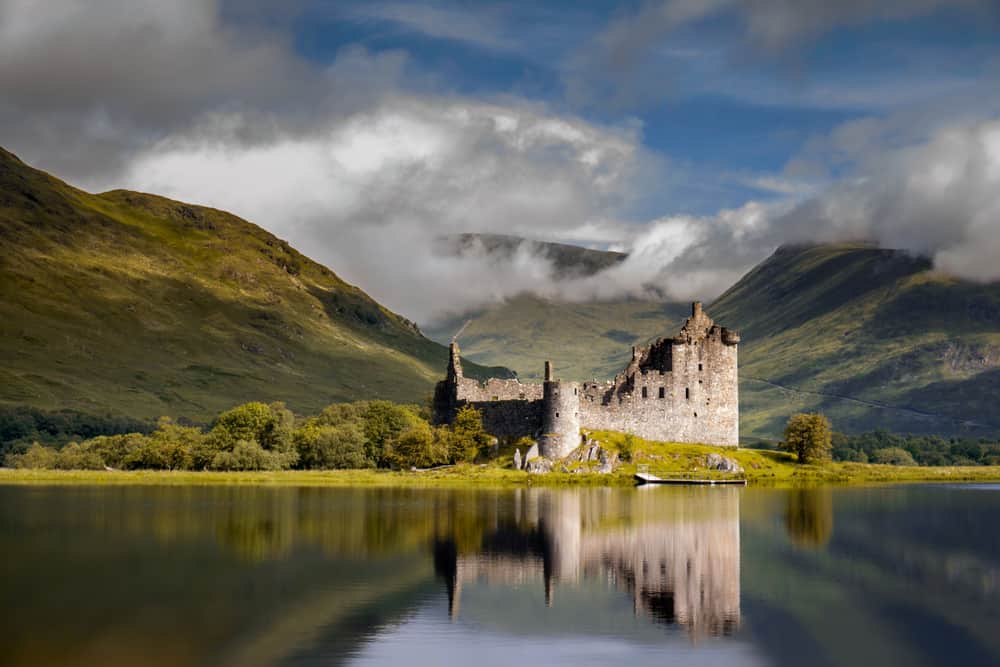
Looking for the best free castles to visit in England and the UK? You’re in the right place. Here are some of our favourites.
Planning a road trip? Don’t forget to grab your FREE road trip planner below.
*We work hard to make this the best motorhome travel blog and road trip website possible, full of helpful content for you. The website is supported by our readers, so if you buy through links on this site we may earn a commission- at no extra cost to you. All opinions remain our own .
If you find this post useful, you can also treat us to a coffee – we promise to enjoy it while creating more useful content like this- we might even indulge in a biscuit (or two!)
JUMP AHEAD TO...
Best Free Castles in the UK
There’s something about castles.
Maybe it’s the way their stone walls seem to reach toward the sky, or how they always seem to be built on high ground.
Maybe it’s the way they take you back in time, or maybe it’s just that they’re just so darn imposing – you can’t help but feel like you’re stepping into a different era when you’re inside one.
Whatever it is, there’s no denying that the UK is lucky enough to have a LOT of these incredible buildings, and they are all a big part of British history.
They may have been around for centuries, and many have been destroyed over time, but even wandering through castle ruins can make a fun day out- especially if it’s free!
Want to explore more? We strongly recommend joining these two incredible organisations when you’re touring the UK:
National Trust
English Heritage
Make planning your next road trip EASY (& fun!)
When you’re planning a road trip, keeping track & organising all your ideas is often the hardest part. Fix that TODAY with our printable pdf road trip planner. Grab yours FREE now
This form subscribes you to our mailing list. We share tips, itineraries, stupid mistakes and guides like this for road trippers and motorhomers.
We never spam (yuck) and you can unsubscribe at any time.
The Best Free castles in England
The history of England is chock full of incredible battles and the building of castles. Like the rest of the UK, they are everywhere.
What’s fascinating about them is how the architecture changes- and the direction of the defences, depending on the enemy. There are PLENTY of castles to enjoy on an England road trip , but here are some of the best free to visit ones.
Alnwick Castle

Location: Alnwick NE66 1NQ
Alnwick Castle is one of the largest inhabited castles in England. Its construction was ordered by William II (Rufus), who was King of England from 1087-1100 and his descendants ( the Percy’s ) still live there today.
The castle has been the setting of many films, including Harry Potter and Robin Hood: Prince of Thieves.
Parking for people with limited mobility is available on Castle Square and in the main car park at The Alnwick Garden. The Castle has been open to the public since 1938 and is one of the most visited attractions in Northumberland. It is a Grade I listed building, as are its gardens, which are also open to visitors from March to October.
Liverpool Castle
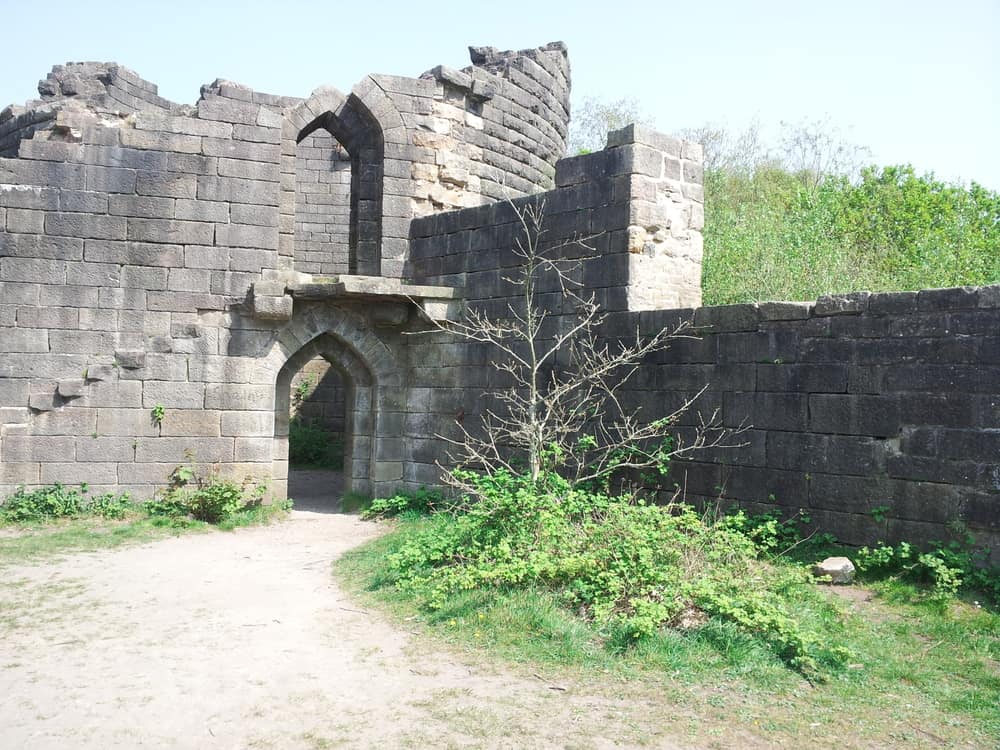
Location: Rivington, Bolton BL6 7SB
Liverpool Castle is a medieval fortification in the village of Rivington, Chorley, Lancashire, England. (NO- it’s not in Liverpool!)
The castle was founded by King John and was built to protect against Scottish raids from across the river Ribble. It was built sometime between 1207 and 1210 and was designed to be defended by only a small number of soldiers because it was also a royal residence for the king.
Rivington Reservoir Car Park is located just off Rivington Lane and provides access to a tree-lined avenue that will take you directly to the castle.
During its long history, the castle has undergone many changes, including being captured by the Scots in 1319 and retaken by the English army only six years later.
Liverpool Castle remained in use until 1536 when it was abandoned due to structural problems caused by flooding. It’s just ruins now, but it’s a lovely walk and a great place for legs (big & little) to stretch themselves.
Peveril Castle

Location: Market Pl, Castleton, Hope Valley S33 8WQ
The remains of Peveril Castle sit in an imposing location, overlooking the popular village of Castleton in the Peak District. It dates back to 1153 and was built by William Peveril, a Norman knight who fought under William the Conqueror at the Battle of Hastings.
William received land from Henry II to build the fortress but was imprisoned at Nottingham Castle after joining a rebellion led by Thomas Becket.
The castle was besieged by King John in 1216 but managed to hold out until the king’s death, after which it was captured by his successor Henry III.
The site is free to enter and the visitor centre is located at the bottom of a hill, with ample parking spaces. There are also several cafes to enjoy if you wish.
Location: 35 Castle St, Eye IP23 7AW
Eye Castle is a medieval hilltop ruin, built by William Malet. The Castle site has recently been restored and revamped, opening new areas to explore and providing a viewing platform offering wonderful views of the church,
You can see for miles over the surrounding countryside. Parking is available near the cross street car park and there are also toilets close to this parking lot.
There are also remains of a medieval fishpond that can be seen, along with the original drawbridge.
The castle is a good place to visit if you want to learn more about the history of Eye and its surrounding area. There are also some great walks around the village, including a walk up the hill to see the town’s windmill.
Best free castle in Scotland
I defy you to enjoy a Scotland road trip without passing a castle. They are EVERYWHERE.
Indeed, some of the most scenic drives in Scotland include many of them on their itinerary. But here is one of the best free to visit castles in Scotland.
Kilchurn Castle

Location: Lochawe, Dalmally PA33 1AF
Kilchurn Castle is the oldest castle in Scotland. It was built in about 1450 and has been passed down through four generations of the Campbell family.
There’s a free parking area at the entrance to Loch Awe off A85, and there’s room for vans if you’re motorhoming in Scotland . It will take you less than 15 minutes to walk from the highway through the wooded area and over a small creek, up towards Kilchurn Castle.
During its long history, Kilchurn Castle has served various functions: first as an administrative centre for the Romans; then as a clan fortress during Scotland’s Wars of Independence (1250-1300); and later as a state prison in the 17th century.
Since the early 1900s, this magnificent castle has been open to the public and is now a popular tourist attraction. Visitors can step back in time and get a glimpse of what life was like for royalty during Scotland’s medieval period.
Best Free Castle in Wales
Wales also has plenty of incredible castles and historic buildings to enjoy. If you’re motorhoming in Wales , you can even stay in some of their car parks. But here is one of our favourite free to visit castles.
Harlech Castle

Location: Harlech Castle, Harlech LL46 2YH
Harlech Castle was built by English kings in the early 15th century, as a stronghold to control Wales. It is one of the most important castles in Wales and has been described as Britain’s finest example of medieval military architecture.
The castle is perched on a rocky outcrop, with dramatic views over Tremadog Bay. There’s ample parking nearby, although you do need to pay. You can walk from the car park to the castle itself, but if you want to see more of the grounds, there is a narrow-gauge railway that runs around them.
The views are spectacular and well worth taking some time out of your Wales road trip to explore this area.
Today, Harlech Castle is a tourist attraction and a popular filming location for movies and TV shows including A Knight’s Tale, Doctor Who, Merlin and Braveheart. There are guided tours through the castle, which is open to the public.
It is also possible to wander around the grounds at your leisure. There is a small museum inside the keep, which provides an insight into life at Harlech Castle during medieval times.
Best Free Castle in Northern Ireland
Northern Ireland has a lot of incredible history and places to visit. But if you’re looking for a free castle, head to the Grand Belfast hotel.
Belfast Castle
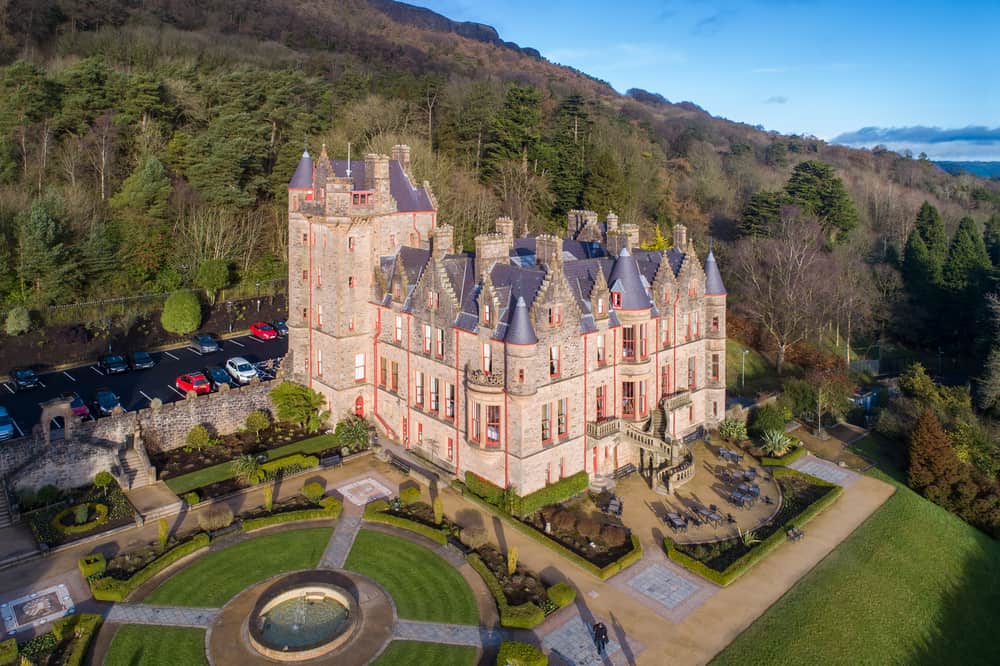
Location: 9-15 Bedford St, Belfast BT2 7FF
Belfast Castle stands proud on the grounds of Cave Hill Country Park, overlooking the city. It enjoys breathtaking views of Belfast and the surrounding countryside due to its elevated position.
In 1806, the castle was destroyed by fire. In the 19th century, it became part of a large estate that included a deer park and golf course.
During WWI wounded soldiers were brought to the castle to recover and it served as a base for the military during WWII, then later became a youth hostel.
During the 1970s it was abandoned but restored in 1980 to serve once again as an attraction with guided tours offered daily through summer months (April-October).
You can park your car at the Great Northern multi-storey car park to take advantage of a special rate. If you do, the hotel will validate your parking ticket for £10 per 24-hour. If you’re in a motorhome, you’ll need to find alternative parking as they can’t fit in the multi-storey.
We hope you found that list of the best free castles in England and the UK useful. Here are some more UK posts you might find helpful:
- How to plan a UK road trip
- The best UK motorhoming holidays
- 15 unmissable UK road trip ideas

Kat never planned to buy a motorhome. She also never planned to quit her job as an air traffic controller, go touring around Europe in said motorhome, start one of the UK’s largest motorhome travel websites… or get a cocker spaniel.
Find out how she went from stuck in the rat race to being a digital nomad and inspiring thousands of people to have their own epic adventures here.
If you’d like to connect with Kat, send her an email or follow her adventures on social media.
Sharing is caring!
Similar Posts

North Coast 500 motorhome Guide- Route, Highlights and Tips

Stonehenge CAMPING next to the stones (for free!)

Winter in Spain: 10 Warmest places in mainland Spain for winter sunshine
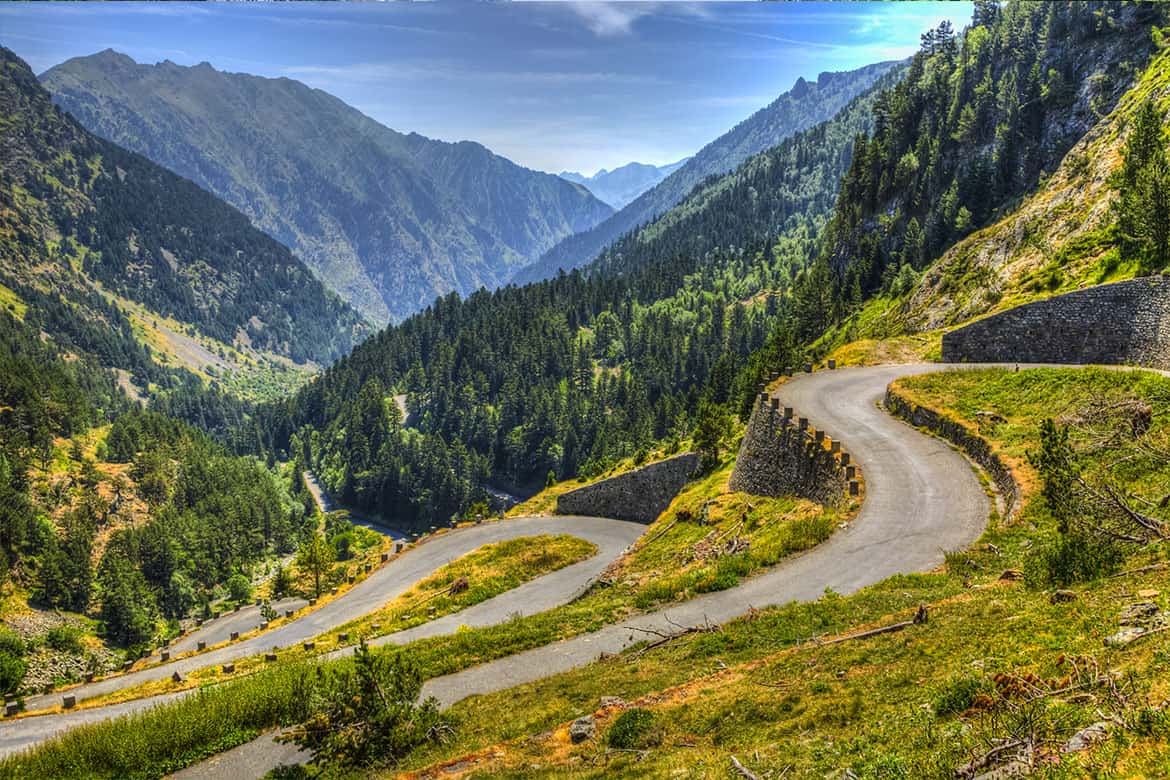
France route planner- best route to Italy (with maps)
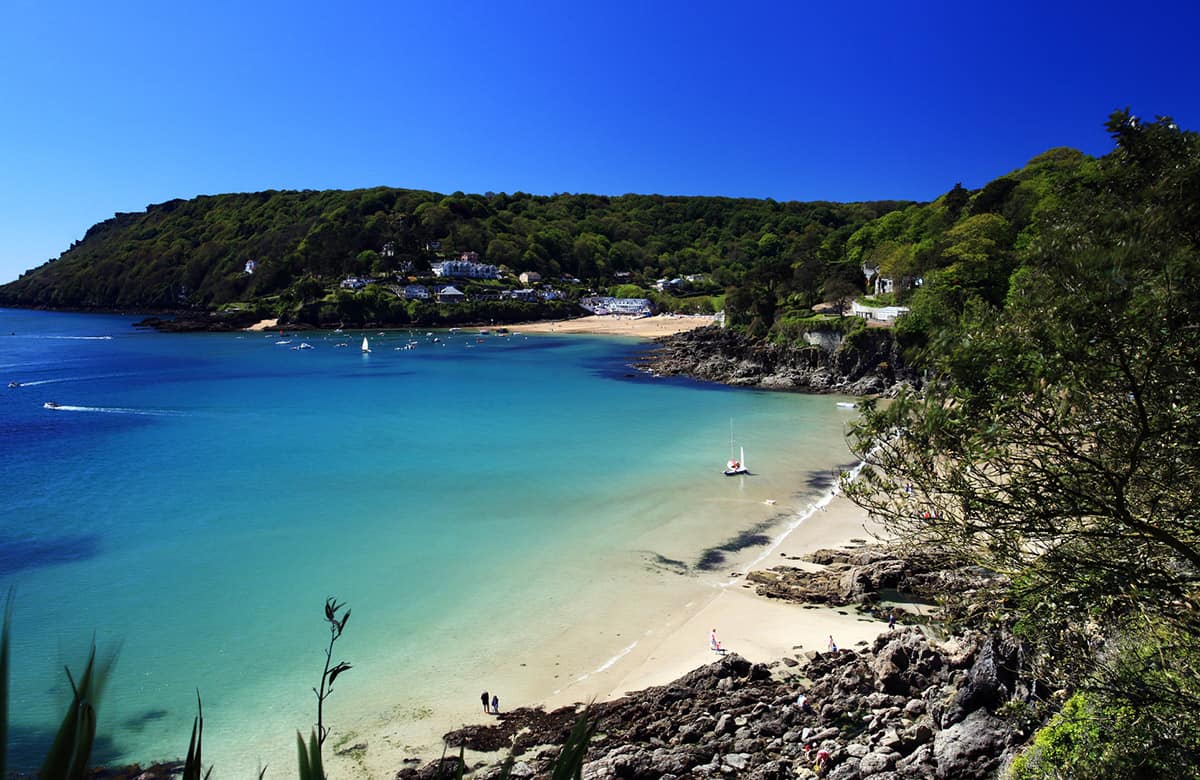
Devon Road Trip itinerary- 19 Beautiful places to Visit

25 Unmissable European Cities to visit in Winter
Leave a reply cancel reply.
Your email address will not be published. Required fields are marked *
Save my name, email, and website in this browser for the next time I comment.
The Best 20 Castles To Visit In England
The Finest English Castles (Updated October 2023):
English castles are some of the most popular tourist destinations in England.
These castles , like their counterparts in Wales , are great monuments to England’s long history . Visitors flock there in droves, no doubt filled with stories of the knights and kings who lived there, and the events they have witnessed.
However, there are over 1,500 castles in the UK (according to the Castellarium Anglicanum , the definitive list published in 1983) and so we thought we’d help out by choosing the best to visit.
So then here is our choice of the best twenty castles in England.

(NB We’ve just published a post some of the many haunted English Castles. Check it out here >>> Haunted Castles In England .
For centuries, these grand structures have graced Great Britain with their imposing stone features and large aristocratic and royal estates.
Let’s look at them in more detail, and list the best castles in England (twenty of them)…
Table of Contents
The Best Castles In England: 20 English Castles To Visit Next Time You’re In In The UK
Many of the oldest castles in England date back to the Norman invasion in 1066.
In the centuries following the Norman invasion, castles in England continued to grow in sophistication and comfort.
By the 14th century, English castles not only provided superior defensive features, but also boasted sophisticated, luxurious living arrangements, and beautifully landscaped formal gardens and parks.
Throughout the Renaissance Era, a small number of castles were built for the wealthy to enjoy extravagant feasts and grand celebrations. During the 17th century, widespread religious and civil conflicts meant that castles, and the defence that they offered England, played an important role in protecting the nation’s interest.
Today, the great castles of England pay homage to the past. The noble structures stand erect as a living memorial to the centuries that have passed, the battles that have been fought, and the people that have come before. Take a look at some of the most monumental English castles and learn about the rich history of these awe-inspiring structures.
No 1: Dover Castle, Kent
Dover Castle is one of the most iconic castles in England . It also has the distinction of being among the oldest; it was originally fortified by William the Conqueror following the Battle of Hastings in 1066.
Before it was turned into a fortified castle it was a general stronghold for the Saxon forces. It also served as a lighthouse for the Romans during their conquest of England.
The History of Dover Castle
It was vital that Dover be fortified because it offered the shortest distance between England and mainland Europe. In times of war, it would be the first place anyone attacked, and in times of peace, it would serve as a vital trading and sailing hub.
Dover Castle itself has had a long and eventful history to say the least. Dubbed the “Key to England” the fortress has been the first line of defense for England for over 900 years. The only castles that have had a life as long as this are the Tower of London and Windsor Castle.
The Birth of a Castle
As soon as William the Conqueror won the Battle of Hastings in 1066 he ordered that the defences at the castle be fortified with earthwork and stockade with timber. The castle was garrisoned as soon as it was ready and was garrisoned without interruption (meaning there was always some military force there) until 1958.
King Henry II remodelled the castle in the late 12 th -century. He planned on making the great tower of Dover Castle a palace in which he could entertain important guests. He also planned on making the tower the last redoubt for the castle; one of the most strategically important in the country. The tower stands 83 feet tall, 100 feet square, and the walls are 21 feet thick. It houses three floors, with the top-most floor being reserved for the king.
With such an impressive and imposing showpiece the king was able to welcome distinguished visitors – in particular noble pilgrims on a pilgrimage to the Canterbury Cathedral of Thomas Becket. Thomas Becket was an archbishop who was slaughtered before the altar at the castle by Henry’s knights on December 29 th , 1170; ten years before the work on the tower began. There was a chapel dedicated to the late archbishop on the second floor, made with beautiful decorated stonework.
Construction on the tower continued into the first half of the 13 th century under the watch of King John and Henry III. It was finally finished by Henry III.
A Castle Besieged
The defences of the castle were put through their paces in 1216-1217 when the castle was besieged. It was attacked by Prince Louis of France, who supported English barons in their rebellion against King John. The defences at the castle withstood ten months of bombardment by the French siege engines and every other attempt the French made to invade the castle.
The castle was further improved after the siege. Henry III added three new gatehouses and a fortified spur extension to the castle. The castle as we know it today was completed by the 1250s and it has remained a symbol of the power of the English royal family ever since.
The castle was once again besieged in October 1265. This time, the castle was besieged by Henry III’s own son; Prince Edward. The castle was held by the king’s sister, Eleanor de Montfort. Eleanor was the widow of the baron Simon de Montfort, who rebelled against the king and had been killed at the Battle of Evesham. Besieged from within and without by royalists, Eleanor petitioned for peace and was exiled to France.
A Castle Transformed
Dover Castle remained garrisoned even after the Middle Ages and would stay garrisoned until the late 20 th century. While it became less important after the 16 th century, the castle still played host to royals including Henry VIII, Elizabeth I, Charles I, and their guests. It was less important from a military point of view but the fact it played host to so many important people necessitated continued protection.
The castle was reshaped in the 1740s to better defend against artillery warfare. When England was under threat of invasion by Napoleon and the French forces in the 18 th century, the castle was added to even more. A series of tunnels was built into the cliffs of Dover to serve as barracks for the multitudes of soldiers needed to protect the castle.
Dover During the Wars
Technological advances from the turn of the 19 th century allowed for coastal artillery to be commanded from a central Fire Command Post on the cliff edge. The position was deemed important enough by the Admiralty for them to commission a signal station on top of it in 1914. The Navy were able to use the station to command the flow of ships in and out of Dover harbour.
The tunnels built during the Napoleonic war were used again during the Second World War. From 1939 onwards they were the location of the command centre that controlled all naval operations in the English Channel. This is where Vice Admiral Bertram Ramsay orchestrated the evacuation of British troops from Dunkirk with Operation Dynamo.
The tunnels were expanded upon to serve as a bigger headquarters and as a hospital for the war wounded. The hospital was combined with the headquarters and the castle was an important part of defending the Straits of Dover and preparing for the invasion of mainland Europe in 1944.
The network of tunnels underwent a further transformation during the Cold War. It was planned that the tunnels would serve as a secret location for one of Britain’s Regional Seats of Government so that things could resume as close to normal if England was hit by a nuclear attack.
Modern Dover Castle
The modern Dover Castle is managed by the English Heritage group. It is open to the public and offers visitors a stunning look at the history and experience of the fortress. Visitors can tour the castle and the underground tunnels.
They can enjoy all the exhibitions that put them in the shoes of the former inhabitants of the castle and learn all about the rich history for themselves.
The castle has been preserved really well and has been mostly-restored to the original state. Some of the castle has been modified to reflect how it may have looked at different points in history to offer an authentic experience.
Ancient history fans can also experience the original Roman lighthouse that laid the foundations for the castle.
Here’s our post on Dover Castle: Dover Castle: Its History From William The Conqueror To The Modern Day
No 2: Tintagel, Cornwall
This 800-year-old castle is best known for its connection to the legendary King Arthur and his Knights of the Round Table.
Originally built by the Earl of Cornwall, brother to the then King of England. The Earl built the castle to resemble King Arthur’s infamous court at Camelot. Today, the castle is the site of many Arthurian re-enactments and mock battles.
Every summer, the castle becomes the home of thousands of Arthurian enthusiasts who come to experience the days of King Arthur and his knights.
No 3: Carisbrooke Castle, Isle of Wight
At the heart of the Isle of Wight is the romantic castle of Carisbrooke . The glorious castle has been many things over its long history.
Once an armed fortress, the castle has also been a king’s prison and a royal summer retreat.
Today, visitors to the majestic castle find an entertaining museum, a lovely Edwardian garden, and many wonderful events.
Here’s our post on Carisbrooke Castle: Carisbrooke Castle | Magnificent Fortress On The Isle Of Wight, England
No 4: Bolsover Castle, Derbyshire
Originally built in the 12th century, Bolsover Castle was given a makeover by Sir George Talbot in 1553 after years of neglect. The earl later became known for his marriage to ‘Bess of Hardwick’, who was probably the most astute business in the 16th century.
Today, the castle intended for luxurious living has been restored. The castle’s battlements, venus garden, and fountain have been given a second life.
Visitors are able to tour the grounds, visit the castle’s Discovery Centre (located in the castle’s riding stables), partake in one of the many events held throughout the year, or just enjoy a picnic at the lovely site.
NB We have a separate post on Bolsover castle here: >>> https://englandexplore.com/bolsover-castle/
No 5: Leeds Castle, Kent
Claiming to be the “loveliest castle in the world”, Leeds Castle in Kent (and, confusingly, nowhere near the city of Leeds in Yorkshire) is one of the most famous castles in England.
Appearing in the Domesday Book, Leeds Castle has been a stronghold for the Norman armies, a royal residence, and a royal palace occupied by kings and queens .
The location of the castle is nothing short of stunning, with it being situated on two islands in a beautiful lake. Here’s our guide:
History of Leeds Castle
Leeds Castle began life as a Royal Manor. Built in 857 AD, the manor was owned and lived in by a Saxon royal family. After the Normans invaded and conquered England they began construction on the original stone castle at the site of the manor.
The Castle became the royal palace of Edward I and Queen Eleanor in 1278. Edward made several improvements to the castle during his reign.
One notable thing from this time is the Barbican, which stands out because it is made up of three different parts. Each part of the Barbican has its own entrance, gateway, drawbridge, and portcullis. The Medieval Keep, which houses the Great Hall, is named the Gloriette in honour of Queen Eleanor.
King Edward II awarded the castle to his Royal Steward in 1321. When his wife Queen Isabella sought shelter at the castle she was turned away by the people. She was actually fired upon by the archers stationed at the castle.
Needless to say, Edward was not happy about the situation. He laid siege to the castle and reclaimed it for himself and Isabella. Edward was murdered six years later, but Queen Isabela kept the castle until her own death in 1358.
Leeds Castle has housed six medieval queens in all during its history. It housed Queens Eleanor, Isabella, Philippa of Hainhault (and wife of Edward III), Joan of Navarre, Catherine de Valois, and Catherine of Aragon.
It also technically housed Elizabeth I. She was imprisoned in the castle for a time before her coronation and ascension to the throne. It’s thanks to this history of housing queens that the castle is also called the “Castle of Queens, Queen of Castles”.
Of all the kings and queens to have lived in the castle, perhaps none are more famous than Henry VIII.
Henry VIII transformed the castle for Catherine of Aragon, his first wife. While touring the castle be sure to keep a lookout for the Field of the Cloth of Gold; a painting that commemorates when King Henry VIII met King Francis I of France in 1520.
The castle was later purchased and owned by the Culpeper family. This meant that the castle was not destroyed during the English Civil War because the Culpeper family sided with the Parliamentarians. It would later be used to house Dutch and French prisoners of war.
The last person to privately own the castle as a residence was Lady Baillie. She purchased the castle in 1926 and employed the services of French interior designers so that they might improve her new home and make it even better.
She dedicated much of her life to the restoration and improvement of the castle. It was her that set up the Leeds Castle Foundation too, to conserve the castle for years to come. Leeds Castle would be opened up to the public in 1976.
Visitors to the castle are welcome to enjoy the stunning architecture and landscaping of the grounds, which is set into a 500 acre landscape of parkland complete with a maze, grotto, vineyard, and aviary.
The maze is one of the most popular tourist attractions at the site, with a secret grotto tucked away at the centre for anyone who can safely navigate their way through.
Staying at Leeds Castle
If you want to get the most out of your stay to the castle then you should consider staying for a night or two. This gives you a lot more time to enjoy the castle grounds and also allows access to the gardens when the castle isn’t open to the general public. Stay in the State Courtyard Bedroom and enjoy a full English breakfast served at the 17 th century Fairfax Hall Restaurant.
Don’t feel like being treated like royalty? Want to try something different? The castle lets you experience the life of a knight with Knight’s Glamping. Stay under the stars in a luxurious four-poster bed with cotton bedding and wake up ready to do battle on the morrow.
If you’re looking to stay at the castle for an extended period of time then try out one of the holiday cottages. These cottages house between 2 and 10 people. There are five of them all across the property and they are all self-catering. Be sure to book yours ahead of time. Staying in the cottages means you are able to explore the grounds freely long after other guests leave.
One of the best things about visiting Leeds Castle is that tickets are valid for up to a year. You’re welcome to visit the grounds as many times as you want in that time. Think of it like every ticket is a season ticket.
During your stay be sure to have a hot air balloon flight, a ferry boat ride, a round of golf, and many of the other exciting activities that are fun for the whole family.
How to Get to Leeds Castle
Leeds Castle is around 4 miles east of Maidstone.
It’s off Junction 8 of the M20 motorway and around an hour and a half from London – or half an hour from the Channel Ports and Channel Tunnel.
No 6: Windsor Castle
20 miles west of London, The 900-year-old Windsor Castle is the oldest official royal estate, and the largest currently occupied castle in the world.
However, this residence is much more than just a castle. The grounds at Windsor contain a large church, several homes, and the royal palace.
(We now have a separate post on Windsor Castle: Windsor Castle | The Queen’s Favourite Home
No 7: Hever Castle, Kent
The 700-year-old Hever Castle was once the childhood home of Anne Boleyn is home to a fine collection of beautiful furniture, antiques, tapestries, and an impressive collection of Tudor paintings.
Additionally, the castle is home to more than 125 acres of glorious gardens and award-winning landscape. One thing is for sure, at any time of the year, the stunning castle’s exteriors and interiors are sure to take your breath away.
No 8: Bolton Castle, Yorkshire
Bolton Castle in Yorkshire was once a defensive fortress as well as a luxurious family estate. Today, the castle is a well-preserved home to many outstanding rooms and features and is one of the best castles in England to visit.
Visitors of the castle can peruse rooms like the old kitchens, the nursery, the great chamber, Mary Queen of Scots’ bedroom, the armoury, and even the dungeon.
No 9: Richmond Castle, Yorkshire
Stunning views of the Yorkshire Dales elevate the Richmond Castle into its rightful place as one of the most beloved attractions in North Yorkshire.
Originally built to keep the peace in the unruly northern region, today, the castle is one of the most inspiring Norman fortresses in Great Britain.
No 10: Skipton Castle, Yorkshire
If you’re travelling to the Yorkshire Dales , why not stop on the way to see this lovely medieval castle…
One of the most well-preserved and complete medieval castles in England, the 900-year-old Skipton Castle is a place where one can easily encounter remnants of the nation’s rich history around every corner.
From the dungeon to the watchtower, Skipton Castle was made to last. In fact, the fortification withstood a three-year log siege during the nation’s Civil War. As it stands now, the castle will be around for many years to come.
No 11: Corfe Castle, Dorset
The once majestic Corfe Castle now stands in ruins guarding the Purbeck marble quarry.
At one time, nothing could pass forth from the rocky outcrop without first going past Corfe.
The centuries-old hillside castle is the centre of many stories of the kings and queens who passed between its walls.
One of the most dramatic tales reports that the castle is where King Edward was murdered by his stepmother in 979.
No 12: St Michaels Mount
The majestic St. Micheal’s Mount is connected to the mainland by a rocky causeway. As the sea waters pour in and the tide rises, the mount becomes cut off from the nearby village of Marazion.
Pilgrims have poured to the island’s jagged shores since the 5th century when Micheal the archangel appeared before a group of people at the mount. The holy site was honoured, and a Benedictine monastery was built over the plat in the 12th century.
Still today, true believers travel to the mount and follow in the footsteps of the ancient Pilgrims to the medieval monastery located at the top of the hill.
No 13: Norwich Castle
The 900-year-old Norwich Castle is one of Norwich’s most beloved landmarks. Originally built by the Normans as a royal palace, the castle was later used as a prison.
Today, the castle is home to exquisite collections of fine art, antiques, and the collections of the Royal Norfolk Regimental Museum collections.
No 14: Ludlow Castle, Shropshire
First a Norman fortress, Ludlow Castle was improved upon for centuries and eventually became a royal palace. Originally, the fortification served to hold back the Welsh.
Today, the castle is open for all to enjoy.
No 15: Barnard Castle, County Durham
Sitting high on a rock above the River Tees, Barnard Castle is named for its founder, Bernard de Balliol.
First built in the 12th century, the castle was later the property of Richard III.
Visitors to the estate are able to enjoy the castle’s famed ‘sensory garden,’ which contains a variety of scented plants and tactile-rich objects.
Click here for our post on Barnard Castle
No 16: Warwick Castle, Warwickshire
Less than 100 miles from London, the stately Warwick Castle is known for its superb medieval interior and great period re-enactments.
The Castle has been through a lot over the years. A few notable moments include when it was attacked in 1264, the siege of Warwick Castle in 1642, and the fire that tore through the castle in 1871. Despite all of these setbacks, the castle has endured throughout history and still stands today.
It was kept by the Earls of Warwick before becoming the private residence of the Greville Family until 1978, when it became the property of the Tussauds Group, who later became Merlin Entertainment Group, in 2007.
It remains with the Merlin Entertainment Group to this day and they have turned the castle into a fun and interesting tourist destination. Indeed it’s one of the few English castles of its size that welcomes overnight visitors, as we shall see.
In the meantime, let’s have a look at the castle’s long and varied history…
History of Warwick Castle
Warwick Castle was built by a king, became the seat of a kingmaker, and played a vital part in the War of the Roses and the English Civil War. Needless to say, it’s had a long and important history. It even housed a royal prisoner at one point.
The records of there being a walled-building in Warwick date back to the Saxon foundations built by the daughter of Alfred the Great, Ethelfleda.
The foundations were built to protect the area from invading Danes. It was constructed in 914 A.D. It’s incredible to think that the huge castle started life as a small fort built by the Saxons.
The Warwick Castle that we know and love today slowly came to life from 1068. The castle was a construction project for King William I, better known to historians as William the Conqueror.
It didn’t take long after the Battle of Hastings – in 1066 – for William to begin making his own mark on the country. The “castle” at this point was a wooden motte and bailey. The project to turn it into a stone castle wouldn’t be complete until the 13th century.
While the castle served William the Conqueror well it wasn’t until the Hundreds Year War that it became a notable footnote of British history.
It was during this war that it became an example followed by the architects of castles in the 14th and 15th centuries. The castles from that period were based on the best of the best and Warwick Castle was included among that list.
The castle has undergone several changes across the years. Some of those changes were because of changes in styles and tastes, some were for military reasons, and others were because of disaster.
One of the most famous changes to the castle came when following a fire in 1871.
While the two eastern towers of the castle can be traced back to the 14th and 15th centuries and the Great Hall was renovated in the 14th century, much of the interior of the castle – in particular the State Dining room – was remodelled in the 18th century.
Warwick Castle was where Edward IV was imprisoned in 1469. It would be held by the Duke of Gloucester in the 1480s before he would go on to become King Richard III .
It was an important part of the English Civil War in 1642 when it withstood a siege by the Royalist forces.
Who has Owned Warwick Castle?
Something that makes the castle so important and a key part of history is the story of the people – not to mention dynasties – that it has played host to over the years.
It has been owned by some prominent people throughout history, including the Earl of Warwick Richard Neville. Neville was a key figure in the War of the Roses and has been dubbed The Kingmaker by historians because of how important he was to the war.
Several families have been the custodians of Warwick Castle throughout history. It has always been closely connected to the royal family in some way or another.
It played an important role in the advancement and further development of castle design and construction.
It has been host to nobility from around the world and also hosted knight games that became a key part of the history and culture of medieval European history. It has since gone on to become one of the most popular tourist spots in England.
Some of the most famous families that have lived inside the walls as the Earls of Warwick are the Newburgh family (11th – 13th century), De Beauchamp (13th – 16th century), Dudley (16th century), Rich (17th to 18th century), and Greville (18th century to 20th century).
The castle has been taken over by the royal family twice across history. These days it is in the possession of the Tussauds Group, which now goes by the name Merlin Entertainment Group. The group is the second large leisure group in the world behind Disney.
They purchased the castle from the Greville family in 1978. The Greville’s had owned the property for almost four centuries (374 years) at the point of sale.
Visiting Warwick Castle
Warwick Castle was opened to the public and now represents a key tourist attraction in England.
Tourists are able to go through the castle itself, the keeps and stables, as well as the 18-meter high trebuchet; the largest trebuchet in the world. There are daily displays and shows happening all the time.
As tourists explore the castle they will learn about the history and architecture of the castle. There’s also plenty of activities for children and adults happening with events scheduled all year round.
Take a look at the schedule to see what’s happening and prepare yourself for a lengthy stay as it can take up to 5 hours to see it all.
Staying at Warwick Castle
Visitors can even stay at the castle overnight if they want.
Families are sure to love the Knight’s Village which has themed accommodation including medieval-themed lodges and glamping tents.
To travel back in time book a stay in the Tower Suites. As the name implies, these suites are located in the 14th-century Caesar’s Tower. Enjoy a beautiful bed and breakfast stay in a 4-poster bed, private castle tours, 24-hour concierge services, complimentary champagne, and two-day tickets to the dungeons.
So, then, Warwick Castle is one of the finest and historic castles in England. And, even better, you can stay there…
No 17: Lincoln Castle, Lincolnshire
William the Conqueror first constructed the fortress on the site of an existing Roman fortification. Since that time, Lincoln Castle has remained a symbol of power throughout the ages.
Today, the castle is on display and is the home site of an original 1215 Magna Carta.
No 18: Alnwick Castle, Northumberland
The stately home of the Duke of Northumberland, Alnwick Castle was first built following the Norman Conquest.
However, the expansive home has been remodelled and renovated many times throughout the years and is today often featured in films, shows, and popular entertainment.
The castle was used as a stand-in for Hogwarts School. Additionally, the castle has also been used as a location for feature films such as Robin hood: Prince of Thieves, The Black Adder, and Becket. Alnwick Castle was also used as the location for part of the filming of Downton Abbey.
No 19: Bamburgh Castle, Northumberland
On the cliffs high above the Northumberland coastline, Bamburgh Castle extends nine acres across a rocky plateau and is one of the largest castles in England that is currently inhabited.
Today, the awe-inspiring fortification sits on a throne of volcanic rock known as dolerite more than forty-five metres above sea level.
No 20: Scarborough Castle, Yorkshire
With nearly 3,000 years of history, Scarborough Castle has proudly defended the country’s inlet area and has endured medieval sieges, Civil War, and German naval bombardment.
Today, visitors can climb the embankment and enjoy sweeping views of the dramatic coastline below.
NB We now have a post on British Castles such as Scottish Castles here: https://englandexplore.com/scottish-castles/ and one on Welsh castles: https://englandexplore.com/castles-in-wales
And here are some other of our posts on the above English castles and others:
English Castle Posts:
Motte and bailey castles in england (and the rest of the uk).
Motte and bailey castles were introduced to the UK in the 11th century by the invading Normans. Their design originated…
The Castles Of Tudor History
Here are some of the castles involved in the bloody history of the Tudors… The Tudor period was a tumultuous…
Castle Howard | Brideshead Revisited’s Yorkshire Gem
Set in the rolling countryside of North Yorkshire, magnificent Castle Howard’s roots date back to the 18th century. Here’s our…
Lindisfarne Castle: A Rugged Northumberland Gem
Lindisfarne Castle sits atop Beblowe Craig’s volcanic mound, on Holy Island off the Northumberland Coast. In this guide, we delve…
Oxford Castle | History, Architecture & How To Visit
Oxford Castle, located in the historic city of Oxford, England, is a great example of the rich history of the…
Barnard Castle: Imposing Fortress On The River Tees
Here’s our guide to Barnard Castle, an ancient fortress on the River Tees, in County Durham, in the north of…
Amberley Castle | Now A Luxurious West Sussex Hotel
Ever wanted to stay in a castle? Well, you can by staying in Amberley Castle in West Sussex – on…
5 Castles That Make A Great Day Trip From London
Here are five great great castles that you can visit easily in a day from London. Perfect for a trip…
Discover The Charm Of Belvoir Castle: A Faux Historical Castle In Eastern England
Belvoir Castle is a ‘faux historical’ castle in England’s East Midlands, overlooking several English counties in the picturesque Vale of…
Fotheringhay Castle: Richard III & Mary Queen Of Scots
Fotheringhay Castle may not be much to look at now, but it was the locations of several important historical events,…
Hever Castle | Anne Boleyn’s Childhood Home
Hever Castle is a beautiful medieval castle located in England and has been called one of the most romantic and picturesque buildings in…
Tamworth Castle: A Norman Castle With A Saxon History
A little over 900 years ago, the first Tamworth castle was built overlooking the River Anker where it flows into…
Highclere Castle | Downton Abbey Meets Ancient Egypt
Highclere Castle is home to Crawleys on Downton Abbey & the Earls of Canarvon (one of whom funded finding Tutankhamun’s…
Bolsover Castle | Peak District Fairytale Castle
Hidden away in the Peak District of Derbyshire, Bolsover Castle is a fairytale castle perfect for exploring, or combining a…
Arundel Castle | Ancestral Home of The Dukes Of Norfolk
Arundel Castle, which was built in the 11th century, is the historic home of the Dukes of Norfolk and has…
Durham Castle | Norman Castle Now Part Of Durham University
Durham Castle is a wonderful Norman castle in the centre of the North East England city of Durham, itself a…
The Secrets of Pontefract Castle, England
Pontefract Castle: History, Significance and Visiting Guide Pontefract Castle, located in West Yorkshire, is now a ruin but in its…
Norwich Castle | East Anglian Norman Castle & Museum
If you’re looking for a fascinating day trip from London, Norwich Castle in England is the perfect place to explore.…
Lincoln Castle | Home To The Magna Carta
Lincoln Castle in England is one of the best preserved Norman castles in existence. It was built by William the…
Ludlow Castle – The Shrophire Home Of The Kingmaker
Ludlow Castle is a ruined medieval fortification in the town of Ludlow in the English county of Shropshire. It was…
Totnes Castle: An Architectural Gem In The Heart Of Devon
Totnes Castle is the only castle in Devon (a county in the south west of England) that still has its…
Scarborough Castle | Stronghold Overlooking North Sea
Scarborough Castle is a medieval castle located in the town of Scarborough, North Yorkshire, England. The castle sits high above…
Bodiam Castle | 14th Century Moated Castle
Bodiam Castle, a beautiful and historic castle located in the South East of England, was built in 1385 by Sir…
Raby Castle: A Fine Royal Day Out in England
Raby Castle is one of the most beautiful and historic castles in England. Situated in County Durham, Raby Castle has…
Skipton Castle | Well Preserved Yorkshire Castle
There are some incredible castles across England, each with its own story to tell, and Skipton Castle in Yorkshire is…
Yorkshire Castles | Great Castles In The Northern County Of Yorkshire
Yorkshire Castles: Yorkshire in northern England is a rugged county known for its warm non-nonsense people and gorgeous countryside. It has lots…
Windsor Castle | The Late Queen’s Favourite Home
Windsor Castle spans hundreds of years, starting with the original structure from the 11th century. From royal weddings to christenings,…
Carisbrooke Castle | Magnificent Fortress On The Isle Of Wight, England
There are some incredible castles across the UK, and Carisbrooke Castle is one of them. This is a historic motte-and-bailey…
Corfe Castle | Wild Dorset Ruin
Corfe Castle sits of one of the steepest hills in Dorset, England, overlooking the village of Corfe on the Isle…
Tintagel: King Arthur’s Cornwall Castle?
Tintagel in Cornwall is mainly a ruin now – but many years ago it may have been the home of…
Bamburgh Castle | Magnificent Northumberland fortress
Bamburgh Castle in Northumberland is one of its largest inhabited castles, spanning over nine acres of land on its rocky…
Alnwick Castle | The Real Hogwarts In Northumberland
(NB This post was originally published at https://british-castles.com/alnwick-castle/) Alnwick Castle – or the exterior of Hogwarts to Harry Potter fans…
Maiden Castle
Maiden Castle in Dorset is one of the largest and most complex Iron Age hillforts in Europe – the size…
Dover Castle: Its History From William The Conqueror To The Modern Day
Dover Castle is one of the most iconic castles in England. It also has the distinction of being among the…
Leeds Castle, Kent
Claiming to be the “loveliest castle in the world”, Leeds Castle in Kent (and, confusingly, nowhere near the city of…
Warwick Castle – Its History & Owners. Plus How To Stay There
Warwick Castle has been through a lot over the years. A few notable moments include when it was attacked in…
Remember To Check Out Our Most Popular Posts:
The Cotswolds: The 20 Best Places To Visit
English Villages | What Makes The Perfect Village In England (With Examples)
Visit Yorkshire, England: York, The Dales & More
English Cathedrals: The 20 Best Cathedrals In England
London Travel: The Ultimate Guide. Tips, Attraction Reviews & More
The Kings And Queens of England: From William the Conqueror To Charles III
British Insults, Slang & Phrases: The Ultimate Guide
10 Fun Facts About England: Weird English Traditions
The Yorkshire Dales | The Best Places To Visit
Gorgeous Images Of The English Countryside
Visit Somerset, England: Cider, Bath, Glastonbury & More
20 Gorgeous English Thatched Cottages
Take our London Quiz: How Well Do You Really Know London?
Terms and Conditions - Privacy Policy

Posted on 4th January 2024 Categories Things to do
By: Author Julianna Barnaby
24 Must-Visit Castles in and Near London
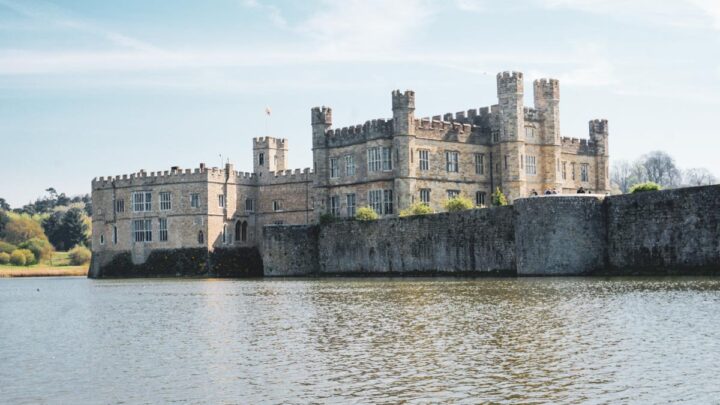
Love This? Save and Share!
A step-by-step guide to exploring the best castles you can visit in a short trip from the capital (and a couple in London if you don’t want to leave the city).
The regions surrounding London are filled with some of the UK’s most impressive castles – and exploring them is a fascinating way to find out more about the history that has shaped these lands.
But first of all, you have to know where to look. Some places, like Hadleigh castle are Romantic tumbling ruins, others like Windsor are still inhabited by royals. One thing they all have in common: they all look stunning.
Here are the best castles close to what’s beginning to feel like a very under-fortified London (as well as a couple of London castles too) – complete with details for how to get to each one. What are you waiting for?
Castles Near London
Bodiam castle.
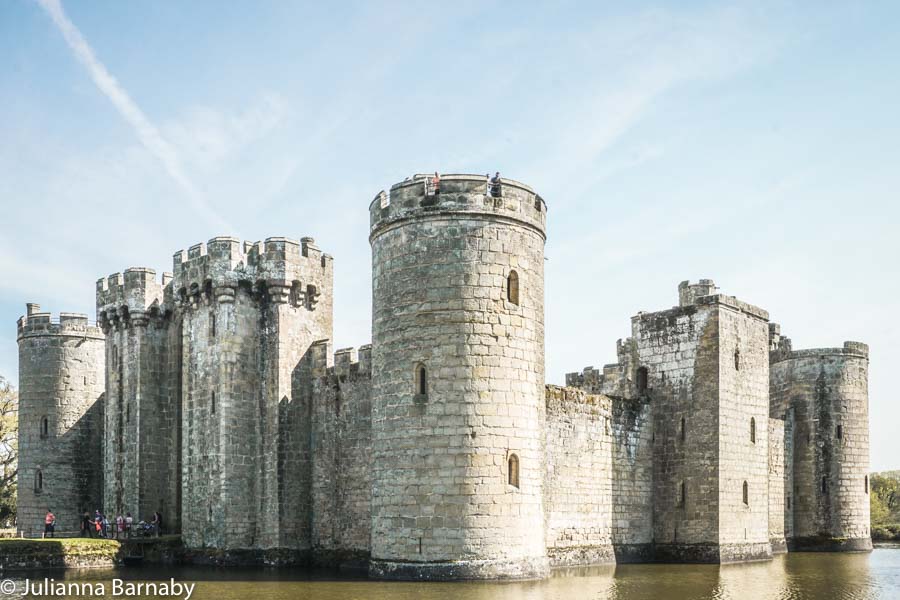
Everyone knows that the best castles have moats – and Bodiam Castle in East Sussex has a great one. The castle was built in the 14th century by Sir Edward Dalyngrigge, a celebrated knight of Richard II.
Today, it is one of the most beautiful castles in all of England. Romantics, historians and photographers are all likely to be totally besotted by its battlements.
It also boasts expansive grounds full of walking trails where you can discover plenty of unique plants – and maybe a few cute animals like hedgehogs.
Tickets to visit Bodiam Castle are £11 (or £12.10 with gift aid). National Trust members go free.
The Castle is also the jumping-off point for one of our favourite country walks near London .
How to get to Bodiam Castle: The easiest way to get to Bodiam Castle from London is to catch the Kent & East Sussex Railways (KESR) train to Tenterden. In the summer, there is a steam train from Tenterden to Bodiam Castle . You can also get the train to Robertsbridge or Battle, and get a taxi to the castle.
Read Next: Brilliant Day Trips from London
Camber Castle
King Henry built Winchelsea Castle in the 16th century to protect England’s southern coast from attack by the French. These days the ruin of this fort is known as Camber Castle, and the seaside location and windswept landscapes make it a striking place to visit.
The first thing you’ll notice are the castle’s circular walls. This was a common feature in the fortifications of the day and was a defence against cannon, the round shape strengthening the walls against heavy projectiles.
It’s almost certain the castle was never used in defence of a French attack, instead it lived out its days in peace until it was dismantled by Parliamentarians to prevent it from falling into Royalist hands during the Civil War.
Adults can get into Camber Castle for £3. Children under 17 go free.
How to get there: The fastest way (just under two hours) to Camber Castle is by train from St Pancras to Rye and a short walk.
Hever Castle
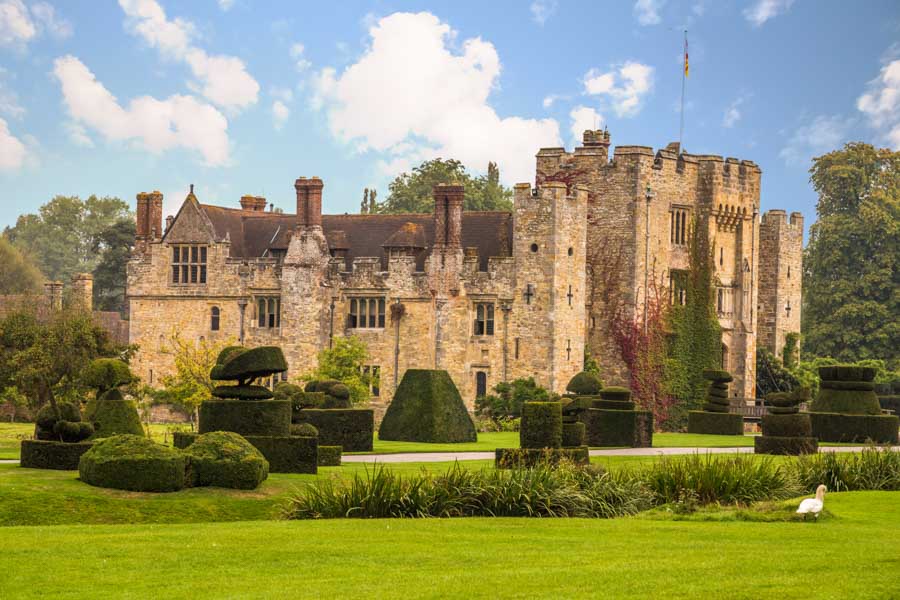
Beautiful Hever Castle in Kent is one of the most historic in England, having been lived in by not one but two of Henry VIII’s wives – Anne Boleyn and Anne of Cleves.
It was originally built as a country house in the 13th century but was later fortified to protect the wealthy tax collector that lived there. It became property of the Boleyn family, who lived there for almost a century.
This link with the Boleyn family is one of the most interesting things about the castle, and there are several exhibits of documents and objects relating to the family and the Tudors.
There are also beautiful gardens, and even a new water garden and a maze which is great for kids (and kids at heart).
It’s cheapest to buy entrance tickets online – it’s £22.00 + £1.10 booking fee for the gardens and the castle.
How to get to Hever Castle: The easiest way to get to the castle is by car; if you don’t have one, there is a train that runs from London Victoria or London Bridge. You can either stop at Edenbridge Town Station and get a taxi for the three miles to the castle, or walk one mile from Hever Station.
Highclere Castle
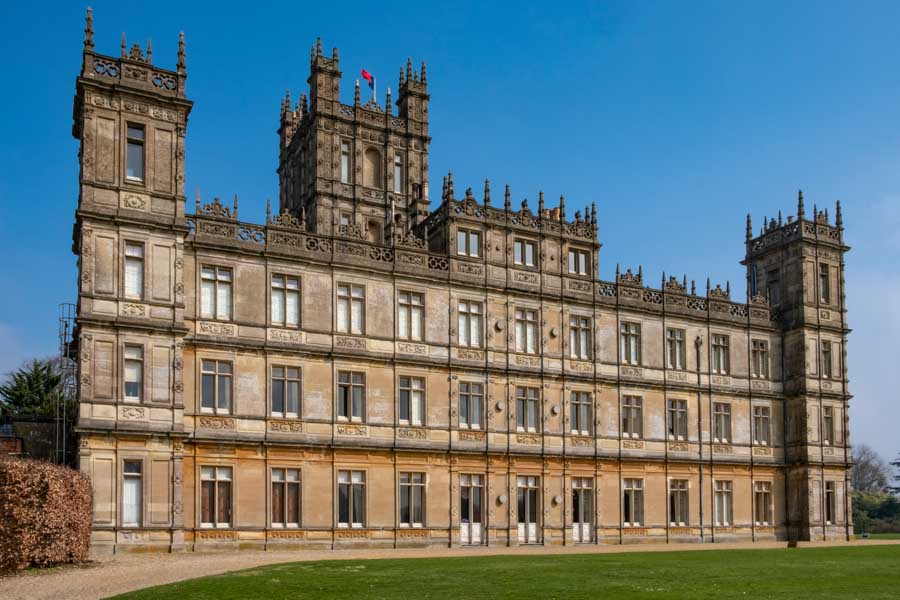
This is not just another beautiful castle around London – it’s the setting for a little show known as Downton Abbey .
One look at the gorgeous Highclere Castle and it’s clear why it was picked – it really is your quintessential grand English castle.
The estate itself is thought to date back from the 8th century, although most of what is on show today is from the 19th century.
As well as the beautiful castle, the grounds are also the perfect place for a country stroll, and there’s an impressive collection of Ancient Egyptian artefacts as well.
The castle is only open on select days in summer, although parts of the grounds are open year-round. You can check the website for public openings and special events. Ticket prices change depending on the time of year, but you’re looking at about £30 for the castle, Egypt exhibition and gardens.
You can also do a Downton Abbey tour with lunch.
How to get to Highclere Castle: The easiest way to get to the castle from London by public transport is to take the train from London Paddington to Newbury. From here, it’s about a 15-minute taxi ride (advance booking is recommended).
Herstmonceux Castle

The imposingly beautiful Herstmonceux Castle is unique as it is one of the biggest and most significant brick-built castles in the UK.
Surrounded by a large moat with a bridge across, it is truly picturesque. Honestly, this is our personal favourite – not only is it incredibly beautiful, but it’s also much quieter than some of the better-known castles nearby.
As well as the impressive castle, the immaculate grounds are also gorgeous, with lots of walking and cycling trails.
It’s also a hub for science, as it is home to the Herstmonceux Science Centre which, amongst other things, has a great collection of telescopes.
The castle is open from early March to early November. An adult entry ticket for the grounds and the castle is £8.
How to get to Herstmonceux Castle: To reach the castle by public transport, you can get the train from Waterloo to Polegate, and then get the 98 bus to Herstmonceux, where it’s a short walk (or taxi ride) to the castle.
Rochester Castle
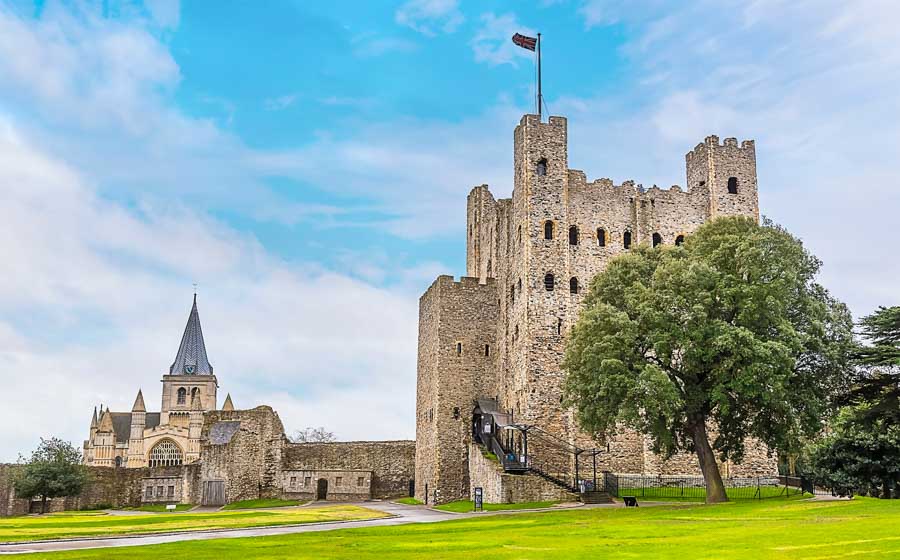
Although it is technically in “ruinous” condition, Rochester Castle features one of the best preserved ‘keeps’ (large towers) anywhere in the UK or France.
The keep was built in 1127, as the castle’s location was of great tactical significance. As a result of this prime defensive location, it was heavily fortified.
Nonetheless, the castle was besieged repeatedly. Most famously, King John laid siege to rebels held up in the castle; part of the keep was destroyed, and eventually starvation caused the rebels to surrender.
By the 17th century, the castle had fallen partly to ruin. It has been partly restored and is one of the most beautiful castle ruins in the country.
The castle is managed by English Heritage, and members get in free. For non-members, tickets can be bought online or at the castle. An adult ticket is £7.70.
How to get to Rochester Castle: The castle is located in Kent, near Rochester. There are frequent trains from London to Rochester, and then it’s about a ½ mile walk to the castle.
Leeds Castle
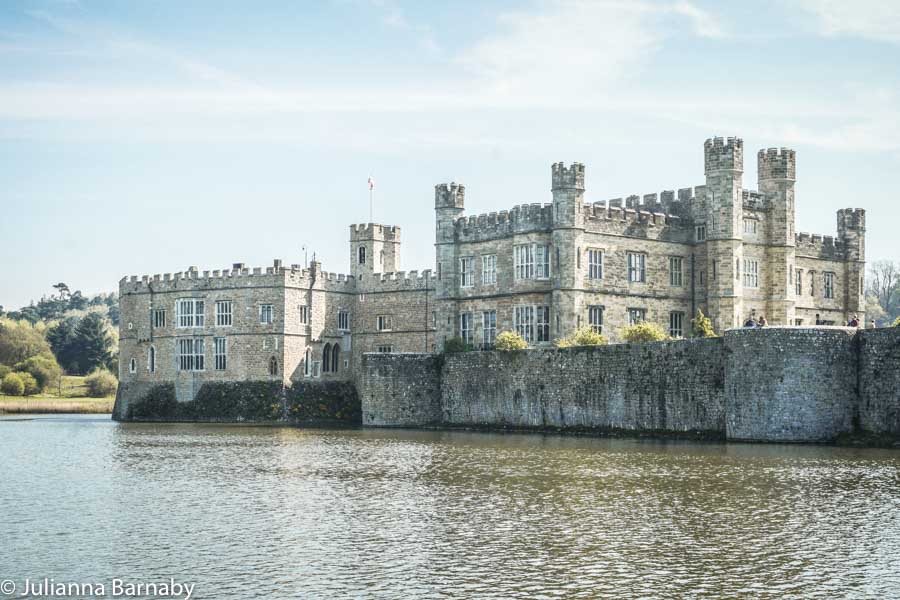
Leeds Castle calls itself “the loveliest Castle in the world”, and we can see why. We don’t like to play favourites, but this one is pretty special.
Floating in the midst of a lake, it’s a gorgeous sight. Although there’s been a castle on the grounds since the 12th century, most of what is on show nowadays dates from the 19th century and is more country house than fortification.
It’s been a popular filming location for decades – most recently featuring the much-loved TV series Doctor Who .
Entry tickets are £30 online (£35 at the gate), and entitle you to entry for a whole year. You can also stay overnight in a cottage or try “ glamping ” if you want a bit longer to soak up the peaceful atmosphere.
How to get to Leeds Castle: Despite its name, Leeds Castle is actually in Kent. You can get the Southeastern train from London to Bearsted Station – in summer, there is a shuttle from the station to the castle, while at other times you’ll need to get a taxi.
You can also get the Nuventure no. 13 or Avura no. 13 bus from Maidstone. Or, another great option is to combine your visit with a tour of nearby Dover and Canterbury castles as well.
Windsor Castle
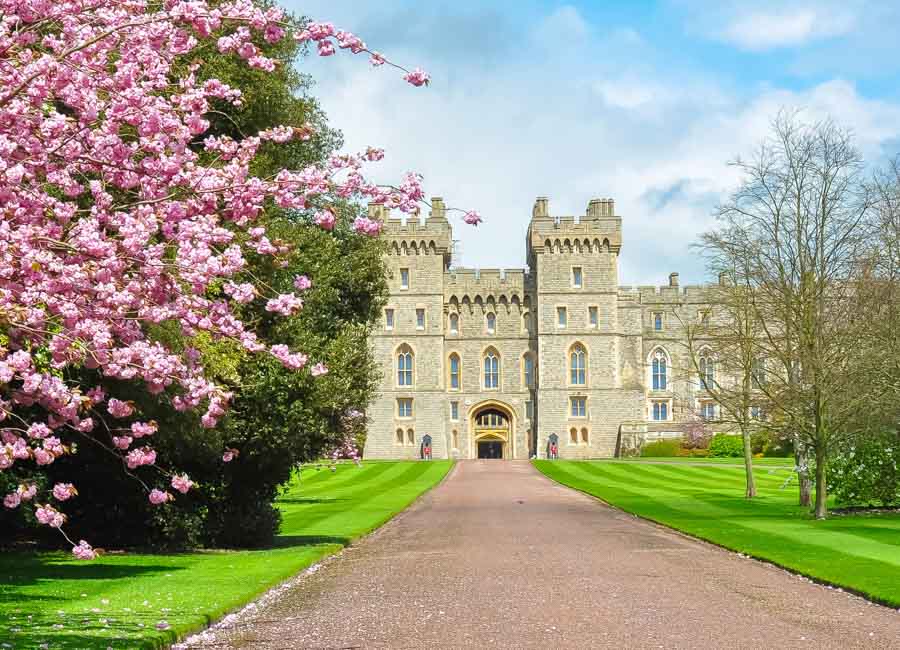
Windsor really is the castle to end all castles. It’s the world’s oldest, and largest inhabited castle – and, of course, was once the weekender of Queen Liz herself.
Visiting Windsor Castle allows you to take a peek into over 900 years of royal life, from William the Conqueror, who originally founded the site with the intention of controlling the western entrance to London, to the current young royals.
Plus, a visit really is the best way to appreciate the mammoth scale of both the castle – considered the pinnacle of Georgian architecture – and the grounds.
An adult ticket to the castle is £28 and can be purchased online.
How to get to Windsor Castle: It is easy to get to Windsor Castle from London. The most direct way is to get a train from Paddington to Windsor, but you can also go from Waterloo.
Hadleigh Castle
Hadleigh Castle won’t give you the grand crenelations and sturdy walls you might be wanting from your castle day trip, but what it doesn’t provide there it more than makes up for in windswept, haunting decrepitude.
That’s because all that remains now is the ruin of a tower and a few walls here and there. The castle was once one of the most important during the reign of Henry III, used to extract wealth from the people of Essex and defend against potential French attacks.
Part of the charm of this crumbling ruin is that you don’t have to pay to get in, entry is entirely free.
How to get there: You can take a train from Stratford International to Rayleigh and from there to Old Oak where you’ll find the ruins of Hadleigh Castle a short walk away.
Hastings Castle
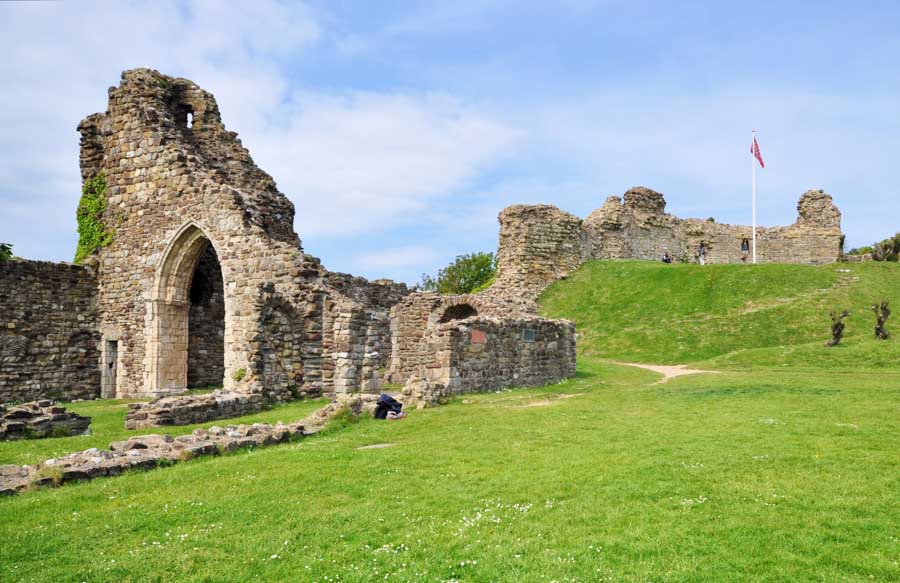
The ruins of the once-grand Hastings Castle are particularly beautiful thanks to their coastal location in charming East Sussex.
In fact, Hastings Castle was the first castle ordered to be constructed by William the Conqueror after the Norman Conquest of 1066. That castle was wooden, and eventually fell into the sea – sensibly, it was rebuilt in stone.
Over the years, the castle was battered by the weather and by armies, including during World War II when it took the brunt of German bombing runs aimed at the nearby town. Today, it is largely ruined, but still has hints of its former grandeur.
The castle is open between April and October, and the entry price of £6.25 includes entry to the keep, the dungeon and the showing of a short film.
How to get to Hastings Castle: You can get the Southern or Southeastern train from London to Hastings, which takes just under two hours. They run frequently from London St Pancras and London Bridge stations.
Dover Castle
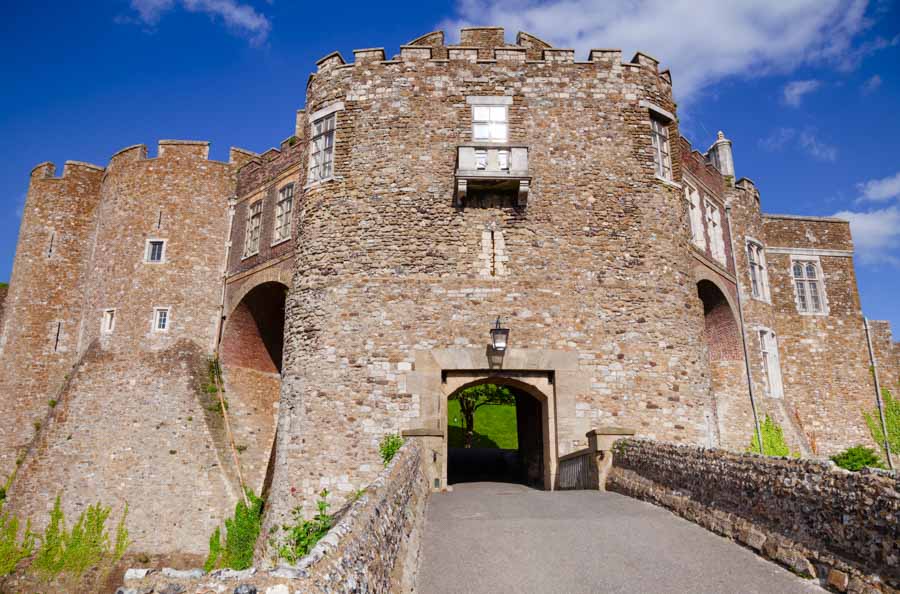
When it comes to impressive settings for a castle, it doesn’t get much better than Dover Castle . Perched on top of the famed White Cliffs of Dover, it’s pretty spectacular.
When it was built in the 11th century, it wasn’t chosen for the views, but for the tactical significance of the coast. Dover Castle was known as the “key to England” as it was of such strategic importance.
Today, you can explore the Great Tower or even learn about the modern history of the Secret Wartime Tunnels tucked away into the cliffside – lowkey our favourite part of a trip to this historic site.
The castle is managed by English Heritage, so members get free admission. For others, the entry price is £29.
You can also combine a visit with nearby Leeds and Canterbury Castles.
How to get to Dover Castle: It’s easy to get to the castle by public transport as long as you don’t mind a little bit of a walk. The closest station is Dover Priory, which is about 25 minutes on foot away from the castle.
You can also get a taxi if you prefer. There are frequent South Eastern trains from St Pancras or London Victoria.
Broughton Castle
Broughton Castle bridges the gap between a country house and an impressive castle nicely. That’s in part thanks to a trend among the aristocracy of old to dress their manor houses up in fortifications to make them look more impressive.
The grounds have been added to over the years but the gatehouse at Broughton Castle dates back to the 1200s and much of the history of this place is tied up with the English Civil War, where it served as a meeting place before the battle of Edgehill.
Entry for adults is £11 and children aged 5 – 15, £7.
How to get there: This castle is probably best reached by car. It’s just over a two-hour drive from central London. Alternatively, you can take a train from Marylebone Station to Banbury and then hop on the 75 bus which takes about the same time.
Arundel Castle
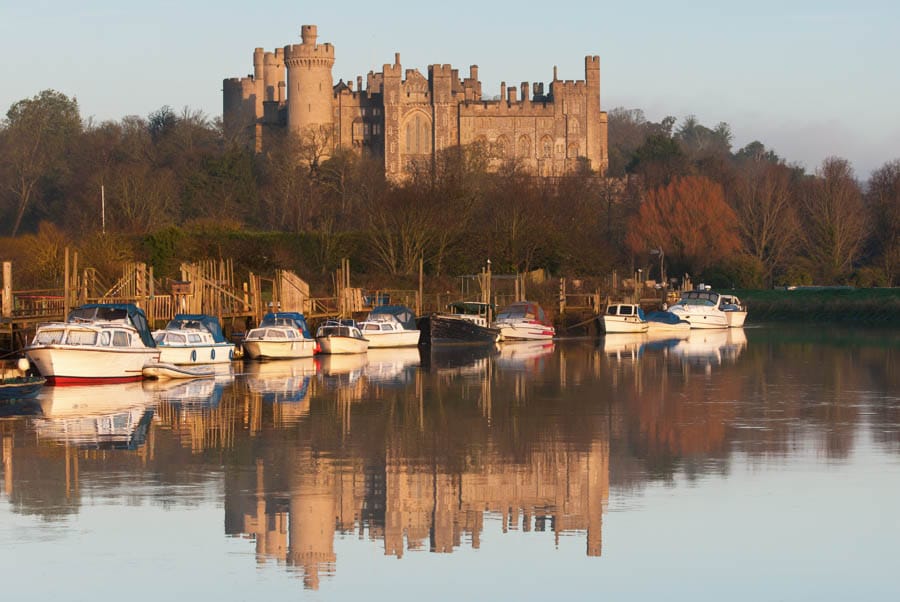
Arundel Castle is one of the most impressive castles you can find close to London. It was built in 1067 by the Earl of Arundel, the first person to be given a title by William the Conqueror.
The Castle was significantly damaged during the English Civil Wars but has been painstakingly restored to be one of the best examples of a Mediaeval castle. Parts of the castle, including the keep, are part of the original structure.
The surrounding village of Arundel is also incredibly fairytale-like, making the entire scene like something out of a film set. Likewise, the interior of the castle boasts some finely preserved interiors – a glimpse into the life of English Nobility throughout the ages.
The castle is open from Tuesday to Friday, from April to early November each year. Tickets range from £19 to £26 depending on how many rooms you wish to see.
How to get to Arundel Castle: The Castle is located in West Sussex. There are frequent trains from London Bridge to the town of Arundel, where it is a short and picturesque walk.
Tonbridge Castle
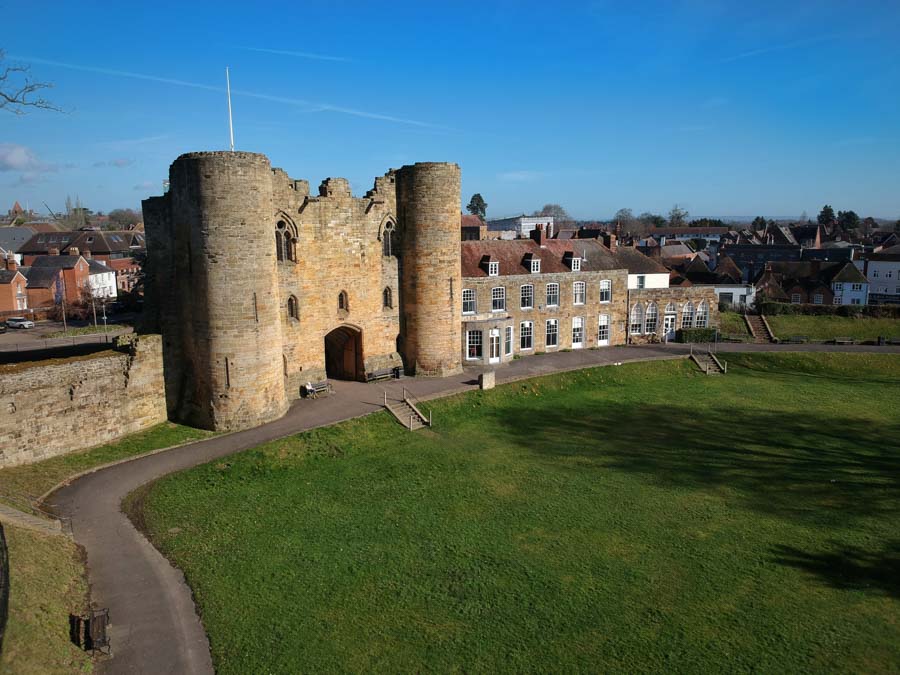
Tonbridge Castle is most famously associated with the de Clare family, English nobility who rebelled against the King in 1088.
The castle was besieged, and the family eventually surrounded – however they would eventually rise to be the most powerful family in the UK at one stage.
Eventually the costs of keeping up such a sprawling property became too much. By the 16th century, the castle was deserted. In 1793, a large mansion was built adjoining the castle, and life returned to Tonbridge.
Today, the castle is owned by the council and welcomes visitors to come and see what aristocratic life was like in England. There are also lots of walking trails in the gorgeous grounds.
Tonbridge Castle is open daily, and an adult ticket is £9.90.
How to get to Tonbridge Castle: It’s easy to get to the castle by train, as Tonbridge Station (serviced regularly by Southeastern Trains from Charing Cross or London Bridge) is a ten-minute walk away.
Scotney Castle
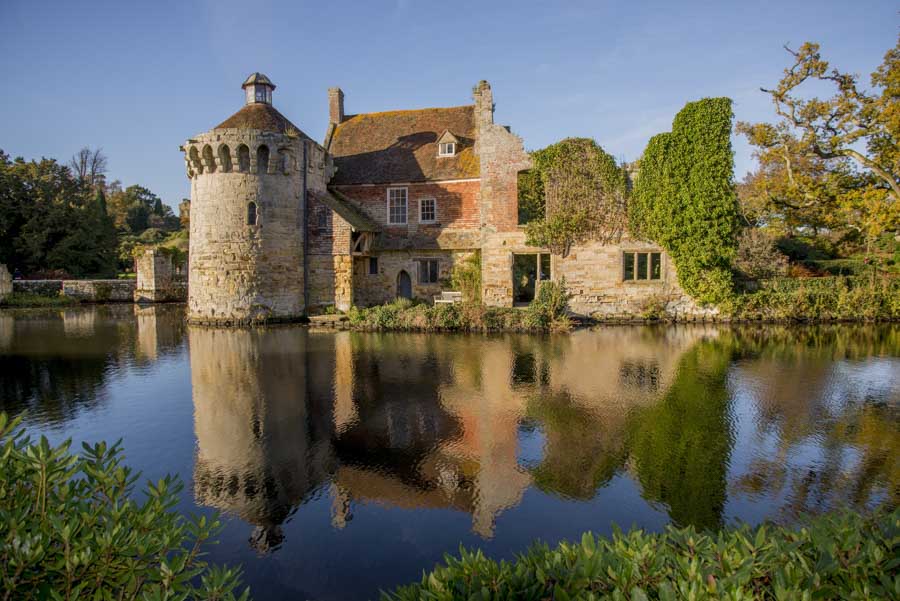
It may not be the largest castle on this list, but the 14th-century Scotney Castle in Kent is surely one of the most picturesque and romantic castles you can find within a short journey from London.
Technically, it’s a country house rather than a castle (castles are fortified, country houses are pretty), but it is nonetheless known as Scotney Castle.
With woodland on one side and a small lake on the other, it’s incredibly beautiful. This is especially the case in spring when the castle walls become covered in colourful blooms.
The castle is managed by the National Trust, meaning members can visit for free. For others, the cost is £15 (£16.50 with gift aid).
How to get to Scotney Castle: Getting to the castle is a bit tricky without your own vehicle. The closest train station is Wadhurst, 5.5 miles away, so you’ll need to get a taxi from the station.
Guildford Castle
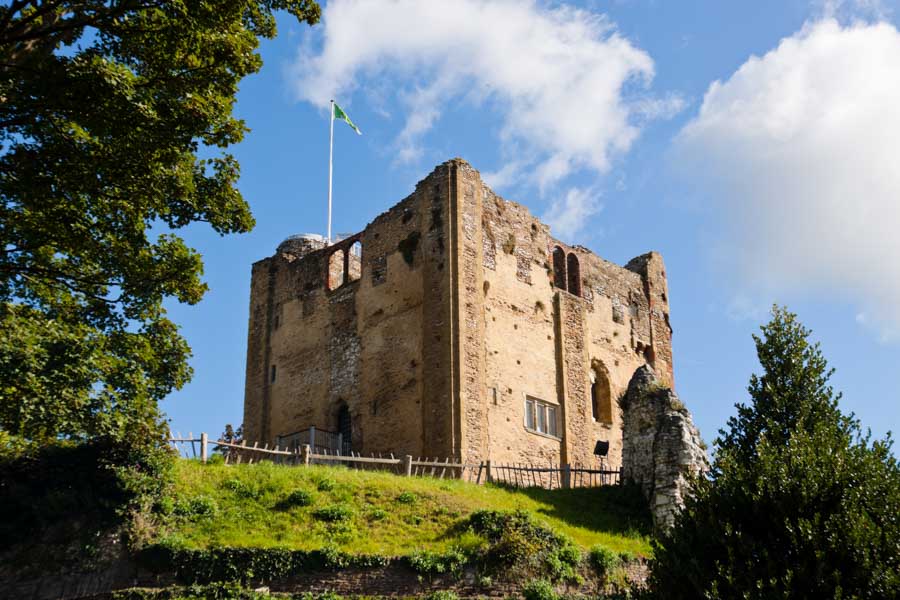
Yet another castle that can trace its links back to the Norman Conquest of 1066 is Guildford Castle .
Due to a lack of records, it is not clear exactly when or by who the castle was built, but historians are pretty sure it was shortly after the Norman Conquest. That’s because we know that William the Conqueror built castles at strategic points all over England.
Guildford was one of these, chosen as it was a convenient stop between the capital and the southeast coast.
Later, it served as the county prison for Sussex and Surrey, and was also a residence for some time.
Today, the castle is open to the public from March to October. The entry fee is £3.90, or you can visit the beautiful grounds for free.
How to get to Guildford Castle: There are frequent trains from London Waterloo to Guildford. The castle is within walking distance of the station.
Oxford Castle
For a castle that’s steeped in over 1000 years of history, take a trip to Oxford Castle and Prison and delve deeper into the dark history of this charming British city.
This really is one of the quirkiest castles you can find near London. Feeling brave? You can even take part in a murder mystery evening here (it’s said to be pretty haunted !) or get involved in an escape room to test your wits.
Adult tickets cost £15.50 and kids get in for less than a tenner, though it’ll cost you extra if you want to get involved in any of the activities – there’s also a great cafe serving up delicious treats in the castle courtyard that we highly recommend.
How to get to Oxford Castle: The easiest way to get to Oxford Castle is to hop on a direct train from Paddington to Oxford. After, it’s a ten-minute walk to the castle. If you want to drive, it’ll take about 90 minutes to reach Oxford.
Warwick Castle
For a fun family day out, you just can’t beat Warwick Castle – it’s one of the best in the UK.
You’ve got the historical bit: the 1100 years of history, the pretty grounds, and the falconry shows. But you’ve also got heaps of fun activities to get involved with – the Horrible Histories maze and the iconic Warwick Dungeons are particular highlights.
You can even make a weekend getaway out of it – book yourself a tent in the Knights Village and get stuck in with a Mediaeval glamping experience that the whole family will enjoy.
If you can, we highly recommend going to their Halloween events held throughout October – it’s got all the creepiness of an old castle with the added fun of a live seance and the spooky House of Wax.
Book online for big savings on entry – adult tickets start at £21 but you’ll have to pay more for extra activities.
How to get to Warwick Castle: It might seem far, but in under two hours you can take a train from London Marylebone to Warwick. From there, it’s less than a ten-minute walk through the pretty town centre to the castle – you can’t miss it!
Wallingford Castle
Head to Wallingford and you’ll find the remains of a stunning castle overlooking the early reaches of the Thames.
This Oxfordshire castle dates back to the Mediaeval ages, and although lots of the stonework is now in ruins, it really is a gorgeous spot surrounded by flowers and greenery.
The history of this place is also very cool. It was, during the 12th and 13th centuries, regarded as the most powerful castle in England. And even though many tried, no one ever succeeded in defeating a defending force and taking Wallingford.
The best part? Wallingford Castle and its pretty gardens are free to visit, so pack a picnic and head over for a day of exploration.
How to get to Wallingford Castle: The easiest way to get to the castle is by taking a train from Paddington to Reading, and then taking the X39 bus to the Market Place. From here it’s a short walk to the castle grounds. If you fancy driving, it’ll take around 1 hour 20 minutes.
Rockingham Castle
Rockingham Castle is easily one of the prettiest castles near the capital, with the flower-filled grounds that make it a highly popular wedding spot.
The castle has a long and interesting history. It was first ordered to be built by William the Conqueror but later gifted to Edward Watson by Henry VIII in 1544, in part because Henry was put off by how dilapidated it was. Since then, the castle has been visited by plenty of royalty and Charles Dickens even used to perform his plays here.
The Norman castle often hosts a number of events including a food and drink fair, outdoor cinema dates, and Tudor history days, so keep an eye out for this on their website.
Regular tickets cost £13.50, and kids can get in for £8.50 – though you can just visit the garden for a reduced rate.
How to get to Rockingham Castle: Located in Northamptonshire, it’s a pain to get to on public transport – but well worth a visit if you’ve got a car and fancy making the two-hour journey from London.
Colchester Castle
Colchester Castle is a beautiful Norman castle and museum which tells the story of the Roman and Norman Conquest of Britain. If you’re after an educational day out (alongside some picturesque views) this is the spot for you.
There’s plenty to do here – take a stroll through the grounds, picnic in the gardens, or head inside for a tour to learn more about the history of the place.
For a teaser of that history, know that Colchester Castle was built on the site of a temple to Emperor Claudius that dates all the way back to AD49 making this site nearly 2000 years old.
Tickets cost £12.50 for adults and £6.95 for children, although they have some bundle options that are well worth it if there’s a small group of you.
How to get to Colchester Castle: The easiest way to get here is to take a train from Liverpool Street Station to Colchester, then taking a short walk to the castle.
Castles in London
Tower of london.
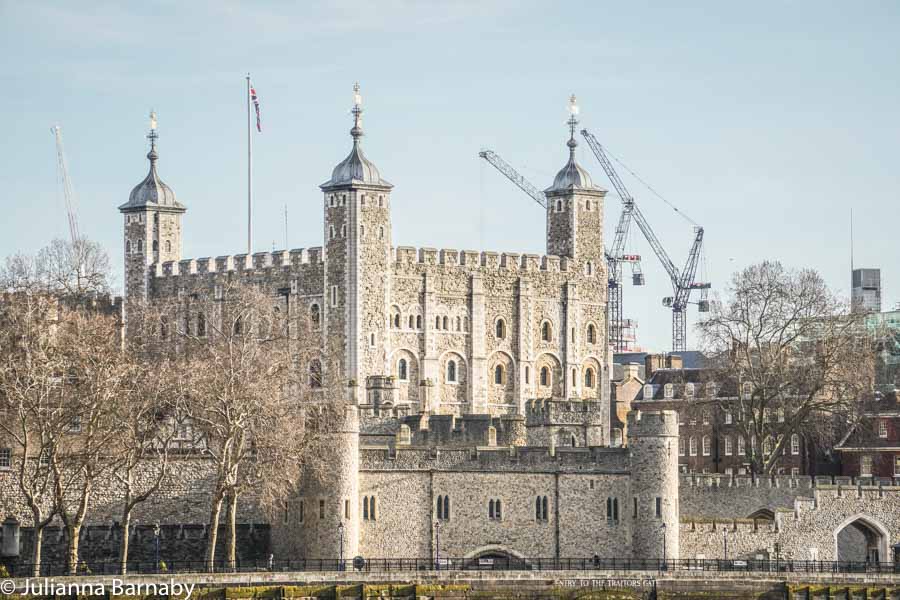
While it is today one of London’s most famous and popular attractions, the Tower of London certainly didn’t begin life that way.
In fact, when this London castle was built by William the Conqueror in 1078, resentful Londoners saw it as a symbol of his oppressive, well, conquering. They were not impressed.
Since then, the tower has had stints as everything from a royal residence to a menagerie. However, it was perhaps its centuries-long time as a prison that is the most well-known.
Some of the famous inmates who were “sent to the Tower” include Henry VIII’s wife Anne Boleyn and subsequently her daughter, Elizabeth I (later Queen Elizabeth). More recently, the infamous gangster twins Reggie and Ronnie Kray were two of the last prisoners in the Tower of London.
Then, of course, there’s the fact that it’s home to the mind-bogglingly valuable Crown Jewels and home to one of the oldest continuous ceremonies in the world .
With such varied history, it’s no wonder it’s such an iconic London attraction.
You can visit the Tower of London and Crown Jewels exhibition £33.60 and tickets can be booked online.
How to get to the Tower of London: Its central location makes it a breeze to get to on the Central Line – it’s just a five-minute walk from the Tower Hill station.
Read Next: London Sightseeing Spots You Shouldn’t Miss
Severndroog Castle
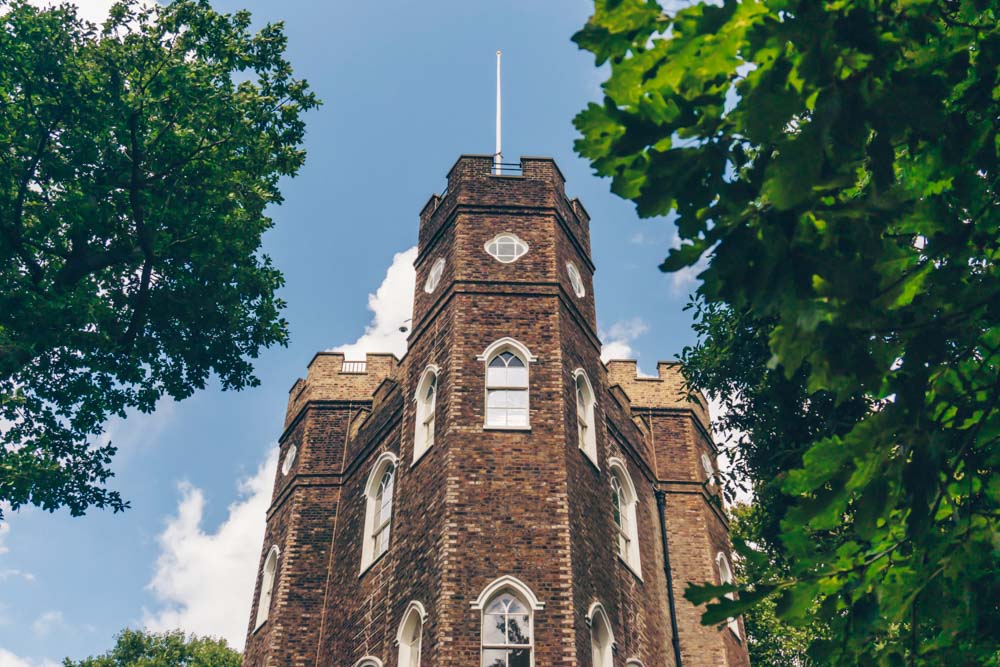
To learn about the quintessentially British idea of a “folly”, we highly recommend a trip to Severndroog Castle near Greenwich.
For those not in the know, a folly is an elaborate and ornate building that has no real purpose except to look interesting. As you do, when you’re English aristocracy and the family coffers are overflowing.
Severndroog Castle is one such building, having been constructed in 1784. It was built mostly as a memorial to Sir William James, who commanded over a decisive English victory in Suvarnadurg, India.
By the late 20th century, however, the castle had fallen nearly into disrepair. A large grant and the enthusiasm of a group of local volunteers ensured it was saved and opened to the public in the early 2000s.
The castle is open Thursday to Sunday, and entry to both the castle and the surrounding woods (as well as a volunteer-led tour) is just £4 for an adult.
How to get to Severndroog Castle: The easiest way to get to the castle is to take the Jubilee Line to North Greenwich, where you can get the 486 bus which will drop you right near the entrance.
Read Next: Quirky Places to See in London
Castles Near London: A Handy Map
Love This? Save and Share on Pinterest
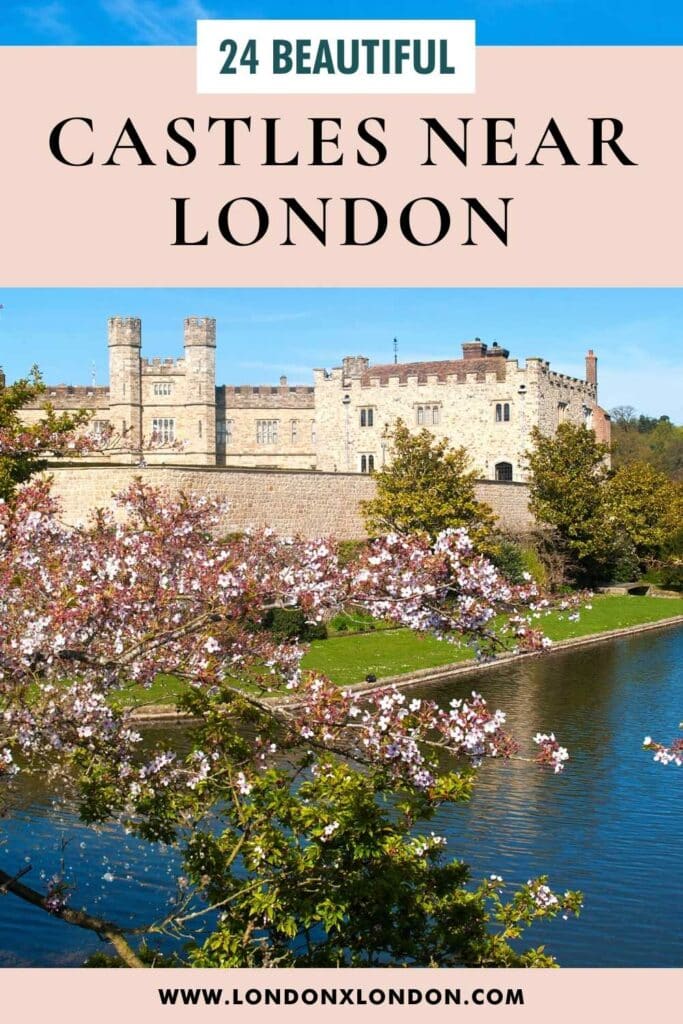
Looking For More London Sightseeing Guides? Read These
- Brilliant Day Trips from London
- Beaches Near London that are Perfect for When the Sun Shines
- Woodlands and Forests Near London for a Taste of the Great Outdoors

LET'S GET SOCIAL!
London x London is the insider’s guide to discovering the best of London.
We delve into the cool, interesting and quirky spots that make London such a dynamic city, telling you the best things to do, eat and drink along the way.
Tired of the same old dull suggestions? Want to know where to find London’s secret bars, tastiest eats and weirdest finds? We provide practical guides that help you do just that.
Find Out More
Recently Published
- Eltham Palace: Discovering South London’s Gorgeous Art Deco Secret
- Staying At: The Laslett, Notting Hill Review
- Carreras Cigarette Factory: A Curious Reminder of London’s Egyptian Art Deco Craze

How to Explore Castles and Ruins in England for Free
When Jean Robert arrived in England, the number one thing he wanted to do was visit castles. Never mind London, Oxford, the stunning coastline or endless rolling hills, castles were the priority. Well, I wasn’t going to disappoint him!
Over the next 16 months we managed to see countless castles and ruins all over the country, from Suffolk to Cornwall and from Derbyshire to Kent. Most of these we managed to visit without paying a thing. Read on for a full guide to visiting castles in England for free.
Understanding English Heritage
After a visit to Dover Castle in Kent, we became members of English Heritage. This organisation looks after hundreds of historical sites ranging from Avebury’s prehistoric standing stones (similar to Stonehenge) to more modern stately houses such as Osborne on the Isle of Wight (Queen Victoria and Prince Albert’s family home).
There is an annual membership fee for free entry into all of their properties, which works out especially well if you plan to visit several of the ‘big ones’ like Stonehenge (£14 per adult) or Dover Castle (£17.50 per adult).
At £84 for a joint adult membership though, it may not be in everyone’s budget, especially if you are only visiting the UK rather than living there. Besides, I promised ‘free’ castles and ruins right? Well, I’m getting there…
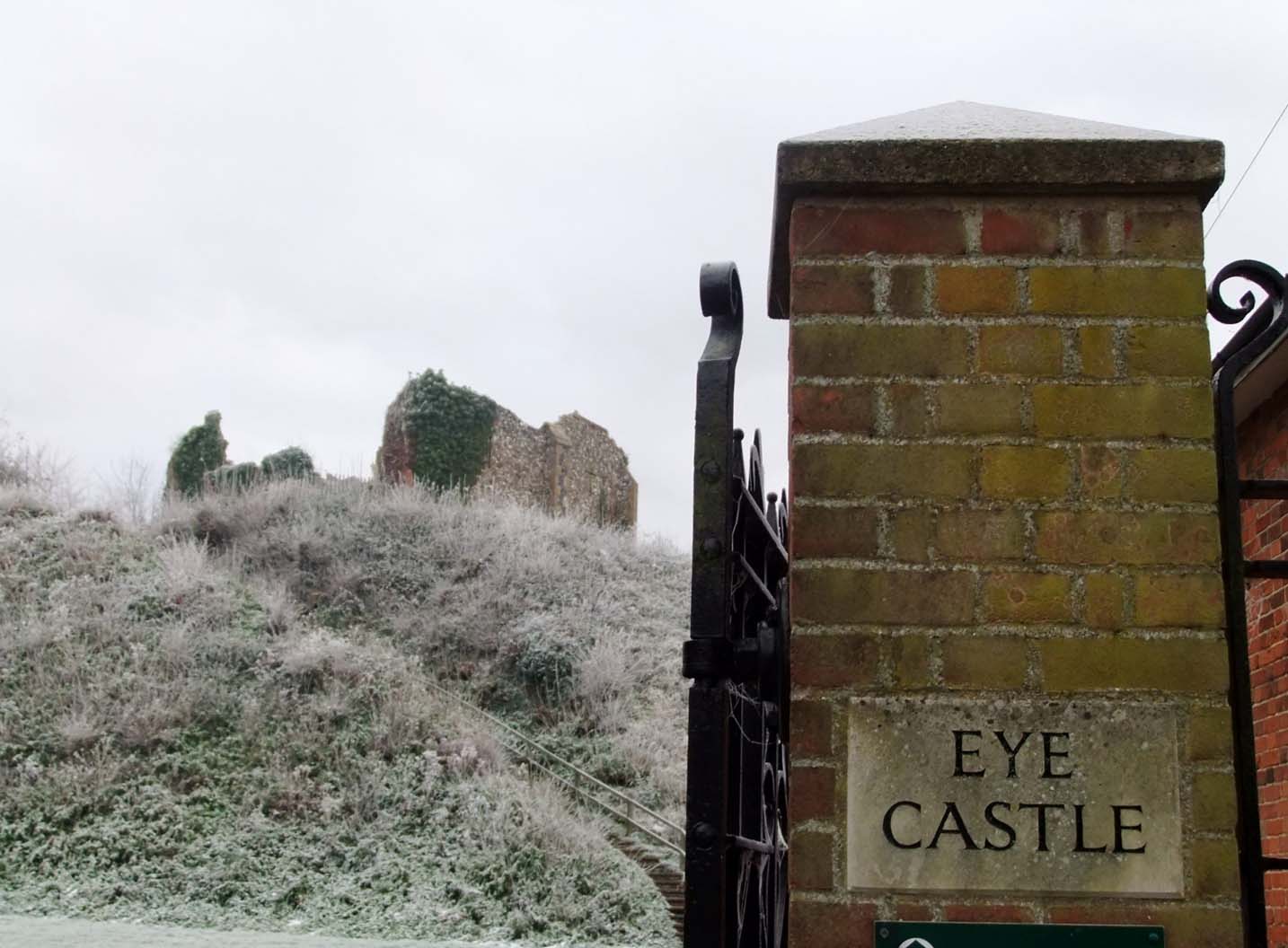
English Heritage handbook
As a member of English Heritage, you receive a free Handbook of all their properties, along with opening times, directions and admission fees. While looking through this guide for the first time, we noticed that a substantial proportion of the properties actually have free entry.
This does also mean that there are no services and the actual site may not be quite as well maintained as other locations. Nonetheless, we were still amazed at how many sites there are around England that you can visit without paying any kind of admission.
While we still used our English Heritage membership to the fullest over the next year, we also visited a lot of these free sites. Many of them were in out the way places we may never have visited otherwise, and wouldn’t necessarily be in travel guides or featured by local tourism agencies.
How to find free castles to visit
The English Heritage Handbook is £10.95 to buy and have a hard copy of, but a ll of the property listings are also listed online on their website. The property search even has a ‘free to enter’ option. If you did want a hard copy, there are cheaper second hand and older editions available on eBay.
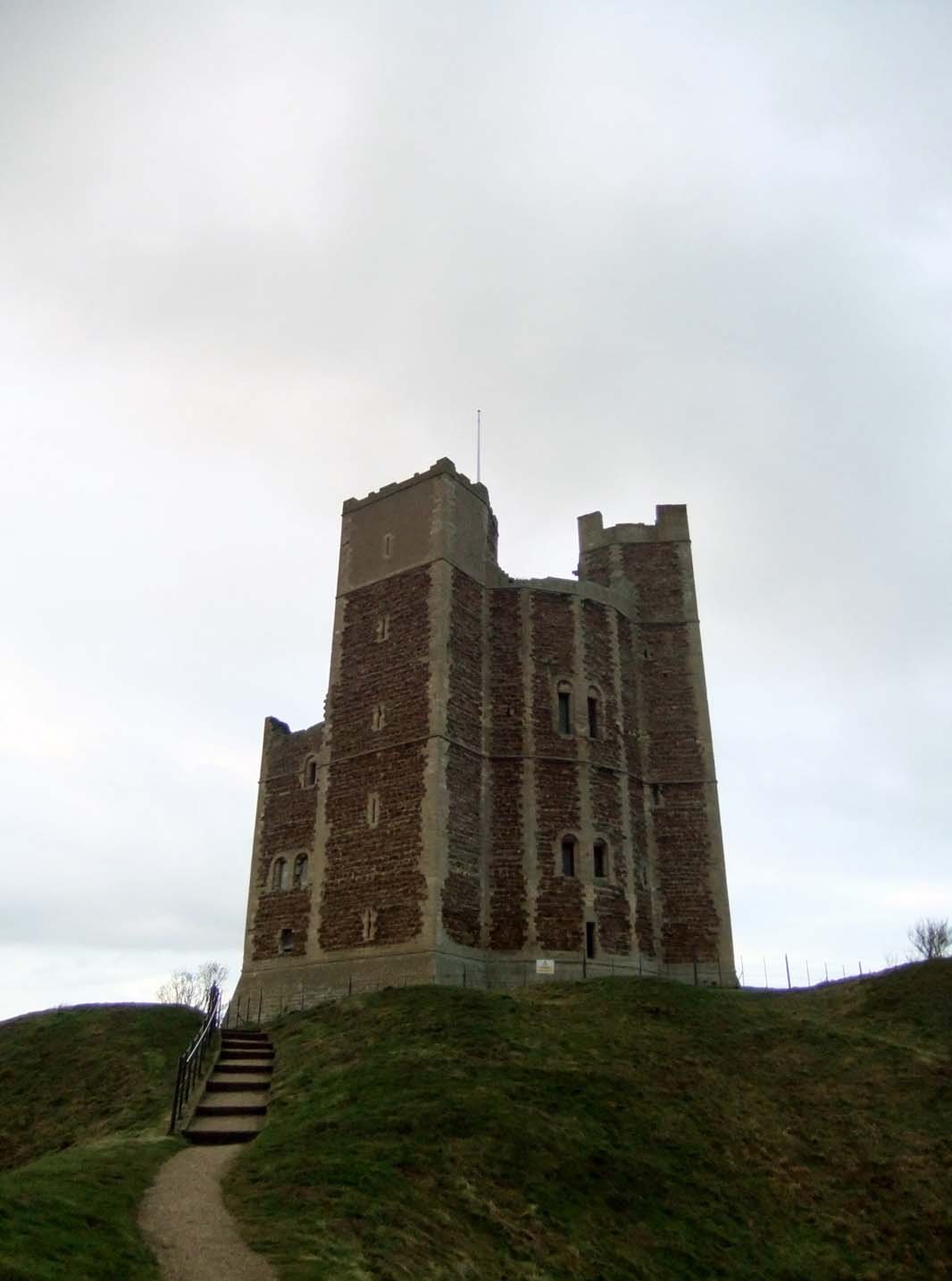
Visiting historical places out of season
Something else we noticed about English Heritage was the limited opening times of some of their paying properties. We did a fair bit of travelling mid-week and outside of peak season (September, December, March) and sometimes could not visit certain properties as they were either closed in the off season or only open during weekends.
It makes sense, but it’s something we didn’t even consider before buying the membership. It wasn’t all bad though, as we could still see and explore the outside, which was usually good enough!
Two of my favourite examples are Framlingham and Orford castles in Suffolk. Just as stunning on the outside as I assume on the inside, we were still glad we made the journey.
Halliggye Fogou, Cornwall
One of our favourite finds was Halliggye Fogou in Cornwall, an underground passage system. It was used in 200BC – 400AD, possibly for storage or refuge. We were amazed at the number of passageways and caves you could explore.
Some of them were so narrow you had to crawl or squeeze through. It was like something out of an action movie or video game like Tomb Raider.
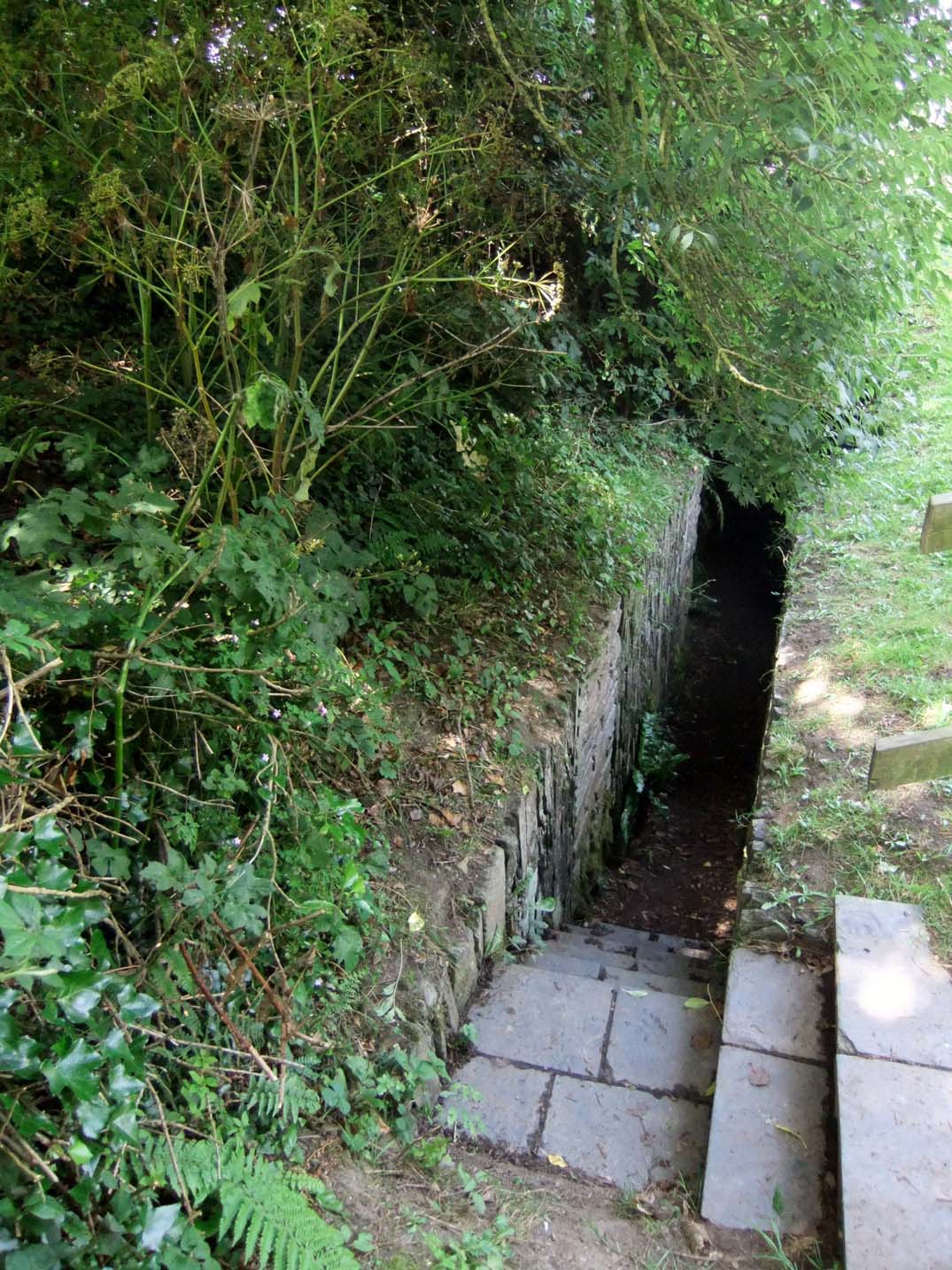
Adventure in your inbox
Subscribe to our monthly email newsletter and receive a round-up of our latest outdoor adventures plus other exciting beyond the beaten path destinations
We never share your information with third parties and will protect it in accordance with our Privacy Policy
Check out these other UK posts next

South Downs Way, UK: Complete Walking Guide
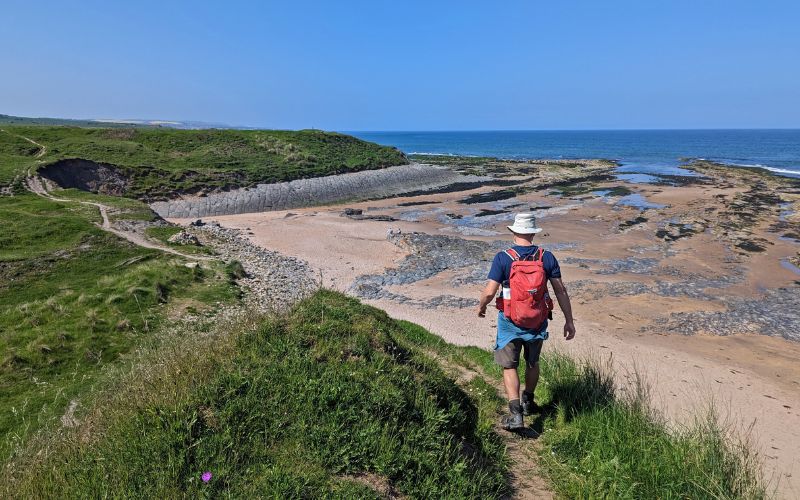
Northumberland Coast Path, UK: Complete Hiking Guide
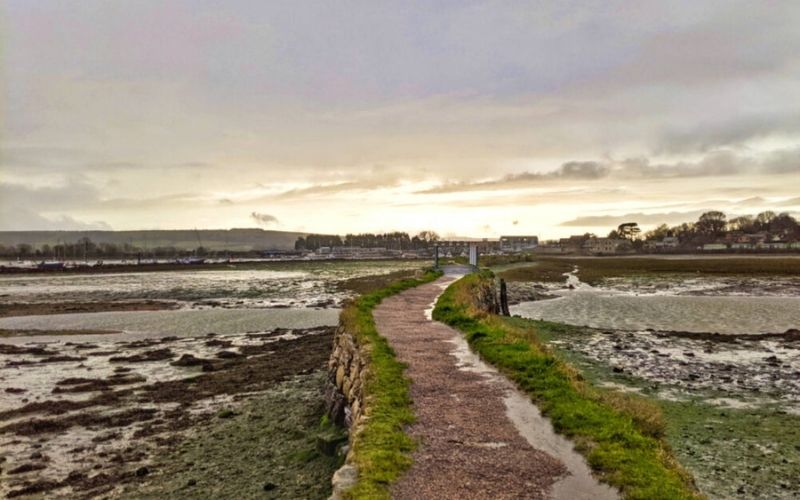
Isle of Wight Coastal Path, UK: Complete Walking Guide

One half of the Canadian/British couple behind Off Track Travel, Gemma is happiest when hiking on the trail or planning the next big travel adventure. JR and Gemma are currently based in the beautiful Okanagan Valley, British Columbia, Canada
Thursday 1st of May 2014
An enjoyable read. I hadn't heard of some of the castles you mentioned! A couple of my favourites are Corfe Castle in Dorset and Caernarfon Castle in Wales - see beow: http://www.nationaltrust.org.uk/corfe-castle/ http://www.caernarfon-castle.co.uk/ Keep finding and visiting them!
Monday 28th of April 2014
all these castles are pretty fascinating,,keep up the good work...btw what are you guys searching for? Treasure hunt may be :)

28 Best Castles In England To Visit
Are you a castle lover heading to England? Here’s my guide to the 28 best castles in England to put on your bucket list.
I must admit I’m a little obsessed with castles, and England is the perfect place for castle stalking. The country is blessed with scores of fairytale castles, both massive and petite.
Many of these English castles are UNESCO World Heritages sites or heritage monuments. They come complete with intriguing backstories, having set the stage for family feuds and pivotal events in British history.
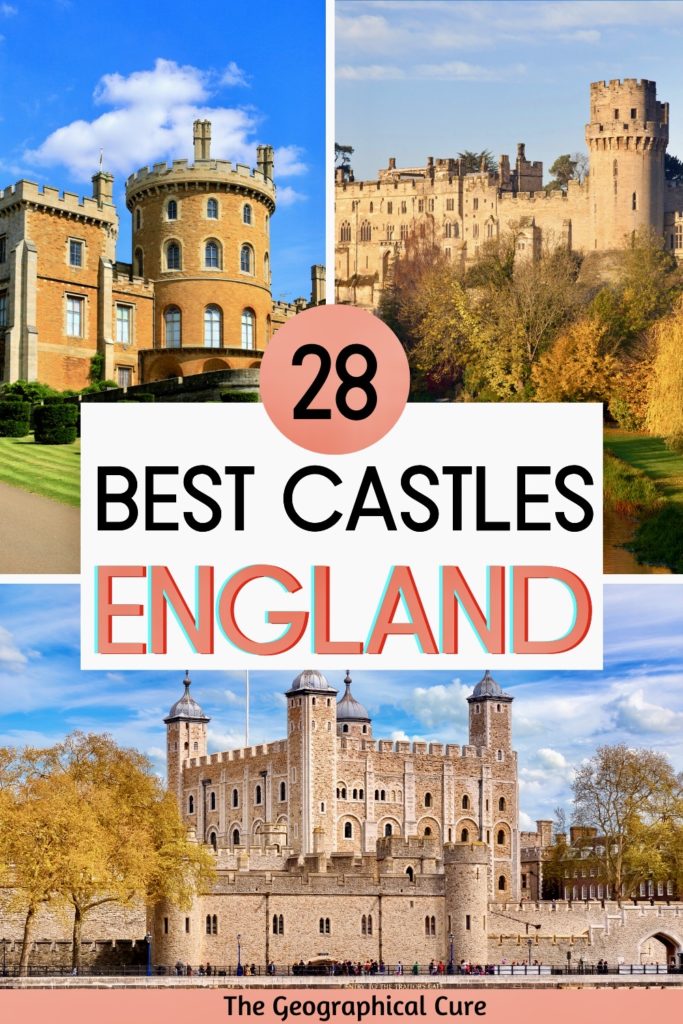
Some of these English castles are in ruins. Others are well preserved medieval edifices. All of them boast picturesque settings — clinging to cliffs, rocky outcrops, or set amid shimmering moats.
On a visit to these amazing castles in England, you’ll step back in time and have a royal day out. Many of these castles make great day trips from London .
History Of Best Castles In England
Castle building in England began in earnest after the Norman Conquest in 1066. William the Conqueror used them both for defense and as a symbol of Norman power.
The first castles were wooden “motte and bailey” designs. This meant a wooden keep was built on a raised mound (the motte) with an enclosed courtyard (the bailey). The “keep” was the center and most fortified part of the castle.
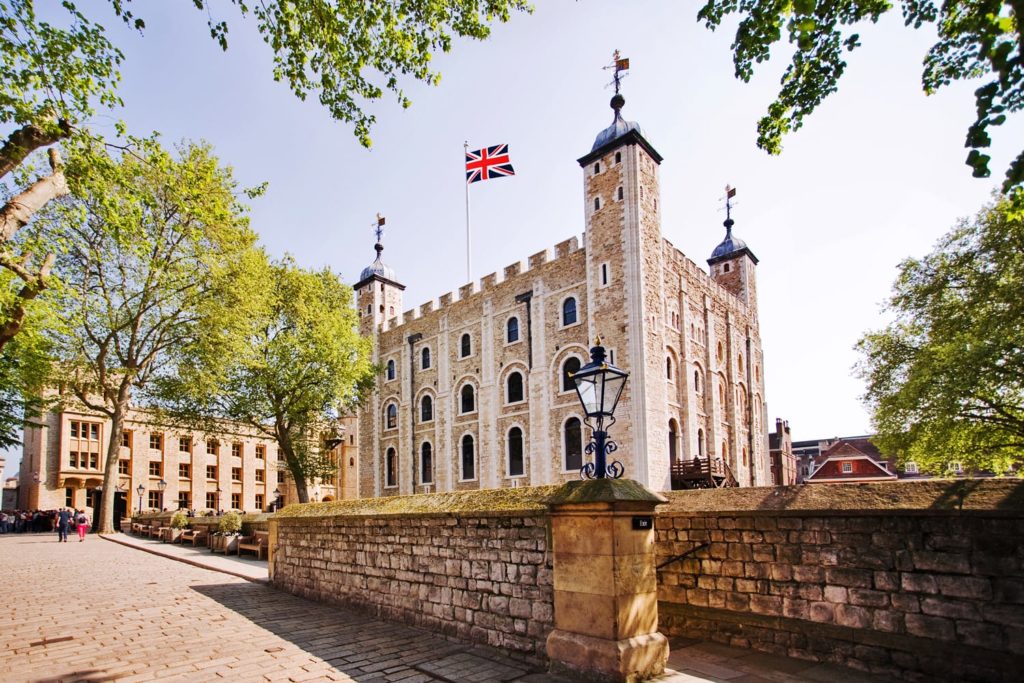
Soon enough, wooden castles gave way to stone castles with elaborate gatehouses, towers, and curtain walls. Towers were of supreme importance. They were used to fire weapons, sling arrows, or pour boiling liquids down on the invading enemy through “murder holes.”
Some castles fell into ruins. Sometimes they remained in ruins because their strategic value had diminished or because the owners couldn’t afford to rebuild them.
In the Tudor era, comfort became more important than defense and castles were given less fearsome facades. Many castles became royal property with lavish interiors more akin to palaces.
Long after these castles in England ceased to have a practical defensive function, they were often kept by their owners for sentimental or historic reasons. Some, like Windsor Castle , are still in use.
Despite their sometimes violent past, many of these English castles are the epitome of romance.
If you are not a resident in England and want to visit several castles, you may benefit from buying an English Heritage Pass for Overseas Visitors . This pass is valid at over 100 properties and is available for 9 or 16 days.
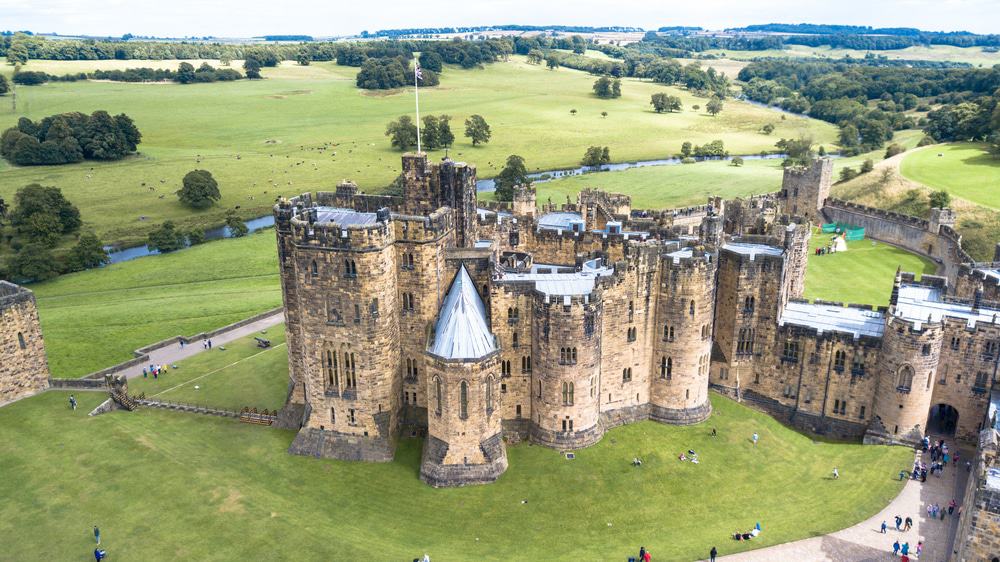
Best Castles In England To Visit
Here are my picks for the 28 best castles in England. I’ve put them in alphabetical order for ease of reference. So cue up your dreamy sighs and let’s explore some amazing English castles.
1. Alnwick Castle, Northumberland
Alnwick is one of the best known castles in England. It’s popular partly for its fame as a Harry Potter filming location.
Alnwick is the seat of the Dukes of Northumberland and is England’s second largest inhabited castle (after Windsor).
The de Veschy family began building the castle in the 12th century. It was one of the first castles without a square keep. When the family line died out, the Percy family claimed the castle.
The first Percy transformed the defensive castle into an even more formidable stronghold and palatial residence. He and his son built the massive towers on each side of the keep’s entrance.
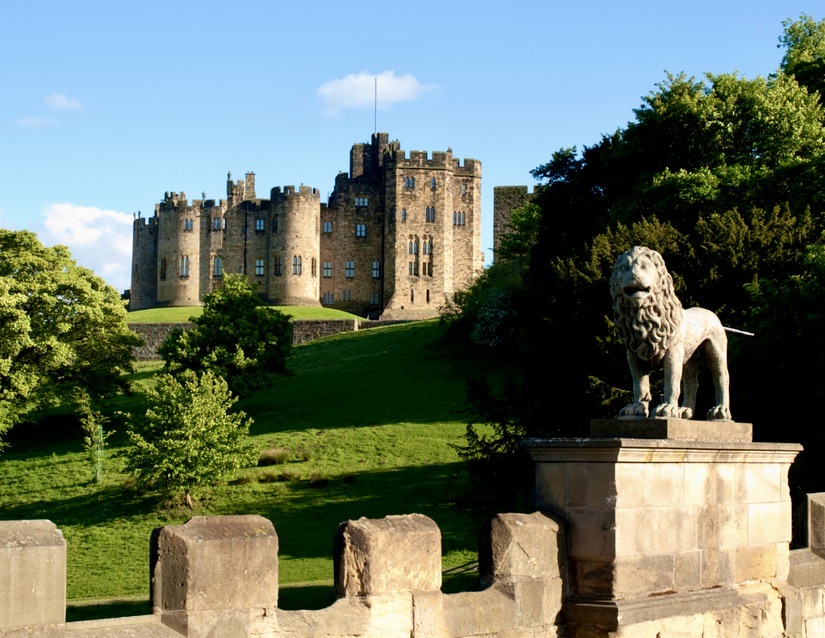
The Percys were intertwined with important events in British history. Hotspur Percy helped Henry Bolingbrook ascend to the throne as Henry IV and became guardian of his son, a young Henry V.
Alnwick Castle also has a spectacular garden renovated by the current duchess. It’s home to over 4,000 species of plants, orchards, pathways, ponds, and the Grand Cascade fountain.
Alnwick Castle starred as Hogwarts School of Witchcraft and Wizardry in the 2001 film Harry Potter and the Philosopher’s Stone and the 2002 film Harry Potter and the Chamber of Secrets . The Outer Bailey is where Harry learned to fly a broomstick.
You can visit Alnwick Castle on a guided day trip from Edinburgh .
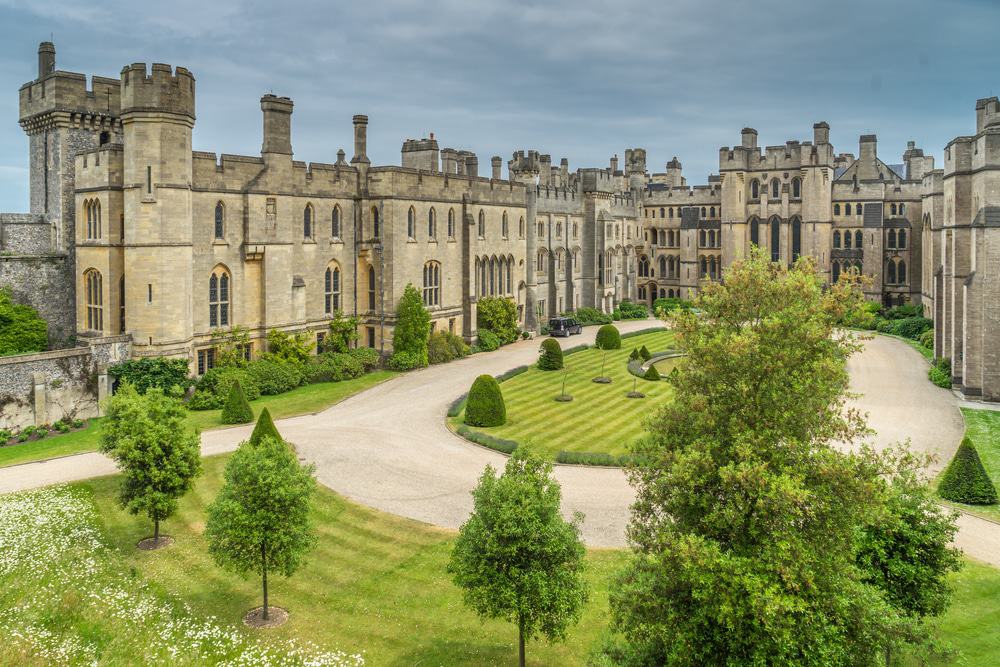
2. Arundel Castle, West Sussex
The town of Arundel is home to one of the best medieval castles in England. Arundel Castle is 1,000 years old.
For centuries, it was the seat of the Earls of Arundel. Since Richard III’s reign, it’s been the Duke of Norfolk’s principal home.
The castle fell into ruin in the mid 17th century after the English Civil War between parliamentarians and royalists. It was later rescued and restored in the 18th and 19th centuries.
The castle follows much the same plan as Windsor Castle. It has a central moat and two baileys to the north and south, curtained with thick walls.
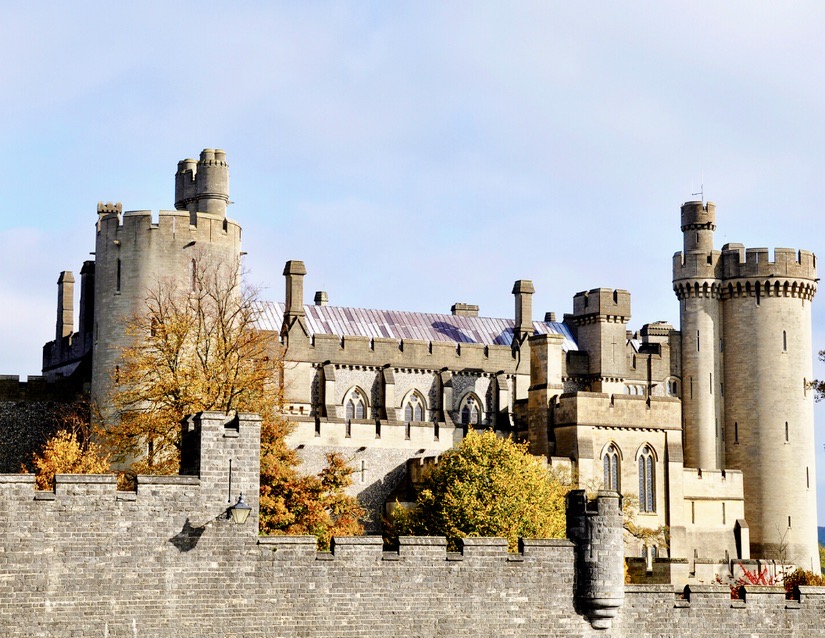
While, it looks medieval, Arundel was actually restored in a Norman style in the Victorian era. So it’s a bit ersatz.
If you climb up the steps of the keep, you’ll have a spectacular view of the River of Arun, the sea, and the town itself.
Arundel Castle also has some magnificent gardens to explore. If you plan to visit in the spring, you can admire the 60,000 tulips that bloom on the property.
In 2021, thieves broke into the castle and made off with artifacts valued at over $1.4 million, including the enameled rosary beads carried by Mary Queen of Scots at her execution in 1587.
You can combine a visit to Arundel castle with the romantic Amberley Castle, just 4 miles down the road. Fortified in the 14th century, Amberley has a dramatic 60 foot wall and twin tower gatehouse.
The castle is privately owned, but you can stay overnight in unabashed luxury by booking one of 15 rooms in the manor house, tower, or Bishop’s Hall.
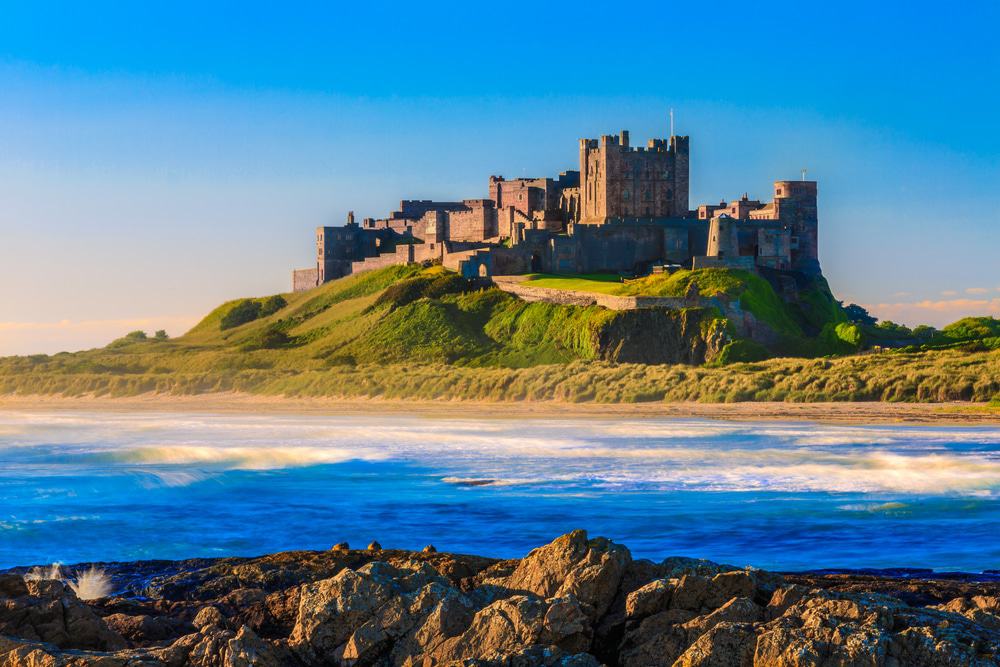
3. Bamburgh Castle, Northumberland
The history of Bamburgh Castle dates back to 420 A.D., when it was a Roman citadel. This makes it one of the oldest and best castles in England to visit.
Situated on a hill overlooking the North Sea, Bamburgh remained an impregnable fortress and royal stronghold for around 400 years. It was intended to stave off Scottish invaders and Viking raids.
The castle’s great keep was the work of Henry II. In the 15th century War of the Roses, Bamburgh became the first castle to be ever defeated by artillery, a new weapon of war.
By the 16th century, the castle was in ruins with only the keep intact. Lord Armstrong bought the castle in the Victorian era and began a massive renovation.
Nowadays, you can head inside to explore the staterooms, grounds, and the magnificent beach it looks over. There are 14 rooms open to the public with over 3,000 artifacts and exhibits. The King’s Hall is the most impressive room, with an intricate wooden ceiling.
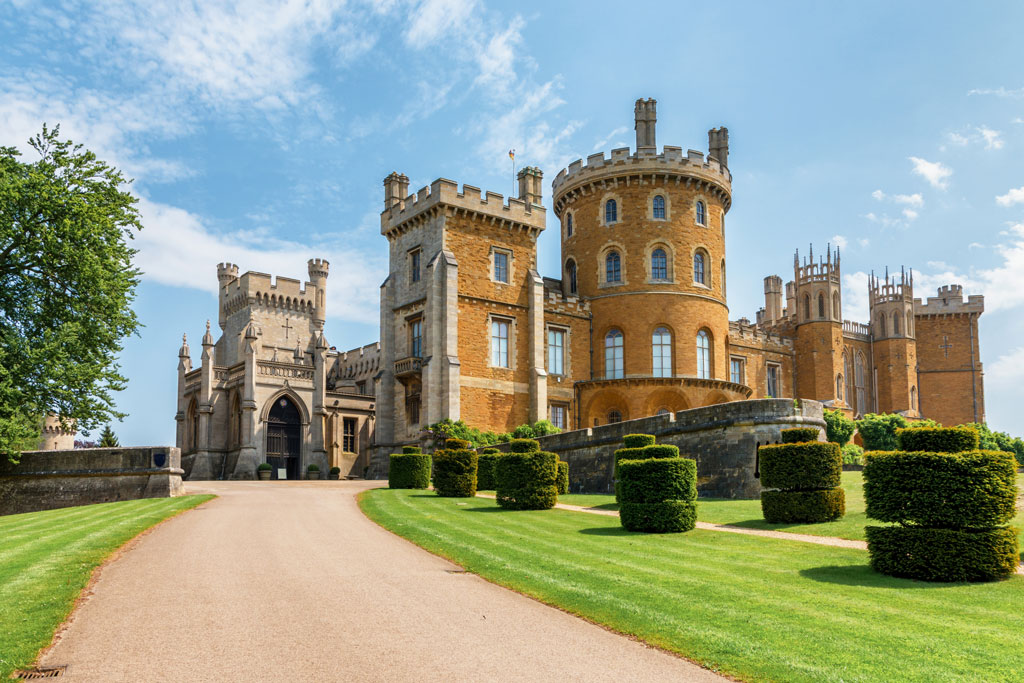
4. Belvoir Castle, Leicestershire
Belvoir Castle is a romantic mock castle in England with an interesting 1,000 year history. It’s a romantic amalgam of architectural styles that make it movie set pretty. And, in fact, Belvoir doubled as Windsor Castle in season 3 of The Crown and in Young Victoria .
The name “Belvoir” translates to “beautiful view.” But the castle’s name is actually pronounced “Beever.”
The first castle on the site was built after William the Conqueror’s ascension to the throne. Belvoir was then in the hands of the Albini and de Roos family for centuries.
The castle was damaged in the War of the Roses. The first Earl of Rutherford got rid of the medieval remnants and turned it into a Tudor manor home.
That castle was then destroyed twice and rebuilt, for the final time, in the Victorian era in a Regency style. Queen Victoria was one of the castle’s many illustrious guests.
A must see room inside is the Regent’s Gallery. It displays Gobelin tapestries that once belonging to Louis XIV of France. The tapestries tell the story of Dion Quixote.
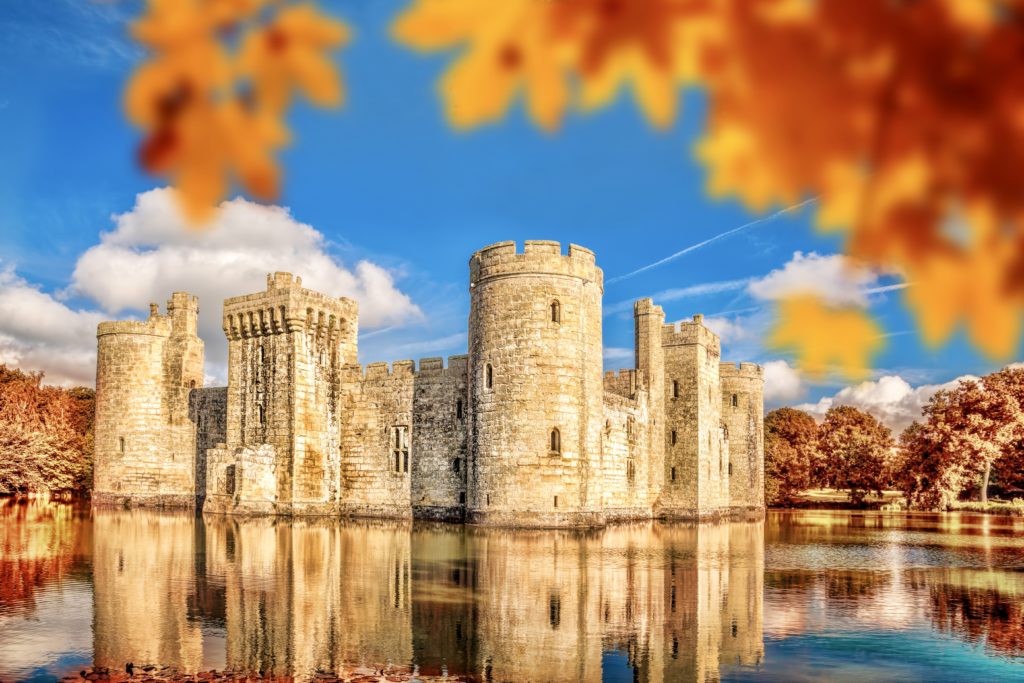
5. Bodiam Castle , East Sussex
Bodiam Castle is one of England’s true storybook castles. It’s a square fortress completely surrounded by a large lake-like moat.
Built in the 14th century by the wealthy Sir Edward Dallingridge, Bodiam is one of the last medieval castles in Britain. It has a perfect symmetry with stout drum towers at each corner and crenellated walls. Conceived as a courtyard castle, it has unusually open middle grounds.
Like many castles of this period, Bodiam combined a fearsome facade with luxury elements. There were big rooms, toilets, and fireplaces.
By the 17th century, Bodiam was a celebrated and romantic ivy clad ruin. The exterior was restored in the 19th century.
You can take the free guided tour or explore each nook and turret on your own. There’s a parking lot on site and you pay at the kiosk.
Bodiam Castle offers free tours that occur almost every day and give a brief history of the castle. The tours start at 12:15 pm and 2:15 pm and last around 35-45 minutes.
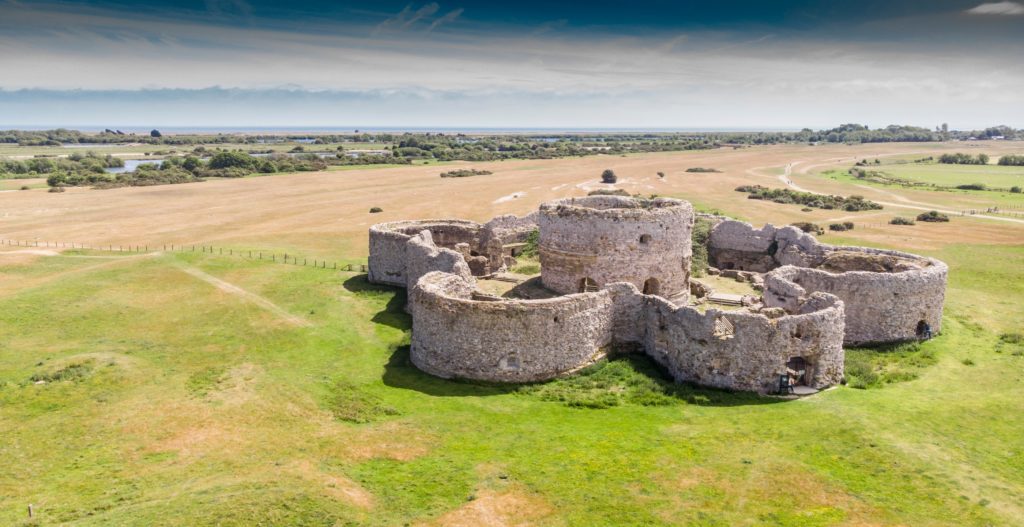
6. Camber Castle, East Sussex
Camber Castle is a one mile walk from the picturesque town of Rye in Kent. It’s also known as Winchelsea Castle.
It’s a 16th century Henry VIII “gun fort” built in the shape of a flower. It was built to defend Rye Harbor against French attacks.
The castle lies in ruins. You can’t go inside, but you can admire the atmospheric exterior.
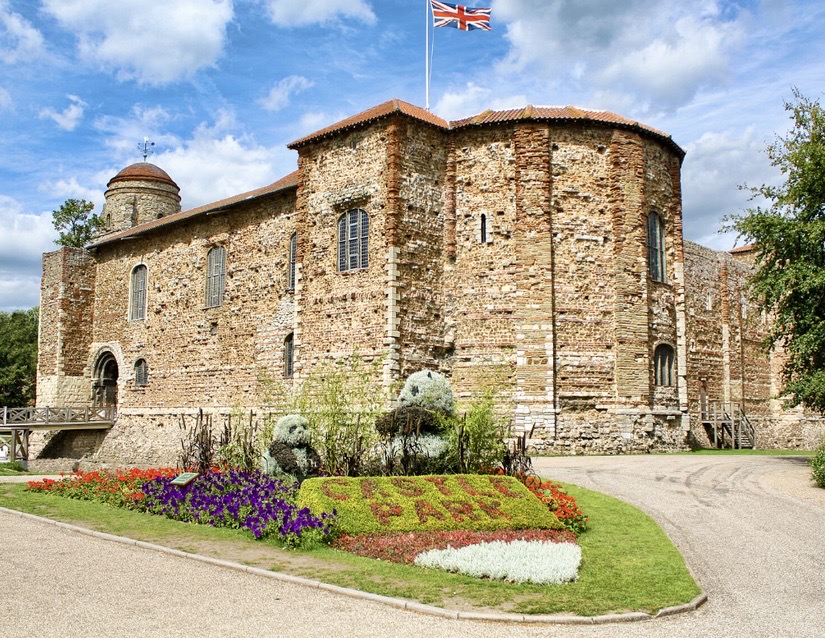
7. Colchester Castle, Essex
Colchester Castle was built in the 11th century and has the largest keep of any castle in England. It was built on the foundations of the Roman Temple of Claudius, linking the Normans with the glory of Rome .
Today, it’s more museum than castle. But the Castle Museum is well worth the visit.
It houses important archaeological artifacts covering 2,500 years of history, including the most important Roman finds in Britain. The most famous piece is the Sheepen Cauldron, a huge and mysterious vessel dating from the Bronze Age in the 2nd century B.C.
An interactive tablet also shows you how the castle would have looked in its heyday.
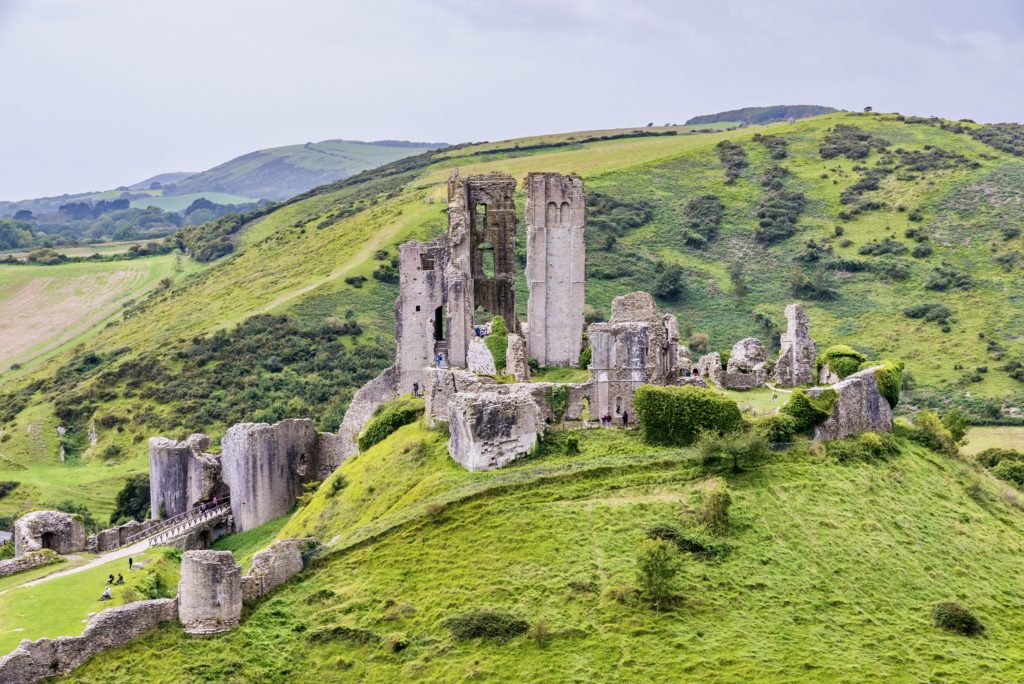
8. Corfe Castle, Dorset
The once powerful Corfe Castle now lies in jagged ruins. This English castle was built by William the Conqueror in the 11th century and destroyed in the English Civil War.
Corfe was an important castle in England. Its location gave William access to southern coast and his homeland. Unlike other Norman castles, it was built out of stone, not wood, further underscoring its importance.
After William, Corfe Castle was a favorite of John and Henry III, who built curtain wall, towers, and a gloriette (a castle within a castle). It remained in royal hands until Elizabeth I sold it to one of her favorite courtiers. In 1635, Sir John Bankes bought the caste.
In 1642, the English Civil War broke out, pitting parliamentarians against royalists. Lady Bankes held out against the parliamentarians until she was betrayed by one of her own officers. As punishment, Corfe Castle was destroyed.
When the monarchy was restored in 1660, Corfe Castle was returned to the Bankes family. But they chose not to rebuild it. In 1982, they bequeathed the castle to the National Trust.
Today, you can wander through the picturesque archways and explore the west bailey, the oldest surviving section of the castle.
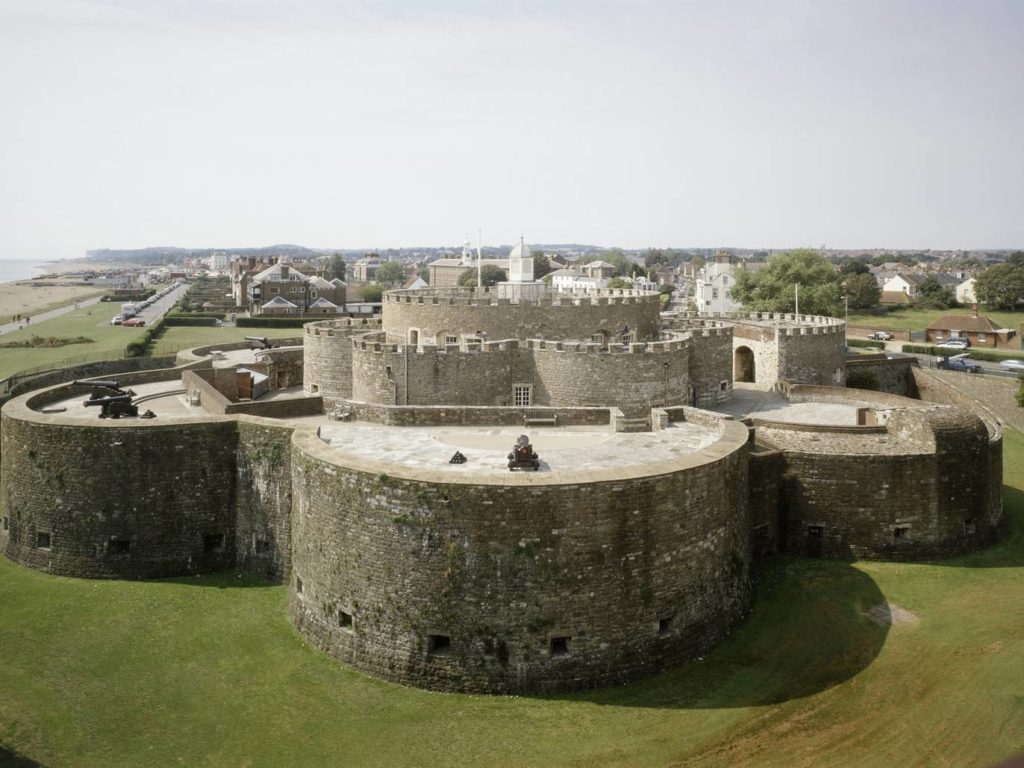
9. Deal Castle, Kent
Built in 1539-40, Deal Castle was the largest of Henry VIII’s “gun forts.” It was built to protect England’s southern coast against the threat of invasion from France and the Holy Roman Empire. The castle was funded by Henry’s dissolution of the monasteries after the Reformation.
Deal Castle has a large central keep with six huge round bastions and an outer moat. It was meant to appear menacing, and it looks almost extraterrestrial.
In total, the castle features 66 firing positions. When viewed from the air, the castle takes on the sexfoil pattern of the Tudor rose.
Deal was famous as the spot where Henry’s fourth wife, Anne of Cleves, landed when she came to England in 1539.
The castle’s information center gives you a good history of the castle and Henry’s military strategies. There are beautiful coastal views from the top of the bastions.
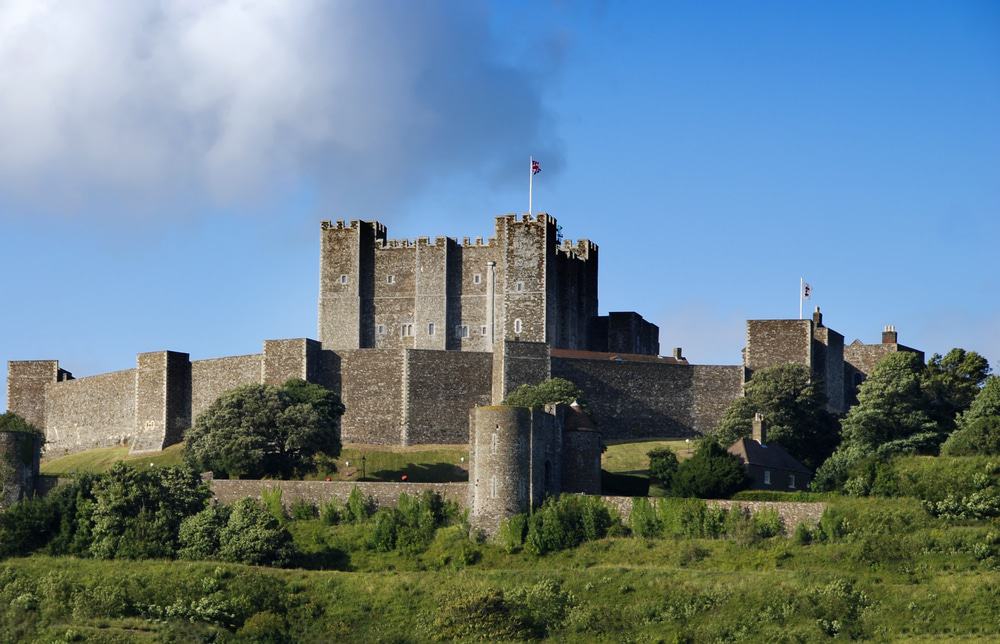
10. Dover Castle, Kent
Dover Castle is awesome in scope and size. Medievalists will be delighted by one of the oldest and best castles in England.
The first fortification on the site dates from the Iron Age. The strength of Dover’s position on the sea was so impressive that even Julius Caesar said it was “no place to attempt a landing” when he attacked England. The Romans further fortified it and then the Saxons moved in.
One of the greatest Norman monarchs, Henry II, built the imposing 12th century keep you see today. He was determined to keep England safe from France, which was just 17 miles away. Dover was a formidable castle the likes of which had never been seen before.
The central keep was 80 feet tall and the walls 100 feet long. The inner wall had 14 towers to accommodate archers.
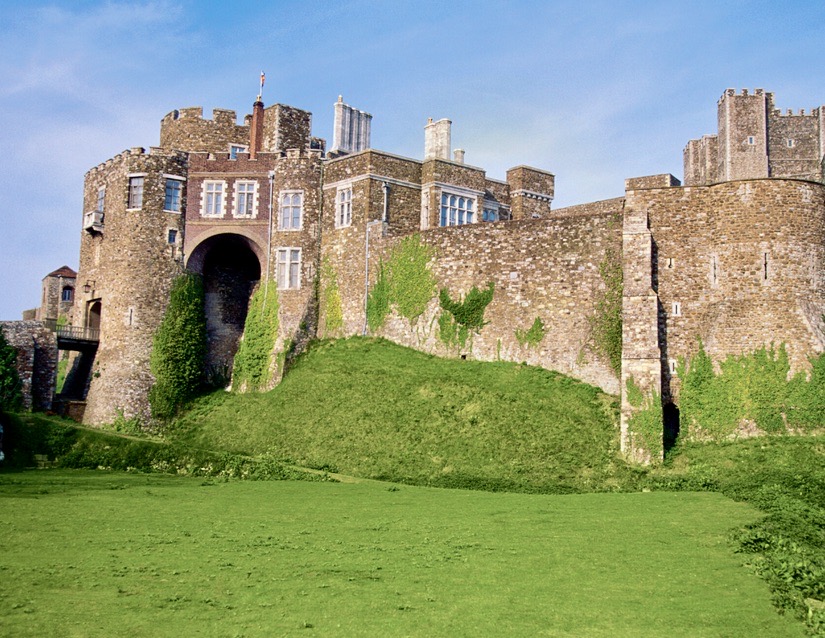
The castle was never breached, though Prince Louis of France almost succeeded in 1216. You’ll find a multi-media exhibition dramatizing the event.
After that close call, Henry III improved Dover’s fortifications once again. He also added the great hall and royal accommodations.
Much of what you see today is unchanged from that era. The castle could take all day to explore, if you wanted to poke into every nook and cranny.
The castle’s highlight is the central keep with its Great Hall, royal chambers, and private chapel.
The Constable’s Gateway is also impressive, with a labyrinth of tunnels that were important to medieval defense and served as an operations center during WWII. You’ll see examples of Medieval and Tudor arms and weaponry.
You can visit Dover castle along with the town of Canterbury on a guided day tour from London . You can also check out my complete guide to spending one day in Dover on a day trip from London .
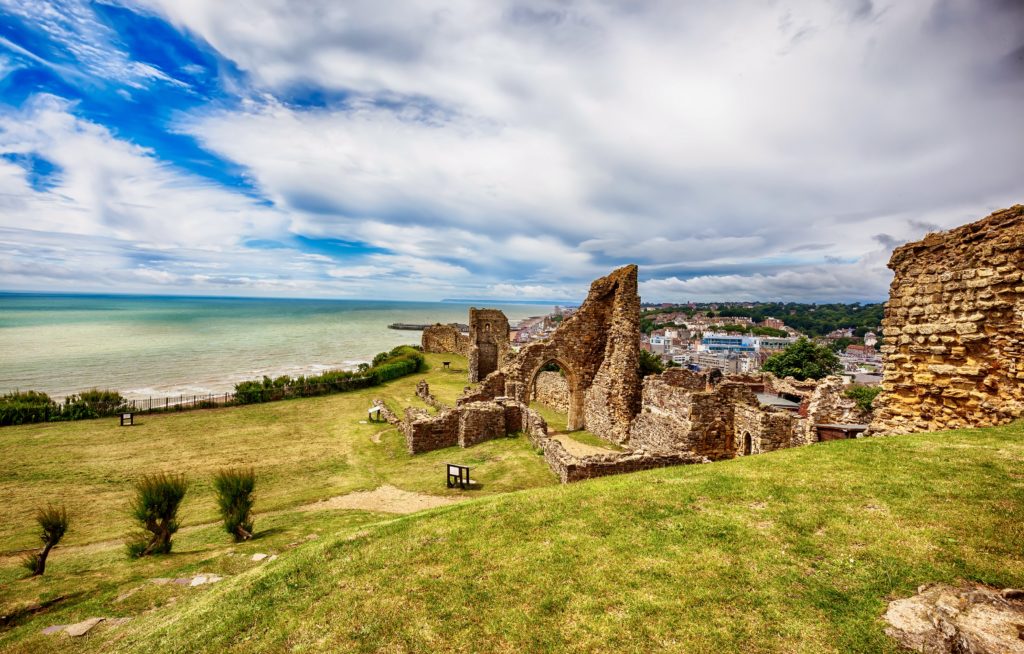
11. Hastings Castle, East Sussex
Hastings Castle is an 11th century ruined castle built by William the Conqueror after landing in England. With a good harbor and site at the end of a peninsula, it was easy to defend.
The building of the castle is depicted in the famed Bayeux tapestry, which chronicles the events leading up to William’s invasion of France.
From this stronghold, William rampaged through southeast England, leading a campaign of intentional destruction and looting.
All the remains of the historic castle is a few walls and crumbling stone structures.
Because it’s perched high on a steep cliff, Hastings is not the easiest castle to visit. The only way up is via a steep staircase or funicular.
While visiting Hastings, you can watch 1066 Story , a 20 minute film on the fascinating history of the castle and the battles that decided England’s fate.
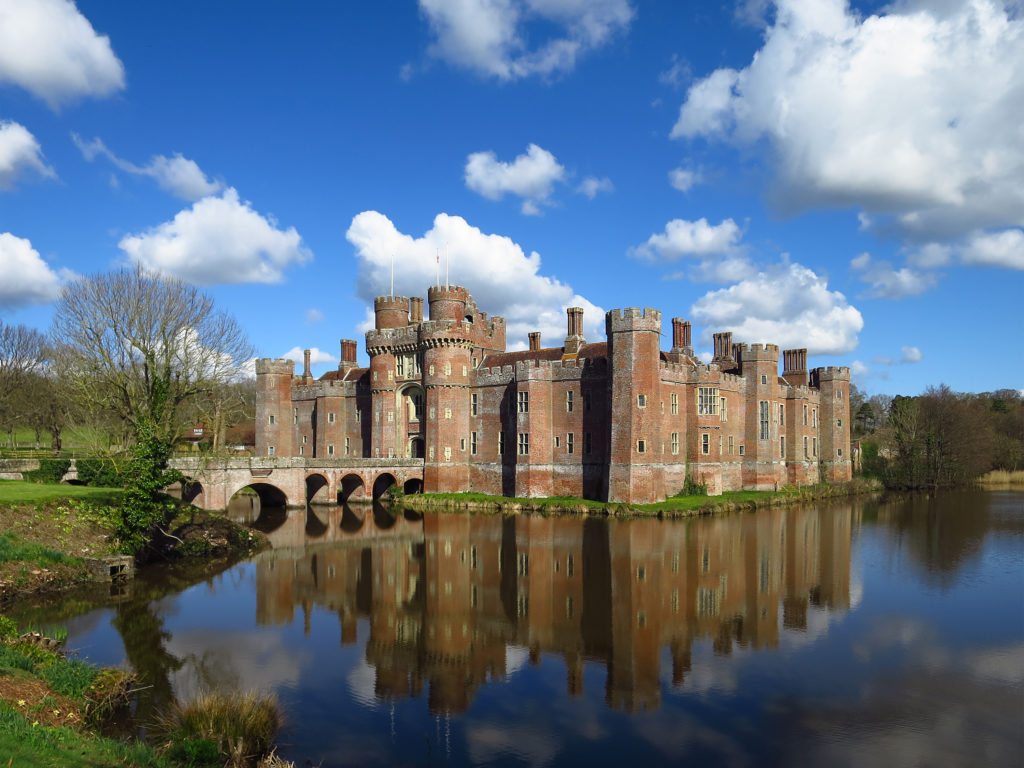
12. Herstmonceaux, East Sussex
Like Bodiam Castle, Herstmonceaux Castle was built to stave off possible French invasion. The 15th century castle is really more manor house than craggy castle.
Still, the castle has a battlements, a moat, and 300 acres of lovely gardens and woodland. The Elizabeth Garden is the most exquisite, with its rambling roses and daisies.
The red brick exterior is original, but the interior has been completely remodeled.
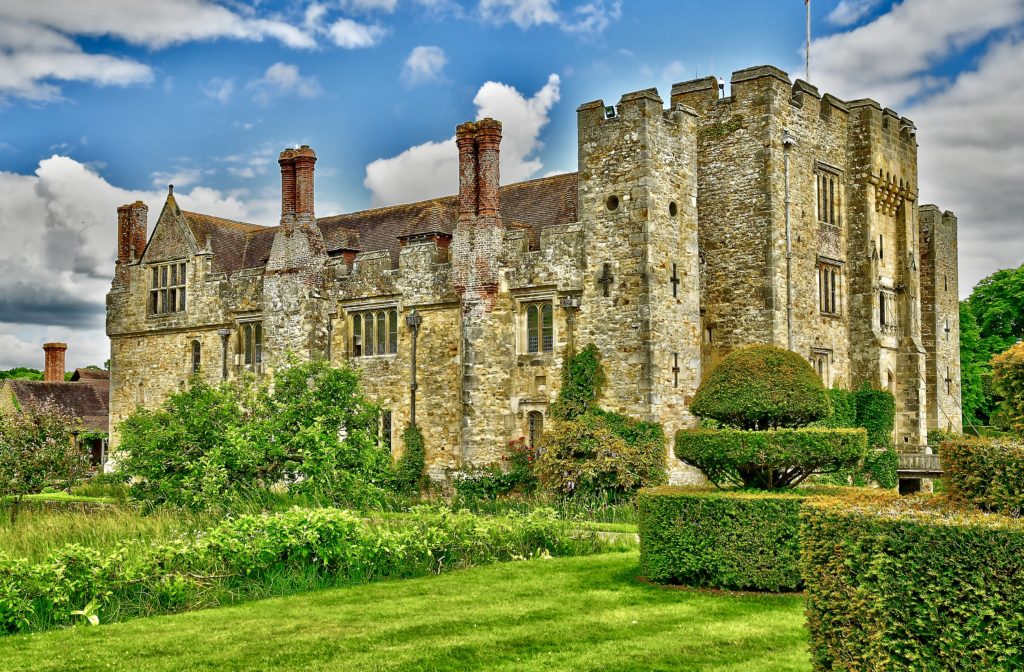
13. Hever Castle, Kent
If you’re a Tudor enthusiast, Hever Castle is one of the best castles to visit in England. Hever is a petite double-moated castle with a craggy romantic visage that’s largely unaltered by time.
It’s famously linked to the ill-fated royal couple, Anne Boleyn and Henry VIII . Their story is a fascinating one, one of the most dramatic in English history.
Hever was the childhood home of Anne, Henry’s second wife. It’s also linked to Henry’s fourth wife, Anne of Cleves, who was installed there after Henry divorced her in favor of Anne.
On a visit to Hever Castle, you can walk in the footsteps of these famous Tudor monarchs. And you can admire the castle’s medieval keep and gatehouse, Tudor rooms, original portraits, and exquisite gardens.
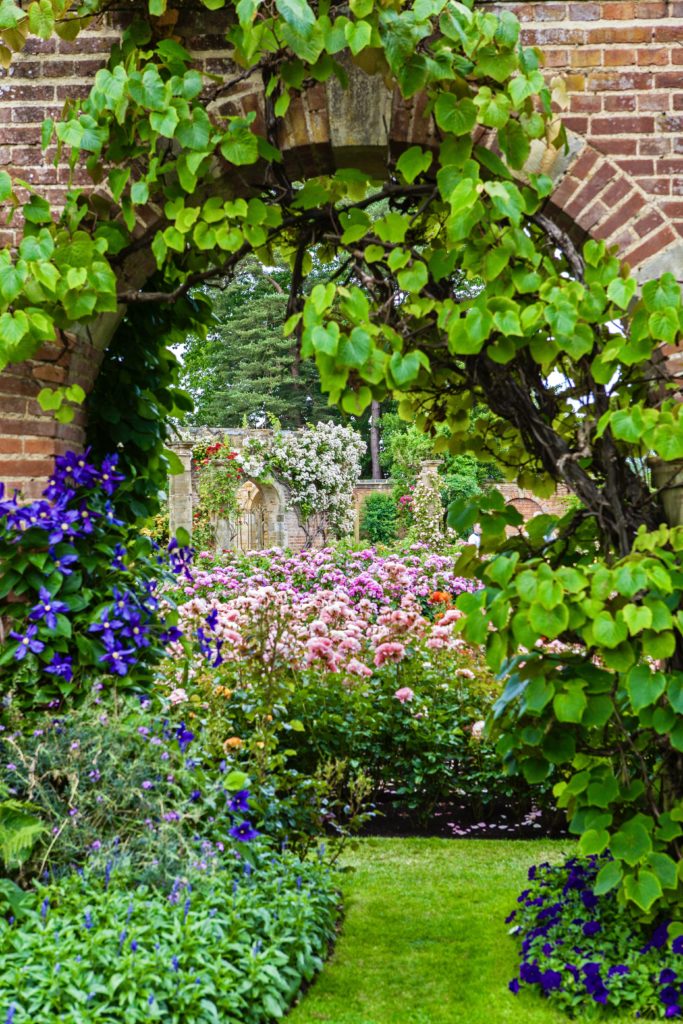
The award-winning gardens are set over 125 acres. The peerless Italian Garden is the highlight of the castle gardens. It’s the setting for a collection of classical statuary from Roman to Renaissance times.
You can also row boats on the 38 acre lake, wander through yew and water mazes, sniff roses, or try your hand at archery. There’s even an open water swimming course.
Here’s my complete guide to Hever Castle . You can get to Hever Castle from London on several guided day tours:
- a full day guided Tudor tour of Hever Castle and Hampton Court Palace
- a private half day tour to Hever Castle
- or a 6-8 tour of Hever Castle and Garden
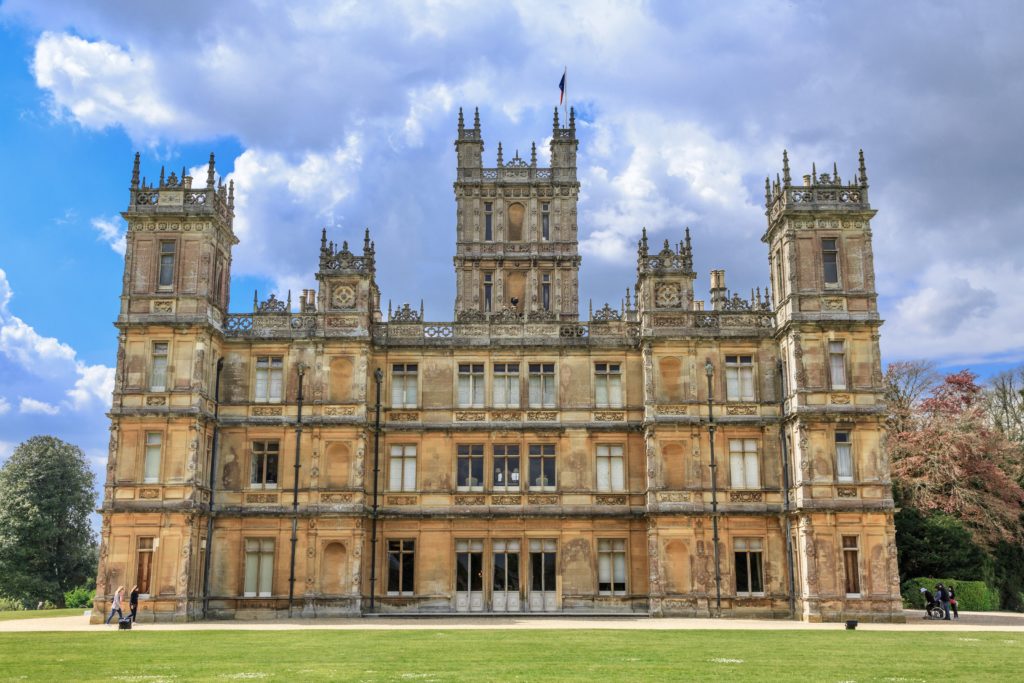
14. Highclere Castle, Hampshire
Highclere Castle is the country seat of the Earl of Carnarvon and one of England’s best and most beautiful castles. The stunning 300 room castle is most famous, though, as the real life Downton Abbey from the hit British period TV series.
Originally built in 1679, the castle was remodeled in the 1840s by the same architect who designed the Houses of Parliament in London. Famous landscape architect Capability Brown designed the gardens.
Royalty, politicians, famous writers, and film stars have stayed at Highclere Castle.
The current Earl’s family has been living on the estate since 1679. The Carnarvon are a busy lot. They’ve been involved in the founding of Canada, the discovery of King Tutankhamun’s tomb in Egypt, scandalous affairs, and sordid court cases.
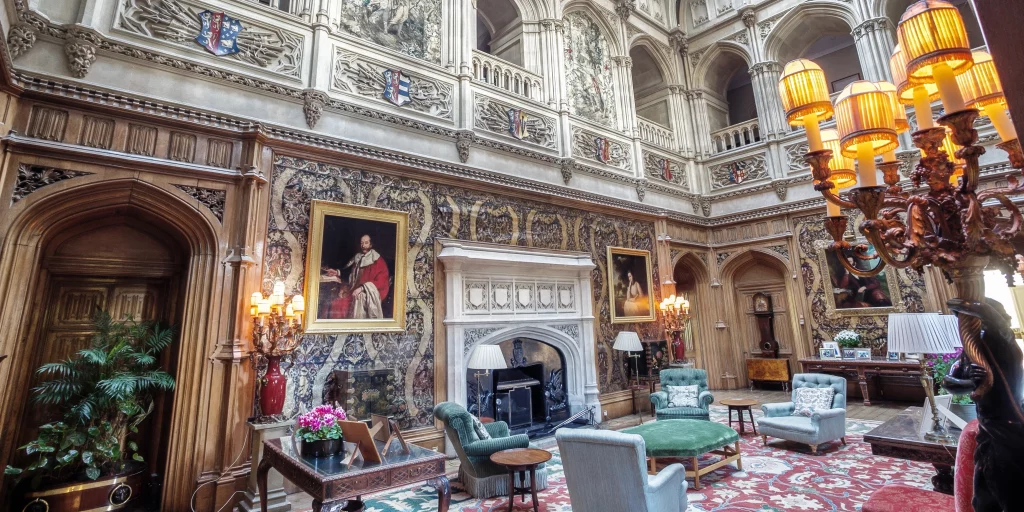
The main things to see are the State Rooms, the Egyptian Exhibition, and the gardens.
The castle is open seasonally, so check opening dates on the website before planning a visit.
Highclere has some special events throughout the year, including an Easter Egg Hunt, Afternoon Tea, and various Christmas events. These events sell out quickly, so you should pre-book tickets online in advance.
The easiest way to get to Highclere is by car.
If you’d rather take a guided tour, this one includes a visit to Highclere Castle and other Downton Abbey filming locations . You can also book a guided tour from London that combines Highclere and Stonehenge .
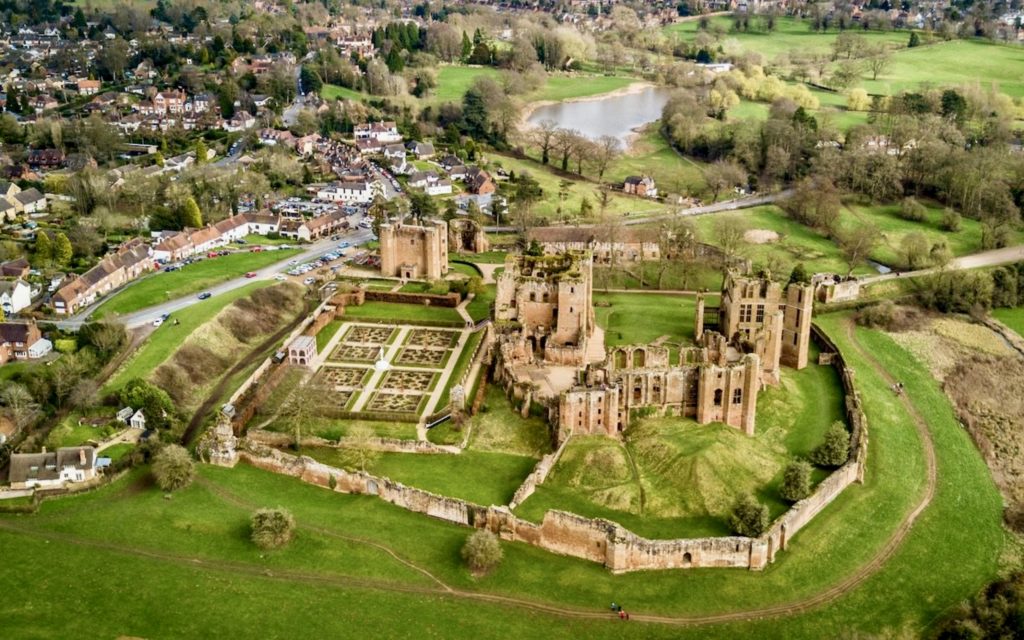
15. Kenilworth Castle, Warwickshire
Kenilworth Castle was once the seats of medieval nobles. Today, the former castle lies in a heap of evocative ruins.
But what lovely ruins they are for ruin lusters. This is a place where your imagination can run wild.
Kenilworth has a compelling history and a colorful cast of characters. Sir Geoffrey de Clinton began work on the castle in 1122. But he didn’t hold it for long.
Henry II confiscated it to defend himself against his rebellious son. The king’s other son, King John, added a curtain wall and three defensive towers. He was later forced to surrender the castle as proof of his intent to comply with the Magna Carta.
When Henry III ascended the throne, he grabbed Kenilworth back and gave it to his sister and her husband Simon de Montfort. Bad move.
Montfort was angered by Henry’s chipping away at noble rights and soon led a rebellion. He lost in one of the most famous sieges of the Middle Ages.
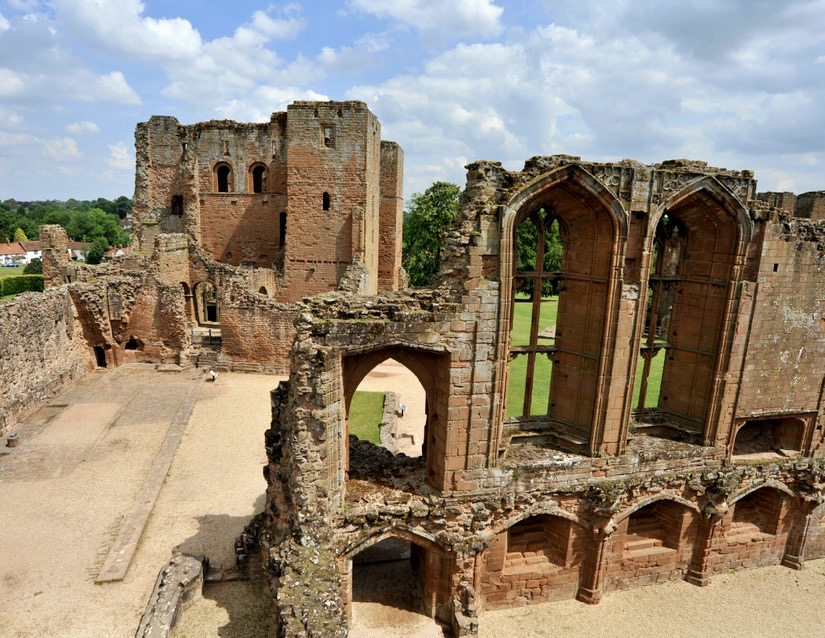
After this battle, violence gave way to a more genteel castle. The Lancastrians took ownership, gussied up the place, and built a Great Hall. Under Henry IV, the castle officially became a royal residence.
Kenilworth’s swan song came when Elizabeth I gave the castle to her favorite courtier, Robert Dudley. He built enormous guest quarters to accommodate and delight the queen and her entourage on her famous visit in 1575. After that, the castle went into decline through disinterest and abuse.
Today, you can stroll the castle grounds and reconstruct its history. Take a walk along the curtain wall and see Mortimer’s Tower and Water Tower (the best preserved bit from the 13th century).
Near the Water Tower is Leicester’s Stables, which houses an exhibit on the castle’s history. Admire the gatehouse and then venture into the inner court.
Inside, you can admire the ruins of a Norman keep with turrets. You can see balls imbedded in the walls that date from the great siege of 1266. You can also visit the former Great Hall, ascend the Strong Tower for views, and see the ruins of Dudley’s buildings for Elizabeth.
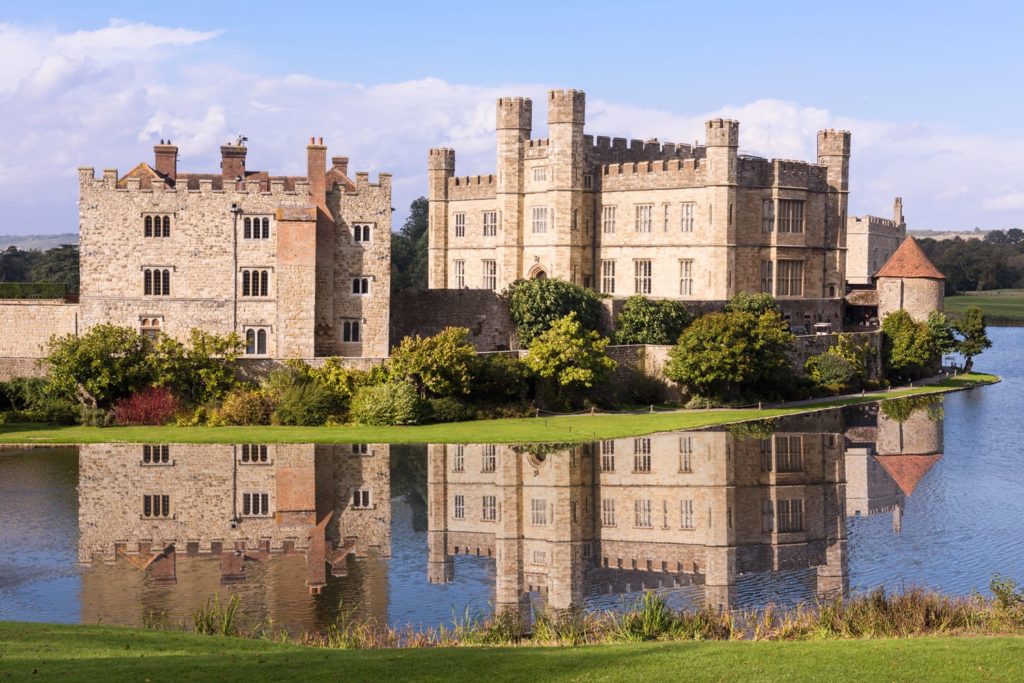
16. Leeds Castle, Kent
Leeds Castle is one of Britain’s best and most beautiful castles. The castle has a picturesque island setting on a lake in the wooded countryside of Kent.
Leeds’ history is no less romantic. Leeds Castle has been a Norman Stronghold, a Royal Palace, and the stately home of an American heiress.
Today, you can visit the New Castle, the 13th century Gloriette tower, Maiden’s Tower, and the extensive grounds and gardens.
The castle was a royal residence until Tudor times and known as the “Ladies Castle.” Seven queens lived at Leeds.
The castle was also a favorite abode of Henry VIII, who shuttled his ex-wife Catherine to live there permanently after their divorce.
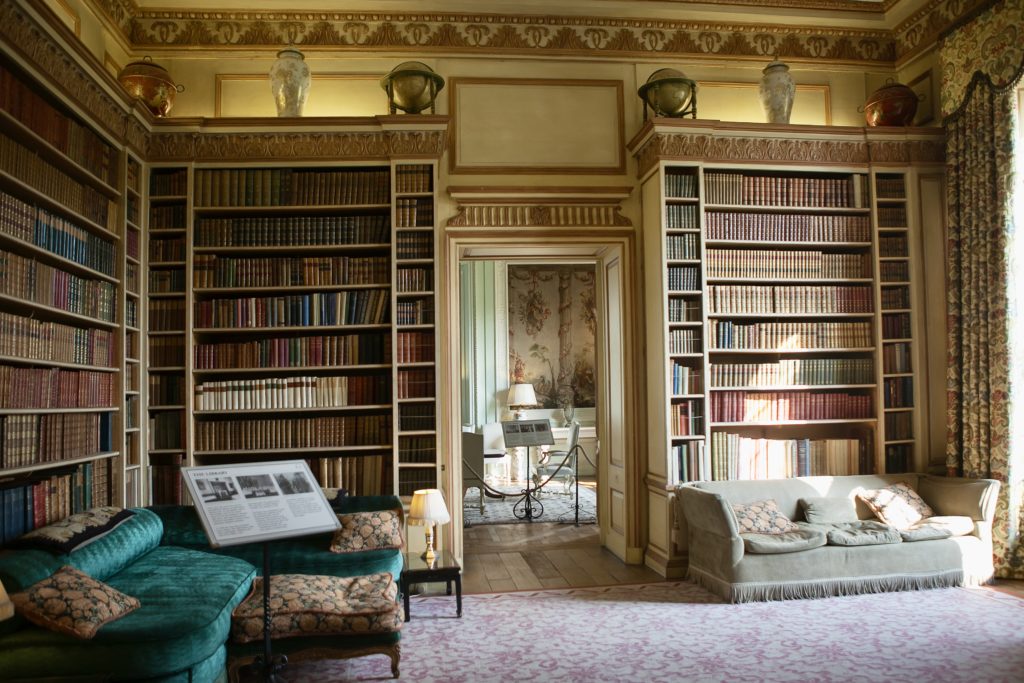
With Henry’s deep pockets, he lavished improvements on it, transforming Leeds from castle to royal palace. He added grand reception rooms, suites of rooms in the Gloriette, the graceful Maiden’s Tower, expensive glass, and fireplaces.
Thereafter, the castle fell into ruins. In 1926, American heiress Olive Paget (later Lady Baillie) purchased the castle. She saved it from centuries of neglect and restored it to medieval perfection.
You’ll be dazzled by its pristine landscaping, tasteful period furniture, and collection of medieval memorabilia.
The highlight is the Gloriette. You can visit the Banqueting Hall, the royal bedrooms, and climb the 16th century spiral staircase.
The castle is set on 500 acres of park land, landscaped by Capability Brown. The gardens include the Culpepper Garden, the Princess Alexandra Gardens, and the Lady Baillie Mediterranean Garden.
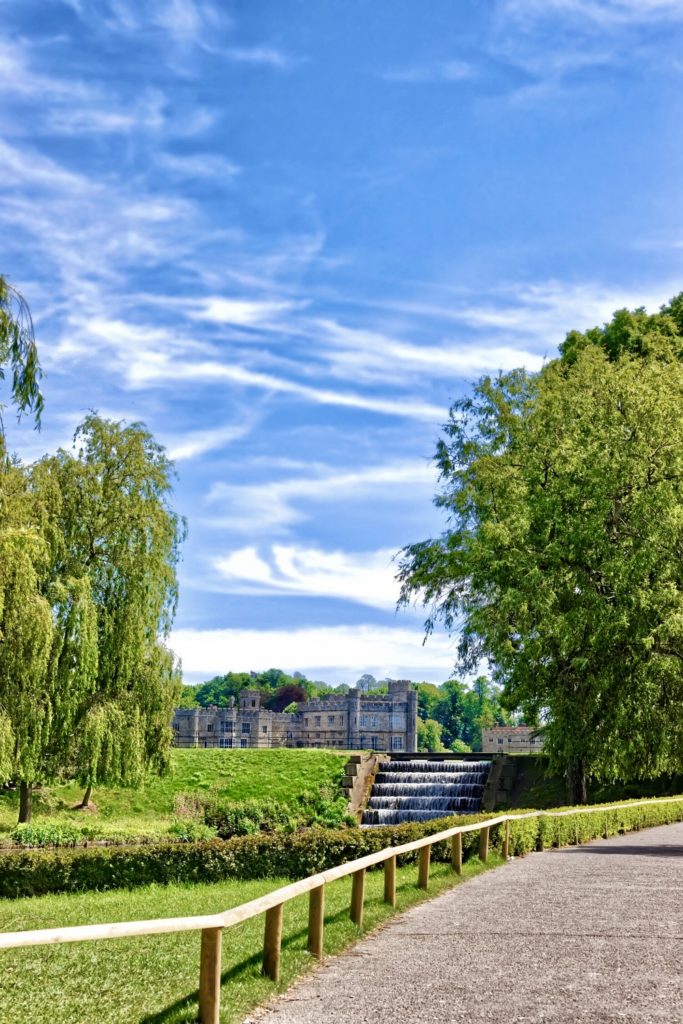
Children will enjoy the mazes, the duckery, the aviary, and the archery station.
For more information, here’s my complete guide to visiting Leeds castle . In high season, you should pre-book a skip the line ticket for the castle. It’s a bit pricey, but good for an entire year.
There are also guided sightseeing tours from London that stop at Leeds Castle. Here are some options:
- 1 0 hour tour combining Leeds, Canterbury, and Dover
- 11 hour tour combi ni ng Leeds, Canterbury, and Greenwich
- 8 hour private t o ur to Leeds and Canterbury
Leeds Castle is also one of the few castles where you can stay overnight in the lap of luxury and feel like a royal. There are traditional cottages and bed and breakfasts available to book, including:
- Weir Cottage ( 1 bedroom)
- The Oast (3 bedroom)
- Stable Courtyard (bed & breakfast)
- Maiden’s Tower (bed & breakfast)
- Holiday Cottages
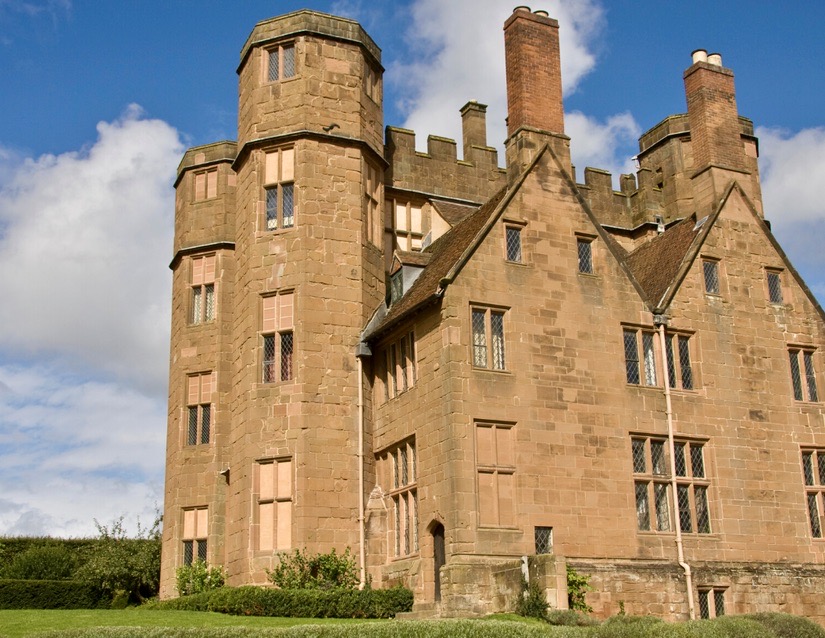
17. Leicester Castle, Leicestershire
Leicester Castle played a pivotal role in the English history. The first iteration of the castle was built just after the Norman conquest in 1066.
By the reign of Henry I, the castle had passed into the hands of the Earl of Leicester. In 1150, he set about improving the defensive structure and built a great medieval hall.
Unfortunately, Henry II sacked the castle in 1173 to squelch a rebellion. Only the Great Hall survived.
Simon de Montfort rebuilt the castle and, in the great hall, held the first English parliamentary session. But royalist forces caught up to de Montfort. He was killed and the castle passed to the Earl of Lancaster, who transformed the stronghold into a primary Lancastrian residence.
During the late 15th century, the castle was still occasionally used as a royal residence — Henry IV, Henry V, Henry VI, and Edward IV all stayed there.
Despite taking a beating during subsequent battles, two important medieval structures remain onsite: the Great Hall and the ancient Church of St. Mary de Castro.
The 12th century Great Hall is believed to be the oldest surviving castle hall with a bay, aisles, and timber roof in all of Europe. The church was the castle’s lavish chapel.
Unfortunately, the interior of Leicester Castle is mostly inaccessible, open only on special event days or Heritage Sundays . You can also attend mass at the church.
READ : One Day In Leicester Itinerary
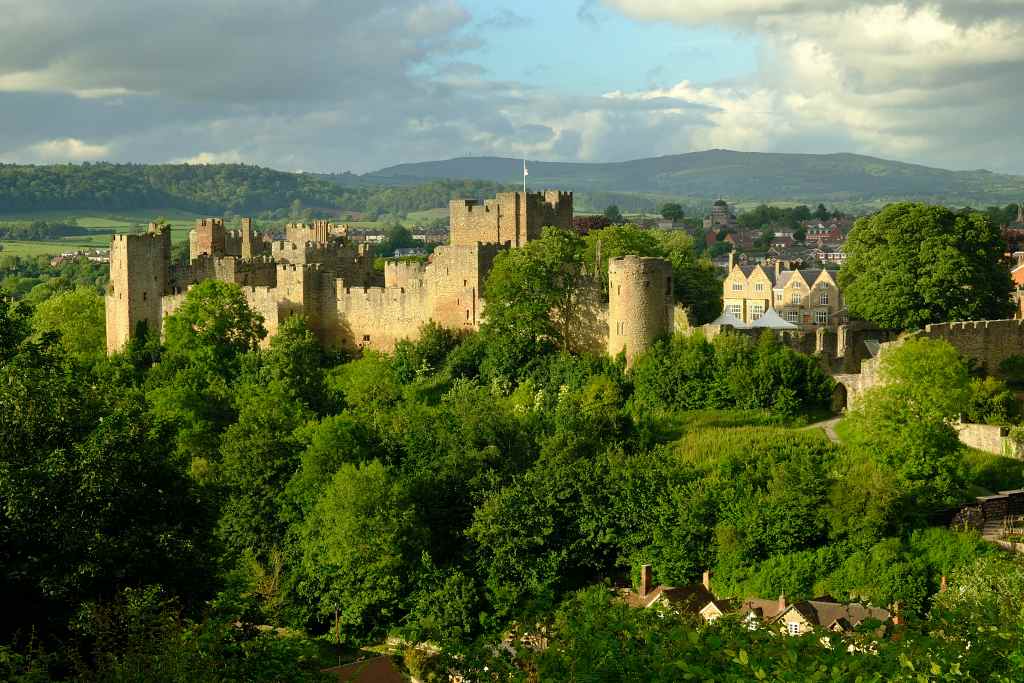
18. Ludlow Castle, Shropshire
Ludlow Castle has been dubbed the “the very perfection of decay,” so ruin lusters will think it’s one of the best castles in England.
The de Lacy family began building Ludlow in the 11th century. You can see remnants of their efforts in the gatehouse, keep, and Norman chapel. The chapel’s unique round nave, associated with the Knights Templar , still stands.
The castle came into the hands of the de Genevieve family in the 13th century and the infamous Roger Mortimer in the 14th century.
Mortimer was the secret lover of Queen Isabella and implicated in the murder of Edward II. When he grew too powerful, he was executed. The tower named for him, Mortimer’s Tower, has a semi-circular design and still stands in the bailey.
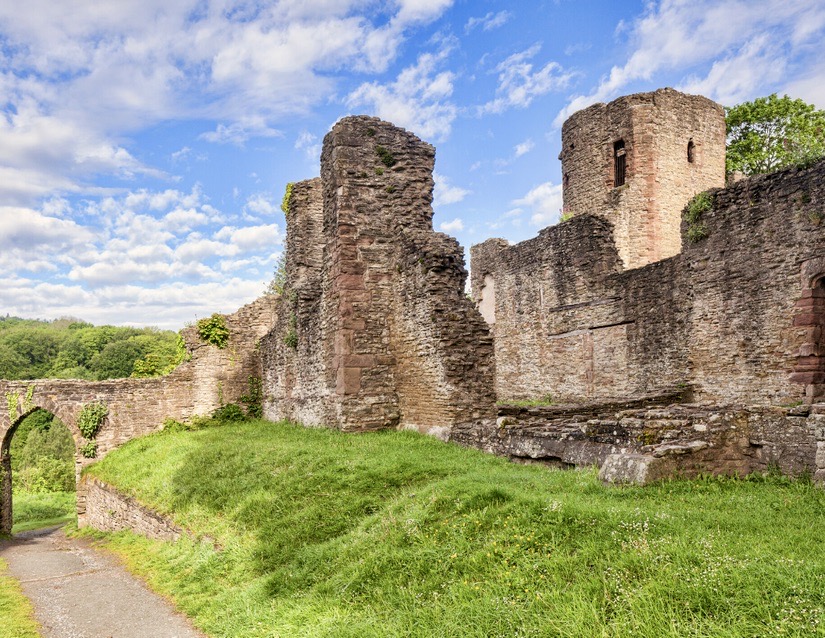
In 1461, Ludlow became a royal castle and would stay that way for the next three centuries. Edward IV’s son, Edward, was sent to live there. When his father died, he traveled to London.
But Richard III imprisoned the presumptive new king and his brother Richard in the Tower of London and they disappeared, while Richard was crowned king.
Did Richard murder the princes? It’s one of England’s most famous legends and mysteries. Even today, the fate of the princes is uncertain.
The last royal Ludlow occupant was Arthur, the son of Henry VIII, who died there. After that, the castle was abandoned and fell into the well-preserved medieval ruins you see today.
The Earl of Powis purchased Ludlow in the early 19th century. The family invested heavily to halt its decline and allow it to open as a tourist attraction. Make sure to climb up the tower for the best views over the picturesque Shropshire town of Ludlow.
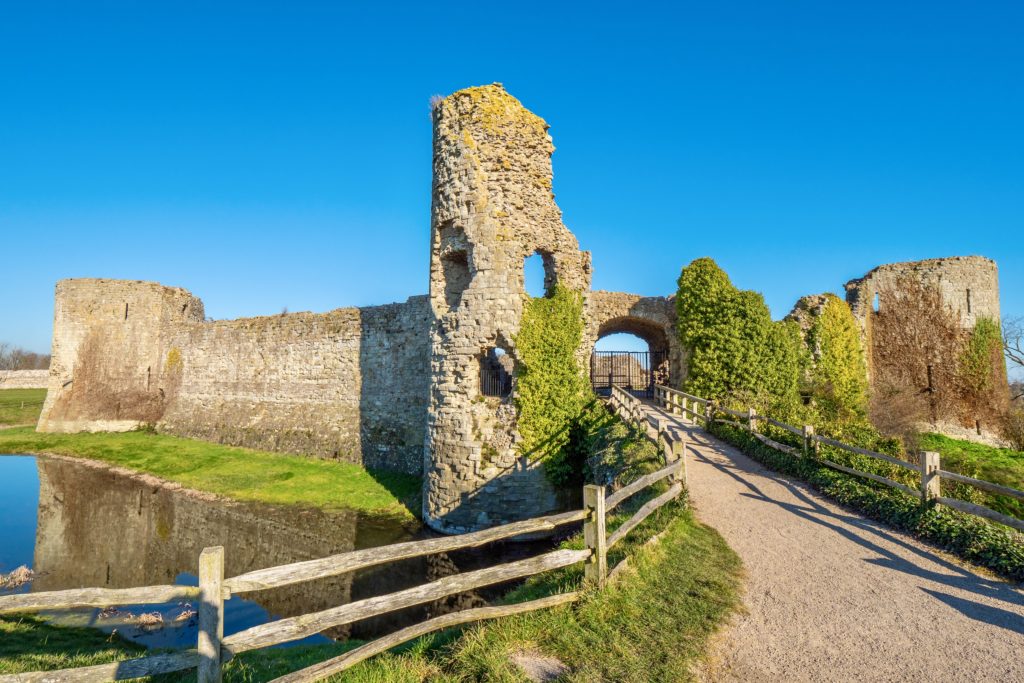
19. Pevensey Castle, East Sussex
Pevensey Castle is one of the oldest castles in England. Some scholars call it the first Norman castle in history.
Pevensey is where it all began. It was here that William the Conqueror landed to claim the throne of England in 1066.
The crumbling ruins of the castle stand high on a hill with sweeping views of the English Cannel. In its heyday, Pevensey was an impregnable fortress that never fell to assault during its turbulent history.
After the Conqueror landed, he converted an ancient defensive fort into a motte and bailey castle. Later, the Earl of Richmond built a tall curtain wall and towers.
In the 15th century, the castle was abandoned. What you see today are the remains of the impressive curtain walls, the ruins of a medieval building in the inner bailey, and a 13th century gatehouse with dungeons.
Legend holds that the ghost of Lady Pelham walks the outer walls of the castle at night. She was the wife of the castle constable.
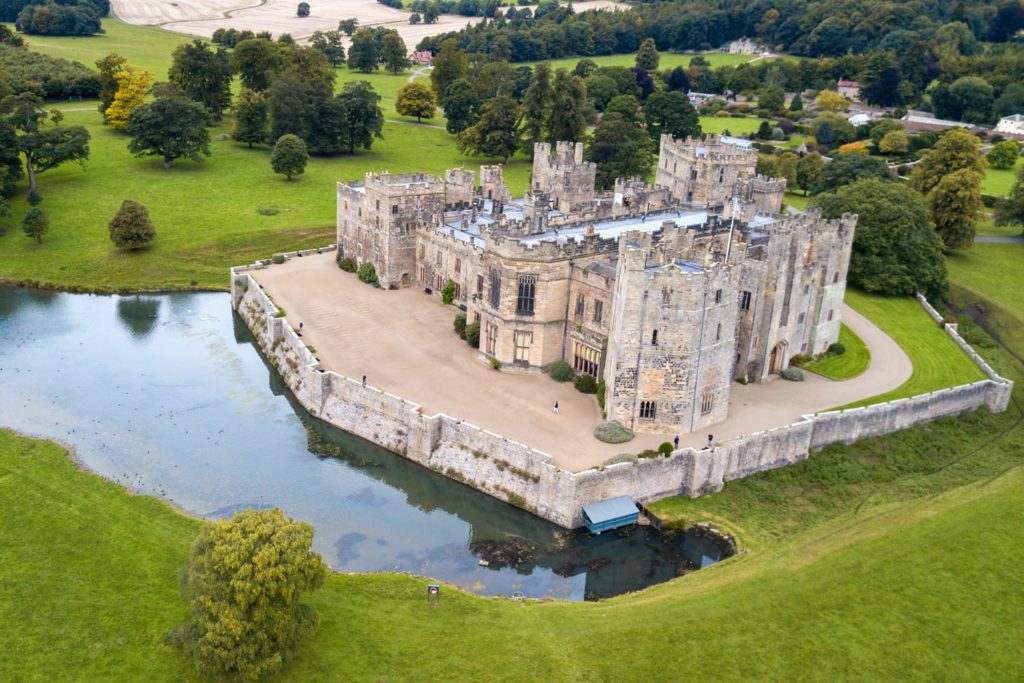
20. Raby Castle, Durham
Raby Castle is one of the finest intact medieval castles in England.
Built in the 14th century by the powerful Neville family, it has a storied history. Raby was home to Cecily Neville, the mother of two kings of England.
It was the the scene of plotting and a parliamentary stronghold during the English Civil War. When that rebellion failed, the castle was forfeited to the crown.
Originally moated and accessed via a drawbridge, Raby was built as a palace fortress. It boasts a sequence of massive towers linked by curtain walls.
Inside, the castle has Medieval, Regency and Victorian interiors. The entrance hall has tall Gothic vaulted ceilings, a massive fireplace, and armory decorating the walls.
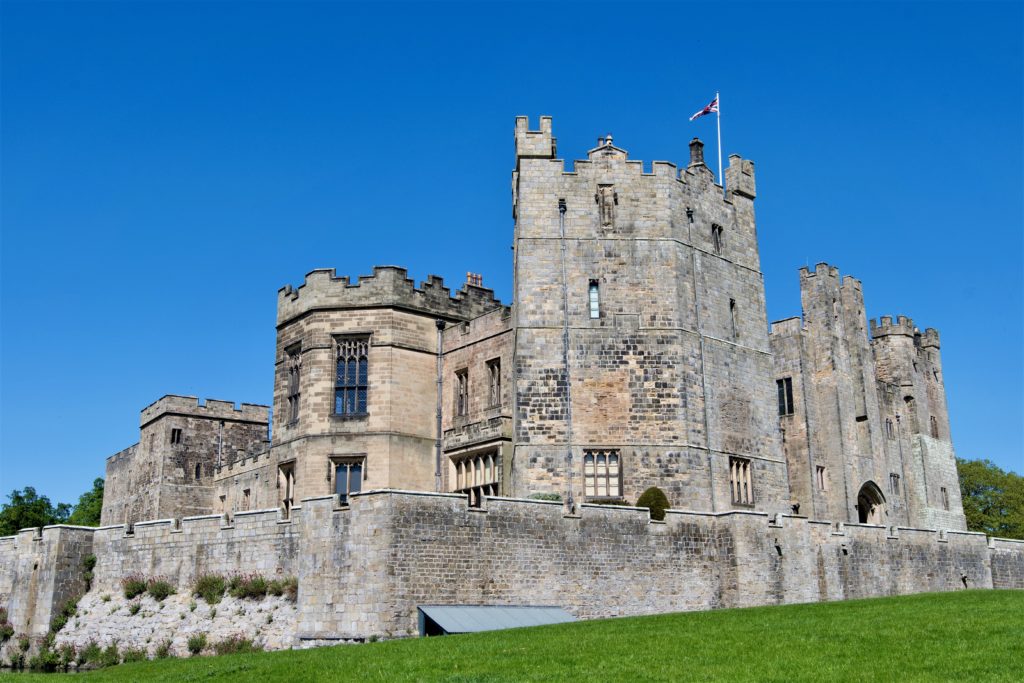
The Baron’s Hall was where much of the civil war machinations took place. Today, you can admire an art collection and a beautiful Neo-Gothic beamed ceiling.
The castle’s distinctive blue kitchen is really a pretty space. Dating to the 14th century, it has a collection of Victorian copper cooking utensils
Raby Castle offers 1 hour guided hours . You’ll get an informative history of the castle during its heyday, from the medieval Neville family up to the Vane family who still owns the castle today. You’ll hear tales of family disputes and the many royal visitors that Raby has hosted.
Raby is also a popular filming location. The castle doubled as the temporary Royal Family residence in the new Downton Abbey film. It was also featured in film Elizabeth (1998) and the popular drama series Victoria (2016-19).
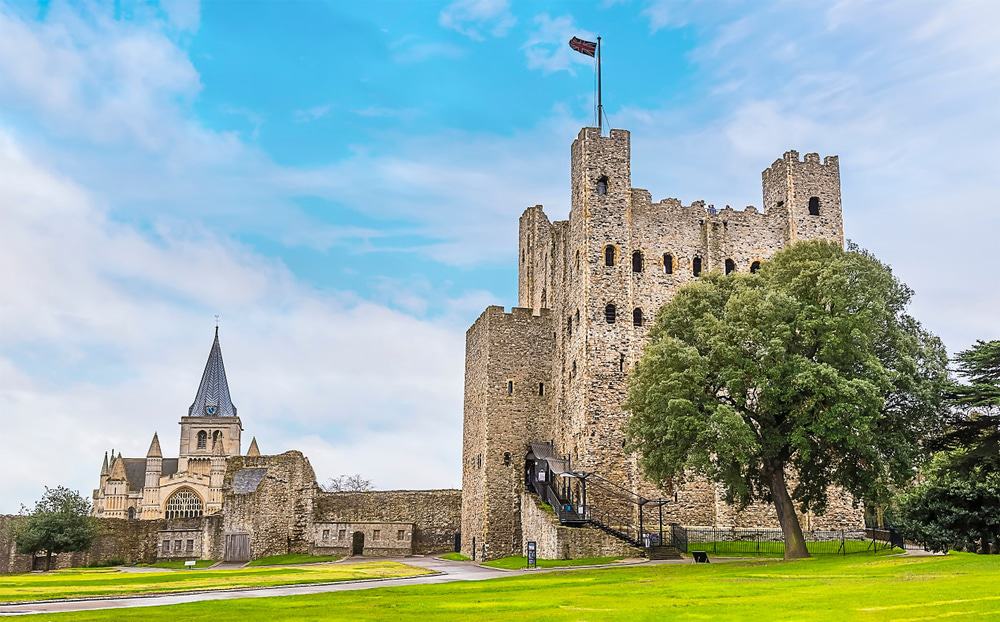
21. Rochester Castle, Kent
Rochester Castle has one of England’s best preserved Norman keeps. Dating from the 12th century, it’s also one of the tallest at 113 feet high.
The castle is just a shell now, but still steeped in history. William the Conquerer granted the castle to his half brother Odo, who built a strong motte and bailey castle. He was a powerful and clever man, but was brought down by his own ambition.
Odo made a bid for the crown in 1082. But lost a siege of Rochester Castle and was banished from England.
The present day castle dates from 1127. For almost a century, it remained in the hands of the Archbishop of Canterbury.
Later, barons rebelling against King John (the evil king from the Robin Hood tales) stole the castle. John took them down in a long, slow siege where the resistors were starved to death.
Rochester Castle was damaged during Simon de Montfort’s rebellion and again in the Peasants’ Revolt of 1381. Later kings weren’t enamored with the ancient keep and it fell into ruins, although the outer keep was preserved.
You can enter the keep and, if you are game, tackle the steep spiral staircase to the top of the battlements for views of the countryside.
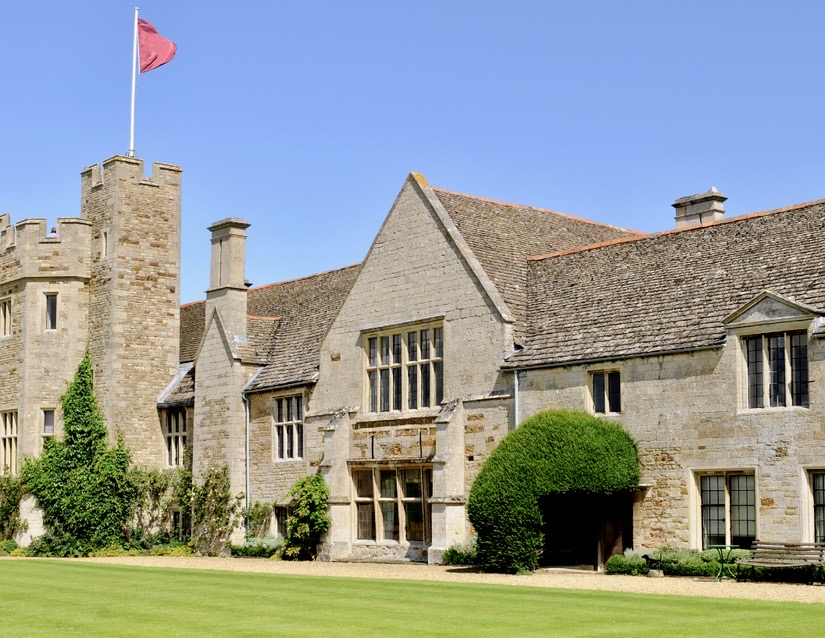
22. Rockingham Castle, North Hamptonshire
Rockingham Castle is a former royal castle and hunting lodge in Rockingham Forest. Rockingham has been the home of the Watson family since the 16th century. Before that, it was a royal enclave for 500 years.
Fortifications have been on the site since the Iron Age. The Romans and Saxons were there. William the Conqueror built the first castle after the Norman Conquest.
Rockingham is known for its sprawling hunting grounds and beautiful countryside views. This made it a favorite of medieval monarchs.
By the 15th century, the castle was no longer in favor. Henry III sold it to Edward Watson in 1533.
Unlike many castles in England, Rockingham still has vestiges of its medieval past. The castle’s Norman walls are partially intact, as is the 1290 gatehouse.
Inside, the Great Hall is filled with some important Tudor portraits, including one of Jane Seymour (Henry VIII’s favorite wife) and of Elizabeth I surrounded by her councilors.
The Long Gallery has some of finest paintings and furniture in the Castle. There are 18 acres of gardens with a 400 year old “elephant hedge.”
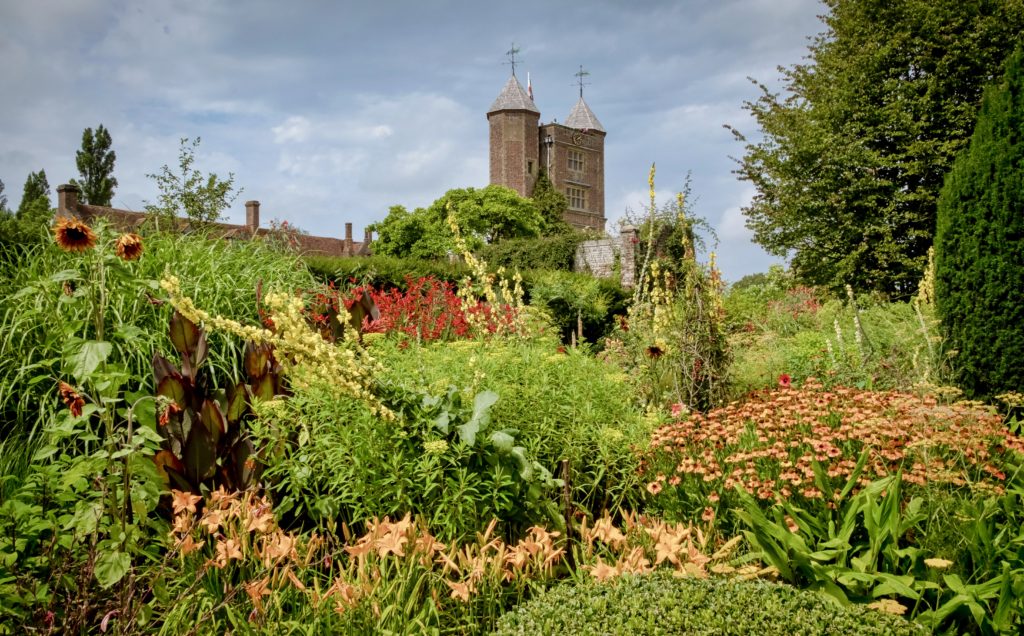
23. Sissinghurst Castle, Kent
Just 40+ minutes from Hever, Sissinghurst Castle is a National Trust property and major highlight for garden lovers.
Laid out in the 1930s, the castle boasts one of the world’s greatest 20th century romantic gardens.
Former owner and writer Vita Sackville-West designed the gardens to look like rooms of a house. Each one has its own color scheme and theme.
The gardens are most beautiful in spring.
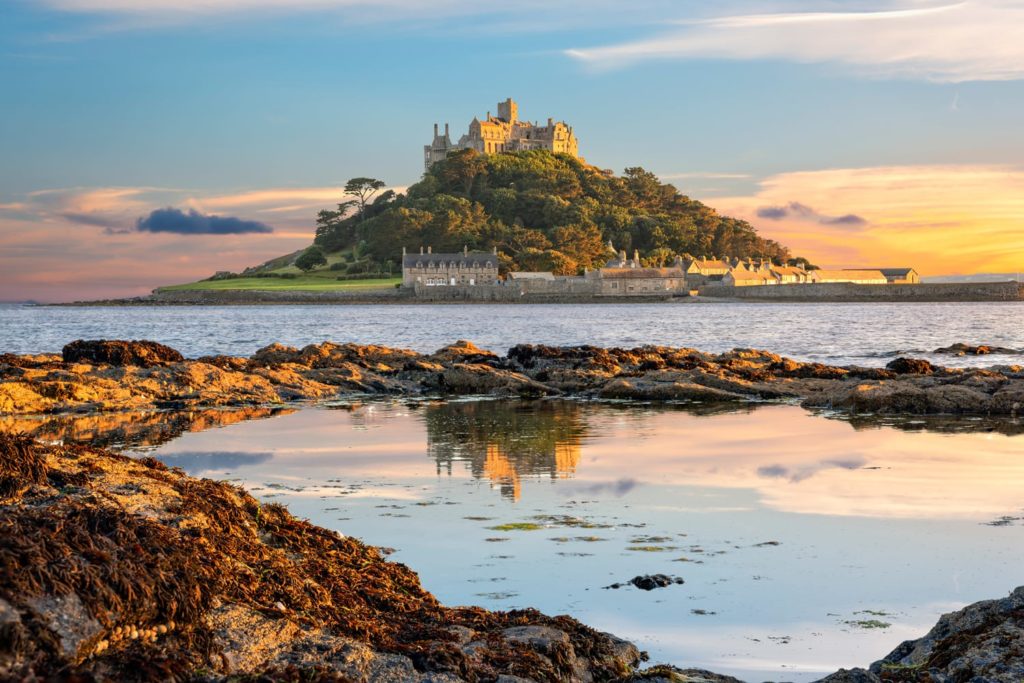
24. St. Michael’s Mount, Cornwall
1,600 feet from the Cornish coast in Mount’s Bay is a small tidal island called St. Michael’s Mount . It’s reminiscent of France’s Mont Saint-Michel . Often overlooked, it really is one of the best English castles.
The castle is accessible on foot via a cobblestone causeway that resurfaces during low tide or by small boat transfer.
During a history that began in the 12th century, St. Michael’s Mount has been a priory, fortress, place of pilgrimage, and, finally, the private home to the St Aubyn family.
In 1954, the St. Aubyns partnered with the National Trust to open the castle to the public. As you pass through the medieval doors, you can tour the armory, the Gothic drawing room, and a 14th century church.
The castle also boasts some exotic terraced gardens. In the summertime, the castle’s lit up to appear as if it’s floating in mid air on a calm sea.
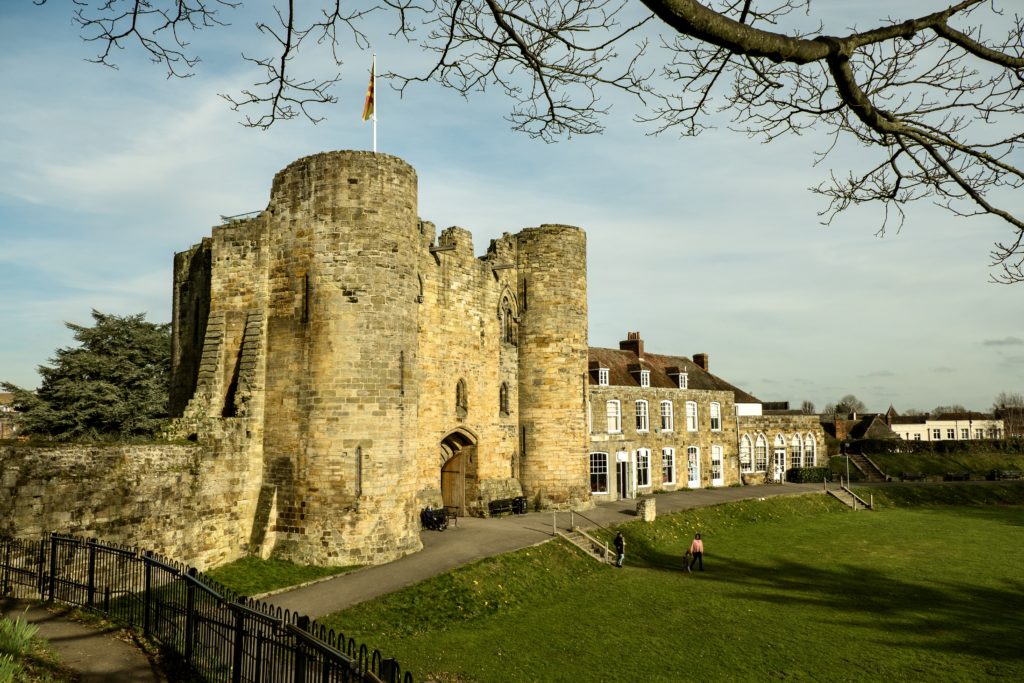
25. Tonbridge Castle, Kent
Tonbridge Castle is one of England’s most authentic medieval castle, standing guard (rather menacingly) over the market town of Tonbridge in Kent.
After being gifted the plot by William the Conqueror, Richard Fitz Gilbert built a wooden motte and bailey castle on the site. But Fitz Gilbert backed Odo against William in the civil war of 1088. William laid siege to Tonbrige and it fell.
Nonetheless, Fitz Gilbert’s son, Gilbert de Clare, became fast friends with William and rebuilt a stone castle.
In the late 13th century, another de Clare, the notorious “Red Earl,” built the mammoth 5 story gatehouse. The structure contained guard rooms, a great banqueting hall, and living quarters.
Today, you can enter the gatehouse and explore the great hall, winding stairs, and basement. Climb the battlements for breathtaking views across the town.
If you’re a fan of Madame Tussaud’s, you’ll love Tonbridge. Life size wax figures are scattered through the castle to give you slices of life from the Middle Ages. You can also get the complete scoop with the castle’s audio guide.
READ : One Week In Kent Itinerary
26. Tower of London, London
After Warwick Castle, the Tower of London is the second most popular castle in England. The Tower is also the most famous, with 900 years of history and blood.
It has served as a royal palace, a fortress, an infamous prison, a mint, a military storehouse, a treasury, home to the Crown Jewels, an armory, a public records office, a royal observatory, and a royal zoo. Even as a place of execution.
You will be blissfully immersed in the various successions of the Edwards, the Richards, and the Henrys.
It was here that Richard II abdicated, Henry IV was crowned, Henry VI was imprisoned (and possibly murdered), the princes of Edward IV were imprisoned, and Anne Boleyn was both crowned and executed.
William the Conqueror built the first version of the tower. In 1078, he authorized construction of what is now known as the White Tower, which took almost 20 years to build.
Over the centuries, Henry III and Edward I expanded William’s fortress. They added huge curtain walls with a series of smaller towers and enlarged the moat. Medieval kings and queens added luxurious apartments.
Here’s my complete guide to visiting the Tower of London . If you loathe queues, be sure to purchase a skip the ticket in advance .
The Tower is also free with the London Pass , which you will likely want to purchase if you’re in London for several days.
For a more in depth experience, you may want to book your own tour with an expert. I’ve taken this 3 hour guided tour and it was excellent. If you’re traveling with your family, check out this special 3 hour guided tour for kids.
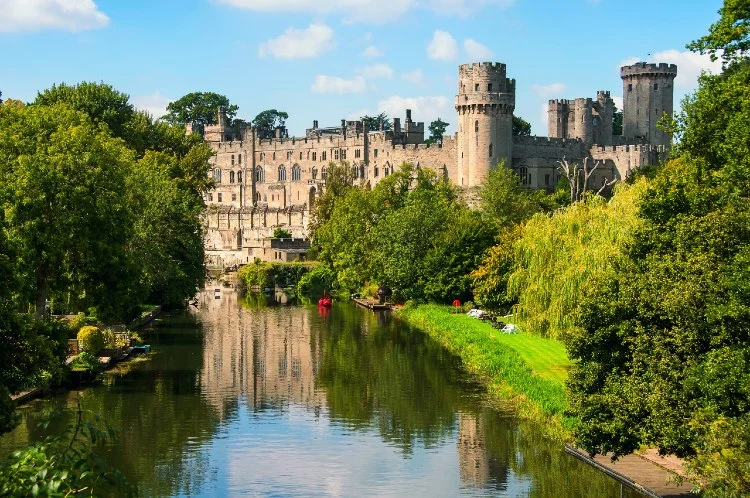
27. Warwick Castle, Warwickshire
Warwick Castle is one of the most significant castles in English history and the most visited castle in England. Your first glimpse will take your breath away.
The legendary Warwick Castle shaped 900 years of British history. The castle was built by a king. In 1449, it passed into the hands of the warmongering Duke of Warwick, Richard “the Kingmaker” Neville.
The castle was the backdrop for one the most famous dynastic conflicts in England, the War of the Roses . It was an epic battle for the throne between the House of York and the House of Lancaster.
The wealthy Kingmaker played chess with his Yorkist cousins, backing the monarch who best served his interests at the time. At one point, he imprisoned Edward IV in Warwick Castle and attempted to rule as uncrowned king.
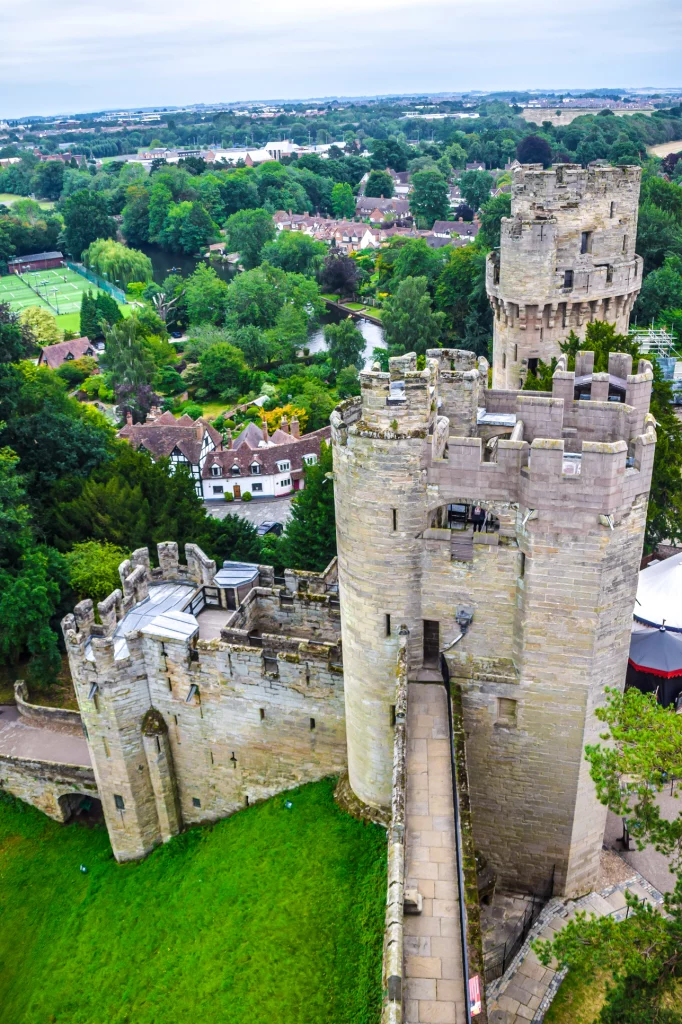
After his defeat at the Battle of Barnet, the castle eventually landed in the hands of John Dudley, an ally of Edward IV. He claimed the earldom, but then lost his head when he tried to promote Lady Jane Grey to to the throne.
With that rich history as a backdrop, you will love visiting Warwick Castle and there’s a tremendous amount to see.
Warwick is everything you’d expect in a storied fairytale castle – crenellated turrets, moats, and dungeons. You’ll want to walk the 127 feet tall high walls and climb Caesar’s Tower, the most majestic of the castle’s three primary towers.
Displays in the castle are also stellar. There is a magnificent Great Hall.
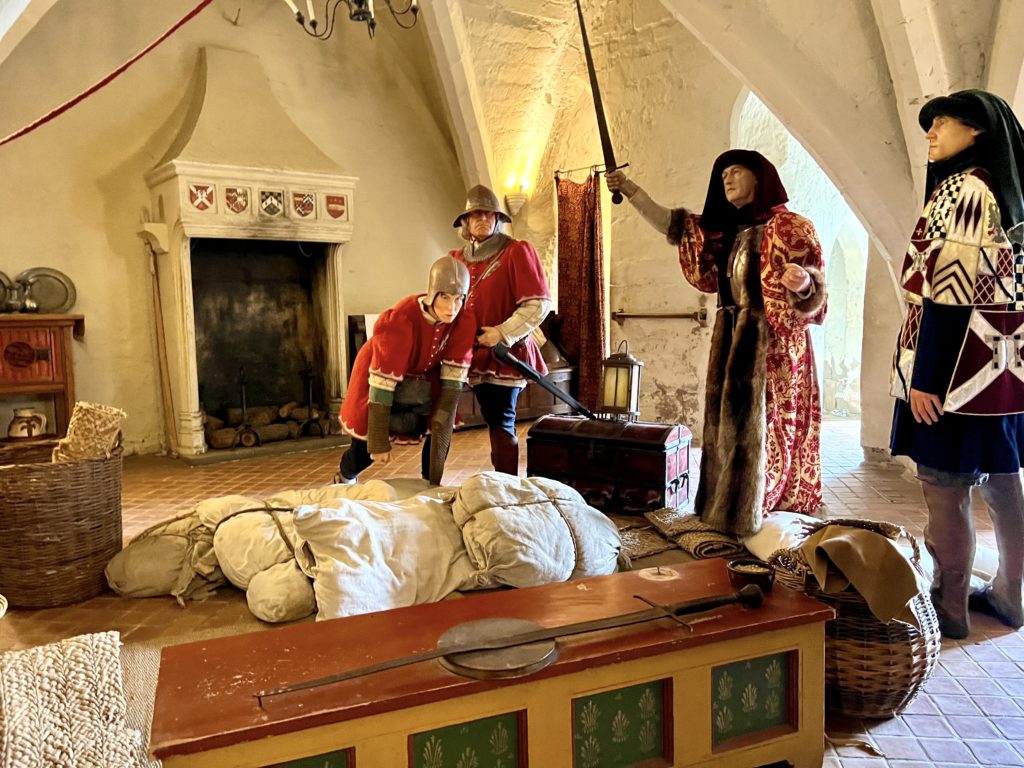
You’ll also see period furnishings, extraordinary life-like waxwork models, the state rooms, and reenactments that aim to give you insight into what life was like in a medieval castle.
The castle also prides itself on bringing history to life. The exhibition on “a day in the life of Richard Neville” is quite good. But other exhibitions make the castle seem a bit Disney-fied.
Here’s my complete guide to visiting Warwick Castle . Click here to book a skip the line ticket.
From London, you can book a self guided tour that includes train and entry tickets or a private guided tour from London .
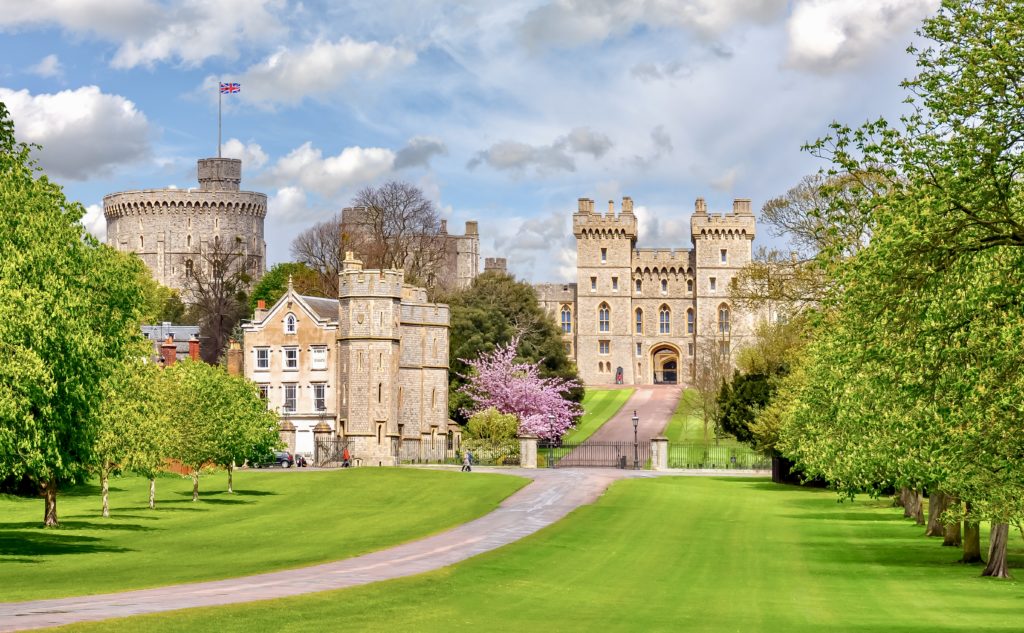
28. Windsor Castle, Berkshire
Windsor Castle is a striking 11th century castle that’s the official home of the royal family. This is my favorite castle in England and a must visit for history buffs.
Windsor Castle’s history is deep indeed. By legend, Sir Aurther and his knights of the Round Table met regularly in Windsor. William the Conqueror was the first builder, making Windsor one of his “ring around London” castles meant to subdue the city.
The castle is the longest occupied royal residence in the world. It’s been the symbol of the monarchy for 1,000 years. The castle was expanded by Henry II, Edward III, and Henry VIII.
Later, George III and George IV redesigned interior portions of the castle, wiping away some of its medieval roots.
You enter the castle through St. George’s Gate. At the castle, you can see the sprawling grounds, take the “long walk,” admire lavish royal staterooms and apartments, and visit a magnificent Perpendicular Gothic chapel.
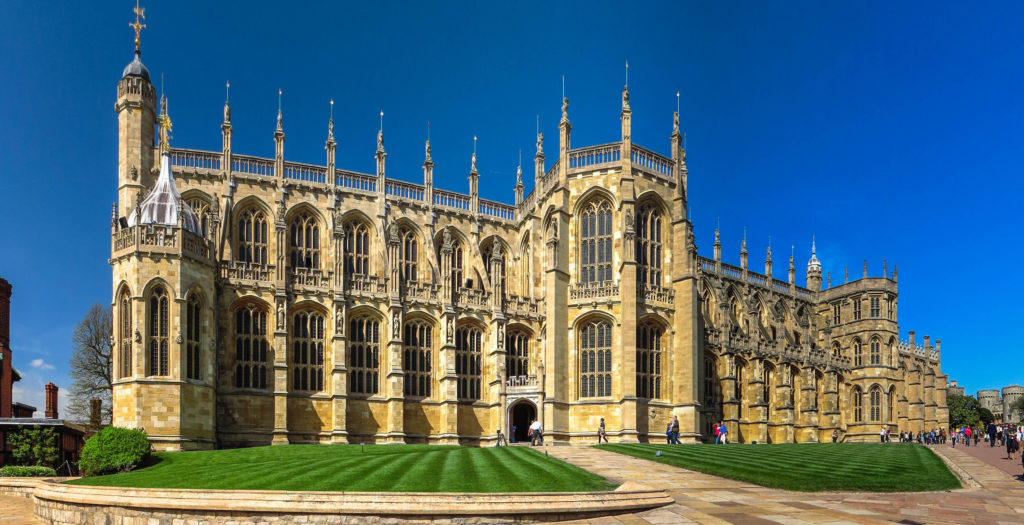
St. George’s Chapel is simply gorgeous. It’s the place to pay homage to ancient dead kings, including the infamous Henry VIII. The chapel is also the spiritual home of the Order of the Garter, England’s most prestigious club.
Not only is Windsor an authentic medieval castle, it’s home to some of the finest and most famous paintings in the British Royal Collection . You’ll find master works from English portraitists, the Northern Renaissance, the Italian Renaissance, and the Baroque eras.
Here’s my complete guide to visiting Windsor Castle . Click here to book a skip the line admission ticket. If you want to see the changing the guard, visit on Thursday or Saturday.
Windsor Castle is also included in the London Pass , if you have that card. Windsor is easy to reach from London. You can also book a guided half day tour to Windsor from London .
I hope you’ve enjoyed my guide to the best castles in England. You may enjoy these other England travel guides and resources:
- 3 Day Itinerary for London
- 5 Day Itinerary for London
- Hidden Gems in London
- 30 Day Trips from London
- Tourist Traps To Avoid in London
- Best Museums in London
- One Day In Canterbury Itinerary
- One Day in Oxford Itinerary
- One Day In Stratford-upon-Avon
- Harry Potter Places in London
- Guide to Westminster Abbey
- Guide to St. Paul’s Cathedra l
If you’d like to visit England’s best castles, pin it for later.
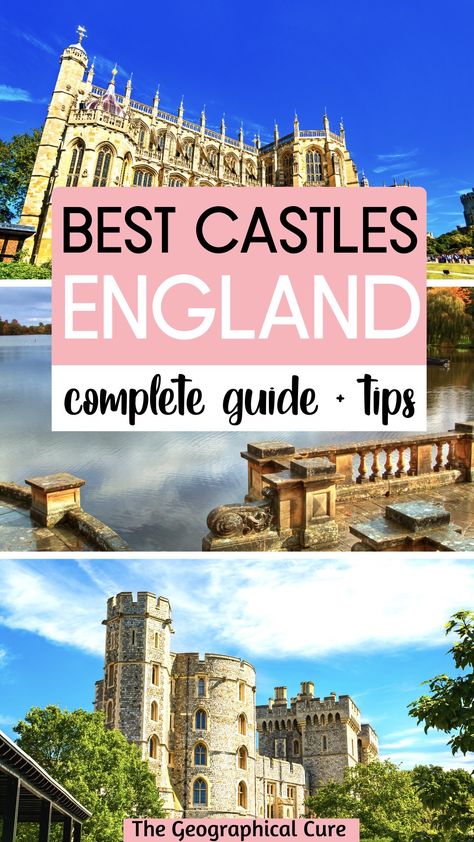
Leave a Comment Cancel reply
Save my name, email, and website in this browser for the next time I comment.
Last Updated on June 14, 2023 by Leslie Livingston

21 famous castles in England to explore
By: Author Tracy Collins
Posted on Last updated: August 31, 2022

With so many incredible castles in England it is pretty much impossible to miss adding one (at least) into your itinerary. Deciding which one can be the problem.
In this article we take a journey from London and the most famous castle of them all – the Tower of London site of numerous executions (including a couple of Henry VIII’s wives) – through the English countryside from south to north to discover 21 of the best castles in England.
To save money when purchasing tickets I have indicated if the castle is a National Trust or English Heritage site. Members gain free entry but must book a timed entry in advance. (Visiting from overseas? English Heritage have a membership scheme for you)
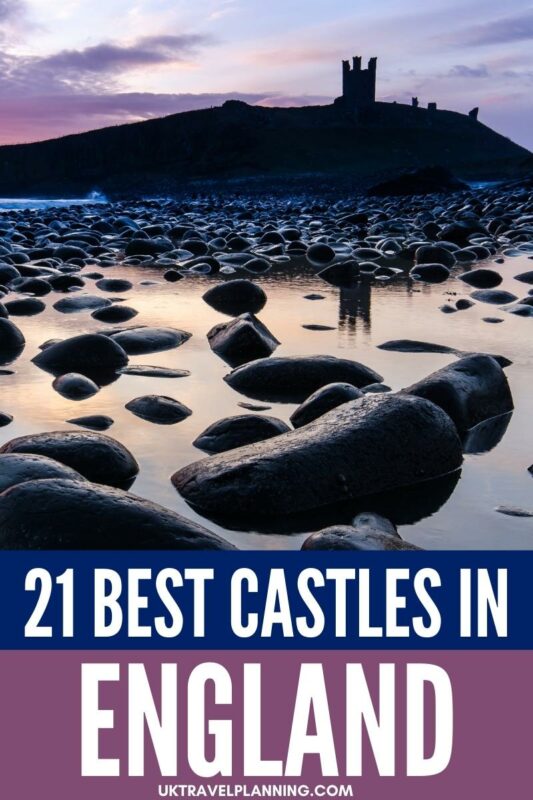
The Tower of London
Windsor castle, arundel castle, leeds castle, dover castle, hever castle, bodiam castle, alnwick castle, bamburgh castle, lindisfarne castle, warkworth castle, dunstanburgh castle, durham castle, tintagel castle, carisbrooke castle, corfe castle, sudeley castle, warwick castle, kenilworth castle, lincoln castle, bolsover castle, bonus – downton abbey aka highclere castle, planning to visit english castles – some tips.

Famous Castles in London and South East England
One of the best English castles (and possibly the most famous) would have to be the Tower of London . Located on the north bank of the River Thames the tower is an internationally famous and iconic structure that has been part of London’s skyline for 1,000 years.
After building castles throughout the English countryside, William the Conqueror built the Tower of London to protect the city and to demonstrate his power. Since then, it has been a fortress, a royal home and a prison.
Today it is one of the most popular tourist attractions in London and contains a wealth of history as well as the Crown Jewels. The Yeoman Warders, or the Beefeaters, greet visitors and explain the castle’s amazing history.
Entry to the Tower of London is included in the London Pass .
Read more | Visiting the Tower of London – tips, tricks & FAQ’s
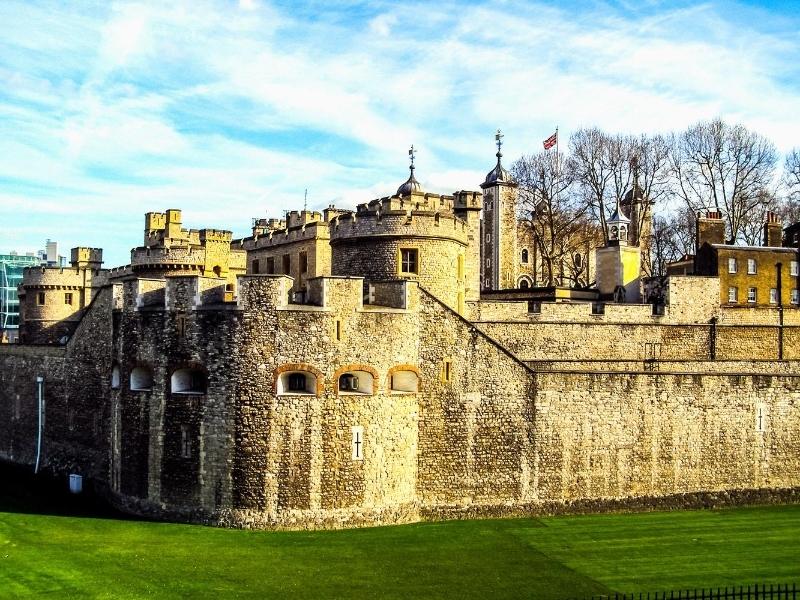
One of the most famous English castles is Windsor Castle, built in 1070 by William the Conqueror in Berkshire, some 24 miles outside of London.
It is the oldest occupied castle in the world and has been home to 39 English monarchs. When not in Buckingham Palace , the Queen resides there. Since she can’t use all 1,000 rooms, some of the castle is open to the public.
Visitors can tour the opulent state rooms and apartments and see a sizeable portion of the royal art collection. The grounds are impressive, as is the lovely gothic cathedral, St. George’s Chapel.
Check online for the schedule of the changing of the guards — you won’t want to miss it.
Good to know – Windsor Castle is a popular stop on many guided day trip tours for example this one from London to Stonehenge and Oxford or this one from London to Bath and Stonehenge . If you are pushed for time and want to see a combination of attractions we recommend booking a tour.
Read more | How to travel to Windsor Castle from London
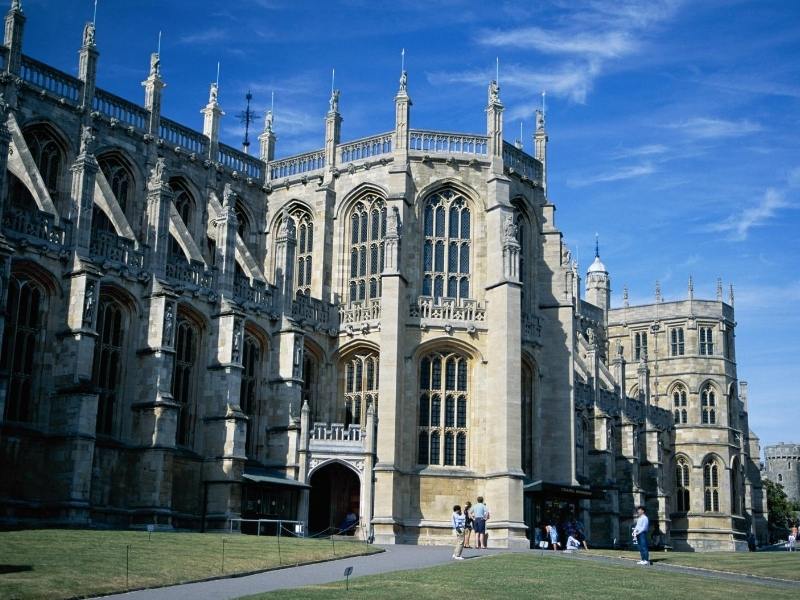
On a hilltop overlooking the River Arun, 65 miles from London, is Arundel Castle, the seat of the Dukes of Norfolk for the last 850 years. It is a grand castle known for impressive round towers, gothic windows and a distinctive motte that was built in 1068.
In the 19th century, the castle was converted into a country home. Because of an impeding visit by Queen Victoria and Albert, Arundel was modernised and central heat and electricity were added.
Today, even though it is still occupied by the Duke of Norfolk, many rooms as well as the formal gardens are open to the public.
Good to know – It is possible to combine a trip to Arundel and Brighton on this private Brighton & Arundel Castle day tour which includes door-to-door transfers from central London.
Read more | Top 10 places to visit in the South East
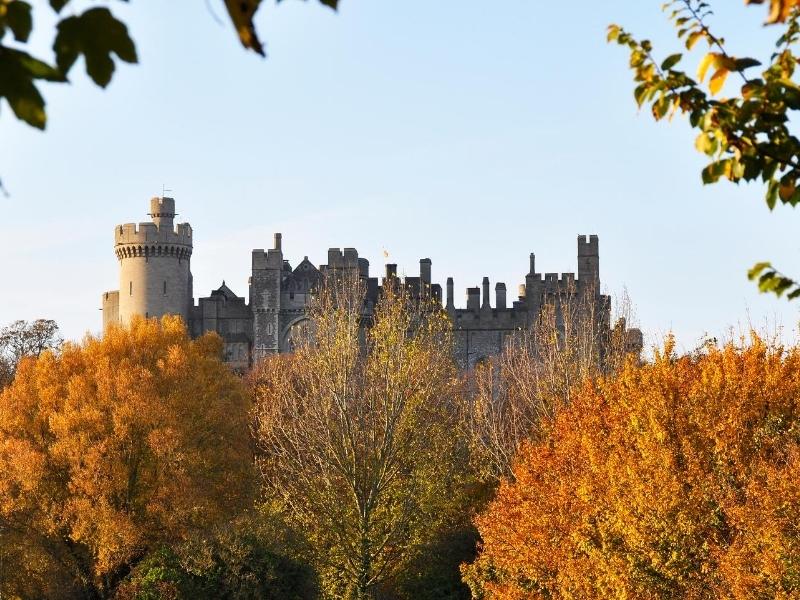
Just an hour from London, Leeds Castle sits upon the River Len in an impossibly picturesque setting.
It dates back to the Normans, who built the original castle around 1119. It passed through the hands of six medieval queens until it got the attention of Henry VIII who used it as a residence for his first wife, Catherine of Aragon.
Eventually it became a private home and is now open to the public. Visitors can tour the castle and explore the lovely grounds that offer spectacular views of the countryside.
Unlike many old English castles, Leeds has a maze made out of 2,400 yew trees which has proven to be a popular all-ages attraction.
Why not combine a visit to Leeds Castle, Canterbury Cathedral and Dover on this full-day tour to all the top destinations in The Garden of England , Kent?
Read more | 7 castles you can visit on a day trip from London
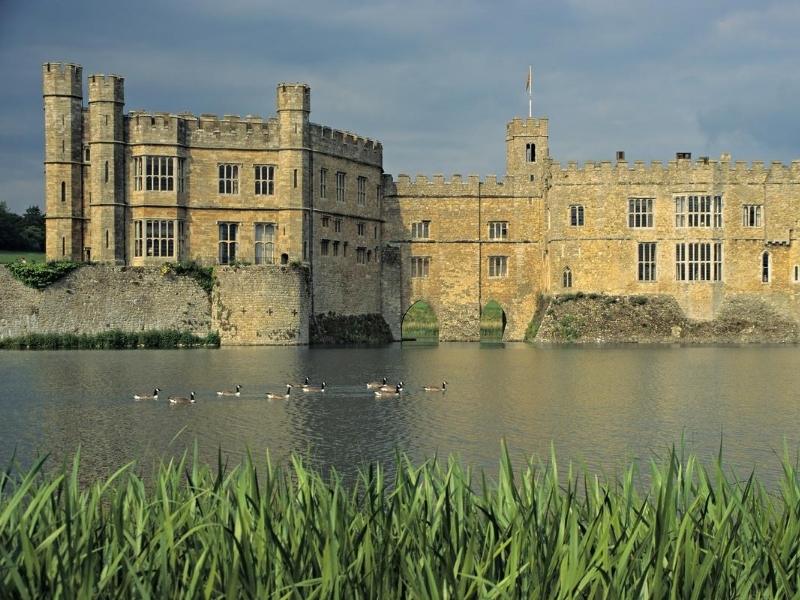
Dover Castle is the largest and arguably the most imposing of all the English medieval castles. Only 90 miles from London, it has been a symbol of English power for centuries because of its strategic location overlooking the English Channel.
The castle was built by Henry II in the 1180s but the land had been a military stronghold since the days of the Romans. Visitors can see the remains of a Roman lighthouse and travel through English history as they tour the great towers, narrow staircases and tunnels.
The grounds are extensive and well worth exploring, so make sure to wear your walking shoes.
Dover Castle is an English Heritage property .
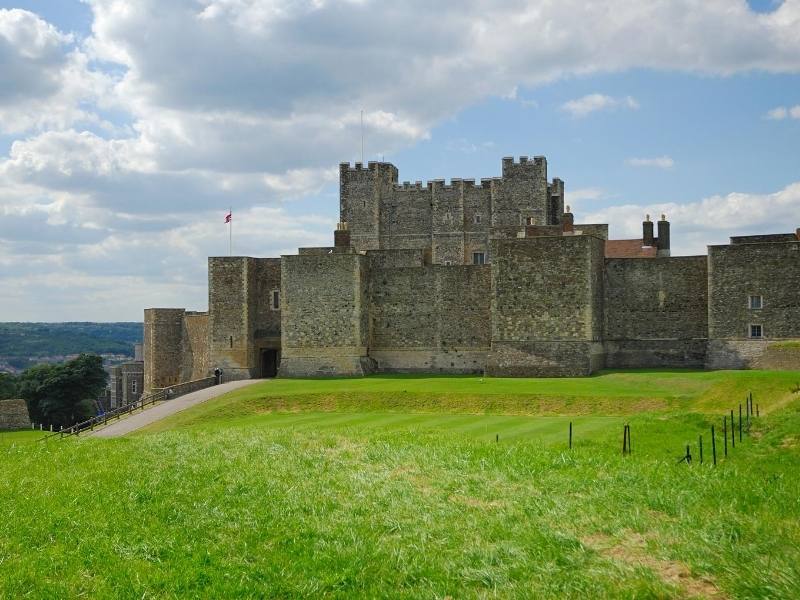
In 1270, William de Hever, a sheriff under King Edward I, built himself a castle in Kent, 30 miles outside of London. At that time, Hever Castle had a gatehouse, a walled bailey and a moat with a drawbridge.
A few centuries later, Hever Castle became the home of the Boleyn family, and they added a Tudor home inside of the castle walls. Future Queen to Henry VIII and mother to Elizabeth I, Anne Boleyn, spent her childhood there.
The castle has since passed through many owners and was completely renovated in the early 1900s. Today, visitors come from all over the world to enjoy the lovely castle, its 125-acre grounds and unique double moat.
Inside of the castle, they’ll find sumptuously decorated rooms with an assortment of historical paintings and artefacts relating to the Boleyn family and to over 700 years of English history.
Read more | A tour of Tudor England
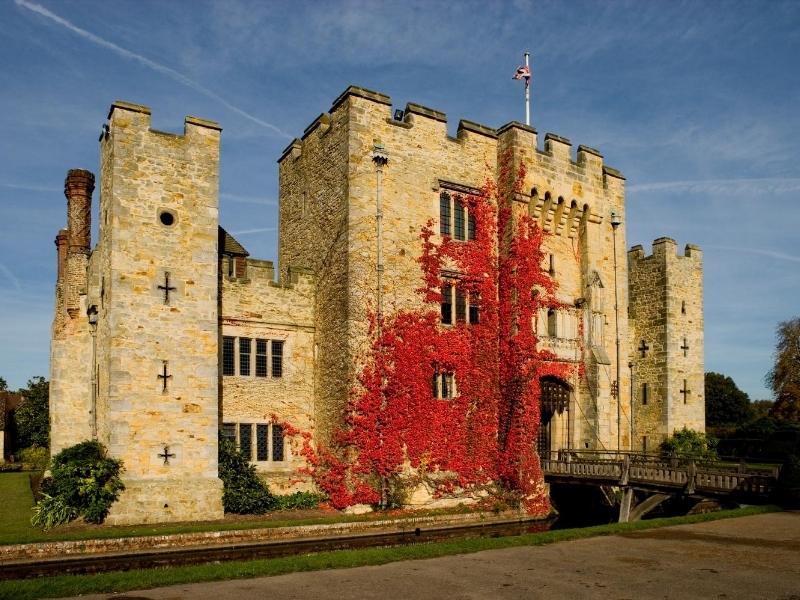
One of the best examples of a medieval castle in England is Bodiam Castle in East Sussex.
With its moat, dramatic gatehouse entrance and impressive circular towers, it very much looks the part of a castle from a fairytale. Built in 1385 by Sir Edward Dalyngrigge, it was primarily a defensive structure.
In 1926, it was given to the National Trust. Today, visitors should not expect to see luxurious state rooms or great halls as the castle’s inside is nearly ruined.
You can, however, climb a few of its towers but beware — the stairs are very steep. The grounds are lovely and could take several hours to explore.
As mentioned above Bodiam Castle is a National Trust property.
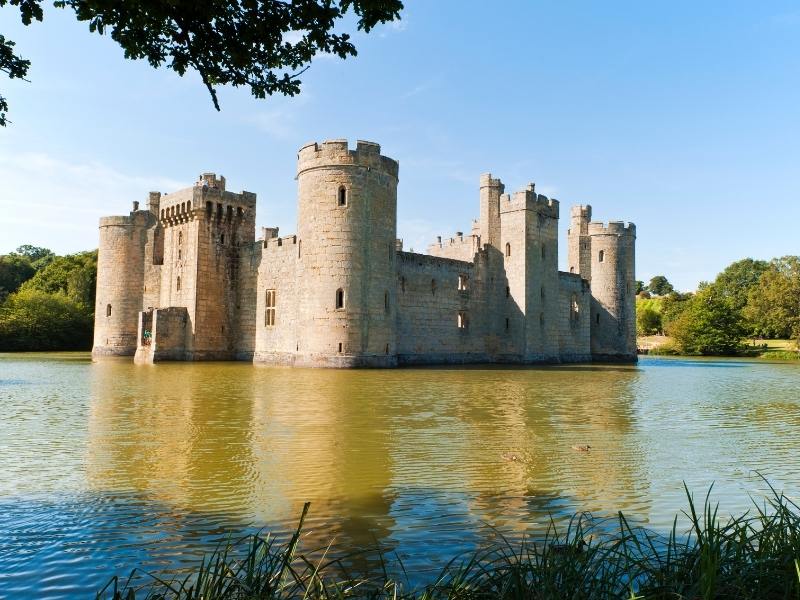
Beautiful Castles in North East England
A Northumberland castle known for its history and dramatic architecture, Alnwick Castle is over 1,000 years old. As home of the Duke of Northumberland, it is the second largest occupied castle in England.
Originally a built in 1096 as a small Norman fortress, the castle has been remodelled and expanded over the years into what it is today.
A large portion of the castle is open to the public including the Italianate staterooms, the inner bailey and the gun terrace.
Recently, the castle was portrayed in two of the Harry Potter movies as Hogwarts. Consequently, for an extra charge, they offer broomstick training for any enthusiastic young Harry Potter fans.
Alnwick is easily visited via tour on a day trip from Edinburgh .
Read more | Things to do in Alnwick
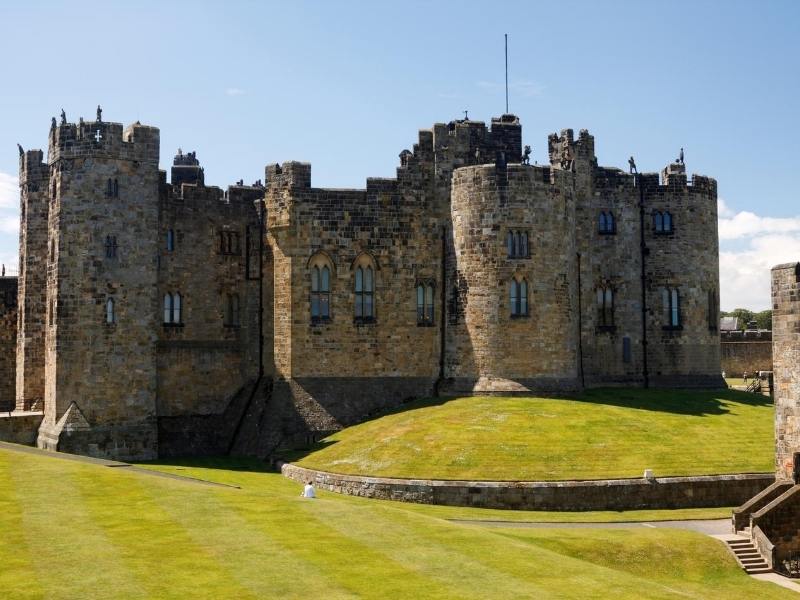
On the Northumberland coast, perched atop of a volcanic plateau, is Bamburgh Castle, one of the oldest English castles to visit. With a history that dates back to 420 AD, it was the first castle to succumb to artillery during the War of the Roses.
Since 1894, it has been home to the Armstrong family. There are 14 rooms that are open to the public including the Great Kitchen, the King’s Hall and the Keep.
History lovers will adore the hundreds of years of artefacts throughout the castle but should also make sure to spend time exploring the beach and grounds.
Looking for a cottage along the Northumberland coast for your visit? Check out my guide to the best Northumberland Coastal villages and cottages for your stay.
Read more | Top 10 places to visit in the North East
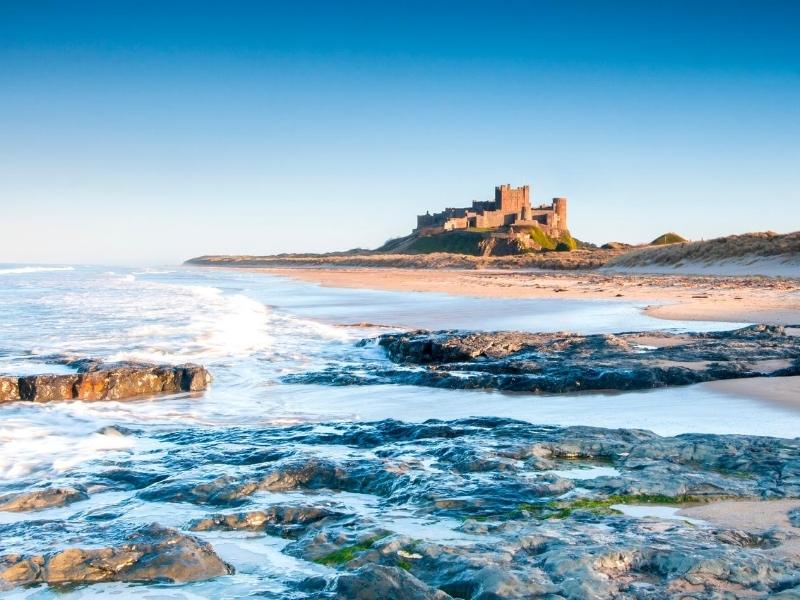
Lindisfarne Castle is a 16th century Tudor fort located on the Holy Island of Lindisfarne in Northumberland. In 634 AD, it was the home of the first monastic community in England but was eventually abandoned after Viking attacks.
In the early 1900s, Lindisfarne Castle was remodeled into a country retreat. Luckily, many of its 16th century features still exist, like its lovely vaulted passages.
There are a few partially furnished rooms open to the public but it’s the sweeping views during the walk up to the castle that visitors love the most.
Keep in mind, Lindisfarne is a tidal island. When the tide is high, the causeway disappears, so planning ahead is essential.
Lindisfarne Castle is a National Trust property .
Read more | Visiting the Holy Island of Lindisfarne
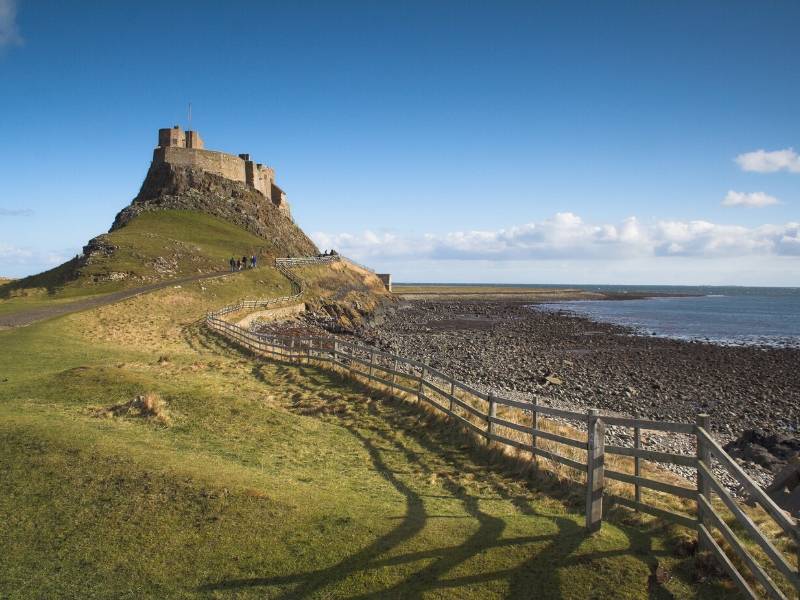
In the 14th century, the powerful Percy family began building a castle in Northumberland. They chose a loop of the River Coquet as the location, where a 12th century motte-and-bailey structure previously existed.
Today, the Warkworth Castle is ruined but there’s still plenty to explore. The Keep and the kitchens are there as well as the Great Hall and the Great Tower, a marvel of medieval architecture and supposedly the place where Henry “Hotspur” Percy plotted treason against Henry IV.
The Lion Tower, built in 1480, still stands and was named for the symbol of the Percy family. The lion statue is still visible today.
Read more | A drive along the Northumberland Coastal Route
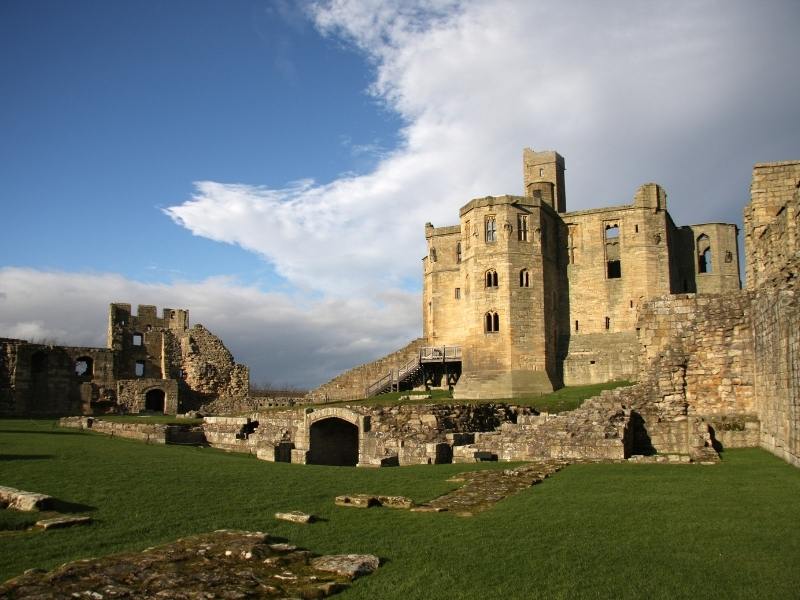
On the Northumberland coast you will find the ruins of Dunstanburgh Castle. It was a 14th century fortification built by Earl Thomas of Lancaster. After he was executed, it was claimed by the crown who, because of its strategic location, maintained it for hundreds of years.
Today, it is a crumbling shell of its former self and is owned by the National Trust. Still, it is a highly atmospheric place with extraordinary views of the beach, the sea and the rugged coastline.
Climb through the great gatehouse and explore the Lilburn Tower. When you go, park your car in Craster and walk the one and a half miles along the coast to reach the Dunstanburgh ruins.
Dunstanburgh Castle is a National Trust and English Heritage property .
Read more | Best castles to visit in Northumberland
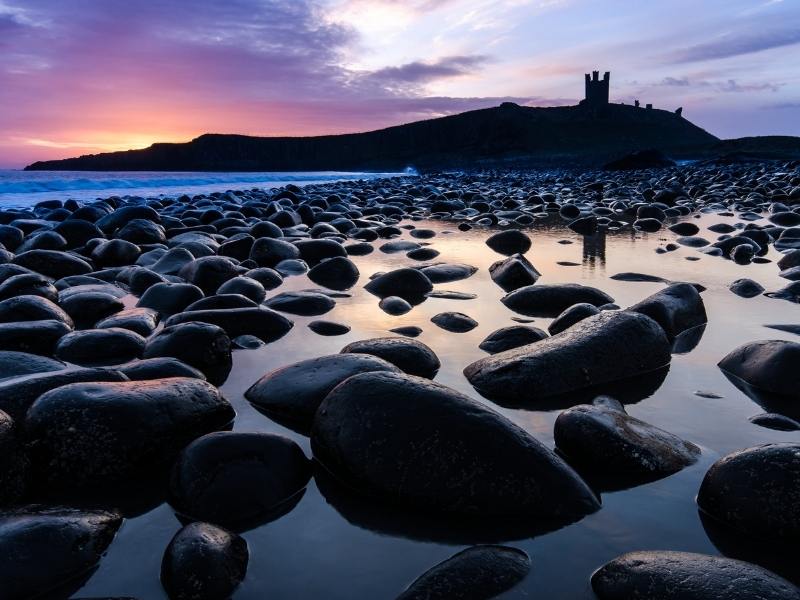
If you’re a student at University College in Durham England, there’s a chance you might get to live in a castle — Durham Castle, that is. Since 1840, the castle has been used by University College and today, over 100 college students call it home.
In the 11th century, William the Conqueror built the castle and it quickly became a Norman stronghold. Its northern position would also eventually help maintain control over the Scottish border.
Today, 50-minute public tours are available throughout the week, allowing visitors inside to see the Norman chapel with its well preserved Norman doorway.
There’s also a 17th-century black staircase and other historical features any castle lover will enjoy. Check online for tour times and availability.
Read more about Durham in my complete Durham Travel Planning Guide which includes all the essential information you need to plan your visit.
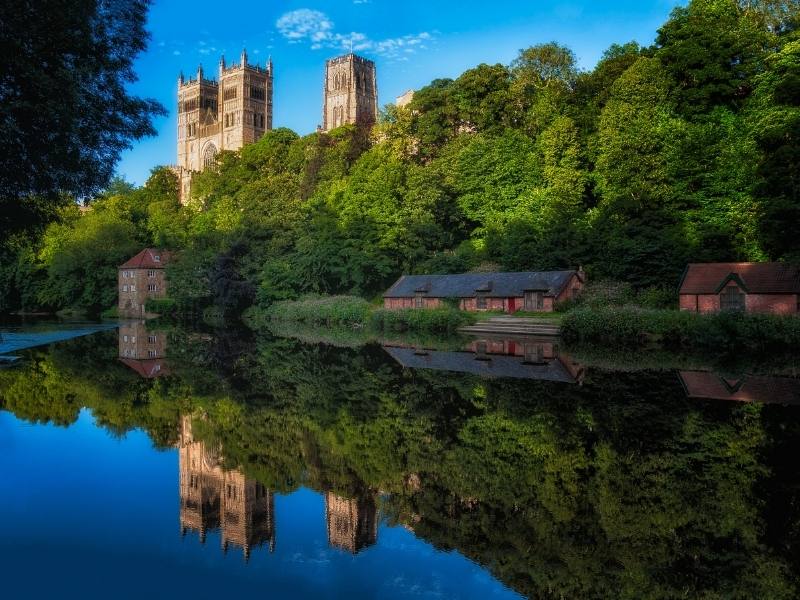
Best castles in South West England
In northwestern England, on Cornwall’s rugged coastline , are the windswept ruins of Tintagel Castle. Even in its day, 800 years ago, Tintagel wasn’t your typical medieval castle — it wasn’t built for defence or military advantage.
The King of England’s brother, the Earl of Cornwall, built his castle on a cliff to recreate the setting of the legends of Camelot. Was he the ultimate King Arthur fan or just whimsical and a touch irresponsible with his brother’s money? It’s difficult to say.
Within a decade after construction was finished, the castle began falling into to ruin. Today, with its dramatic ocean-side setting, Tintagel feels rich in both history and legend.
Tintagel is an English Heritage property .
Read more | Top 10 places to visit in South West England
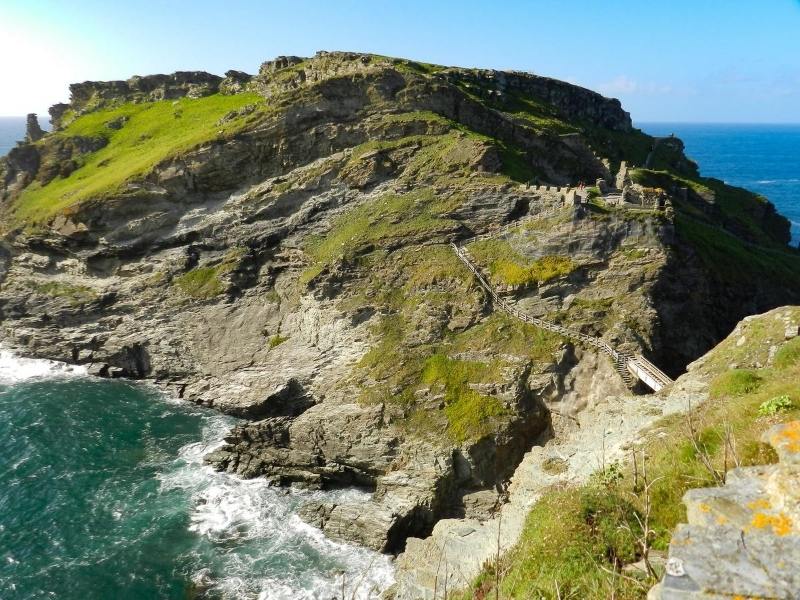
Carisbrooke Castle was built on the Isle of Wight in the 12th century. Throughout the years, this very romantic castle has been an artillery fortress, a prison for Charles I, a royal summer home and until the 1940s, it housed the official office of the Governor of the Isle of Wight.
Much of it is still standing today, including the Great Hall and Great Chamber. There is also an Isle of Wight Museum in one of the upper rooms.
Visitors will enjoy the breathtaking views from the castle’s keep and battlements. Children and adults alike will fall in love with the Carisbrooke Donkeys and enjoy watching them in action working the 16th century treadwheel.
Carisbrooke Castle is an English Heritage property.
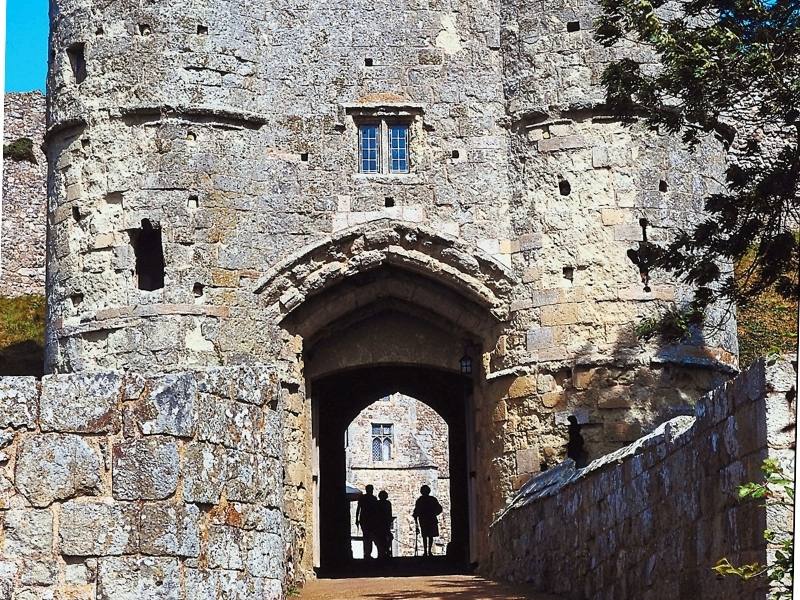
The 1,000-year-old ruins of Corfe Castle can be found in the county of Dorset , in the village of the same name.
Corfe Castle once occupied an area of strategic importance because it protected the route between Wareham and Swanage in a gap in the Purbeck Hills.
Originally built of wood, William the Conqueror refortified it with stone. Eventually, it became a royal fortress and lasted for hundreds of years.
Today, it is a favorite attraction for its intriguing beauty and rich history. After exploring the crumbling walls and hidden nooks of the ruins, visitors should make a point of seeking out the delightful shops and tea rooms in the village.
Corfe Castle is a National Trust property.
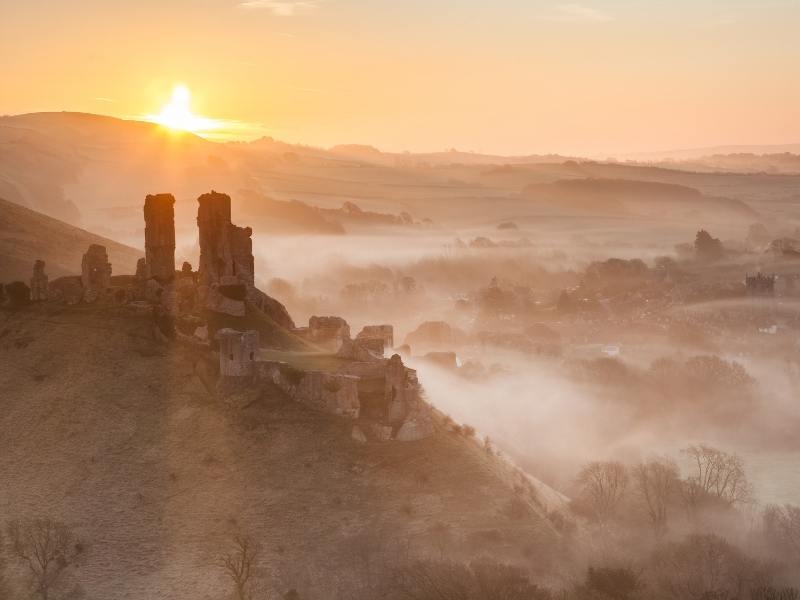
Sudeley Castle dates from the 15th century and is one of the more romantic castles in England. It’s tucked in the Cotswolds near Winchcombe and has been associated with some of the most famous royal names in English history including Henry VIII and Katherine Parr, who is buried there.
It was recently refurbished and though it is privately owned, it is open to the public for tours and available for private events.
Visitors can explore some of the castle’s rooms, learn about their history and then go investigate the overgrown and highly atmospheric ruins.
Explore the 10 award winning gardens, the on-site restaurant and the children’s play area.
Don’t miss adding a visit to Sudeley Castle into your itinerary as it is one of the best things to do in the Cotswolds .
Read more | Cotswolds Travel Guide
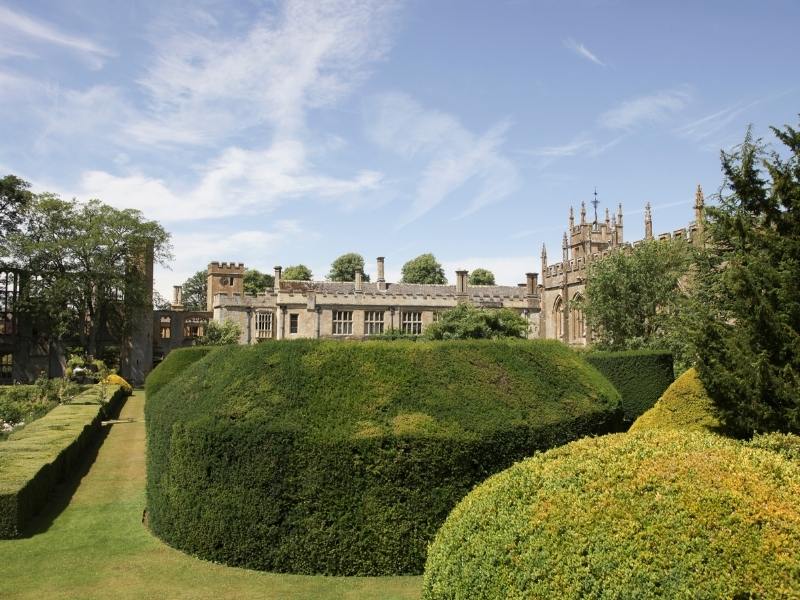
Castles in the West Midlands of England
In 1068, in the small country town of Warwickshire on the River Avon, William the Conqueror began building a humble motte-and-bailey structure. Eventually, it would be fortified with stone and would become the great Warwick Castle.
Today, the castle is unoccupied and visitors will marvel at how well its 14th century architecture has been preserved. Tour the Great Hall and state rooms, both packed with historical objects.
Outside of the castle, you’ll see staff members in period costume as you tour the grounds. Be sure to watch the aerobatic bird demonstration or take some time to learn about medieval weaponry. Warwick Castle is a must visit if you have children as they have so many fun activities throughout the year,
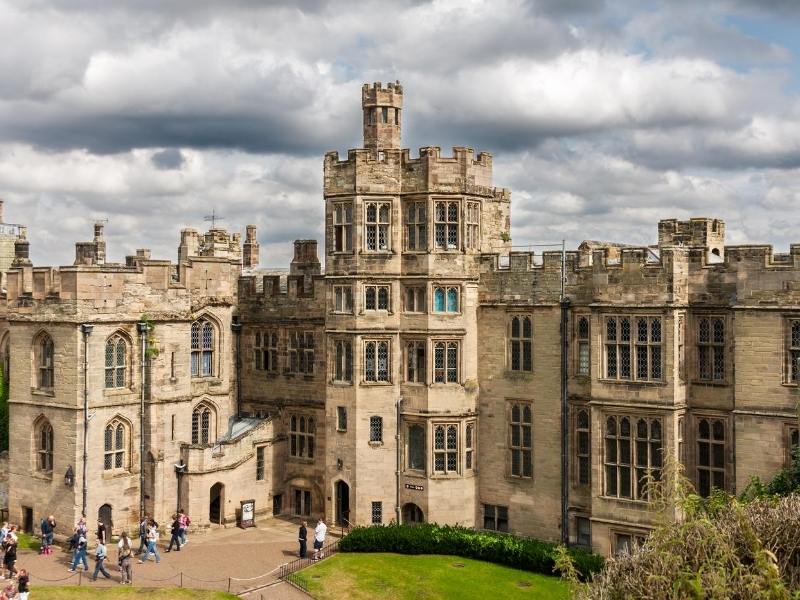
You wouldn’t know by looking at it now, but Kenilworth Castle was a crucial royalist stronghold during the English Civil War.
Located in the town of Kenilworth in Warwickshire, the castle was built over several centuries and has the distinction of having survived a six-month siege in 1266. Today it is the largest ruined castle in England but still has fine examples of 12th to 16th century architecture throughout.
The Tudor gatehouse and the Norman keep are noteworthy examples and shouldn’t be missed. The gardens have been restored to an approximation of their 17th century appearance and make for a lovely area to stroll around and take in the views of the countryside.
Kenilworth Castle is an English Heritage property .
Read more | 10 places to visit in the West Midlands
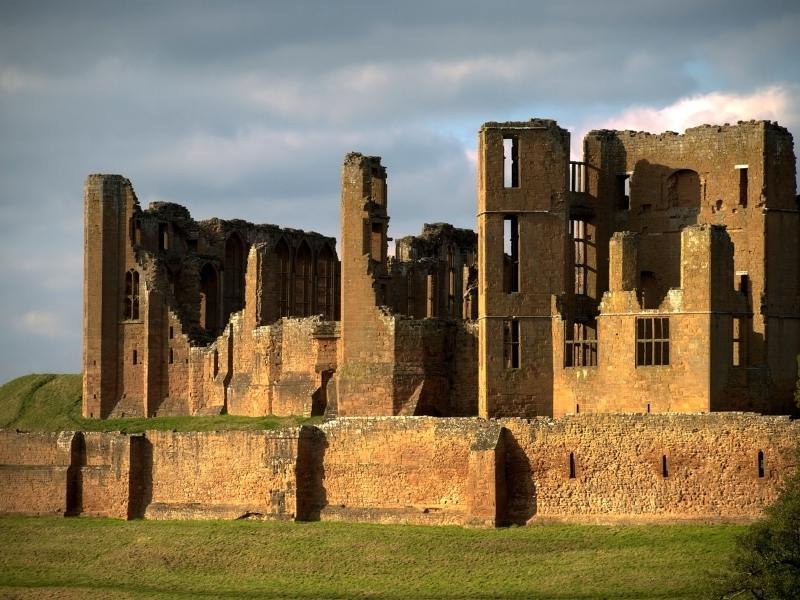
Castles in the East Midlands
In medieval times, Lincoln was one of the most important settlements in England. Perhaps that’s why William the Conqueror built Lincoln Castle over an already existing Roman fortress in 11th Century.
Lincoln Castle is unique because it has two mottes and a Victorian prison inside the castle walls that sightseers can actually explore. It also is the home to one of the four surviving copies of the Magna Carta.
You can visit the castle grounds for free but you need to buy a ticket to do the medieval wall walk as well as tour the prison, enter the chapel and see the Magna Carta — all well worth doing.
Read more | 10 places to visit in the East Midlands
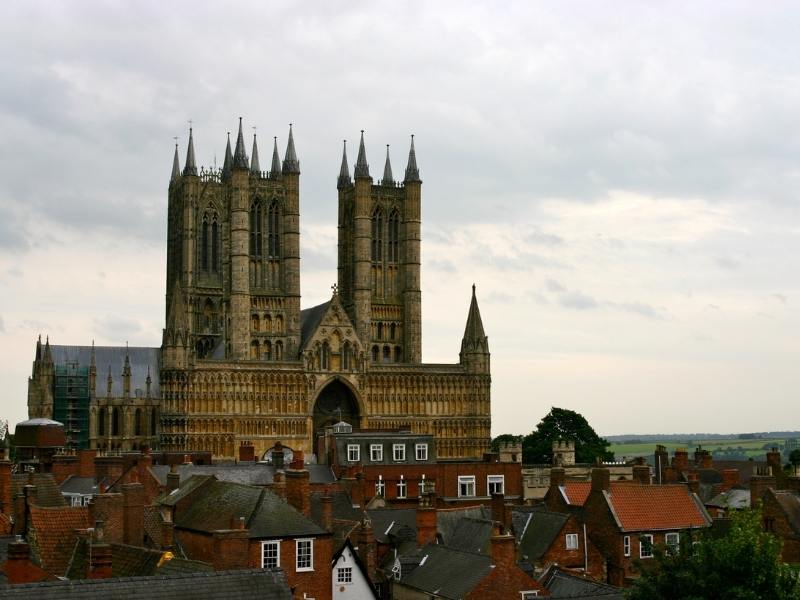
In the English county of Derbyshire castle enthusiasts can find Bolsover Castle. It was built by Royalist Commander Sir Charles Cavendish in the 17th century over the remains of a 12th castle. No expense was spared as Cavendish wanted all guests to be impressed and to have a good time.
Today the castle is ruined but its stunning location and spectacular views make up for the building’s degraded condition. Since 1984 English Heritage has cared for the castle and has recently restored the parapets on the wall-walk.
The gardens are lovely and have a Venus fountain as their focal point. Plan to spend several hours exploring the extensive grounds.
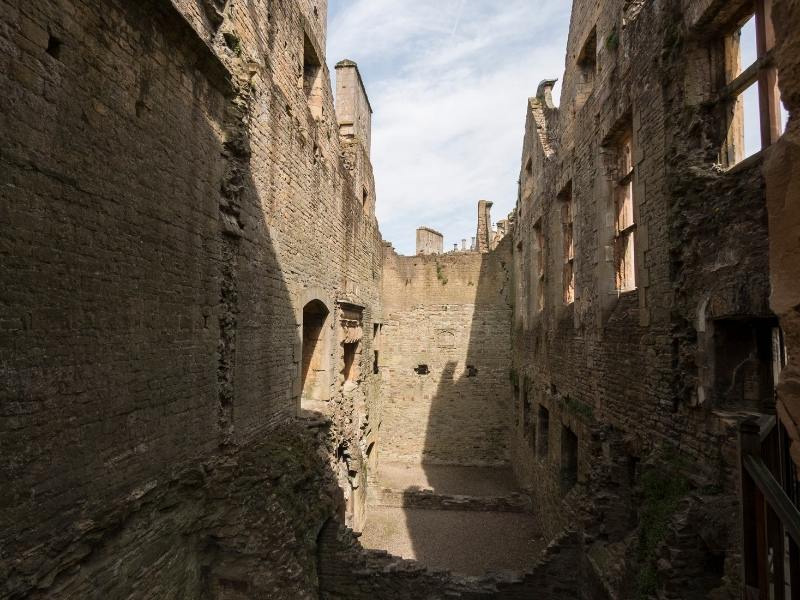
Famous as the home of the Crawley family in the highly acclaimed (and popular) British TV series Downton Abbey. Highclere is actually the seat of the Earl of Carnarvon and family and is located in Hampshire.
It was the 5th Earl of Carnarvon, George Herbert who famously discovered the tomb of Tutankhamun in the 1920s.
The castle is open to visitors throughout the year and is included in many tours from London.
READ – How to plan a visit to Highclere Castle (Downton Abbey)
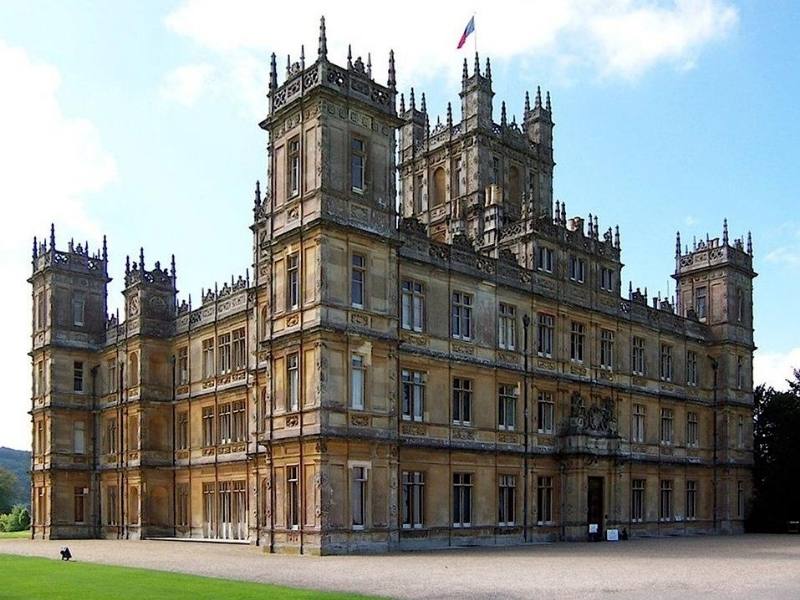
Do make sure you plan ahead if you wish to visit any of the castles mentioned in this article. Check opening times and any restrictions. Wear comfortable shoes (cobble stones and uneven ground tends to be a feature of many of the castles and is unforgiving on the feet) And of course don’t forget your camera!
Love castles? Want more? Check out my guides to the best Scottish castles and the best Welsh castles to visit!
Many of these castles belong to either English Heritage or National Trust UK . It may be cost effective to join these organisations (annual membership) if you are a UK resident.
For overseas visitors there are alternate membership options worth considering if you are planning to include a number of castles, stately homes, ancient monuments, historic houses, gardens in your itinerary.
If spending the night in an English castle is on your UK bucket list you will be happy to hear that there are a few castles that offer accommodation. Check out my England Accommodation Guide for further information.
You will have noticed that there are a lot of castles along the North East coast. Northumberland actually has the most castles of any English county.
If you are interested to learn more about English history Northumberland is the perfect destination (it also has the advantage of having a beautiful coastline, the best night skies in the UK, some beautiful towns and villages plus numerous Roman ruins!) Read more in my Northumberland Travel Guide
Read more about the UK in my travel guides
- Brighton Travel Guide (with tips, itinerary and map)
- Lake District Travel Guide (including tips, itinerary + map)
- Peak District Travel Guide (including tips, itinerary + map)
Join my UK and London travel planning group on Facebook for more tips, inspiration and help from other travelers planning future travel to London and the UK.
Awesome, you're subscribed!
Thanks for subscribing! Look out for your first newsletter in your inbox soon!
The best things in life are free.
Sign up for our email to enjoy your city without spending a thing (as well as some options when you’re feeling flush).
Déjà vu! We already have this email. Try another?
By entering your email address you agree to our Terms of Use and Privacy Policy and consent to receive emails from Time Out about news, events, offers and partner promotions.
Love the mag?
Our newsletter hand-delivers the best bits to your inbox. Sign up to unlock our digital magazines and also receive the latest news, events, offers and partner promotions.
- Things to Do
- Food & Drink
- Arts & Culture
- Coca-Cola Foodmarks
- Feeling Curious?
- Los Angeles
Get us in your inbox
🙌 Awesome, you're subscribed!

The 13 best castles in the UK
Enjoy a royally good day out and transport yourself back in time at one of the best castles in the UK
In the UK , we take our castles a bit for granted. They’re like our curio-packed museums and idyllic seaside towns , like our lush rolling hills and countless characterful pubs – our castles are sort of just there . But they’re also amongst the most majestic and fascinating historic structures in the entire world – when you stop to think about them, they really are quite something.
Dotted with dramatic drawbridges, towering turrets and winding dungeons, Britain’s castles are packed with centuries of unique stories. Whether you’re looking for winding political histories or spectacular architecture, they come in all shapes, sizes, and locations, from slap-bang in the city centre to perched on stormy clifftops. So, head this way. Here are the 13 best castles in the UK.
RECOMMENDED: 🌈The most colourful places in the UK 🌤️The best places to visit in the UK 🏔️The most scenic hikes in the UK 🏖️The most beautiful hidden beaches in the UK
An email you’ll actually love
Best castles in the UK

1. Warwick Castle, England
Warwick Castle makes for a proper day out. As well as all the towers, rooms and gardens to explore, there are plenty of attractions for small kids and big kids alike, all with the noble aim of making history fun. Spend the day exploring the ‘Horrible Histories’ maze, the castle dungeon and the Princess Tower, while in the grounds, there’s a bird of prey display and a knight school. Never want to leave? You can stay the night in style with suitably decked-out glamping tents, lodges or suites in the castle itself.
From £22. Warwick Castle , Warwick, CV34 4QU.

2. Cardiff Castle, Wales
Set in the middle of the city and surrounded by Bute Park, Cardiff Castle looks like a normal stronghold from the outside, but set foot inside and things start to get really jazzy. During its long history, the castle has been decked out with all the trappings you’d expect of a lavish palace: stained-glass windows, murals, marble and wood carvings. The opulent interiors have been described as a ‘Victorian medieval dream world’, and it’s well worth taking a tour to marvel at the banqueting hall, library and the ceiling of the famous Arab room.
From £15.50. Cardiff Castle , Cardiff, CF10 3RB.
📍 Discover the best things to do in Cardiff

3. The Tower of London, England
Despite its deceptive name, the Tower of London is most definitely a castle. Not only that, it’s the most secure castle in the land. No surprise that the Crown Jewels are stashed here. Visit for a glimpse of said sparklers, and pick up lots of great historical facts while you’re at it. Like, did you know that the Tower used to make all the coins in the realm, or that it has been a fortress, a palace and a prison? Or that if the six resident ravens ever leave the castle, the kingdom will fall into ruin? That’s your next dinner party convo sorted.
From £34.80. The Tower of London , London, EC3N 4AB.
📍 Discover the best things to do in London

4. Alnwick Castle, England
Dating back to the Norman era, Alnwick Castle in Northumberland has been lots of things, from a family home to a refuge for evacuees. Most famously, though, it’s been a film set. With activities such as broomstick training and dragon quests, you can probably guess which franchise the castle is associated with. Grab your Nimbus 2000 and head to the exact location a certain boy wizard had his first quidditch lesson. If all that sounds like nonsense to you, there are plenty of muggle activities too, like jousting, fine dining and outdoor cinema screenings.
From £20.50. Alnwick Castle , Alnwick, Northumberland, NE66 1NG.

5. Caernarfon Castle, Wales
Wales has a curious relationship with its many castles. Some are proud to hold them up as beautiful examples of medieval architecture that represent a major pull for tourists, while others see the so-called Iron Ring as a painful reminder of King Edward I’s conquest of Wales in the twelfth century. Of all the castles, Caernarfon’s is possibly the most arresting, a UNESCO World Heritage site that was said to be designed on the famous walls of Constantinople (today’s Istanbul). Caernarfon is a charming town with plenty of attractions but few come close to matching the might of its eponymous castle.
From £13. Caernarfon Castle . Castle Ditch, Caernarfon, LL55 2AY

6. Dunnottar Castle, Scotland
Nothing says drama quite like a ruined fortress perched on a precipice above the sea, and that’s exactly what you get with a visit to Dunnottar Castle in Scotland . The castle was saved from being completely lost by restoration work in 1925. It’s still kind of a ruin, but in a good, haunting way that suits its location. History buffs will love its ties to famous historical figures (shout out to Mary Queen of Scots, who visited for the first time in 1562), and photographers will love the striking figure it cuts against the sea – rain or shine, it’s practically impossible to take a bad photo of it.
From £11.50. Dunnottar Castle , Stonehaven, Aberdeenshire, AB39 2TL.

7. Edinburgh Castle, Scotland
Popped on a peak like the proverbial cherry, this striking urban castle dominates the Edinburgh skyline, making itself the Scottish capital’s most iconic landmark. Once you’re done admiring it from afar, march your way up the Royal Mile to the front gates, then there’s plenty to do and see inside the castle itself. Plan your visit around lunch to hear the firing of the one o’clock gun, and leave time to check out the enigmatically named Stone of Destiny. It’s displayed next to the Scottish Crown Jewels, which gives you some idea of its value, but, to preserve the air of mystery, we won’t tell you what it’s for.
From £19.50. Edinburgh Castle , Edinburgh, EH1 2NG.
📍 Discover the best things to do in Edinburgh

8. Castle Ward, Northern Ireland
Game of Thrones is over, but that doesn’t mean our fascination with its filming locations is going anywhere. If you’re up for a little set-jetting, Northern Ireland has plenty of Thrones gems, including Castle Ward, aka Winterfell, where the baby Starks began their adventures way back in season one. Not a GOT fan? Explore the eighteenth-century mansion, woodlands, gardens, the tea room and secondhand bookshop, with not a dragon in sight.
From £13. Castle Ward , Downpatrick, County Down, BT30 7BA.

9. Tintagel Castle, England
Said to be the birthplace of King Arthur, the romantic castle of Tintagel has long been connected to myths and legends. It appears to have been constructed for its legendary location alone, as its site on the north Cornwall coast offers no obvious military value. Part of the castle is built on the mainland and the other on an island with a footbridge linking the two. Visit for the Arthurian legends and mysterious spots like Merlin’s Cave if that’s your thing. If not, the rocky beachside location is a stunning destination in itself.
From £14.50. Tintagel Castle , Tintagel, Cornwall, PL34 0HE.
📍 Discover the best things to do in Cornwall

10. Dunluce Castle, Northern Ireland
Touring along the Causeway Coast? Dunluce Castle is well worth a stop. This striking cliffside ruin perches on the edge of the Antrim coast. And there are some pretty dramatic stories to go with its location. Forget actual history, like Scottish sieges, we’re here for the mythical tales of hauntings, banshees and how the entire castle kitchen crashed into the sea one stormy night. Ooh, we’ve got goosebumps.
From £6. Dunluce Castle , Bushmills, County Antrim, BT57 8UY.

11. Dunrobin Castle, Scotland
For a castle that looks like it’s been lifted straight from a fairy tale, head for this turreted wonder in the Scottish Highlands . With the vibe of a fancy French chateau, you’ll find pointy spires and vast windows galore overlooking the walled, formal gardens below and Moray Firth beyond. The castle dates back to the 1300s and has been continuously inhabited since then by a long line of earls and dukes. Unfortunately, you can’t stay overnight, but you can take a tour of the interior and the gardens. There’s a tearoom and a falconry, too.
Open March 29-Oct 31. From £14.50. Dunrobin Castle , Golspie, Sutherland, KW10 6SF.

12. Beaumaris Castle, Wales
Viewed from above, Beaumaris Castle on Anglesey is a symmetrical work of art. With its concentric ‘walls within walls’ design, it’s one of the most perfect castles in Britain… However, when it was being built, Edward I ran out of money (hey, we’ve all been there), and so the walls never reached their intended full height. The result? An unfinished but perfectly formed, tranquil-looking fortress set against a scenic, seaside backdrop. And as if it couldn’t get any more photogenic, there’s a moat. Serious castle credentials.
From £6. Beaumaris Castle , Beaumaris LL58 8AP

13. Windsor Castle, England
The oldest and largest occupied castle in the world, Windsor is likely best known as the fave castle of the late Queen Elizabeth II. Y ou can take a tour of the plush red-and-gold state apartments (walk the historic or ceremonial route depending on your mood), explore the castle’s treasures and visit the chapel where (most of) your favourite royal weddings have taken place.
From £30. Windsor Castle , Windsor, Berkshire, SL4 1NJ.
📍 Discover the best things to do in Windsor
[image] [title]
Discover Time Out original video
- Press office
- Investor relations
- Work for Time Out
- Editorial guidelines
- Privacy notice
- Do not sell my information
- Cookie policy
- Accessibility statement
- Terms of use
- Modern slavery statement
- Manage cookies
- Advertising
- Time Out Market
Time Out products
- Time Out Worldwide
10 Best Castles to Visit in England
:max_bytes(150000):strip_icc():format(webp)/FerneArfin-5b6f00c446e0fb0050324e74.jpg)
England's 10 best castles include magical settings for legendary stories and early Medieval ruins connected to powerful families. There are castles with romantic stories and others that are the Victorian fantasies of wealthy aristocrats. These are among the best.
Leeds Castle, the Most Romantic Castle in England
Leeds Castle, near Maidstone in Kent, is often called the most romantic castle in England because of its beautiful setting, surrounded by a moat. There is another good reason to think of romance here. For most of its 1,000-year history, it has been a lady's castle. The first woman to own it, Eleanor of Castile, the wife of King Edward I, bought it for herself from the Norman noble who went broke building it. Eventually, it was the dower house of six queens, and Henry VIII added luxury touches to make it ready for his newest wife, Anne Boleyn. Sadly, she lost her head before she had much time to enjoy it.
Today the castle combines original medieval rooms and features with 20th-century areas created for the last private resident, an Anglo-American heiress who entertained celebrities like Charlie Chaplin and the young Winston Churchill. Among the highlights are the Gloriette, the oldest part of the castle, and the many family-oriented events that take place throughout the year. There's a hedge maze that ends in a magical hidden grotto and extensive gardens to explore.
Arundel Castle, a Fairytale Castle and a Nest of Conspirators
Arundel Castle was begun within a year of the Norman Conquest in 1067. Some parts of that early castle—the keep, the gatehouse, and the barbican (defensive tower above the gate)—remain. Still, most of what you see is a Victorian fantasy of what a castle should look like, added during renovations in the 1880s and 1890s.
It is still a fabulous place to visit in its position high above the West Sussex town of Arundel and the river Arun, about two hours by car or train south of London.
It's the family seat of the Dukes of Norfolk, who is still in residence. Learning about this once politically powerful family and the ups and downs of their fortunes is the highlight of any visit. The family included several cardinals, a saint, a hero of the Spanish Armada, and the uncle of both Anne Boleyn and Catherine Howard. He conspired to marry both of them to Henry VIII, and both lost their heads as a result. So, by the way, did many Dukes of Norfolk.
The house is crammed with Tudor-era furniture, tapestries, and clocks as well as portraits by Van Dyck, Gainsborough, and others. While there, you can also see some of the personal possessions of Mary, Queen of Scots—the fourth Duke plotted to marry her and was beheaded for it.
Dover Castle, Guarding England Since William the Conqueror
Dover Castle commands the shortest crossing of the English Channel to France, the reason William the Conqueror himself chose it. He directed the building of a stockade there almost immediately after the Battle of Hastings in 1066. He wasn't the first to recognize this hill's importance. The Romans and the Anglo Saxons also fortified the spot, and you can see evidence of them when you visit. The castle remained a garrisoned fortress from these early days right up to the late 1950s.
Among the highlights of a visit, see the Great Tower, where six rooms of the Medieval castle of Henry II, William's grandson, have been recreated. Then tour the World War I Fire Command Post and take a guided tour of the World War II tunnels that housed a hospital and Operation Dynamo, the planning HQ for the evacuation of thousands of British soldiers from Dunkirk. Some of the costumes from the 2017 film, "Dunkirk," are on exhibit there.
Hever Castle, Anne Boleyn's Childhood Home
Anne Boleyn's childhood home is a mere 30 miles southeast of London, near Edenbridge in Kent. It's surrounded by 125 acres of gardens and includes 28 rooms where you can stay.
The Tudor house, built by the Boleyn family, sits within the 13th century, medieval castle, filled with Tudor rooms—including a bedroom reputed to be Anne's. The castle was restored by American millionaire William Waldorf Astor who created a family home in part of the castle while indulging his interest in history by renovating the house. The heavily carved paneling and furniture in the Tudor rooms are worth a visit alone.
Hever Castle is an active family attraction with events happening in the gardens and grounds throughout the summer. Don't miss the jousting and heavy horse events that take place regularly within an authentic Medieval jousting arena, complete with a royal box.
Alnwick Castle, Learn to Fly from Harry Potter's Professor
Alnwick Castle (pronounced Annick), the family seat of the Dukes of Northumberland, is the second-largest inhabited castle in England (Windsor is the largest). It's on England's northeast coast, about halfway between Newcastle upon Tyne and the Scottish border.
For more than 700 years, the castle has been home to the Percys, once an influential political family in the late Middle Ages. Today this castle is probably more famous as the location of Hogwarts in "Harry Potter and the Philosopher's Stone" and "Harry Potter and the Chamber of Secrets."
Today you can learn broomstick flying and the rules of Quiddich in Outer Bailey, where Harry and friends learned to fly. Free 25-minute broomstick training sessions are available to castle ticket holders throughout the day. And the "Professors" share the secret of taking airborne photos with "graduates."
In the Artisan's Courtyard, the family can dress up in Medieval costumes and join in with the villagers in trying traditional crafts and games. You can also go on a quest to conquer a dragon.
The castle has impressive staterooms, and about a mile down the road, the Duchess of Northumberland has created new gardens that include a gated and locked poison garden that can only be visited by guided tour.
Bolsover Castle, a Party House of the Stuart Era
Sir William Cavendish built Bolsover Castle, within the ruins of a Norman castle, in the 17th century during the reign of the Stuart king, Charles II. He was a playboy, poet, and adventurer who designed his house to resemble a Medieval castle. But it was a place for him to entertain and impress his friends. During the English Civil War, Cavendish, who was a Royalist or Cavalier fought on the losing side and fled into exile in 1644. When he returned, about 16 years later, his house was severely damaged. He set about restoring some of it into what is now the Little Castle.
A highlight of a visit is the chance to see the Cavalier Horses perform in the indoor Riding School at Bolsover Castle. The horses perform to Baroque music with riders in Cavalier costumes, every weekend from early April to early October.
This Derbyshire house is about 25 miles north of Nottingham and about 12 miles east of the Peak District National Park.
Bodiam Castle, Ruined Splendor Behind a 14th Century Moat
Duncan George/Getty Images
Visit Bodiam Castle in East Sussex to walk the long bridge across its magnificent moat and to enter a ruined 14th century castle left much as it was the last time it saw battle. You might find that Bodiam Castle resembles the castle you may have built with a pail and shovel on the beaches of your childhood. You can climb ancient spiral staircases and see a very rare and original portcullis in the gatehouse. Picnic on the grounds or join a free archery session.
Bodiam is about 11 miles from the south coast at Hastings and only around 7 miles from Battle, the site of the Battle of Hastings, and well worth a visit.

Kenilworth, a Castle to Woo a Queen
Kenilworth started as a Norman country house. It was fortified into a castle by Henry II, William the Conqueror's grandson, who needed a stronghold to protect his throne from his many warring brothers. It was finally reduced to ruins by Oliver Cromwell's men after the English Civil War in the 17th century. But before that Robert Dudley, 1st Earl of Leicester, extensively renovated the castle to please a special visitor, Queen Elizabeth I.
The story of Elizabeth and Dudley is one of the great unresolved romances of history. The childhood friends were reacquainted when both were imprisoned in the Tower by Elizabeth's sister, Queen Mary. Dudley became her favorite, and there was even talk of marriage. Then scandal over the mysterious death of his wife Amy made marriage impossible. Instead, he virtual rebuilt Kenilworth to please Elizabeth, who visited often.
Since 2014, new enclosed staircases let visitors enjoy views last seen by Elizabeth more than 400 years ago, while 21st-century gardeners recreated the privy garden created for her. And in the Leicester Gatehouse, see an Elizabethan bedroom and an exhibition about the romantic story.
Kenilworth is in Warwickshire, 105 miles from London but only 15 miles from Stratford-upon-Avon, making it an excellent add-on to a short break in Shakespeare's England.
Tintagel, Echoes of King Arthur
Legend has it that King Arthur was conceived here. What is much more likely is that Richard, Earl of Cornwall, and brother of King Henry III picked this strategic headland to build his castle in the 13th century and connected it to the popular Morte d'Arthur, a "bestseller" of the early middle ages. To strengthen his claim and attachment to Cornwall, Richard clothed himself in the popular legends. Tintagel's astonishing position, perched on rocks above a beach and Merlin's cave, makes it easy to imagine legendary romances happened here.
You need a head for heights for the long steep staircases and the narrow bridge that connects the castle to the mainland. It's worth the effort. Tintagel Head is on the north coast of Cornwall between Boscastle and Port Isaac.
Warkworth Castle, the Seat of Medieval Power
Warkworth Castle, near the Northumberland coast and the Scottish border, was built by the colorful Percy family who arrived in Britain with William the Conqueror and became power players and intriguers through the Middle Ages. As the Dukes of Northumberland, they also built nearby Alnwick Castle, which is still the family seat.
The castle's position, a ruin at the top of its small English village, is dramatic. Today's visitors can explore the unusual cruciform castle keep, designed in the shape of a Greek cross. Its rooms and floors can be explored as can the Duke's chambers, two rooms roofed and floored in the 19th century for the private use of the Duke and his family. The gatehouse is the oldest part of the castle, and beyond it, the Bailey is a flat, grassy area great as a picnic and children's play area.
Warkworth Castle: The Complete Guide
Dover Castle: The Complete Guide
Anne Boleyn's Hever Castle: The Complete Guide
15 Terrific Day Trips From London
The Castles of William the Conqueror
Tintagel Castle: The Complete Guide
Kenilworth Castle: The Complete Guide
The Top 20 Things to Do in the UK
5 of the Prettiest Tiny Villages to Visit in England
4-Day UK Travel Itinerary: West of London Travel Plan
St. George's Chapel at Windsor: The Complete Guide
10 Great Reasons to Visit the United Kingdom
Stay Cheaper By Staying Close to - Not in - London
The Lake District: The Complete Guide to the English Lakes
Every UNESCO World Heritage Site in the UK
Top 10 Castles in Wales
The most impressive castles in England
Book your individual trip , stress-free with local travel experts
Select Month
- roughguides.com
- best-castles-in-england
Plan your tailor-made trip with a local expert
Book securely with money-back guarantee
Travel stress-free with local assistance and 24/7 support
written by Rough Guides Editors
updated 16.11.2022
Historic attractions abound in our green and pleasant land. There are ornate stately homes, gothic cathedrals and chocolate-box villages at every turn, but among the most impressive examples of heritage are the slew of majestic castles in England .
1. For Harry Potter fans: Alnwick Castle
2. one of the best castles in england — bamburgh castle, 3. leeds castle — a true fairy tale palace, 4. the deeply historical dover castle, 5. for a picturesque english castle — bodiam castle, 6. windsor castle — the oldest castle in england, 7. the commanding warkworth castle, 8. hever castle — the home of anne boleyn, 9. tintagel castle — the birthplace of king arthur, 10. warwick castle — a norman castle in england, 11. lancaster castle — historical site turned modern-day prison.
- 12. Carlisle Castle, Cumbria's mightiest castle
13. The forbidding Lincoln Castle, Lincolnshire
- 14. Highclere Castle of "Downton Abbey"
15. Corfe Castle for a beautiful hill top castle
16. arundel castle: home of the barons hall, 17. framlingham castle — one of the best castles in england, 18. the home of royalty — highcliffe castle.
The information in this article is inspired by The Rough Guide to England , your essential guide for visiting England .
Travel ideas for England, created by local experts

20 days / from 3066 USD
The Great British Road Trip
Get ready to explore Britain on this unique self-drive road trip. Choose the car of your liking before you hit the road: from the Cotswolds and its picturesque villages over the Beatle's favorite hang-out in Liverpool to Scotland's capital Edinburgh: this trip includes many highlights to be explored
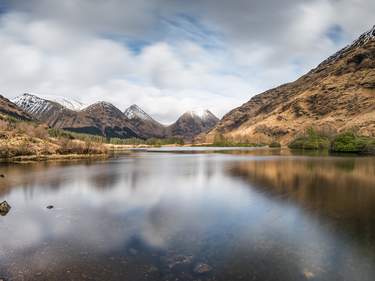
7 days / from 1382 USD
Magical 7-Day Family Adventure in Scotland and England : From Harry Potter to Loch Ness!
Searching for an unforgettable family adventure? Scotland is the perfect destination! With a perfect balance of nature, adventure, and Scottish culture. This 7-day trip offers a delightful mix of activities that everyone in the family will enjoy. Get ready to create life long lasting memories!
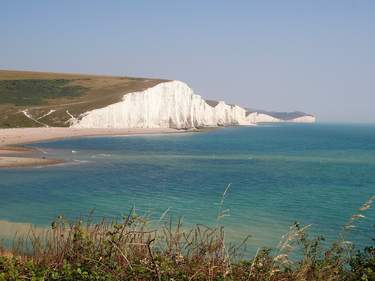
5 days / from 653 USD
Refreshing English Countryside Break
Outside of London, England is known with a countryside full of history, picturesque villages, patchwork hills, and winding country roads. Explore the countryside with its castles, parks, and historical cities such as Oxford.
Alnwick Castle , Northumberland, is undoubtedly one of the finest medieval castles in England. It’s owned by the Percys, the Dukes of Northumberland, who have presided over the estate since 1309. More recently, however, the castle found fame as Hogwarts School in the Harry Potter movies.
Take a scenic, coastal tour into the Kingdom of Northumbria and explore the medieval market town of Alnwick's stunning castle and gardens.
Find hotels close to Alnwick Castle

Alnwick Castle was used in Harry Potter movies © Gail Johnson/Shutterstock
Another Northumbrian gem, Bamburgh Castle , can be found in the little village of the same name . It’s most formidable when seen from the beach, where acres of sky, sea and dunes lead up to the castle’s dramatic setting atop a rocky basalt crag. This impressive medieval castle first appeared in Anglo-Saxon times, but was heavily reconstructed in the nineteenth century.
Discover the Ancient warrior kings of Northumberland, visit Bamburgh Castle, and explore Ad Gefrin, England’s first whiskey distillery on this private guided tour .
Find hotels close to Bamburgh Castle

Bamburgh Castle as seen from the beach © Dave Head/Shutterstock
Its reflection shimmering in a lake, the enormous Leeds Castle , Kent, resembles a fairy-tale palace. First built around 1119 AD, it has had a chequered history and is now run as a commercial concern, with a range of paying attractions on the castle grounds including hot-air ballooning, Segway tours and jousting. The name is misleading: you’ll find it in the High Weald of Kent .
Enjoy a full day discovering the treasures of Kent , including visits to romantic Leeds Castle, historic Canterbury Cathedral and the dramatic White Cliffs of Dover.
Find hotels close to Leeds Castle

A misty Leeds Castle - majestic castle in England you should visit © JuliaST/Shutterstock
No historical stone goes unturned at Dover Castle, an astonishingly imposing defensive complex that has protected the English coast for more than two thousand years. In 1068 William the Conqueror built over the earthworks of an Iron Age hillfort here; a century later, Henry II constructed the handsome Great Tower. The castle grounds also include a Roman lighthouse, a Saxon church and a network of secret wartime tunnels.
Join a day trip from London to Kent and take a tour of Dover Castle , the country's largest castle.
Find hotels close to Dover Castle

Dover Castle overlooking the English Channel © IVAN VIEITO GARCIA/Shutterstock
Related articles from the blog

One of the country’s most picturesque castles, Bodiam castle is a classically stout square block with rounded corner turrets, battlements and a wide moat. When it was built in 1385, it was state-of-the-art military architecture, but fell into neglect until restoration in the last century. The extremely steep spiral staircases will test all but the strongest of thighs.
Travelling around England, check out our list of the best things to do in England .
Find hotels close to Bodiam Castle

Bodiam Castle in East Sussex © Jaroslav Sekeres/Shutterstock
The oldest and largest inhabited castle in the world, towering above the town of Windsor in the Berkshire countryside just outside London, Windsor Castle is still important as a ceremonial residence of the Queen. The castle itself is an imposing sight, while inside you can explore the State Apartments and artwork from the Royal Collection.
Discover the royal castle of Windsor, the mysterious standing stone circle of Stonehenge, and the historic university city of Oxford on a full-day tour from London .
Find hotels close to Windsor Castle

The imposing Windsor Castle, one of the Queen's residences © sloukam/Shutterstock
Ruined but well preserved, Warkworth Castle has Norman origins, although the main building was constructed using sandstone during the fourteenth and fifteenth centuries. Take in the view from the north of the hamlet of Warkworth, from where the grey stone terraces of the long main street slope up towards the commanding remains of the Castle.
The Rough Guides to England and related travel guides
In-depth, easy-to-use travel guides filled with expert advice.

Find hotels close to Warkworth Castle

Warkworth Castle has commanding views © Craig Duncanson/Shutterstock
The moated Hever Castle was the childhood home of Anne Boleyn, second wife of Henry VIII, and where Anne of Cleves, Henry’s fourth wife, lived after their divorce. Bought by American millionaire William Waldorf Astor in 1903, it has been assiduously restored in mock Tudor style yet it retains an intimate feel. Outside you can explore Waldorf Astor’s beautiful Italian Garden including a splashy water maze.
Find hotels close to Hever Castle

Hever Castle – once home to Anne Boleyn © Lilly Trott/Shutterstock
Myth and legend surround the desolate ruins of Tintagel Castle, said to be the birthplace of King Arthur. Sited on an islet along a wild and rugged stretch of Cornwall’s coast, the remains of the buildings have nearly all but decayed since it was deserted in the seventeenth century.
Explore Tintagel with our tailor-made 12-day hiking tour to Northern Cornwall .
Find hotels close to Tintagel Castle

The view at Tintagel - ruins of the magical castle in England © Valery Egorov/Shutterstock
This whopping castle standing over the River Avon is well worth visiting. Historians think the first fortress was constructed here by the Saxons, but the most significant expansions were made by the Normans and later in the nineteenth century. Save time to explore the extensive grounds, too.
Explore Shakespeare’s birthplace and enjoy some time to explore Stratford-Upon-Avon. Have an extended visit of Warwick Castle and be part of a British medieval experience.
Find hotels close to Warwick Castle

Warwick Castle, overlooking the River Avon © David Steele/Shutterstock
From the dungeons to the ornate courtrooms, Lancaster Castle is a historical tour-de-force. Defences have been sited high above the river here since Roman times, and the building served as a working prison right up until 2011. Engaging guided tours bring the castle’s history to life.
Find hotels close to Lancaster Castle

Lancaster Castle — one of the best castles in England © Steve Allen/Shutterstock
12. Carlisle Castle, Cumbria's mightiest castle
Cumbria’s mightiest castle dominates the county capital Carlisle, were it has stood for over nine hundred years. Among its claims to fame is that it was where Elizabeth I held Mary Queen of Scots captive in 1568. Climb the battlements for great views over the town.
If you are planning to visit Cumbria in winter read our guide about best winter walking in the Lake District .
Find hotels close to Carlisle Castle

Carlisle Castle - medieval castle in Lake District © stocksolutions/Shutterstock
Intact and forbidding, Lincoln Castle ’s walls incorporate bits and pieces from the twelfth to the nineteenth centuries, with a wall walkway offering great views over town. Recently the former debtors’ prison has been revamped to exhibit several rare documents, most notably one of the four surviving copies of the Magna Carta.
Find hotels close to Lincoln Castle

Lincoln Castle - where you can see a rare copy of the Magna Carta © Peter R Foster IDMA/Shutterstock
14. Highclere Castle of "Downton Abbey"
Tucked away in the northern reaches of Hampshire, 20 miles north of Winchester, Highclere Castle will be very familiar to fans of hit period drama, Downton Abbey , which is filmed here. Home to Lord Carnarvon and his family, the house is approached via a long drive that winds through a stunning 5,000-acre estate, and is surrounded by beautiful gardens designed by Capability Brown.
Explore Downton village and Downton Abbey and relive aristocratic life of a century ago.
Find hotels close to Highclere Castle

Highclere Castle – otherwise known as Downtown Abbey © Alice-D/Shutterstock
The romantic castle ruins crowning the hill behind the village of Corfe Castle are perhaps the most evocative in England. The family seat of Sir John Bankes, Attorney General to Charles I, this Royalist stronghold withstood a Cromwellian siege for six weeks, gallantly defended by Lady Bankes.
One of her own men, Colonel Pitman, eventually betrayed the castle to the Roundheads, after which it was reduced to its present gap-toothed state by gunpowder. Apparently the victorious Roundheads were so impressed by Lady Bankes’ courage that they allowed her to take the keys to the castle with her.
Dorset is one of the most picturesque places in England. Find more beautiful English landscapes in our guide to the most beautiful places in England .
Find hotels close to Corfe Castle

Corfe Castle – site of a dramatic battle in the English Civil War © Kevin Standage/Shutterstock
Despite its medieval appearance, much of what you see of Arundel Castle is comparatively new, the result of a series of lavish reconstructions from 1718 onwards, after the original Norman structure was badly damaged during the Civil War.
Inside the main castle, highlights include the impressive Barons Hall and the library, which has paintings by Gainsborough, Holbein and Van Dyck. On the edge of the castle grounds, the fourteenth-century Fitzalan Chapel houses tombs of past dukes of Norfolk. Nearby, the Collector Earl’s Garden is a playfully theatrical take on a Jacobean garden, with exotic planting, and pavilions, obelisks and urns made from green oak rather than stone.
Find hotels close to Arundel Castle

Arundel Castle in Arundel City, West Sussex, England © AdobeStock
The crenellations of Framlingham Castle cut a classic shape at the top of Church Street. The castle dates from the twelfth century, and was built by the Bigod dynasty later becoming the seat of the dukes of Norfolk. It’s little more than a shell inside, but the stone curtain wall, with its thirteen towers, has survived almost intact, a splendid example of medieval military architecture, many of them topped by elegant Tudor brick chimney stacks.
You can get good views of the castle from the outside by following the footpaths that lead around the moat and down to and around the lake or “mere” below, where you can see across the valley to Framlingham College.
Find hotels close to Framlingham Castle

Medieval Castle of Framlingham, England © AdobeStock
Highcliffe Castle was built in 1831-1836 and is the epitome of Lord Stuart de Rothesay's imagination. In the years since it was built, kings and queens, princes and princesses have stayed here.
In the early 1950s it was briefly an orphanage, after which the building was used as a seminary to train students for the priesthood. Just before the students left, tragedy struck: a fire engulfed the Great Hall. An even more devastating fire broke out the following year. For two decades the castle stood in ruins, exposed to the weather and vandals.
Today the castle has been restored thanks to government funding and is open to the public. It now hosts weddings, fairs, exhibitions and plays throughout the year. The Highcliffe Castle is a treasure in the heart of the community and a popular tourist attraction.
Find hotels close to Highcliffe Castle

Highcliffe castle in Dorset © Shutterstock
For more travel inspiration check out our guide about the best road trips in the UK .
If you prefer to plan and book your trip to England without any effort and hassle, use the expertise of our local travel experts to make sure your trip will be just like you dream it to be.
Ready for a trip to England ? Check out the snapshot The Rough Guide to England or The Rough Guide to Great Britain . If you travel further in England , read more about the best time to go , the best places to visit and best things to do in England. For inspiration use the England itineraries from The Rough Guide to England and our local travel experts . A bit more hands on, learn about getting there , getting around the country and where to stay once you are there.
We may earn commission from some of the external websites linked in this article, but this does not influence our editorial standards - we only recommend services that we genuinely believe will enhance your travel experiences.
Top image © D K Grove/Shutterstock
- History Culture Heritage
- Architecture
- United Kingdom
- Inspiration
- See & Do
Planning your own trip? Prepare for your trip
Use Rough Guides' trusted partners for great rates
Travel advice for England
From travel safety to visa requirements, discover the best tips for traveling to England
- Eating and drinking in England
- Sports and Outdoor activities in England
- Travel Tips England for planning and on the go
- Getting around England: Transportation Tips
- How to get to England
- Shopping tips for England
- Best time to visit England
Find even more inspiration for 57 here
Ready to travel and discover england, get support from our local experts for stress-free planning & worry-free travels.
- Travel advice
- Where to stay
- Search Please fill out this field.
- Manage Your Subscription
- Give a Gift Subscription
- Newsletters
- Sweepstakes
- Destinations
The 13 Most Beautiful Castles in England
Visit these castles in England for a fairy-tale vacation.
VisitBritain/Yin Sun Photography
If there’s one thing England does better than anywhere else in the world — aside from medieval playwrights, pub lunches, and 1960s boy bands — it’s castles.
This is, after all, a country that is home to nearly 800 surviving stone fortresses, some dating back as far as the 11th century. Whether you’re a dedicated Harry Potter or Downtown Abbey fan, a passing history lover, or a genuine drawbridge devotee, read on for the ultimate fortified favorites to add to your next English itinerary.
Arundel Castle, West Sussex
VisitBritain/Pete Seaward
An easy hour's drive or train ride from London, Arundel has been home to the Dukes of Norfolk for more than 850 years, and they’ve done a fine job with its upkeep. This was one of the first castles in Europe to have central heating, electricity, and elevators in the towers, and it remains in excellent condition today. Visitors can check out many of its magnificent rooms, as well as its 14th-century chapel and exquisite gardens. Meanwhile, the quaint town of Arundel, huddled about the foot of the castle, is well worth exploring, too (particularly the legendary Black Rabbit Pub , which serves one of the best Sunday roasts in Sussex).
Highclere Castle, Hampshire
Peter Orr Photography/Getty Images
The “real” Downtown Abbey, Highclere was built in the late 17th century, making it one of England’s youngest major castles. It is also indisputably one of the most beautiful, with its intricate state rooms, elegant saloon, and palatial dining room. A big part of the appeal is its sprawling grounds — best enjoyed with one of the castle’s famous picnic hampers, containing impeccable sponge cakes, scones, and sandwiches, as well as a demi-bottle of Joseph Perrier Champagne.
Windsor Castle, Berkshire
Mark Kerrison/Getty Images
Royal watchers (and fans of The Crown ) will be well aware of Windsor Castle , the family home of British kings and queens for over 1,000 years — and still a residence of King Charles III today. Famously the largest and oldest inhabited castle in the world, the good news is plenty of the property is now open to the public, including the grandiose State Apartments and gothic St. George’s Chapel, where Prince Harry and Meghan Markle were married.
Alnwick Castle, Northumberland
Gannet77/Getty Images
Doubling as Hogwarts in the first two Harry Potter movies, Alnwick has been occupied by the Dukes of Northumberland for over 700 years. The current duke and duchess live in a private part of the 11th-century fortress, but the rest is open to the public for seven months of the year, with highlights including an important gallery of Italian paintings, a lavish library, and a dedicated Harry Potter tour — including broomstick lessons in the courtyard (Golden Snitch not included).
Warwick Castle, Warwickshire
Jacob King - PA Images/Getty Images
One of the oldest fortified citadels in England, Warwick Castle was originally built by William the Conqueror in 1068 but has been refortified several times since. Today, the huge castle is “full to the turrets” with family-friendly activities, including dungeon tours, fiery ballista demonstrations, and jousting tournaments. Overnight rooms are available in the castle (including tower suites with four-poster beds) or the riverside Knight’s Village, where you’ll find a cozy collection of woodland lodges.
Bamburgh Castle, Northumberland
Forget your regular dukes and lords; Bamburgh Castle was home to the Anglo-Saxon kings of Northumbria before England was even a country. Today the breathtaking building, perched on a dramatic rocky outcrop overlooking the wild North Sea, is considered one of Europe’s finest coastal fortresses. When you visit, don’t miss the dazzling collection of medieval armor in the state rooms, or the famous Bamburgh Sword — a seventh-century weapon shrouded in myth.
Leeds Castle, Kent
ptaxa/Getty Images
Despite its name, you’ll find Leeds Castle hundreds of miles from the city of Leeds, on a peaceful lake island in the middle of Kent. Surrounded by a handsome moat, the history of this fairy-tale fortress goes back 900 years and involves no less than six queens calling it home (hence its nickname, “The Ladies Castle”). The gardens are almost as photogenic as the castle itself and include a fiendish circular maze, mirroring the shape of a queen’s crown.
Sudeley Castle, Gloucestershire
Visit Britain/Sudeley Castle LLP
Considering its importance in English history, it’s baffling how Sudeley Castle is not better known. Tucked away in the idyllic Cotswolds near the pretty market town of Winchcombe, it was a favorite of influential monarchs ranging from Richard the Lionheart to Queen Elizabeth I. Highlights include the "20 treasures of Sudeley," a collection of important artifacts that altered the historical narrative, and a charming 15th-century chapel in the gardens, the final resting place of Katherine Parr, the sixth wife of Henry VIII and the most infamous “survivor” of the Tudor era.
Framlingham Castle, Suffolk
Heritage Images/Getty Images
A perfect example of the “motte and bailey” fortifications of the 11th and 12th centuries, Framlingham Castle sits in the rolling Suffolk countryside, about a 30-minute drive northeast of Ipswich. Famed as the place where Mary I was first proclaimed Queen of England, modern visitors can hike around the castle’s intact curtain wall, enjoying magnificent views of the nearby River Ore before retiring to the castle café for a well-earned pot of tea.
Rochester Castle, Kent
Strategically placed by a vital river crossing on the old London Road, Rochester Castle is a miraculously well-preserved 12th-century keep — particularly considering the number of battles it’s seen over the centuries. One of the main strongholds in the rebellion against Bad King John, it lost an entire tower to a pig fat bomb in 1215 but was rebuilt under Henry III, remaining a viable fortress until the 16th century.
Bodiam Castle, East Sussex
David C Tomlinson/Getty Images
If you like your strongholds encircled with a deep moat, then Bodiam is the castle for you. Built in 1385 to defend England against a feared French invasion, it ticks all of the classic battlement boxes: stout round towers, traditional gatehouse, and an intimidating portcullis. Sadly, this medieval beauty — just 14 miles from the picturesque Sussex coast — is largely just an external stone shell today. But what a shell.
The Tower of London
VisitBritain/Andrew Pickett
Although best known as England’s most ignominious prison during the Middle Ages, the Tower of London was built as a fortified castle and royal residence and remains both to this day. Supposedly one of the most haunted buildings in the country (two of Henry VIII’s wives were beheaded here, for starters), it’s also one of London’s top tourist attractions. Nearly three million visitors flock here every year to see the ravens, the dungeons, and the crown jewels on popular tours led by the larger-than-life Yeoman Warders, or “Beefeaters.”
Dover Castle, Kent
Medioimages/Photodisc/Getty Images
Nicknamed “The Key to England” due to its defensive significance, Dover Castle looks out over the blue waters of the English Channel towards France — a mere 21 miles away. Built in the 12th century, it is unique among England’s ancient fortresses in that it continued to serve a defensive purpose until well into the 20th century. The highlights here are the unmissable secret wartime tunnels, the robust Great Tower itself (now an interactive museum), and the remains of a Roman lighthouse, which dates from the year 50 and is one of the oldest standing buildings in Britain.
Related Articles
England for Anglophiles

The 30 Best Castles of England Worth The Journey From London
Sharing is caring!
With more than 4000 castles, how do you know which are the best castles in England to visit? With the help of travel writer friends, we have created a list of the best castles England has. Castles in Northern England include Alnwick Castle, famous as Hogwarts in Harry Potter. Castles in Southern England include Tintagel which is associated with King Arthur. For central England, there are beautiful castles in East Midlands, castles in West Midland and castles in East Anglia, many of which are steeped in important historical events that shaped the country’s path.
Best Castles of England – Central England
Some of the best castles of England lie in the middle of the country. As armies from the north and the south of England clashed, lots of the beautiful castles in England were left in ruins. There was lots of history made in the castles of the East Midlands, such as Nottingham Castle, and the castles of the West Midlands, such as Tutbury Castle. Castles in East Anglia, likewise, have plenty of history including Norwich Castle which is now a full-blown museum.
Baconsthorpe Castle
One of the most wonderful things about England is that beauty hides around every corner. As you trundle down the farm track towards Baconsthorpe Castle , you’d have no idea that the ruins of this 15th-century manor house are even there. Located in Baconsthorpe, just outside of Holt in Norfolk, this English Heritage site offers a fascinating insight into the history of the area. Once owned by the highly influential local family, the Heydon’s, the castle was passed down through many generations until too much spending meant that much of it needed to be sold off to pay debts. The castle sits in a truly idyllic setting, the highlight of which is the impressive moat where it is possible to see swans in the summer. There are also a number of beautiful circular walks nearby. Unlike many other English castles, Baconsthorpe offers remarkable value for money and is free to enter. The only costs that guests will incur are the cost to park in the car park which is charged at £2. English Heritage members park for free. Pet owners will also be pleased to hear that Baconsthorpe Castle is dog-friendly. Animals, however, should be kept on leads at all times.
– by Sheree Hooker at Winging The World
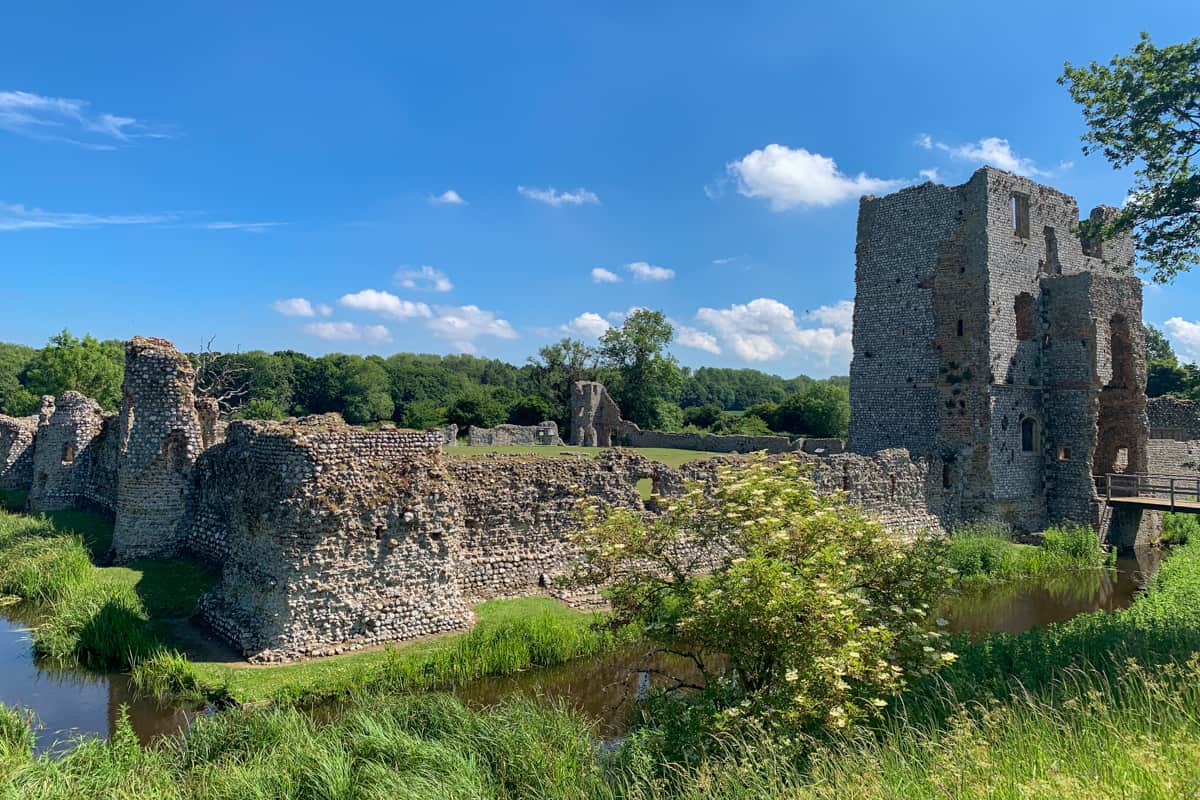
Bolsover Castle
Bolsover Castle is located within the beautiful village of Bolsover, Derbyshire. Set atop a steep hill, you can marvel at the spectacular 17th century fairy-tale mansion as you approach. The castle itself originates as a gift from William the Conqueror to one of his knights. As you wander around the grounds, you can see remnants of the lavish rooms that were designed to impress and entertain. Explore the fountain garden, the extensive terrace and the little castle. But best of all, gaze at the spectacular views of the countryside from the medieval style turret walls. Bolsover castle is part of English Heritage and accordingly, to enter the grounds you will need to purchase a ticket on the day, or in advance. There is a visitor centre where you can purchase audio guides for an immersive historical experience. You can also learn a lot from the free leaflets and posters. However, if you just want to enjoy the view of the castle itself, you can park on the hill, cross the small path and come out into the large open field at the foot of the castle. Best of all this part is free!
– by Kerry Hanson from VeggTravel
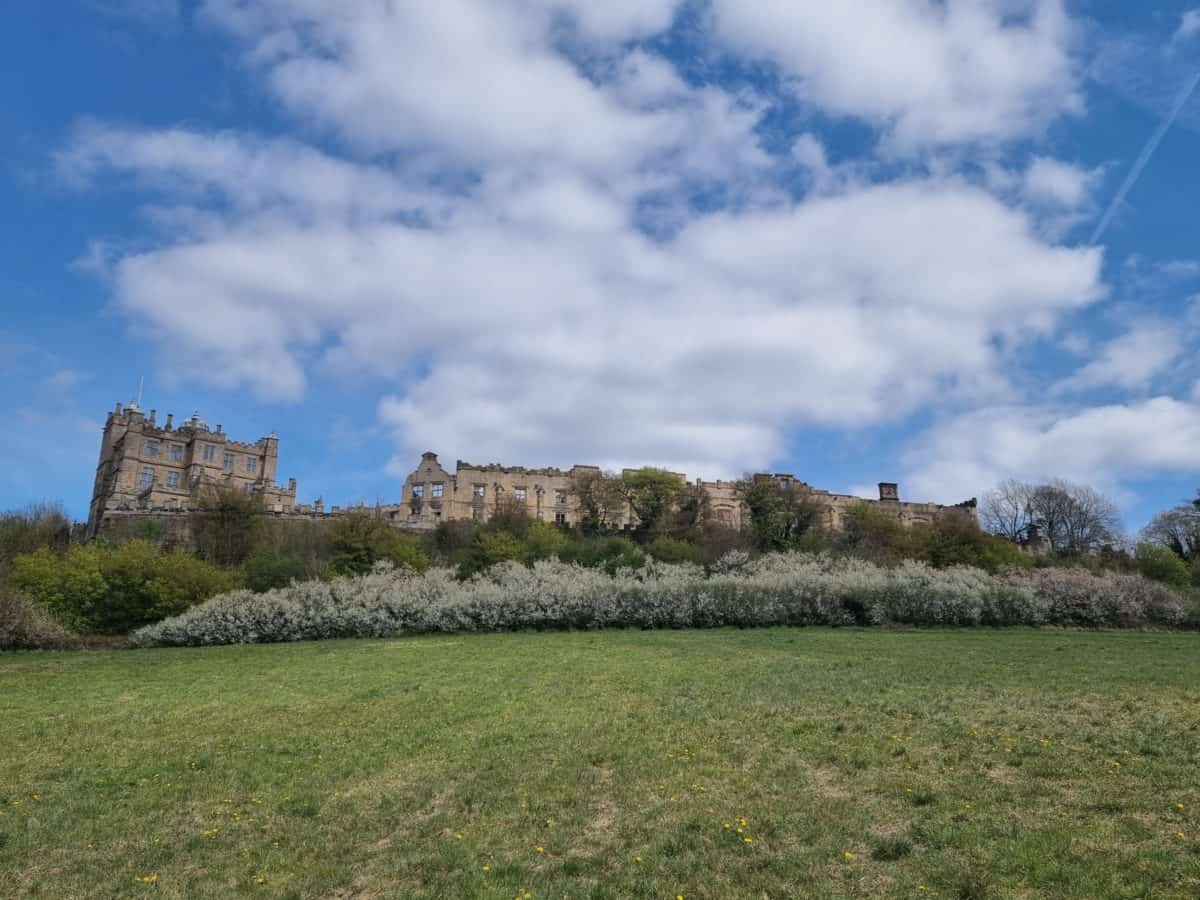
Kenilworth Castle
Kenilworth Castle and Elizabethan Garden is a large castle that is owned and maintained by English Heritage. The castle is located in the town of Kenilworth in the county of Warwickshire. The gardens had a major revamp at a huge cost of around 2 million but it was more than worth it as the gardens are stunning. They were originally created for Queen Elizabeth 1 by Robert, Earl of Leicester. In a huge Tudor stable you will find a cafe and next to here the staff often host family-friendly activities such as learning how to shoot arrows and build battle defences. The castle itself is largely ruined but that doesn’t mean there’s not much to explore. Some of the ruin has staircases and platforms now installed so that you can climb high up and enjoy some impressive views. The ruined Great Hall is also incredibly impressive with some fabulous views of the gardens from the Castle Keep. In the gardens, there are some lovely statues, flowers, plants and herbs that you can rub to smell. There is a cute aviary with canaries and other small birds. The centrepiece is a fountain made entirely out of marble. You can also look around Leicester’s Gatehouse which is an intact part of the castle with some interesting reconstructed rooms that you can look around. Kenilworth Castle is one of our favourite days out.
– by Suzy McCullough at Yorkshire To Do With Kids
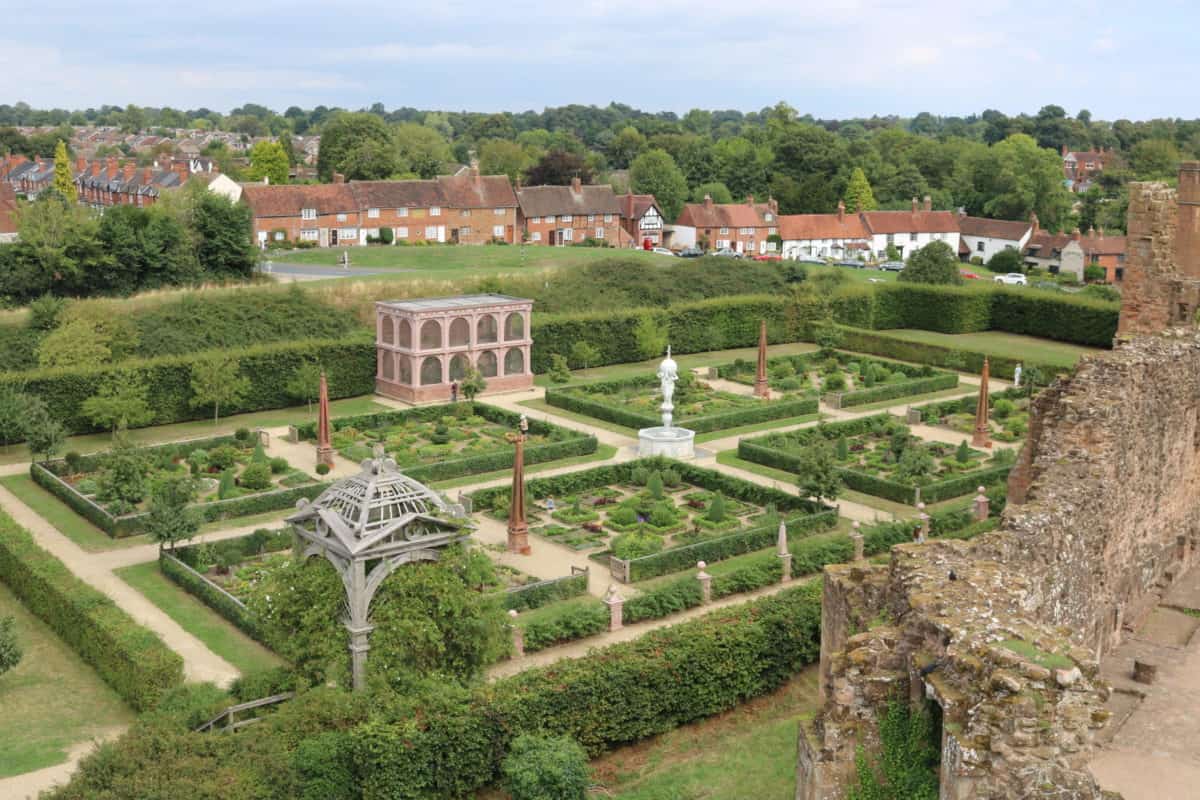
Norwich Castle
What Norwich Castle lacks in beauty, it makes up for with history. It is a Grade I-listed building and a Scheduled Ancient Monument. The castle was founded by William the Conqueror sometime around 1067. Up until the mid-12th century, when Henry II built Orford Castle, Norwich was the only major royal castle in East Anglia. Today only the castle keep still stands on a hill in the middle of the Norwich city centre. Since 1895, it has been a museum. Norwich Castle is one of the best things to do in Norwich and perfect for a day out with the kids. Allow at least two hours to visit Norwich Castle. Inside the keep nothing remains of the medieval layout. You can walk around the castle and learn about its history through interactive displays. They also offer tours of the dungeon and the battlements. In the exhibition area next to the keep, they have a diverse collection of fine art, including costume, textiles, jewellery, glass, ceramics, teapots, and silverware. There are also displays about Boudica (Queen of the Iceni), and the Romans, Anglo Saxons and Vikings. You will also find a section about the Egyptians as well as a Natural History Gallery. – by Anisa Alhilali of Norfolk Local Guide
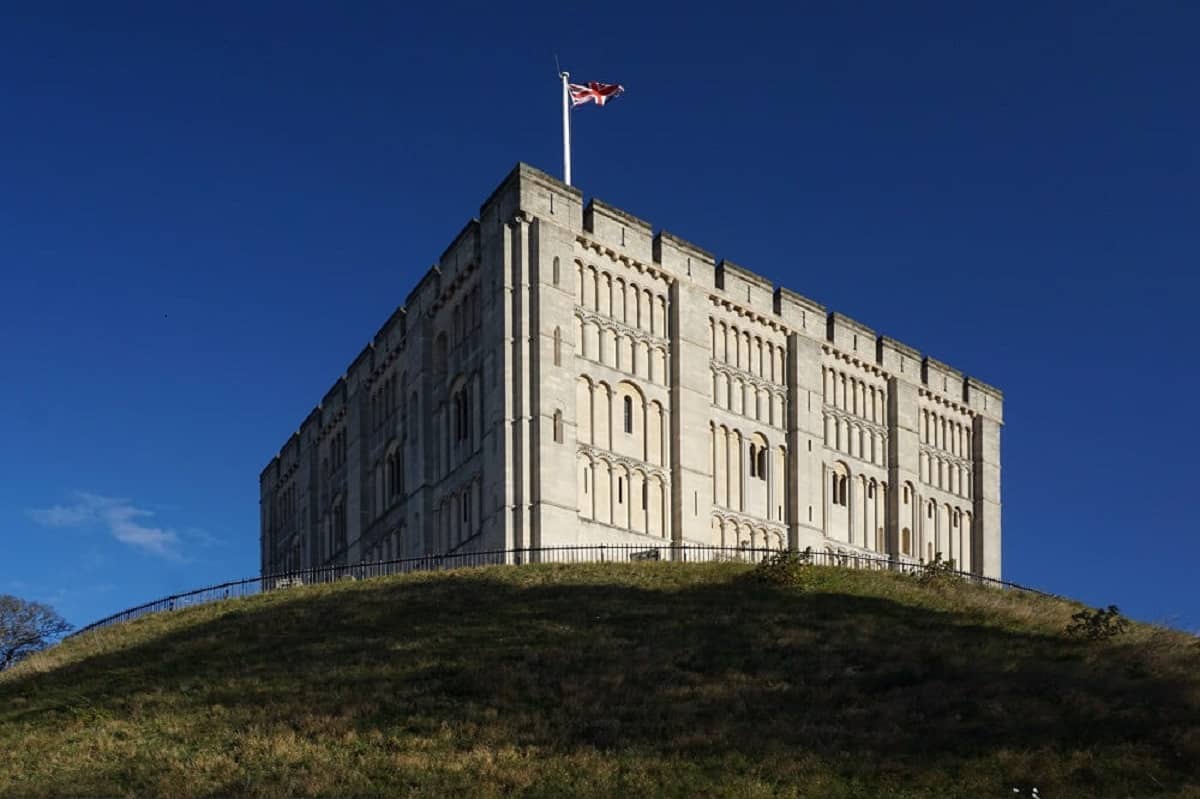
Nottingham Castle
Nottingham Castle definitely comes under the bracket of epic castles in England. Although the castle doesn’t have impressive turrets or battalions that other castles have it is overflowing with historical significance and is one of the top Nottingham attractions . Nottingham Castle was originally built as a wooden structure in 1068 on top of a sandstone cliff known as ‘Castle Rock’ which was a huge vantage point. The wooden castle was replaced with a much stronger stone castle during the reign of Henry II. This castle was used as a royal residence and served as one of the most important fortresses in England due to its strategic position near a crossing point of the River Trent. For this reason, Nottingham Castle was used as a secondary location for parliament to be held. In 1642 Charles I chose Nottingham Castle because of its defensive capabilities as the rallying point for his armies at the start of the English Civil War. After many skirmishes at the site it was left in a semi-ruined state, and after Charles I was executed the medieval Nottingham Castle was razed to the ground to prevent it being used in future uprisings. The current Ducal Mansion was built on the foundations of the previous Nottingham Castle by the Duke of Newcastle between 1674 and 1679 and today it houses various art collections and galleries on the history and archaeology of Nottingham.
– by Stephanie Jackson from Book It Let’s Go!
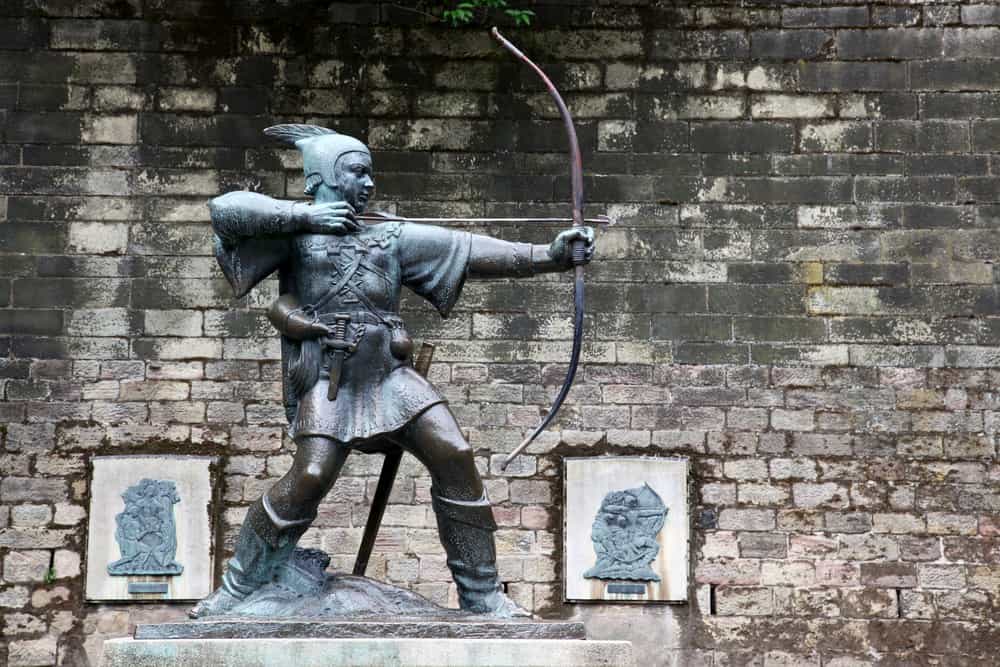
Oakham Castle
All that is left of Oakham Castle is its Great Hall which has survived from Norman times. Unlike Pevensey Castle , it was not fortunate enough to have a Roman base which could withstand the test of time. The Castle is conveniently located in the center of Oakham, the county town of Rutland, the smallest county in England.
One of the unique things about Oakham Castle is its collection of horseshoes. No one knows where this tradition started but every visiting nobleman or royal has to provide a horseshoe to hang on the wall of the Great Hall on their first visit to Oakham Castle. The oldest horseshoe belongs to Edward IV from the 15th century. There are over 200 horseshoes now including horseshoes given by Prince Charles, Queen Elizabeth II and Queen Victoria.
The Great Hall at Oakham Castle is surrounded by a large field where the Castle’s outbuildings would have stood. The defensive walls are also still in place. From the top of the hill for the wall, you have fantastic views of the surrounding countryside.
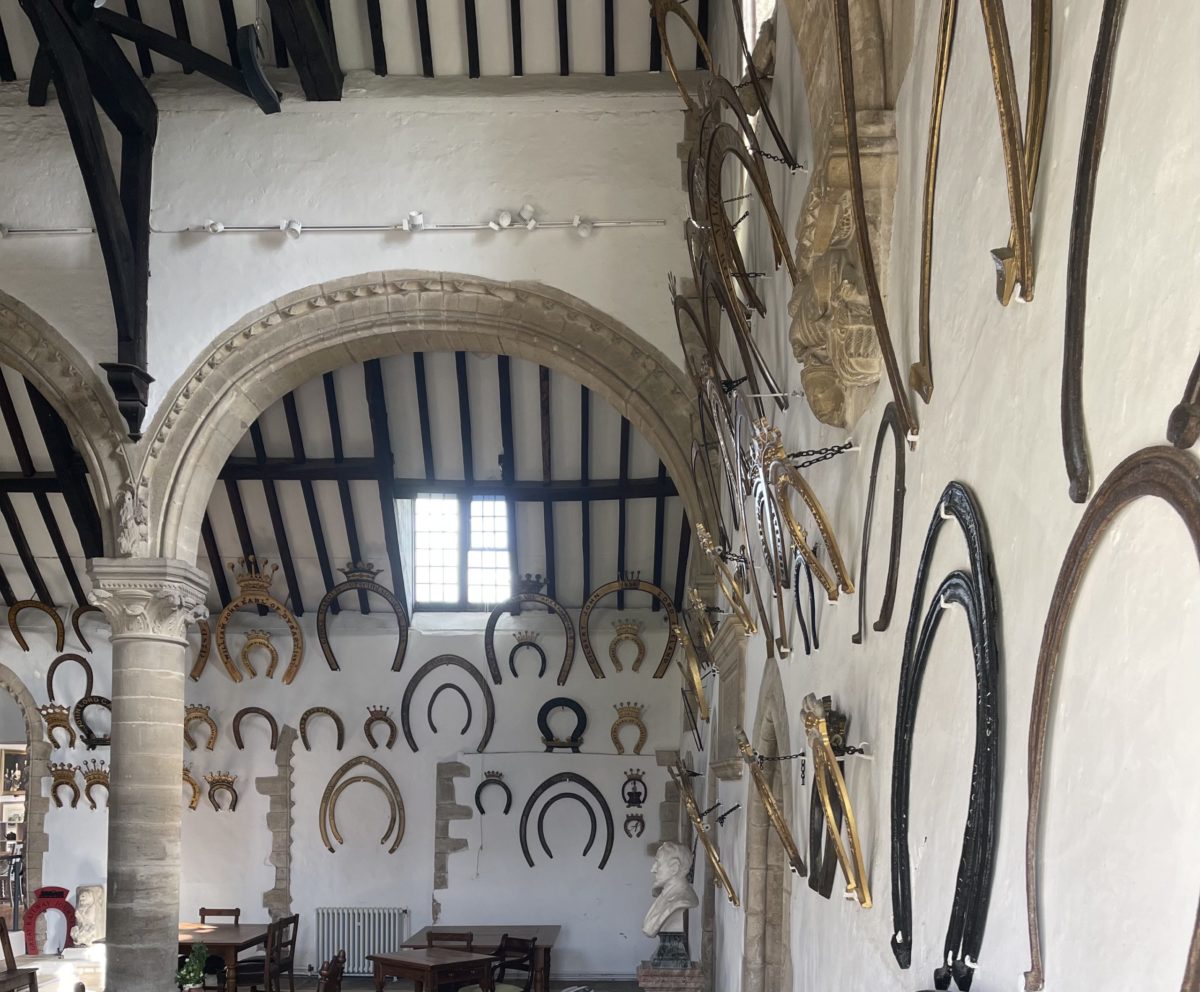
Rockingham Castle
Rockingham Castle stands on the “Rock” high above the River Welland Valley close to the border of Northamptonshire and Rutland. Rockingham Castle is a motte and bailey castle (which comes from the Norman French words for mound and enclosed land) and was built around 1070 by King William the Conqueror. Several Kings and Queens have stayed at the castle, including Richard the Lionheart, King John, and Edward I during its 900+ years. In 1544 the castle passed into private hands when Henry VIII gave Rockingham Castle to Edward Watson who turned the Castle into a family home. Since then Rockingham Castle has remained in the hands of the Watson family, undergoing many changes throughout the years, who still own it today as their private home. Rockingham Castle is open to visitors several times a year and its Civil War Themed Events are very popular. The gardens, set in 18 acres, are worth touring where a 400 year old Yew Hedge known as the “Elephant Hedge” is a prominent feature as well as seventeenth century terraces, a circular rose garden and a nineteenth century woodland garden. An interesting side trip you can make is a walk down Rockingham Hill to the village where you can see many tudor houses lining the road and even have a Pint in the 16th Century Sondes Arms Public House. – by Dave at the Silver Backpacker Beautiful castles in England to visit include Rockingham Castle, one of the castles in East Midlands (Image credit: Silver Backpacker).
Shrewsbury Castle
Shrewsbury is a very historic town in the county of Shropshire and at the heart of it is the castle. Shrewsbury castle dates back to 1067 just after the Norman conquest, thus it has quite a story to tell. The Castle is a key attraction in Shrewsbury and is one of the first thing visitors see when arriving by train or road. They built Shrewsbury castle with red sandstone on some higher ground overlooking the River Severn. Shrewsbury castle dates back to 1067 when William the Conqueror ordered it to be built. William aimed to use it as a defensive fortification and base of operations for forays into Wales. The castle is open to visitors to explore the castle grounds or visit the Shropshire Regimental museum that calls the castle home. The museum is very interesting and contains uniforms, weapons and medals relating to the regiment. In the basement, there is an exhibit is about the castle’s history which is interesting. The grounds and outer fortifications are a haven for photographers and artists, these are free to explore. However, to enter the principal building and museum costs £4.50 for adults or £2 for children. There are also lots of things to see and do in Shrewsbury , a great town if you enjoy seeing historical buildings.
– Richard Meek of RJ on Tour
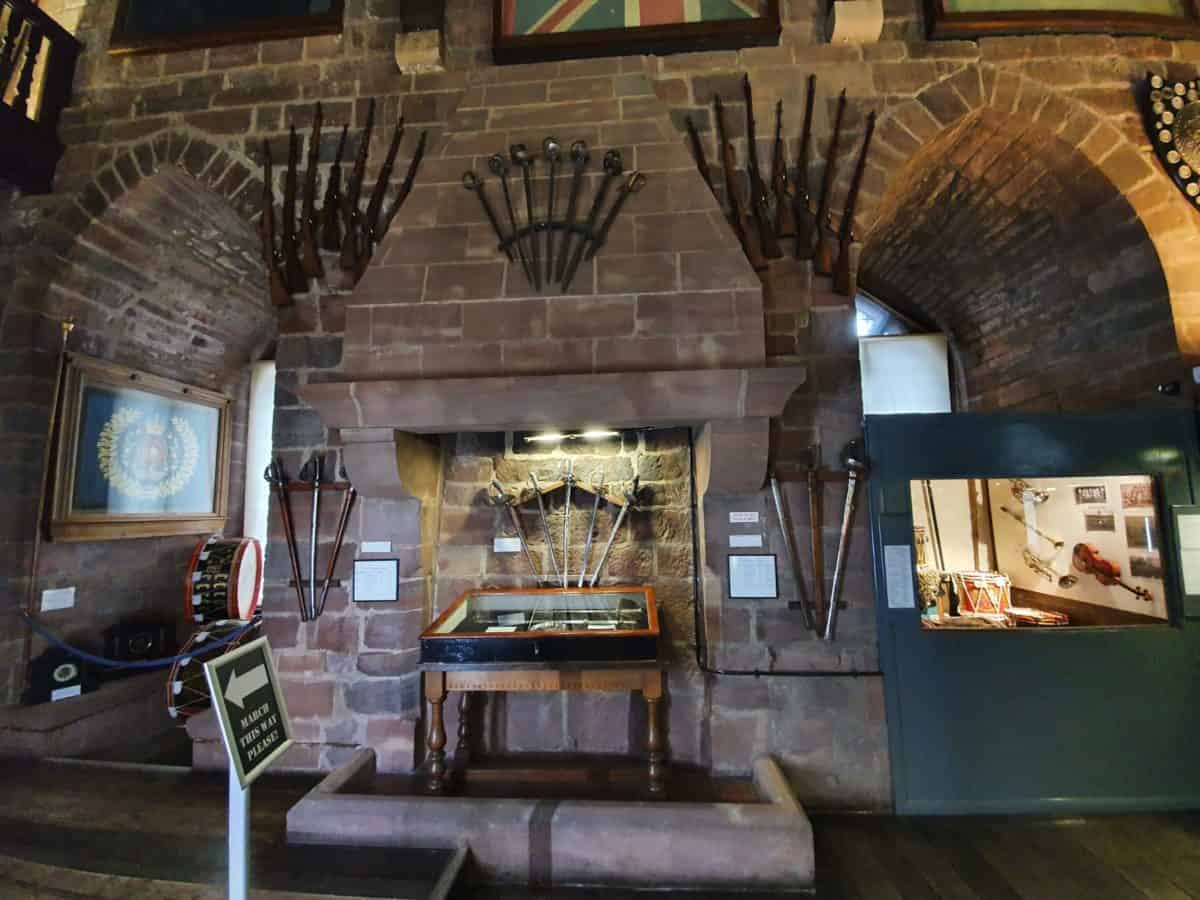
Tutbury Castle
Tutbury Castle , located in the Staffordshire countryside offers a fascinating opportunity to explore castle ruins whilst it is still being discovered. Large parts of this castle are still being unearthed, its fascinating history being pieced together, telling stories of British Kings and Queens. Following the Norman invasion Tutbury Castle was originally built in 1071. The castle later became an important medieval fortress in the rebellion against Henry II. It is currently owned by the Duchy of Lancaster. It is best known for being Mary Queen of Scots prison. She was imprisoned at Tutbury several times by Queen Elizabeth I. Its hillside location in the middle of the country far away from Scotland meant guards could easily watch for her supporters who may try to free her. The Castle is now a popular tourist attraction in the small town of Tutbury. The ruined walls are fascinating to explore and the views across the surrounding countryside to the River Dove are breathtaking. It is home to an authentic Tudor Garden and the “haunted” Great Hall. It is just £2.50 to visit and there’s a lovely tea room and bar during weekend evenings. Tutbury holds regular events such as historic re-enactments and fireworks displays and can be booked as a unique wedding venue.
– by Karen Quinn of Marvelous Middle England
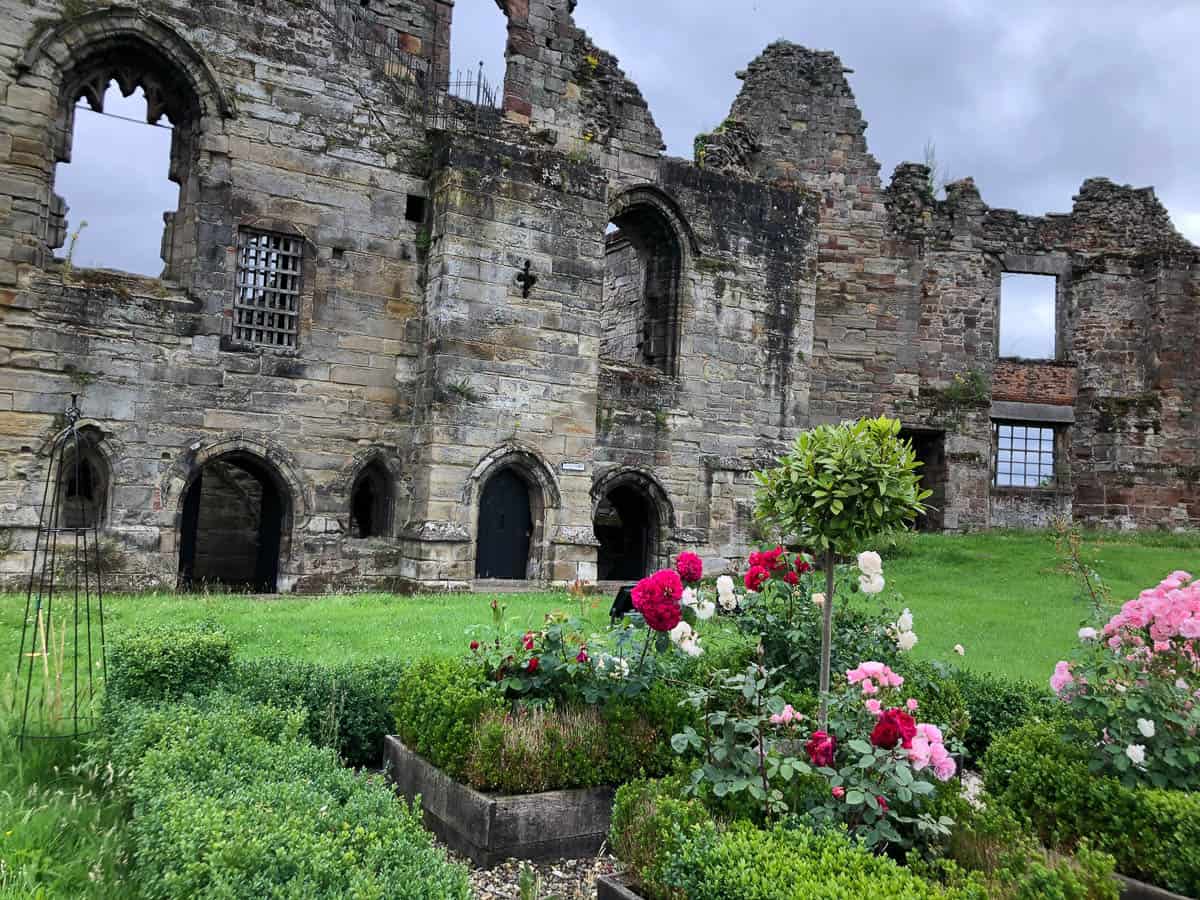
Warwick Castle
Warwick castle is a majestic English castle located along river Avon in Warwickshire. Founded by William the conquerer, the castle holds a rich thousand year history in its sleeve. Several wars have been fought around the castle. Many kings and famous people have been hosted as guests and struggled as prisoners. There are plenty of things to do inside the castle, enough to keep you occupied for a day. And if you are travelling as a family, there are interesting things to keep the kids occupied. Don’t miss out the Horrible Histories Maze, Princess tower, Trebuchet, and Castle dungeons. Explore the tower and ramparts and soak in the views from the castle. If you are travelling with a young princess, don’t forget to get the timed tickets for Princess Tower. The Trebuchet in the castle is one of the largest replica siege machines in the world. Don’t miss out the live demonstration of Trebuchet. The castle gardens are huge so be sure to picnic if the weather is good. There are also seasonal shows that run in the castle. Be sure to check their website for up-to-date information. Warwick can be explored by car or public transport. It is only 15 minutes from Stratford upon Avon and 45 minutes drive from Birmingham.
by Anuradha from Country Hopping Couple
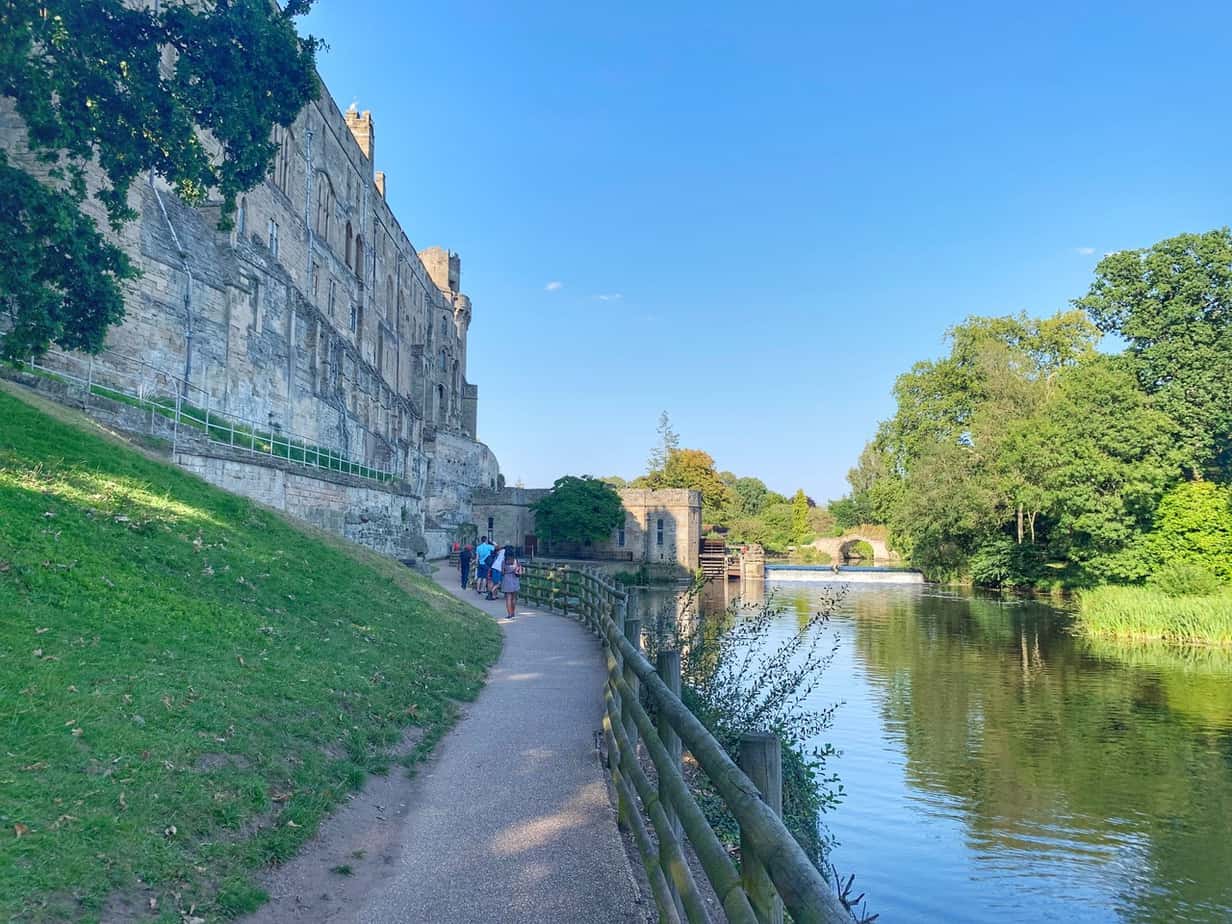
The Best Castles in Northern England
In terms of castles, Northern England seems full of them. In fact, Northumberland has the most castles of any county in England. The troublesome Scots were always raiding from across the border which explains all the castles in Northern England.
Alnwick Castle
Dating from Norman times, Alnwick Castle has been home to the Duke’s of Northumberland for the last 700 years. As England’s second largest inhabited castle (after Windsor Castle), Alnwick holds an important defensive position in the north of the country on the border with the Scots.
One of the best castles of England, Alnwick Castle rose to fame as the setting for Hogwarts on the Harry Potter movie series. Alnwick Castle has also been featured in the Downton Abbey film as well.
There is plenty to see and to do in Alnwick Castle including a large collection of Old Masters collected by the Dukes over the years. The Alnwick Castle gardens are extensive and the latest Duchess has created an intriguing Poison Garden.
Alnwick Castle is great with children too. There is broomstick training for Harry Potter fans, Peterkin the Jester demonstrates medieval comedy and Knight School for budding wannabe knights.
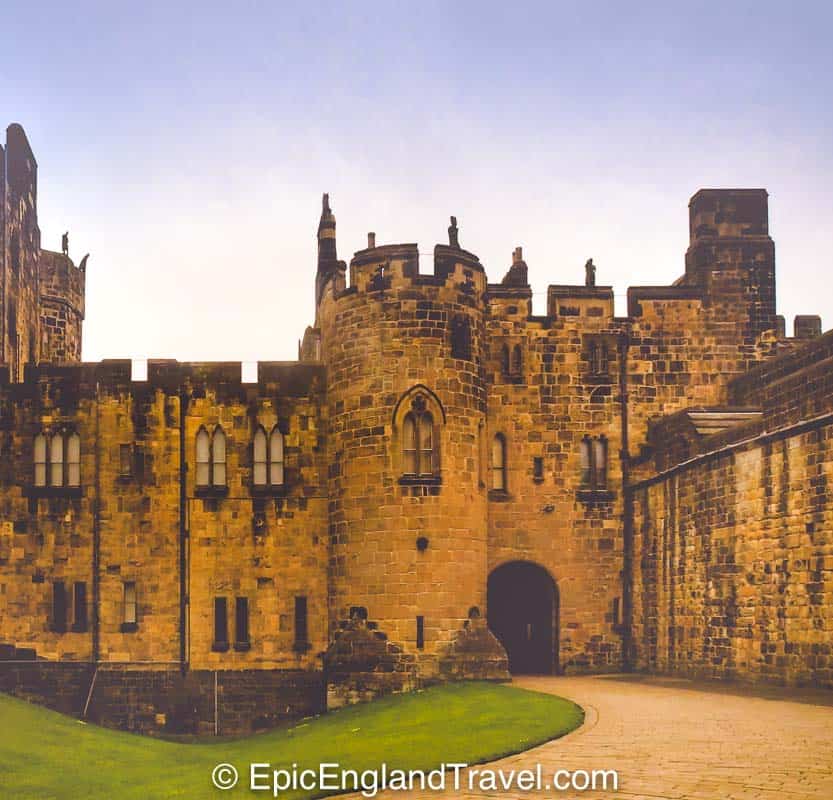
Bamburgh Castle
You really can’t miss Bamburgh Castle on Northumberland’s coast, it towers over the village of Bamburgh, holding an incredible defensive position with marvellous views to both Holy Island and the Farne Islands. There has been a defensive building here since the Celtic fort of the year 420 and today’s Grade I listed building dates from Norman times, passing eventually into the ownership of the Armstrong family in 1894 where it remains now. The castle has been used as a private residence, a free school and a pharmacy over the years and can be seen for miles around. There’s a lot to see within Bamburgh Castle and you should plan a full day to visit, have lunch at the café or bring a picnic, there’s lots of space here to enjoy the magnificent views from the walls and gardens. There are even apartments that can be rented as holiday lets. Tickets to Bamburgh Castle cover access to all the open areas and there are fabulous activities for families during school holidays and weekends too. The State Rooms are particularly beautiful and kids will have great fun dressing up in the armour and chain mail. A visit to Bamburgh Castle is one of the top things to do in Northumberland , England’s most northerly county and shouldn’t be missed!
– by Sarah Carter at A Social Nomad
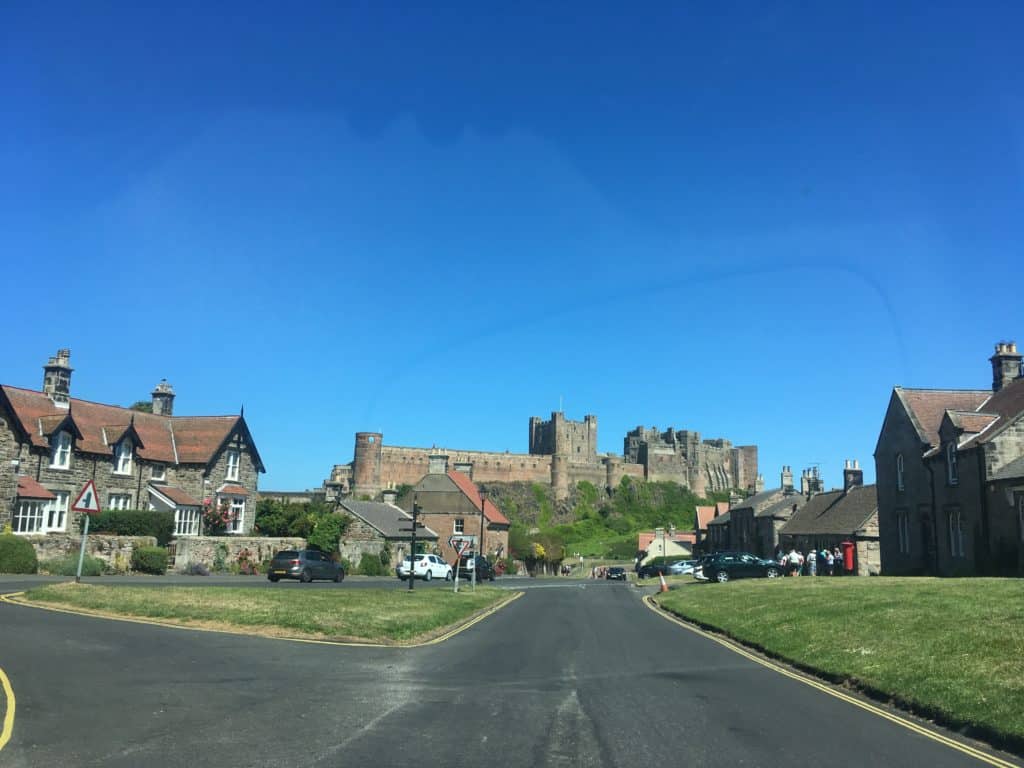
Chillingham Castle
Dating back to the 12 th century, Chillingham Castle in the North of England was initially built as a monastery. It is still owned by descendants of the Chillingham family.
It was used as a fortress for English armies during the England and Scotland border wars. Plenty of captured soldiers were kept and tortured in the dungeons and are said to have never left. Chillingham Castle is notorious for being the most haunted castle in England .
Now, parts of Chillingham Castle England are open to the public for tours. The tours include a display medieval torture instruments. It’s also possible to spend the night in one of the eight en-suite rooms located inside the castle.
We took a ghost tour of Chillingham Castle and sadly did not encounter any paranormal phenomena.
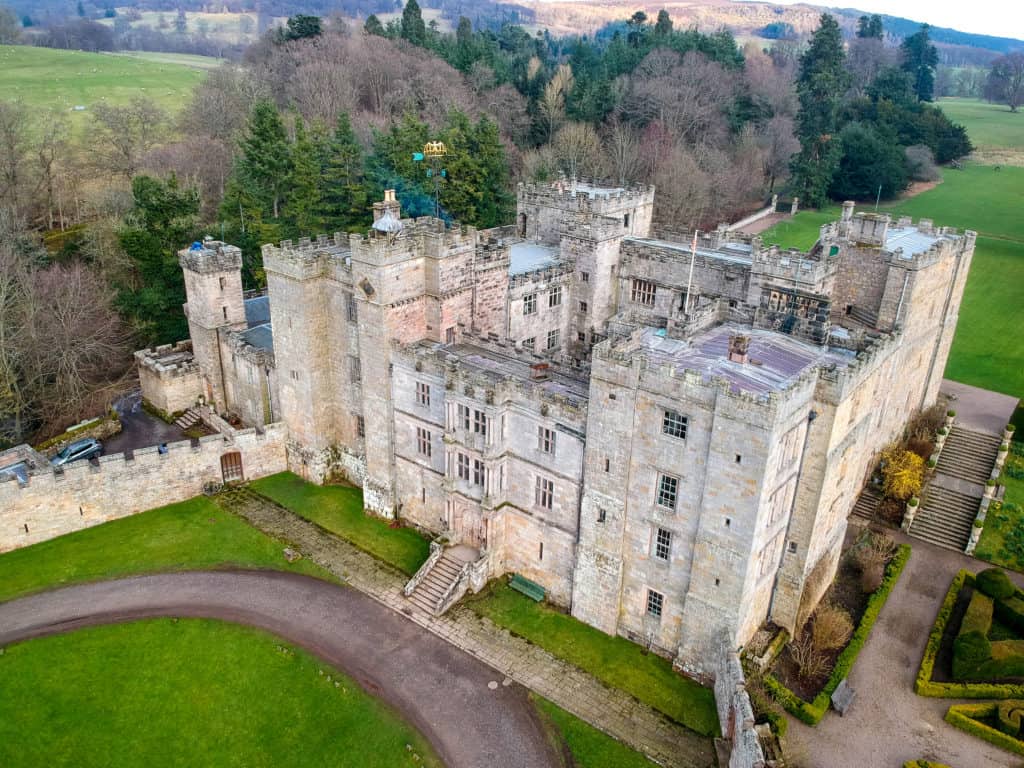
Dunstanburgh Castle
The ruins of Dunstanburgh Castle are managed by the National Trust. Built in the 14th century, Dunstanburgh was built to show off positively in comparison to nearby Bamburgh Castle.
Dunstanburgh Castle was strategically important during the War of the Roses of the 15th century. The castle never recovered from these battles and fell into disrepair. When the Scottish and English thrones merged, the importance of castles in Northern England fell away.
The ruins of this most beautiful castle in England, standing in its isolated grandeur on a cliff overlooking the North Sea, attracted artists to feature it in their works. J.M.W. Turner featured Dunstanburgh Castle heavily in his works.
You can visit the ruins of Dunstanburgh Castle by a 1.5 mile coastal walk from nearby Craster. Alnwick Castle is a mere 8 miles away.
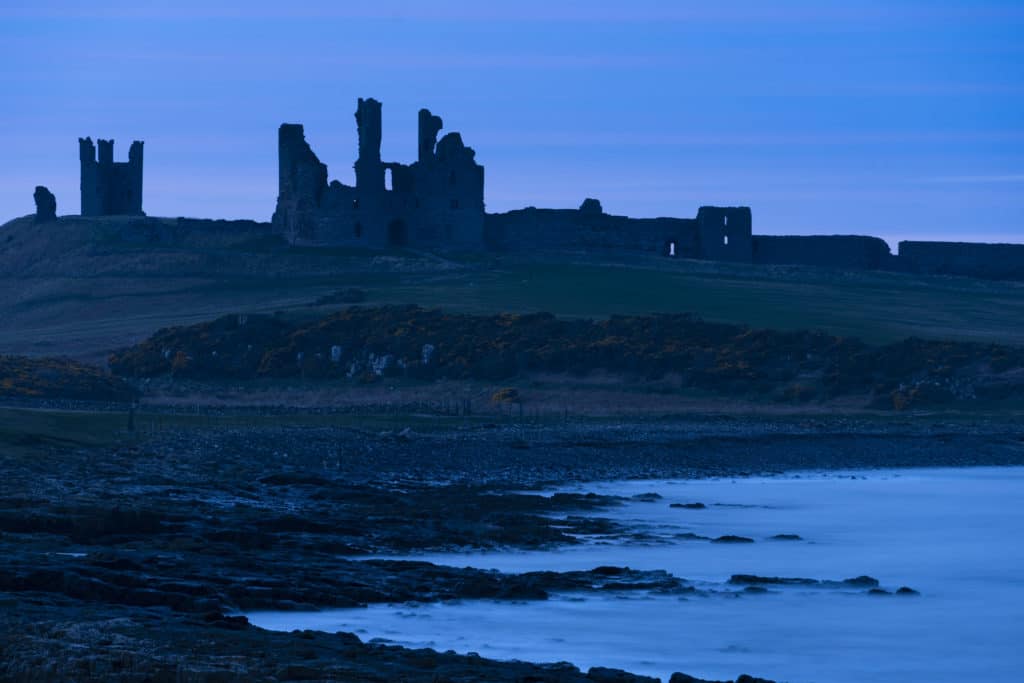
Durham Castle
The city of Durham is about 220 kilometers away from Edinburgh and merely 30 kilometres away from Newcastle upon Tyne. It is a university city with historic Romanesque features in England that may not be known to a lot of tourists. However, Durham is perfect for a day trip from Edinburgh or Newcastle upon Tyne. Take a train in the Waverley Station getting there from Edinburgh, trains depart every hour and the journey takes about two hours. The city’s skyline is defined by the striking Durham Cathedral, which has a history of over one thousand years. Together with the Durham Castle on the opposite side, these UNESCO World Heritage Site are open to the public for free unless they are used for ceremonies and events, including the congregation of Durham University. The Durham Castle is a Norman castle dated back to the year 1072; it was previously the residence of the Bishops of Durham, and a fine example of Norman architecture of citadel – round arches and massive proportions. Today, the castle served as a museum, and part of Durham University’s campus and dormitory, which visitors may take a guided tour to see the chapels and halls. – by Kenny Chow of Knycx Journeying Durham Castle, one of the best castles of England to visit (Image credit: Kenny Chow)
Raby Castle
Raby Castle, one of the most beautiful castles in England, has a picture perfect setting among a couple of hundred acres of deer park near Durham England. The castle is still privately owned by the Barons Barnard.
Raby Castle has a famous collection of paintings, including Old Masters, that have been collected by the owners. For children, there is a woodland adventure playground as well as special events, like open air cinemas and theatre, that are held at Raby Castle.
Raby Castle has appeared on film inthe 1999 Oscar-winning movie Elizabeth and the television drama series, Victoria .
Raby Castle is only open to the public during the summer. You can visit on your own or through a guided tour. The gardens are extensive with both a walled garden and a kitchen garden. You can rent bikes to pedal through the parkland to see the deer up close.
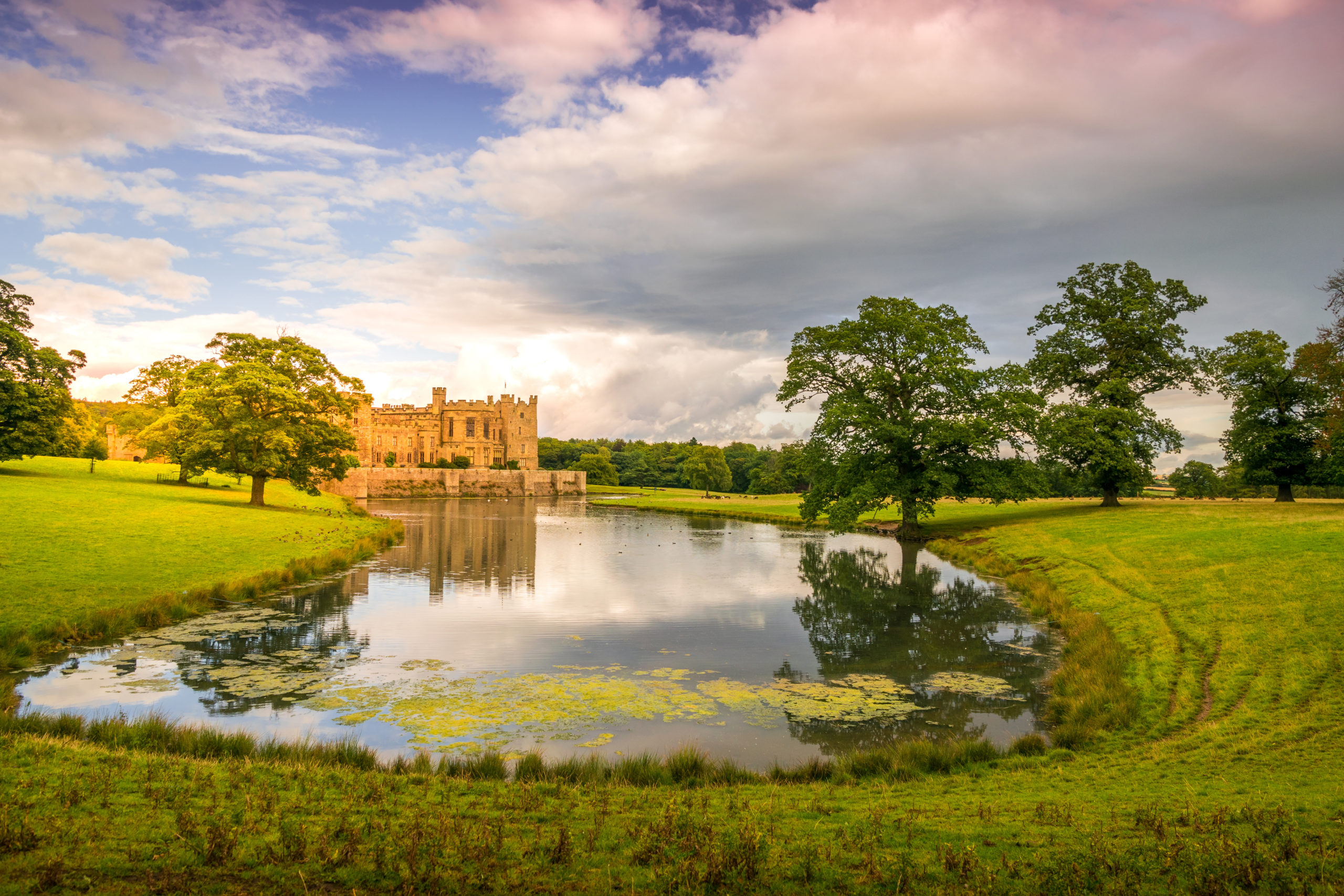
Ripley Castle
Ripley Castle, a 14th century castle located near Harrogate and the Yorkshire Dales, has been owned by the Barons Ingilby for 7 centuries. That’s 26 generations of the family that have called this place home!
Ripley Castle is open to the public for guided tours including a special children’s guided tour geared towards making a castle tour fun. It’s one of the castles in the best castles in England if you want to see a priest’s hiding hole.
The castle grounds are extensive and include various gardens like a walled garden and hothouses for a tropical garden. Ripley Castle puts on special events like the House & Garden Fair and outdoor concerts. The castle grounds are home to the national Hyacinth collection.
The grounds are also great for kids because there are a lot of outdoor activities available, such as archery and kayaking. The park walk is beautiful and includes deer (naturally) and an ornamental lake.
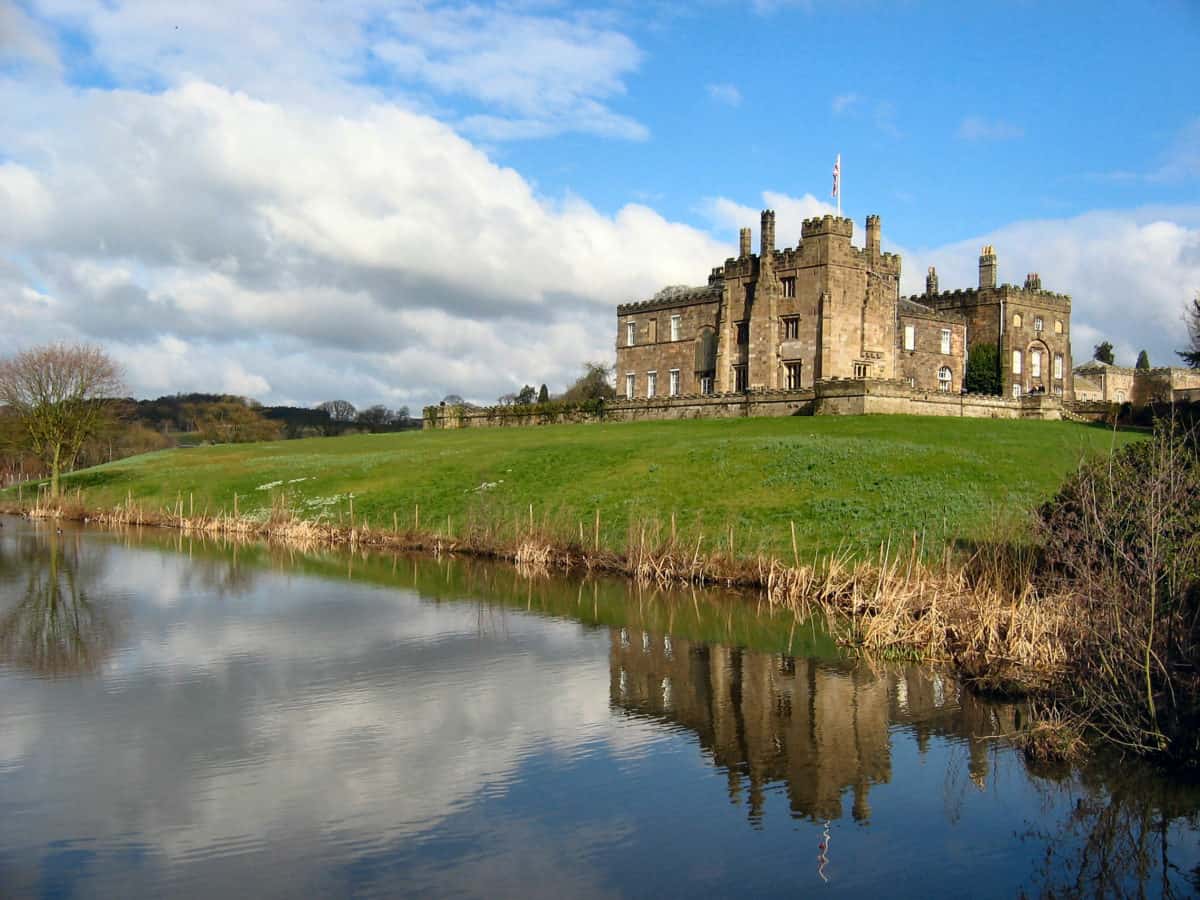
Skipton Castle
The Yorkshire market town of Skipton isn’t necessarily the first place you would think of when considering grand castles in England. And granted, Skipton’s offering is more about functionality rather than finery, but it is definitely not one to overlook. At over 900 years old, Skipton Castle is one of the best-preserved medieval castles in England. On your visit, you will have a unique opportunity to explore the whole castle from top to bottom. Some notable highlights include the grand Banqueting Hall, the impressive Bedchamber, and the depths of the dungeon. Your tour is self-guided using a comprehensive information sheet, which is available in 10 different languages. Along the journey, you will discover how Skipton Castle was able to survive a three-year siege during the Civil War. You can also admire the pretty yew tree in the courtyard that was planted in 1659 to celebrate the restoration of the castle. To make the most of your visit to Skipton, you will also want to spend some time exploring the quaint market town. It is full of independent stores and a bustling market feel. You can also explore Skipton Castle Woods, a 36-acre ancient woodland, now maintained by the Woodland Trust. – by Hannah Ackroyd of Get Lost Travel Blog
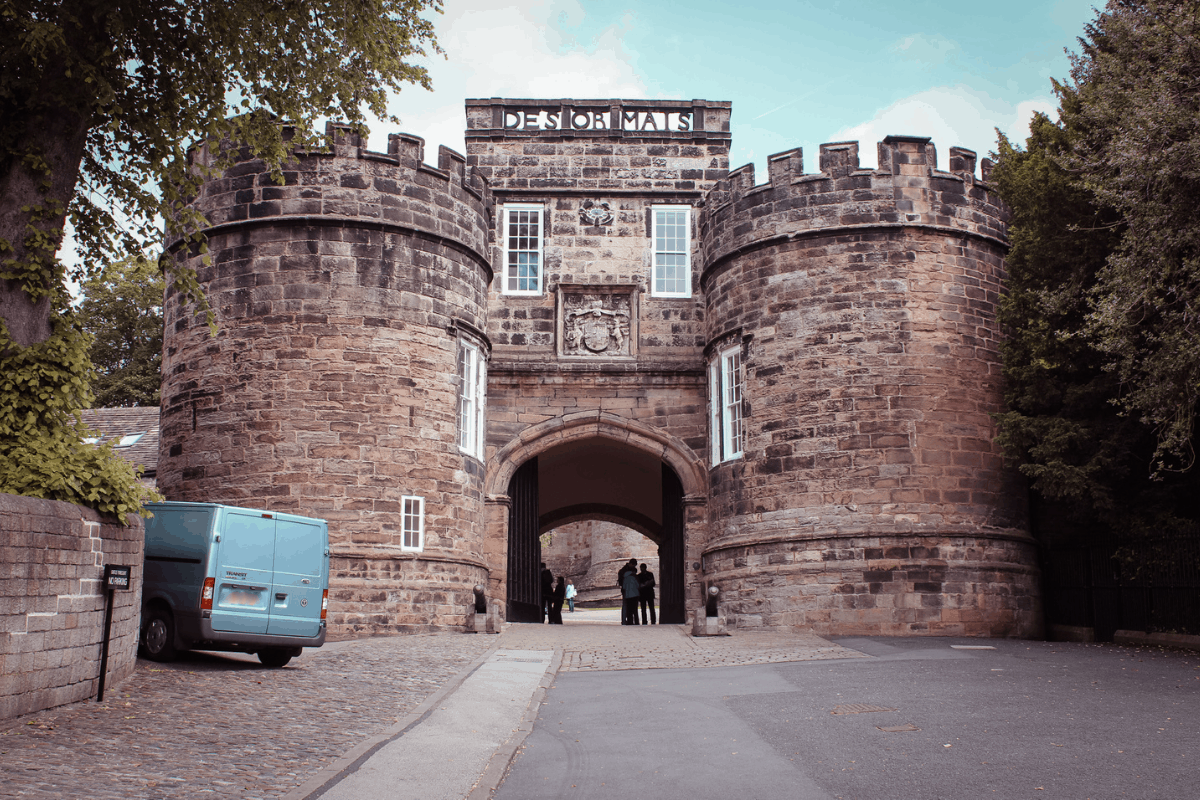
Spofforth Castle
Spofforth Castle was once the seat of the prominent Percy family who now have a seat at Alnwick Castle further north in Northumberland. Although riginally constructed in the 11th century, the ruins seen today date back only to renovations done in the 14th and 15th-century.
Entry to the ruins of Spofforth is free. Spofforth Castle has an important backstory since it is where the rebel barons met to write the Magna Carta, a charter of rights for the nobles that has become an important part of the British constitution. The barons then went south to meet King John at Runnymede to force his hand.
Any castle ruins this old is bound to have a ghost story or two. People have reported seeing the figure of a phantom woman throwing herself from the ramparts in despair.
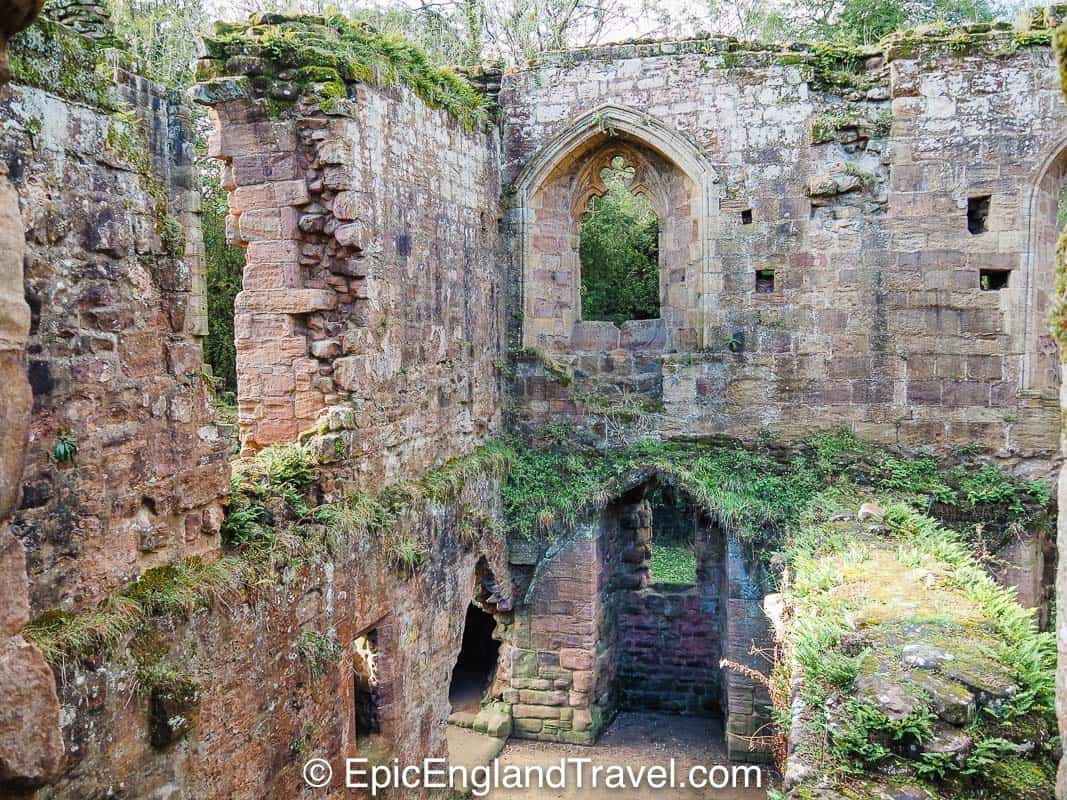
Wray Castle
Despite its name, Wray Castle is not actually a castle. It is a private home that was built in the Gothic Revival Style in 1840 along the shores of Lake Windermere in Low Wray, England. Wray Castle is possibly most famous as the holiday and summer home of Beatrix Potter, the author of “The Tale of Peter Rabbit.” Visitors can explore Wray Castle’s elaborate hall, private rooms, towers, turrets, and more. While none of the original furniture remains, many photos of the original home are prominently displayed. The castle also has mock ruins, hidden doors, and the Peter Rabbit Adventure to explore. Outside, visitors can enjoy a pleasant walk along the shore of Lake Windermere. There is also a cafe on-site, with large grounds and gardens to explore while enjoying a treat. The Castle is easily accessible via car from the nearby town of Ambleside. Parking at Wray Castle ranges from £5 (6.94 USD) for two hours up to £7.5 ($10.41 USD) for four or more hours. Visitors can take a fifteen cruise from Waterhead Pier, just outside Ambleside. Note: because of COVID-19, there are limited cruises being offered. It would be best to check what cruises are available while planning your trip. Visiting the grounds outside Wray Castle is free, with pets welcome to explore the area. Entrance to the Castle will cost you £10.40 ($14.45 USD) for adults and £5.20 ($7.22) for children. Wray Castle offers a group discount for groups of at least fifteen people. The most popular time to visit Wray Castle is during the summer. The warm evenings make watching the sunset nearly magical. Wray Castle is open year-round and hosts several seasonal events. No matter when you visit, Wray Castle is a destination not to be missed. – by Catalin Geangos from Travel Trained
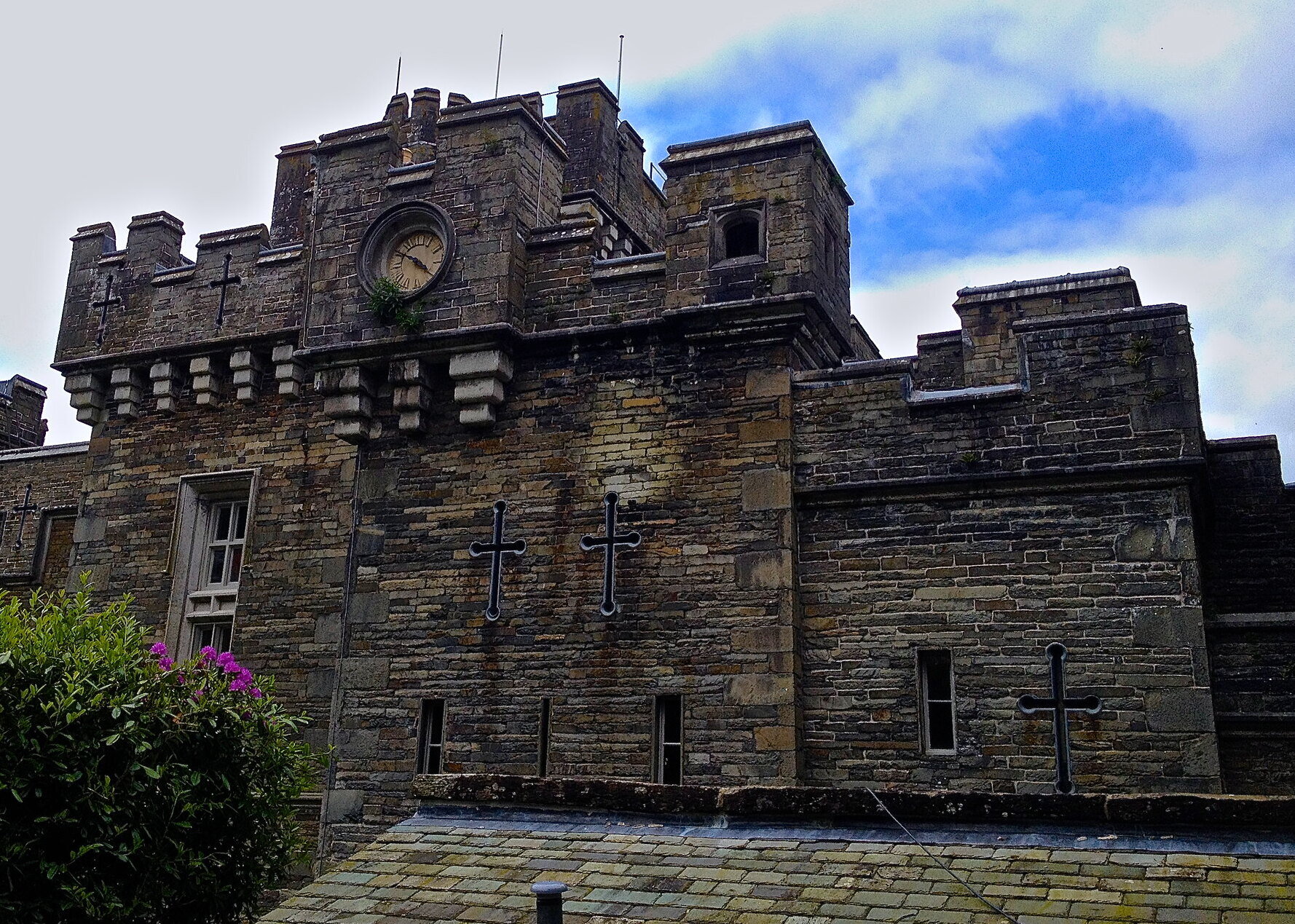
The Best Castles of Southern England
There’s a variety of castles in Southern England to visit from the haunted ruins of Berry Pomeroy Castle in Devon to the world class art contained at Longford Castle in Wiltshire. Then there are the castles in Southwest England that are tied to legend (Tintagel Castle) or located on their own island (Mount Saint Michael).
Berry Pomeroy Castle
Although maintained by English Heritage, Berry Pomeroy is still owned by the Dukes of Somerset.
Berry Pomeroy Castle was built in the 15th century to keep order in the area because Devon at the time was hotbed of unrest.
The Pomeroy sold it to the Seymours (the Dukes of Somerset) eventually. The Duke of Somerset was the Lord Protector for England because his nephew, Henry VIII’s son, Edward VI, was still a young boy. The Seymours kept enlarging it because they wanted to show their wealth and power. Then the Seymours abandoned Berry Pomeroy without actually finishing it.
Berry Pomeroy was a favourite of the Victorians who loved their romantic ruined castles. Lots of ghost stories were promoted about Berry Pomeroy Castle which still lead people to believe that it is haunted today.
Berry Pomeroy is a short distance from both Dartmouth Castle and Totnes Castle. The castle ruins are cool and the grounds are great for exploring.
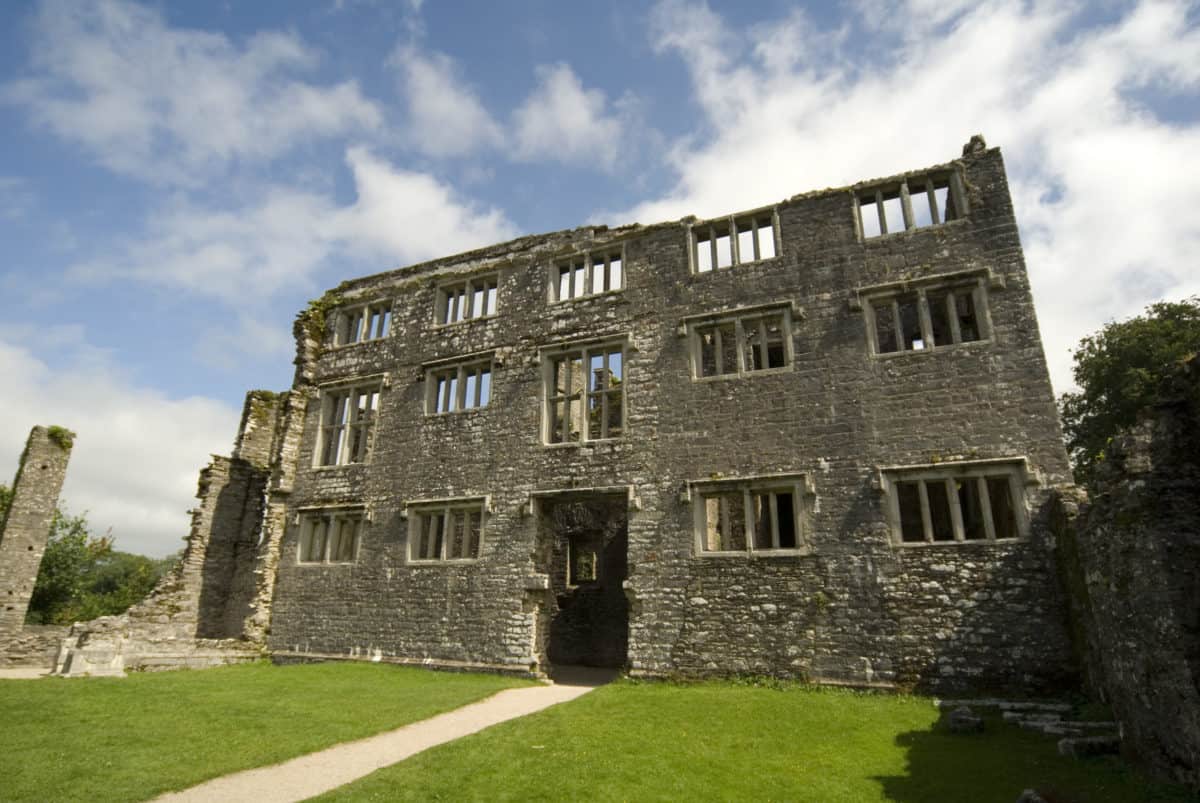
Carisbrooke Castle
If you’re looking for the best castles in England you can’t miss Carisbrooke Castle on the Isle of Wight. This evocative stone building has had various uses through the centuries, from fortress, a king’s prison right through to a royal summer retreat. Carisbrooke has been a key building on the Isle of Wight for over 1000 years. It’s probably most famous for being the prison of Charles I who was held here during the Civil War before being taken back to the mainland for his execution. Charles I attempted to escape from the castle but wasn’t able to get through the bars. It’s very atmospheric to see where he would have been held and how desperate he must have felt. Today you can have a picnic on his bowling green which he had constructed. If you’re visiting on a family holiday to the Isle of Wight , the castle put on lots of events which kids will love. Visitors of all ages will enjoy winding their way through the rooms and discovering history through the ages in the various quarters. Walk along the battlements for some of the best views of the Isle of Wight. Carisbrooke also have a relatively new garden designed by the award winning garden designer Chris Beardhsaw, the Princess Beatrice Garden which is inspired by Edwardian times. So even today it is evolving and giving so much pleasure to countless visitors.
– by Nichola West at Globalmouse Travels
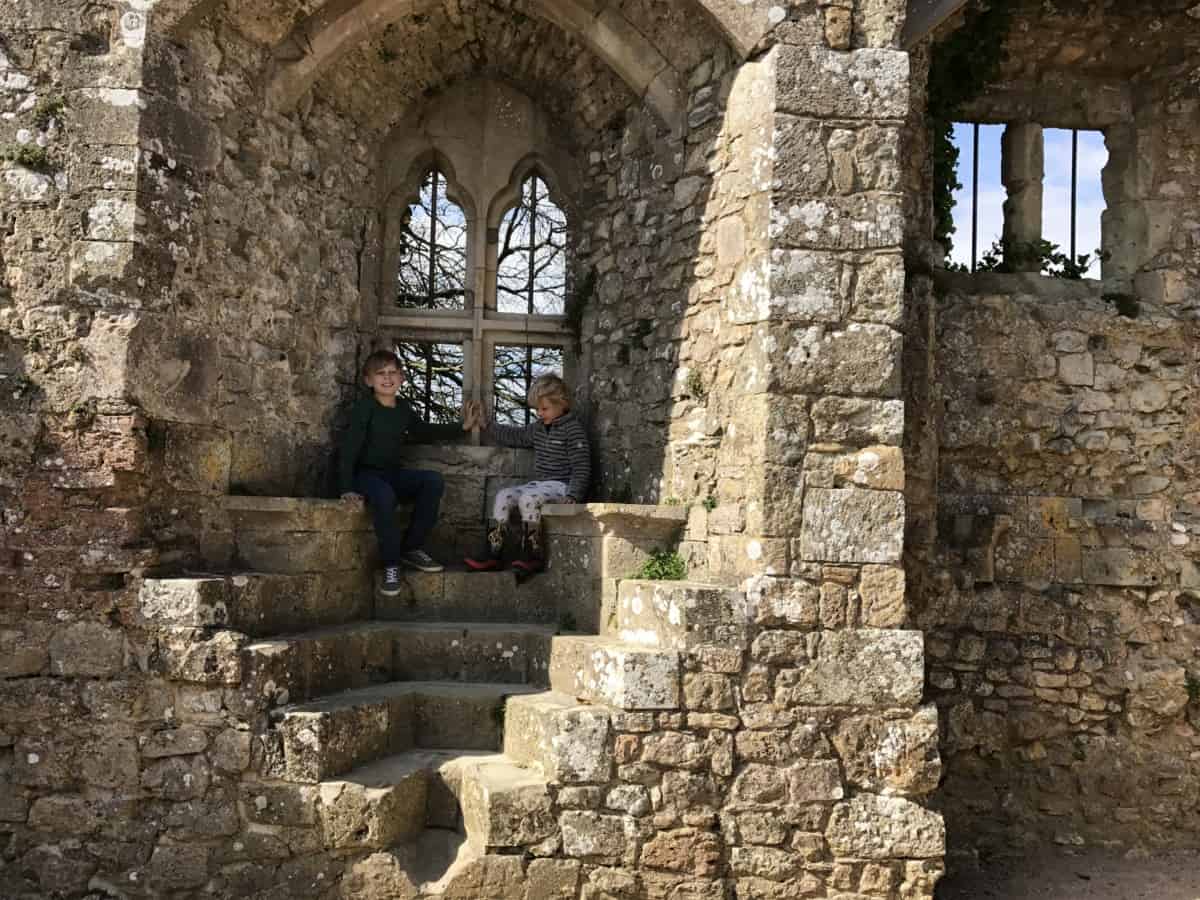
Corfe Castle
Built in the 11th century by William the Conqueror, Corfe castle is one of the most beautiful castles in England. Located in the stunning Dorset countryside, this picturesque castle is part of the Purbeck Heritage Coast. Once upon a time, this castle stood at the top of the hill as a sturdy fort, yet now only ruins remain. However, these ruins are some of the most beautiful castle ruins around, making this site one of the most visited historic structures in the whole of England. With over a thousand years of history, this castle is an epic day out for everyone. From children to adults everyone can enjoy the unique history lesson as well as the incredible scenery. We advise that the best way to visit Corfe castle is by staying at one of the quaint campsites in Swanage and taking the steam train to the castle. The heritage railway at Swanage is one of the most popular heritage railways in Britain, with trains running every day between April and October. You will love arriving at the train station in Corfe as it is a postcard-perfect station with magnificent views of the castle and takes just 22 minutes to get to from Swanage station. – by Breanne Fleat of Family Camping Europe
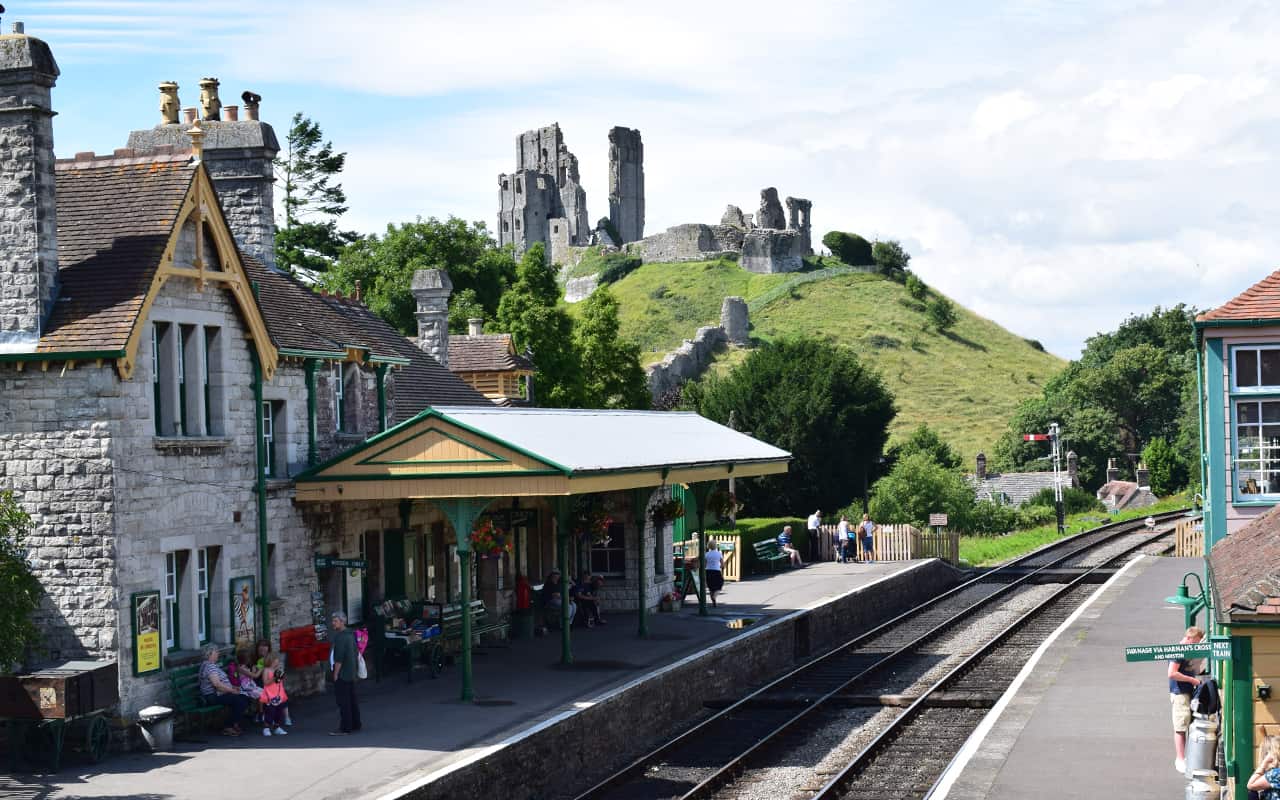
Dartmouth Castle
The salty remains of Dartmouth Castle cling to the cliffs above the entrance to the River Dart in South Devon. Unlike many English castles, it has never been home to kings or courtiers. But since the 14th Century it has played an important role in protecting the nearby port of Dartmouth. French raids were common in the area, so over the centuries towers and batteries were added to the fortifications, giving the guns longer range into the English Channel. A chain could also be drawn across the river mouth between Dartmouth Castle and Kingswear to stop unwelcome vessels entering. Today you can visit the castle’s battery, casemates and gun tower where troops were stationed periodically right up until the Second World War. It’s also fascinating to wander around the gravestones of St Petrox Church, which has stood in the same location for nearly 200 years longer than the castle. One of this castle’s very best features are the panoramic views over the sea and down the River. Stand on the top of the gun tower and you’ll be able to see the Britannia Royal Naval College perched on the hill above Dartmouth and the comings and goings of hundreds of sailing boats. – by Claire Hall of Devon with Kids
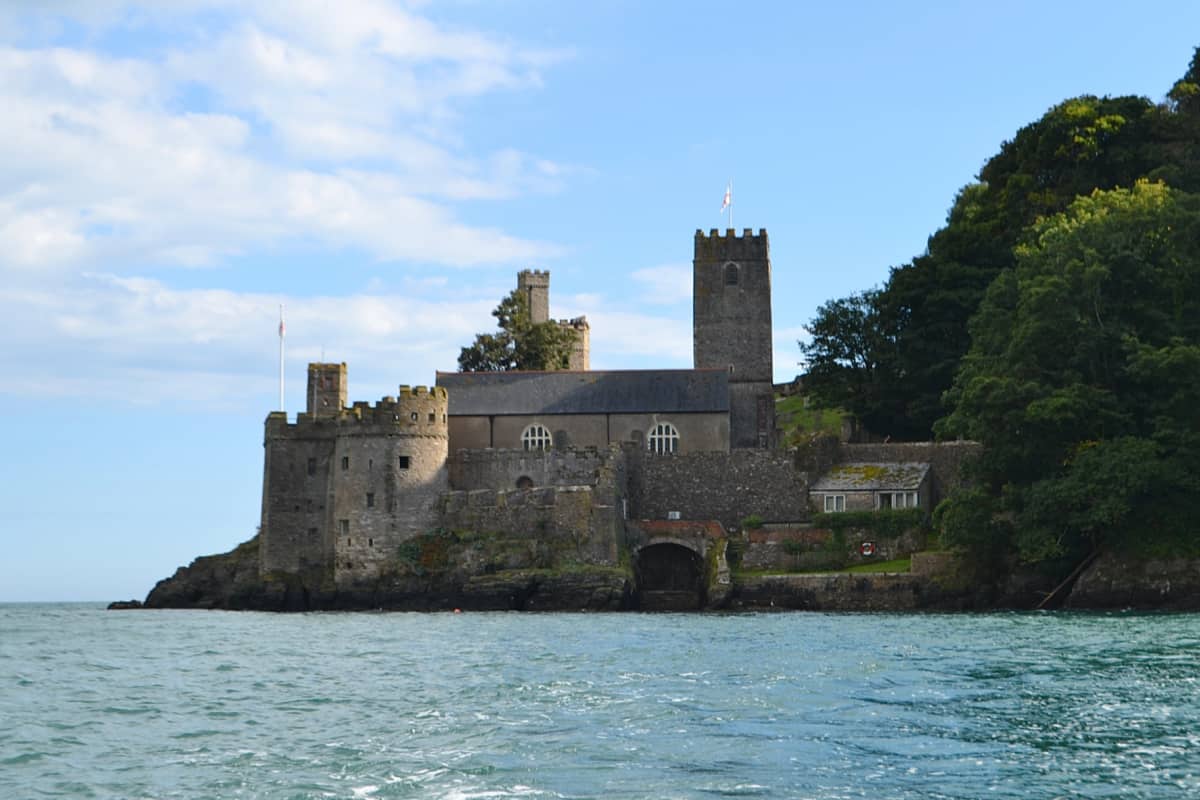
Longford Castle
Salisbury is the perfect city to see an amazing English estate. It is the perfect English city and offers everything you’d expect from a travellers imagination from middle class town market to world class sites like the Salisbury Cathedral and Stonehenge as well as the spectacular Longford Castle. To get here, takes a quick 2 hour train ride from London Waterloo or Clapham Junction stations on South Western Railways. The best part is Salisbury is the beautiful Longford Castle. It is the same castle that is shown as the Castle of fictional Genovia in Princess Diaries movies. In reality, however, it is the seat of the Earl of Radnor. It is one of the most beautiful castles in England and definitely worth a visit. It is built in a hexagonal shape with all towers linked to each other. The gardens around the castle are vast and beautiful and perfect for a summer picnic or an evening stroll. If you want to visit the castle you must book it in advance though through their website and the tours happen only 28 days a year. – by Ucman Scher of Brown Boy Travels Longford Castle is one of the best castles of Southern England thanks to its important art collection, some of which is on loan to the National Gallery in London. (Image credit: Ucman Scher)
Powderham Castle
One of the beautiful castles in England, Powderham Castle, has been owned by the same family for hundreds of years. Lying near Exeter in Devon, Powderham Castle was built in the 14th century.
Powderham started off as a fortified manor house and got upgraded to the castle designation in the 17th century. It’s still missing elements that would make it a proper castle like a moat even though castle-like elements were added in the 19th century.
There are plenty of things to do in Powderham Castle. You can take tours of the castle interiors, and visit the gardens. There are guided tours of the gardens or alternatively, just go on a ramble of the grounds. Among the gardens to see are the walled garden, the American garden, the rose garden and the secret garden. The Belvedere Tower on the grounds, formerly used as a ballroom, gives great views over the countryside.
You may recognise Powderham Castle from the 1993 movie, The Remains of the Day .
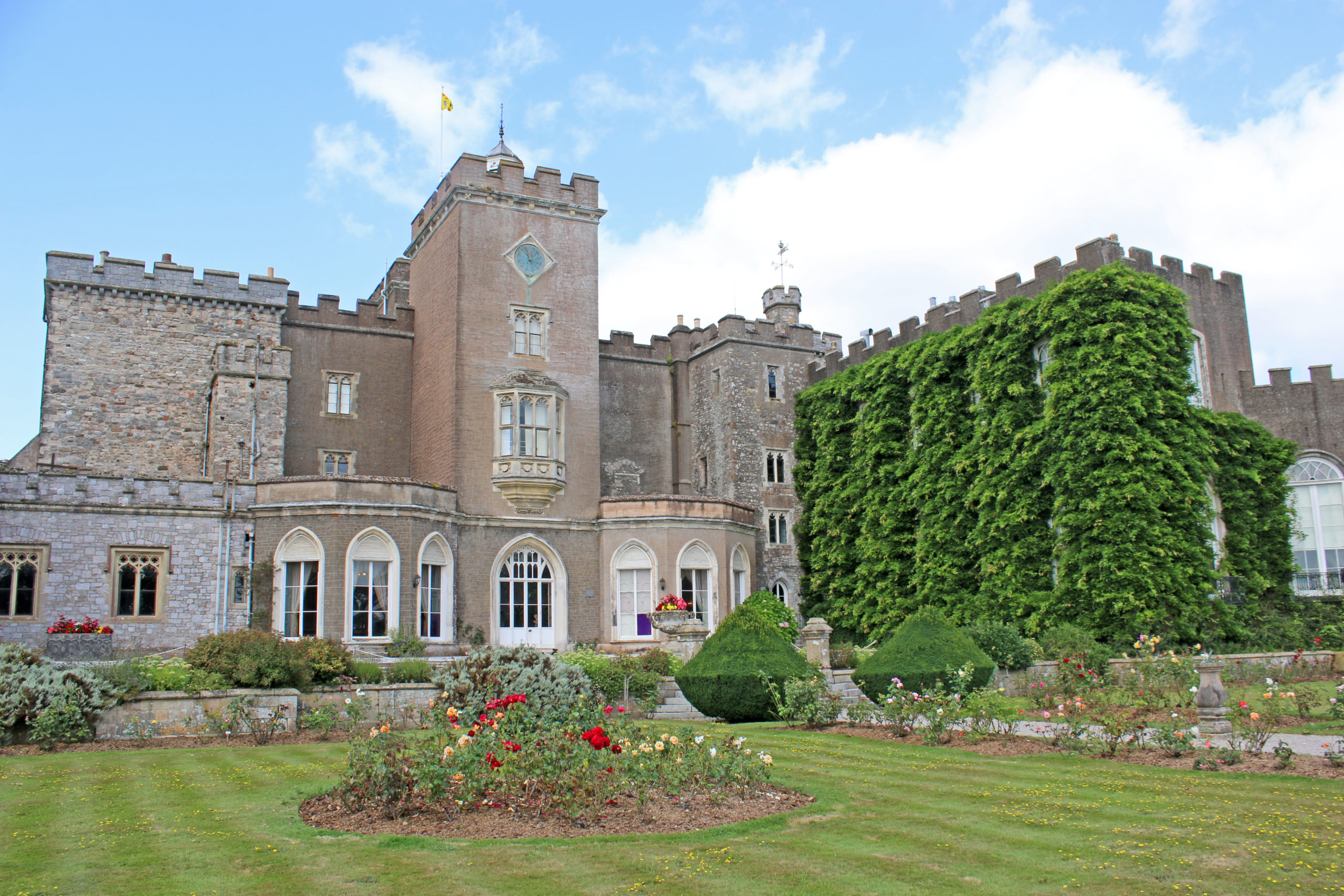
Saint Michaels Mount
Saint Michael’s Mount located in Cornwall, is one of the rare tidal islands in the U.K. that you can get to via a short walk. When the tide is high, the island sits detached from land, in the middle of the sea and is inaccessible. Located in Mount’s Bay near Marazion in Cornwall, the pathway to get to the island is actually man-made and can be used when the tide is low. The island is managed by the National Trust and contains a castle, chapel, and gardens. St. Michaels Mount, which looks quite similar to the Mont-Saint-Michel in Normandy, France, is actually its cornish equivalent. Legend has it that the castle here was home to Cormoran the giant, of Jack the giant slayer fame. Till date, some believe that the boulders and scattered tree trunks around are due to the giant! Currently owned by the St Aubyn family, the castle has quirky items scattered all over. There’s a clock that tells the time of the tide as well as the time of day, a piece of Napoleon’s coat which he wore at the battle of Waterloo and even a mummified cat! It is also believed that St. Michaels Mount is haunted so if you like such places, the legend, history and all the mystery make it a must visit!
– by Lavinia Dsouza at Continent Hop
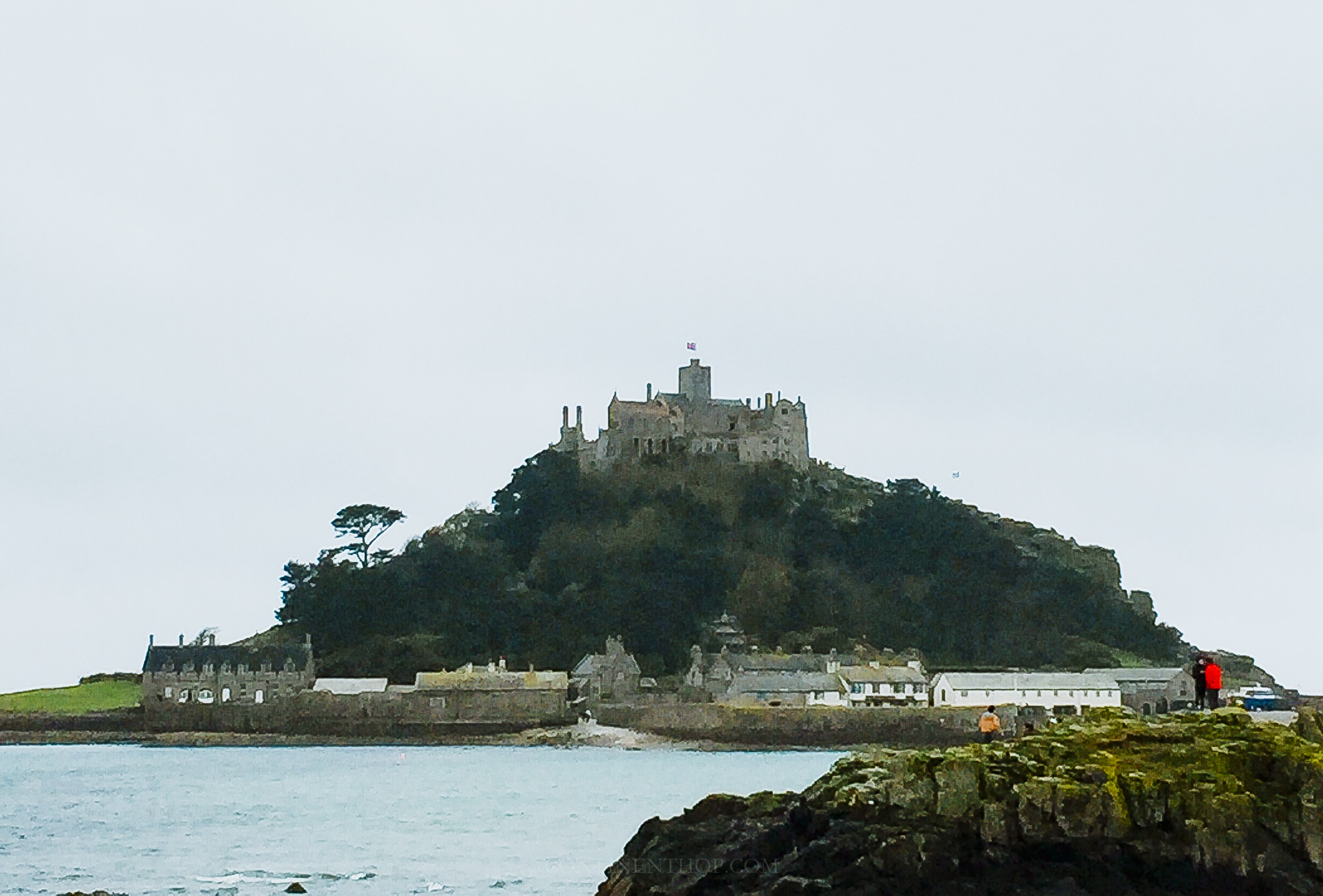
Sudeley Castle
Sudeley Castle is a beautiful attraction in the Cotswolds AONB in England. Located near the village of Winchcombe, Sudeley Castle is a great place to spend a few hours while in the area. The history of the castle dates back to the 15th century and is associated with King Edward IV, King Richard III and King Henry VIII, and is also the burial place of a queen. The long and trembling history of the place is explained in detail in the indoor exhibition, while the Castle Rooms present an extensive collection of art pieces and other objects. Outdoors, visitors to the castle will be able to enjoy a large area of green space, featuring several gardens with various flower collections. Wander in the White Garden, the Secret Garden or even the Ruins Garden that is created around the remains of an old section of the castle. Nested in the gardens, you will find St Mary’s church. It is a small church that was hugely destroyed during the Civil War and it was restored in the 19th century. Bird enthusiasts will be able to find more than ten species of pheasants, many of which are globally endangered in the outdoor pheasantry. The easiest way to reach Sudeley Castle is by car; however, it is still possible to visit it using public transport. To do so, you need to take the train or bus to Cheltenham Spa, and from there you need to take bus W to Winchcombe. The castle is about 15 minutes on foot from there.
– by Elina Michaelidou at Empnefsys & Travel
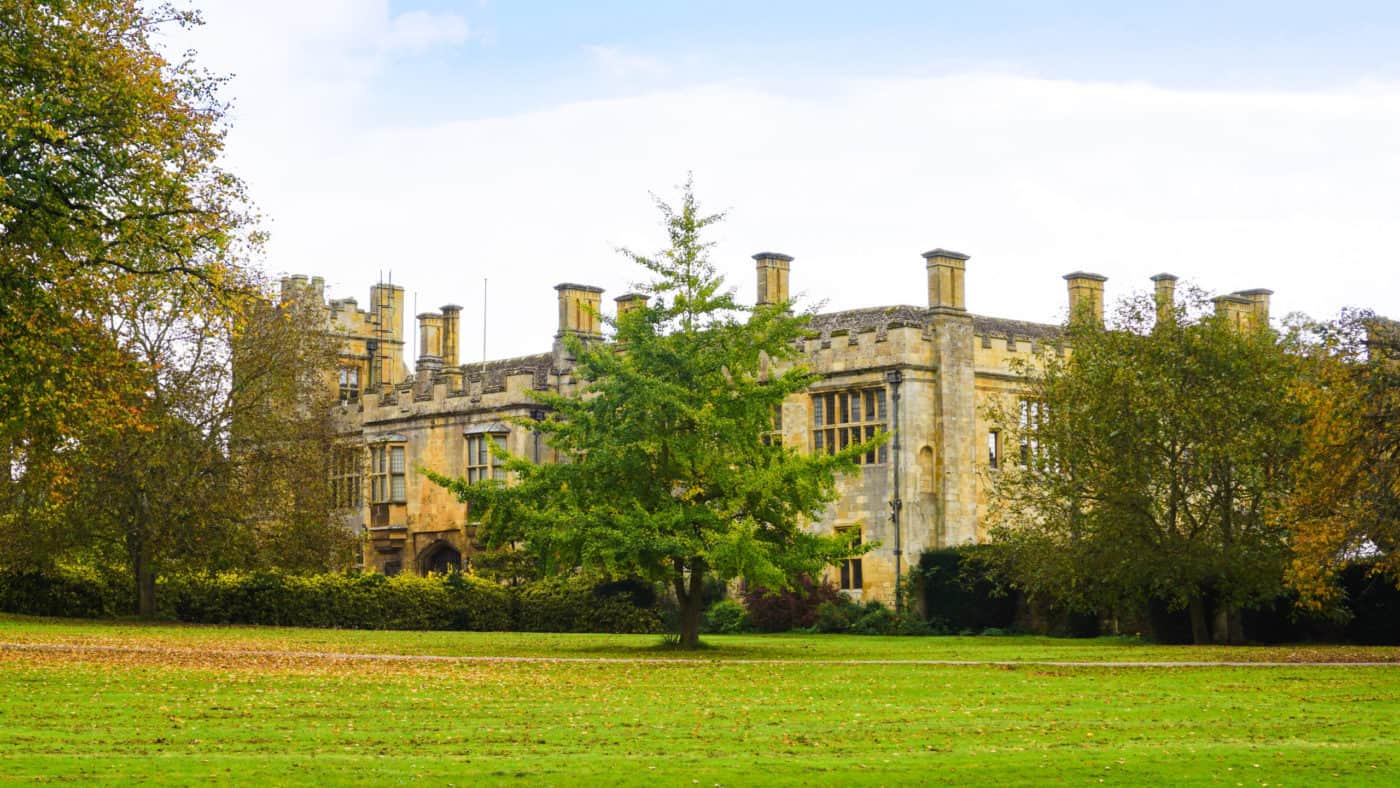
Tintagel Castle
There is something magical and evocative about the medieval fortification that is Tintagel Castle . Set on Cornwall’s rugged north coast, the ruined Tintagel Castle is managed by English Heritage and has been open to tourists since the middle of 19th century. Built in 1233 by Earl Richard, the castle is prominently known for its connection to the legendary King Arthur. After Earl Richard, Edward, the 1st Duke of Cornwall, reworked the hall into smaller buildings. But over the years the castle remained largely deserted and became dilapidated as the following Earls of Cornwall were not interested in it. It was only in the 19th century that interest was renewed in the castle ruins, mainly due to Arthurian legends, and it became a tourist attraction. Today, visitors can follow in the footsteps of Tintagel’s medieval inhabitants, explore the ruins, enjoy outdoor works of art, take in the stunning scenery or relax on the lovely beach below the castle. Because of its clifftop location, there are some steep slopes and uneven surfaces to reach the top. But the dramatic views more than make up for the not-so-easy climb up. After you are done exploring, you can head to the Beach Café to enjoy tasty local dishes while enjoying the views out to the sea.
– by Deeptha at The Globetrotter
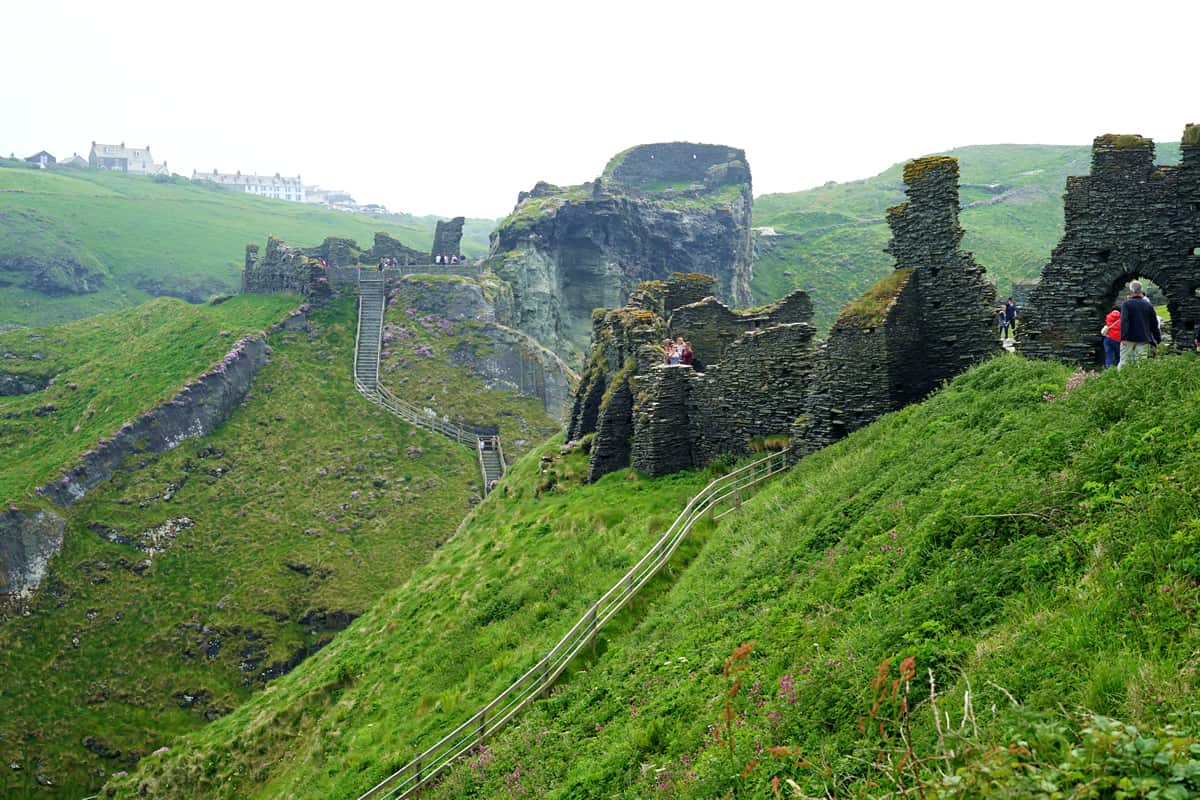
Star Castle
Visiting the Scilly Isles? Star Castle Hotel is a must – whether you stay or just go for afternoon tea.
Built in the reign of Elizabeth I in 1583, it was intended to provide fortification and an early sighting of potential Spanish invaders! Thanks to its island setting, it became a Royalist stronghold and was a refuge for the Prince of Wales (later crowned Charles II) in 1643.
Now, it’s a charmingly restored hotel with the dungeon converted to a bar and with quirky rooms where you can stay in the look-out towers.
– by Fiona Maclean of London Unattached
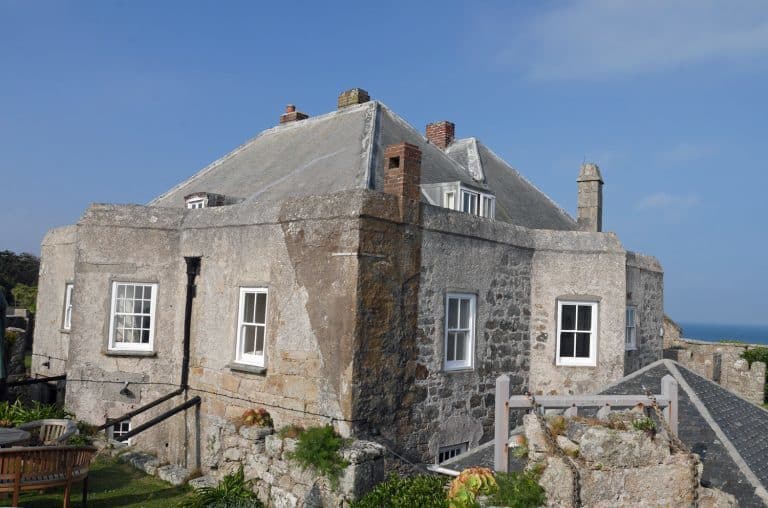
Map of the Best Castles in England
Here’s a map for your planning convenience that shows the best castles of England that are more than a day trip from London. Our choices of the best castles in England including beautiful castles in East Anglia, castles in East Midlands, castles in West Midlands, castles in Northern England and castles in Southern England.
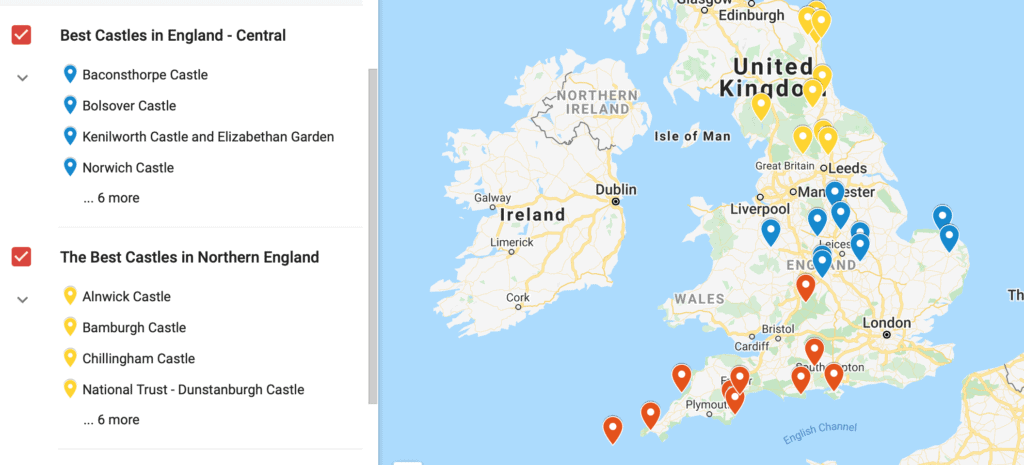
SPREAD THE WORD! PIN THIS TO YOUR TRAVEL PINTEREST BOARDS FOR FUTURE REFERENCE!
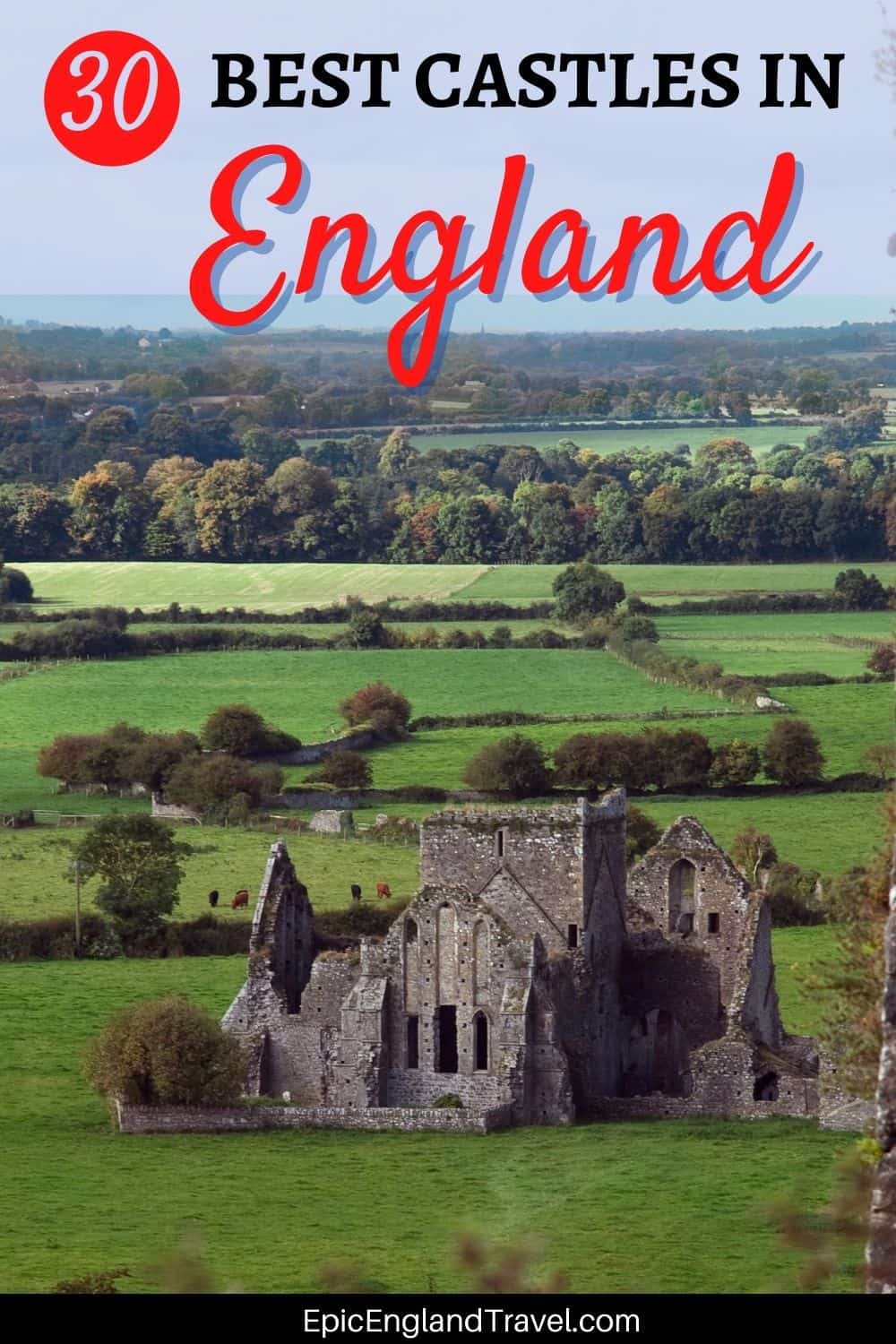
We did not receive compensation of any form, monetary or otherwise, from any of the products, services, hotels etc mentioned in this article.
This site generates income via partnerships with carefully-curated travel and lifestyle brands and/or purchases made through links to them at no extra cost to you. More information may be found on our Disclosure Policy.

You May Also Like
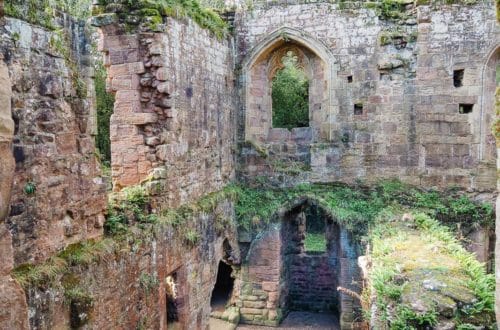
The 5 Best Castles in North Yorkshire (+ Haunted Castles in Yorkshire!)
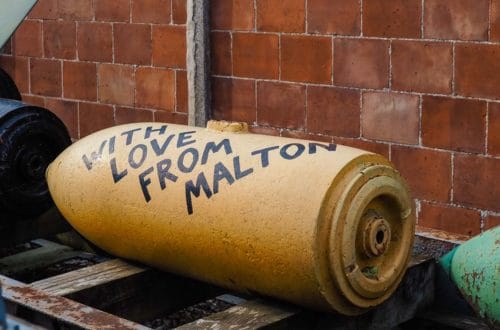
Why Visit Eden Camp Yorkshire, A Different Kind of World War 2 Museum
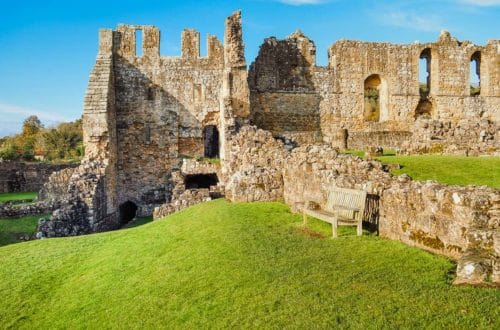
3 Must-See Abbeys in Yorkshire
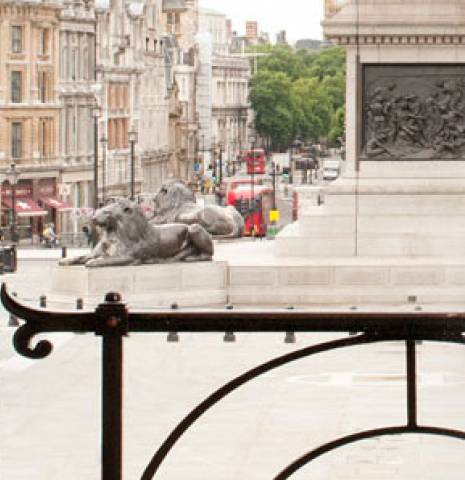
Free things to do and see
There are few places in the world offering more for eager culture vultures hunting for free things to do. Free museums and art galleries sit on top of the list. For the more outdoor-minded, grab a map from the local tourist office or visitor centre and go on a treasure hunt through town or countryside. Farmers’ markets offer a vivid tableau of community life, and often encourage you to taste free samples. See window shopping in a new light. The displays are often works of art in their own right and the architecture and design of some of the most famous shopping emporiums in the world is breathtakingly impressive.
82 Experience Results
View results as:
- Derbyshire (3) Apply Derbyshire filter
- Leicestershire (1) Apply Leicestershire filter
- Lincoln (2) Apply Lincoln filter
- Nottingham (2) Apply Nottingham filter
- Peak District (2) Apply Peak District filter
- Shropshire (1) Apply Shropshire filter
- Staffordshire (1) Apply Staffordshire filter
- Birmingham (2) Apply Birmingham filter
- Worcestershire (1) Apply Worcestershire filter
- Cambridge (1) Apply Cambridge filter
- Essex (1) Apply Essex filter
- Norfolk (1) Apply Norfolk filter
- Durham (1) Apply Durham filter
- Scarborough (2) Apply Scarborough filter
- Yorkshire Dales and Harrogate (1) Apply Yorkshire Dales and Harrogate filter
- Northumberland (2) Apply Northumberland filter
- NewcastleGateshead (1) Apply NewcastleGateshead filter
- Yorkshire (4) Apply Yorkshire filter
- Chester (1) Apply Chester filter
- Cumbria (1) Apply Cumbria filter
- Blackpool (2) Apply Blackpool filter
- Manchester (2) Apply Manchester filter
- Liverpool (3) Apply Liverpool filter
- Berkshire (1) Apply Berkshire filter
- Brighton (2) Apply Brighton filter
- Eastbourne (1) Apply Eastbourne filter
- Portsmouth (3) Apply Portsmouth filter
- Hertfordshire (1) Apply Hertfordshire filter
- Isle of Wight (2) Apply Isle of Wight filter
- Kent (2) Apply Kent filter
- London (11) Apply London filter
- Oxford (3) Apply Oxford filter
- Surrey (1) Apply Surrey filter
- West Sussex (1) Apply West Sussex filter
- Bristol (3) Apply Bristol filter
- Cornwall (1) Apply Cornwall filter
- Exeter (1) Apply Exeter filter
- Bournemouth (1) Apply Bournemouth filter
- Bath (4) Apply Bath filter
- Wiltshire (1) Apply Wiltshire filter
- Countryside pursuits (1) Apply Countryside pursuits filter
- Cycling (4) Apply Cycling filter
- Going underground (1) Apply Going underground filter
- Tours and trails (12) Apply Tours and trails filter
- Walking and hiking (5) Apply Walking and hiking filter
- Autumn Break Ideas (7) Apply Autumn Break Ideas filter
- (-) Remove Free filter Free
- Low cost (1) Apply Low cost filter
- City parks (4) Apply City parks filter
- Neighbourhoods (1) Apply Neighbourhoods filter
- Beaches (5) Apply Beaches filter
- Coastal towns (1) Apply Coastal towns filter
- Areas of outstanding natural beauty (2) Apply Areas of outstanding natural beauty filter
- Forests and woodlands (2) Apply Forests and woodlands filter
- Gardens and Parks (1) Apply Gardens and Parks filter
- Lakes and waterways (1) Apply Lakes and waterways filter
- National Parks (2) Apply National Parks filter
- Wildlife and Nature Reserves (6) Apply Wildlife and Nature Reserves filter
- Architectural wonders (1) Apply Architectural wonders filter
- Arts and cultural events (1) Apply Arts and cultural events filter
- Festivals and carnivals (7) Apply Festivals and carnivals filter
- Hidden gems (2) Apply Hidden gems filter
- Literature, film and TV (5) Apply Literature, film and TV filter
- Museums galleries and libraries (19) Apply Museums galleries and libraries filter
- Music and nightlife (2) Apply Music and nightlife filter
- Music festivals in England (1) Apply Music festivals in England filter
- Outdoor art and sculpture (1) Apply Outdoor art and sculpture filter
- Seasonal celebrations (2) Apply Seasonal celebrations filter
- Days Out in England (2) Apply Days Out in England filter
- August events (1) Apply August events filter
- December events (1) Apply December events filter
- February events (1) Apply February events filter
- July events (3) Apply July events filter
- June events (1) Apply June events filter
- May events (1) Apply May events filter
- September events (2) Apply September events filter
- Attractions (3) Apply Attractions filter
- Dog friendly (1) Apply Dog friendly filter
- Indoor Activities (9) Apply Indoor Activities filter
- Outdoor Activities (5) Apply Outdoor Activities filter
- Playtime (2) Apply Playtime filter
- Toddler Friendly Holidays (4) Apply Toddler Friendly Holidays filter
- Zoos wildlife and safari parks (1) Apply Zoos wildlife and safari parks filter
- Food and Drink (1) Apply Food and Drink filter
- Abbeys cathedrals and sacred places (4) Apply Abbeys cathedrals and sacred places filter
- Archaeological sites (1) Apply Archaeological sites filter
- Castles and Historic Properties (1) Apply Castles and Historic Properties filter
- Historic sites and icons (3) Apply Historic sites and icons filter
- Industrial Maritime And Transport (4) Apply Industrial Maritime And Transport filter
- Military history (6) Apply Military history filter
- Myths Legends and Tales (2) Apply Myths Legends and Tales filter
- Royal (2) Apply Royal filter
- World heritage sites (1) Apply World heritage sites filter
- Picturesque places (1) Apply Picturesque places filter
- Unique Experiences (1) Apply Unique Experiences filter
- Autumn (22) Apply Autumn filter
- Spring (18) Apply Spring filter
- Summer (33) Apply Summer filter
- Winter (7) Apply Winter filter
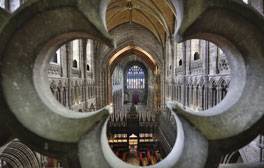
Discover 1,000 years of history at Chester Cathedral
Journey through hundreds of years of history and discover hidden spaces as you climb to the top of the cathedral tower.
Location: Chester, Cheshire
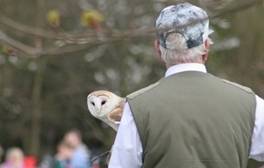
Be at one with birds of prey at Rosliston Forestry Centre
There’s something special about being close to a bird of prey; those round watchful eyes on high alert, fixing you with a dominating stare.
Location: Rosliston, Derbyshire
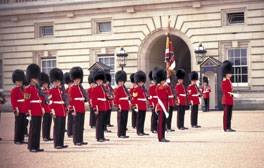
Watch the changing of the Guards in London
For sheer pomp and ceremony, you can’t beat the changing of the guard at Buckingham Palace.
Location: London, Greater London
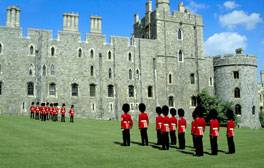
See the changing of the Guards at Windsor
If there’s one essential experience in Windsor, it’s taking in the spectacle of the Changing of the Guard. This tradition brings history and the public together.
Location: Windsor, Berkshire
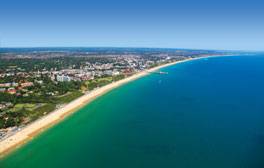
Pier to Pier in Bournemouth
Got a spare hour or two in Bournemouth? Then take a stroll between the two piers.
Location: Bournemouth, Dorset
Small pleasures come free at Dimminsdale Nature Reserve
Just a few small snowdrops bring cheer to the colder, shorter days of England’s winter, and seen at Dimminsdale, they’re simply breathtaking.
Location: Staunton Harold, Leicestershire

Discover dinosaur footprints on the beach
Everyone who has been to the beach has seen footprints left in the sand, but have you ever seen ones that have been left by a dinosaur?
Location: Brook, Isle of Wight

Discover the mystery of the Rosetta Stone
Visit the British Museum for free and see the famous Rosetta Stone. Dating back to ancient Egypt, the stone was key in the deciphering of hieroglyphs.

Admire the iconic architectural landmarks of the City
Explore the fusion of historical and modern architecture in the ever-evolving City of London.
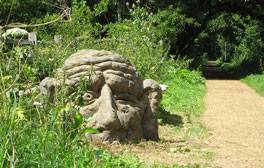
Trip-trap along the Red Squirrel Trail
This family-friendly cycle and walking path encompasses an exciting trail of artwork, sculpture and trolls under bridges.
Location: Newport, Isle of Wight

Learn about Jack the Ripper at City of London Police Museum
This museum offers a fascinating insight into the lives of the men, women and animals who have guarded the City since 1839.

Take a longer look at London with the City Visitor Trail
Make the most of your time in London - no matter how long you have - with the main trail and its side tracks you'll have plenty to do and more.

Wander the medieval passageways & get lost in the City
Navigate your way through the intriguing streets of the old City and embrace its quirky nature.

Step into the City's oldest church, All-Hallows-by-the-Tower
Though bombed in the Second World War, All-Hallows-by-the-Tower remains a beautiful Grade I listed building bursting with City history.

Join the Knights Templar in the original Temple Church
Enter the English headquarters of the Knights Templar in the 13th Century and immerse yourself in its varied history.

Go back in time and discover the original Roman City walls
Follow in the footsteps of Romans as you explore the history of the walls that protected the original City of London.
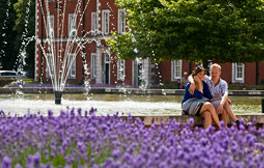
Rainy Day Activities: Explore history at Winchester’s Military Museums
Broaden your knowledge of the British Army and the various battles fought throughout history at Winchester’s six Military Museums.
Location: Winchester, Hampshire
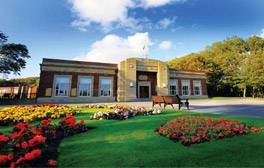
Picnic in Blackpool’s largest park
Stanley Park, in the heart of Blackpool, is renowned for being one of the region's finest parks.
Location: Blackpool, Lancashire

Picnic in Bath's most elevated park
Enjoy stunning views of the World Heritage City of Bath from the steep hill-top setting of Alexandra Park.
Location: Bath, Somerset

Take a free walking tour of Bath with a local
Let the Mayor of Bath’s Honorary Guides show you the city of Bath with free daily walking tours.
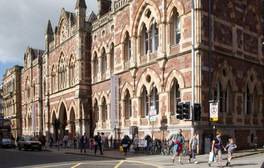
Rainy Day Activities: See famous works in the Royal Albert Memorial Museum
With numerous famous artworks and historical artefacts on display, the award-winning Royal Albert Memorial Museum is a must-see indoor attraction in the heart of Exeter.
Location: Exeter, Devon
- See more results
We've something we want to share
Want to receive travel tips and ideas by email?
VisitEngland would like to invite you to take part in a short survey about our website, it should take no more than a couple of minutes.
Go to the survey
To add items to favourites …
… you need to be logged in.
If you already have an account, log in.
Or register a new account
Access your account

Free Castles
You can visit all these historic places in Hampshire for free!

Bishops Waltham Palace
Bishops Waltham Palace was the sumptuous residence for the powerful Bishops of Winchester. It has been host to fascinating events and numerous royal guests.

Netley Abbey
This abbey is over 800 years old and is one of the most complete ruins of a Cistercian abbey in the south of England. It doesn’t take much imagination to see what the abbey was like in the 13th century.

Appuldurcombe House
Set in over 10 acres landscaped by Capability Brown, the house still gives you a feel for the impressive baroque architecture. The house has been a hotel, a school and a residence for exiled monks.

Northington Grange
The Grange was home to royalty, George IV lived here for a time whilst he was the Prince of Wales. The original country house was updated to a mansion between 1664 and 1673.

Titchfield Abbey
Henry V, famous for his win at Battle of Agincourt, visited the abbey before one of his French campaigns. As a great Tudor mansion there were numerous royal guests, including Edward VI, Elizabeth I and Charles I.
Not all historic sites that have free admission are just mounds of earth; many of the free to access castles are spectacular .
This site provides you with details of all the admission free castles and historic buildings of Hampshire.
This is your explorer’s guide to free days out in Hampshire . We provide practicalities like opening times and location, but also photographs and a history of the site.
Please note that the opening times and access are pre-Covid.
When the pandemic allows we will expand this site to cover other free to access sites in England.

Wolvesey Castle

Feedback and Comments

14 Stunning Castles in England You Have to Visit
Ready to explore the most stunning castles in England? Steeped in history, these impressive fortresses are a must-visit for any planned trip.
With castles dotting the landscapes of England, finding the best can be a little tricky.
I’ll be the first person to admit that not all of England’s castles are the most exciting – I get it… you want to skip on the piles of ruins and visit some of the country’s well-preserved spots instead.
This guide will take you on a jaunt around the English castles you need to visit. Ready to explore?
5 Best Castles in England You Shouldn’t Miss
Warwick castle.
Warwickshire
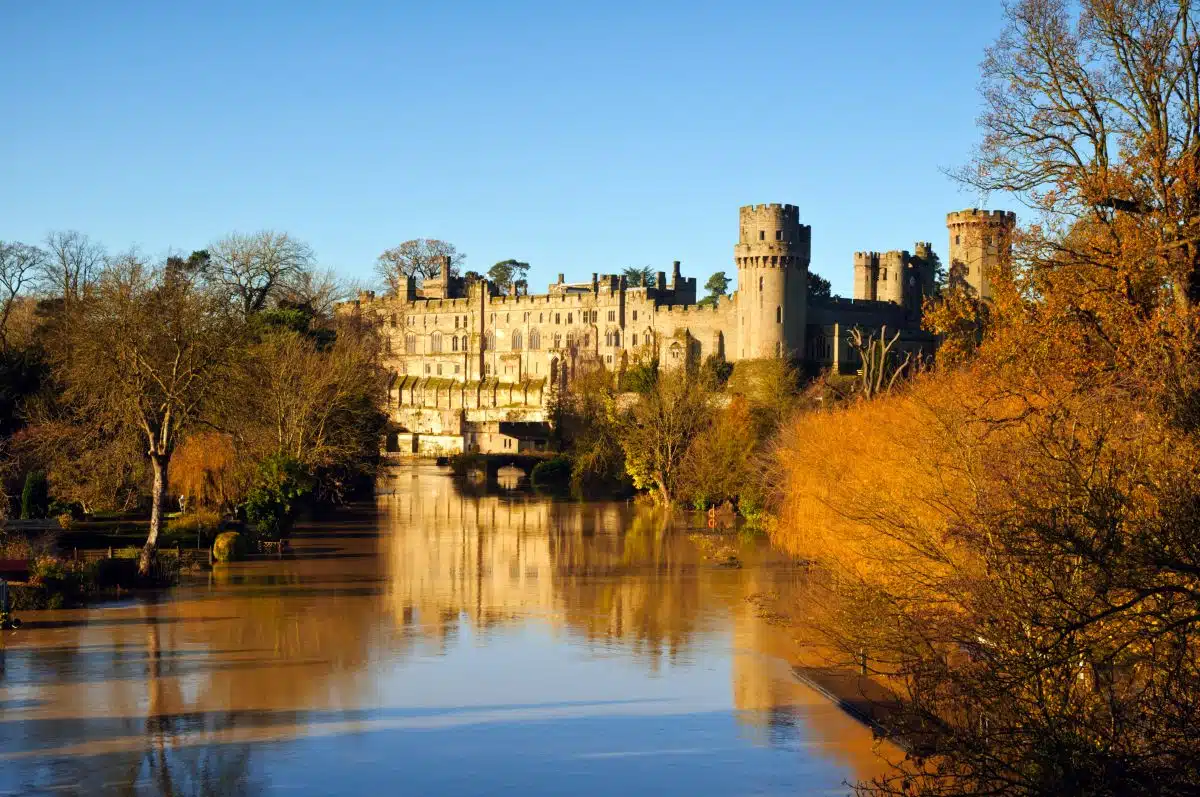
Built on the bend of the River Avon, Warwick Castle is one of the most traditional motte and bailey castles in England. I might be biased, as I’ve visited this castle plenty of times, but it’s truly one of the best in England (if not, the UK).
It was originally constructed during the Norman conquest, but rebuilt as a stone castle during the 12th century – not to mention that the castle grounds include 64 acres of beautiful gardens.
Warwick Castle is paradise if you’re a history fanatic. They have daily showcases with staged reenactments of historic moments in the castle’s history, as well as jousting tournaments and falcon shows.
It’s also owned by Merlin, the folk behind the London Dungeons and Madame Tussauds, so book into the castle dungeons and prepare yourself for a spooky encounter with some Medieval faces.
Leeds Castle
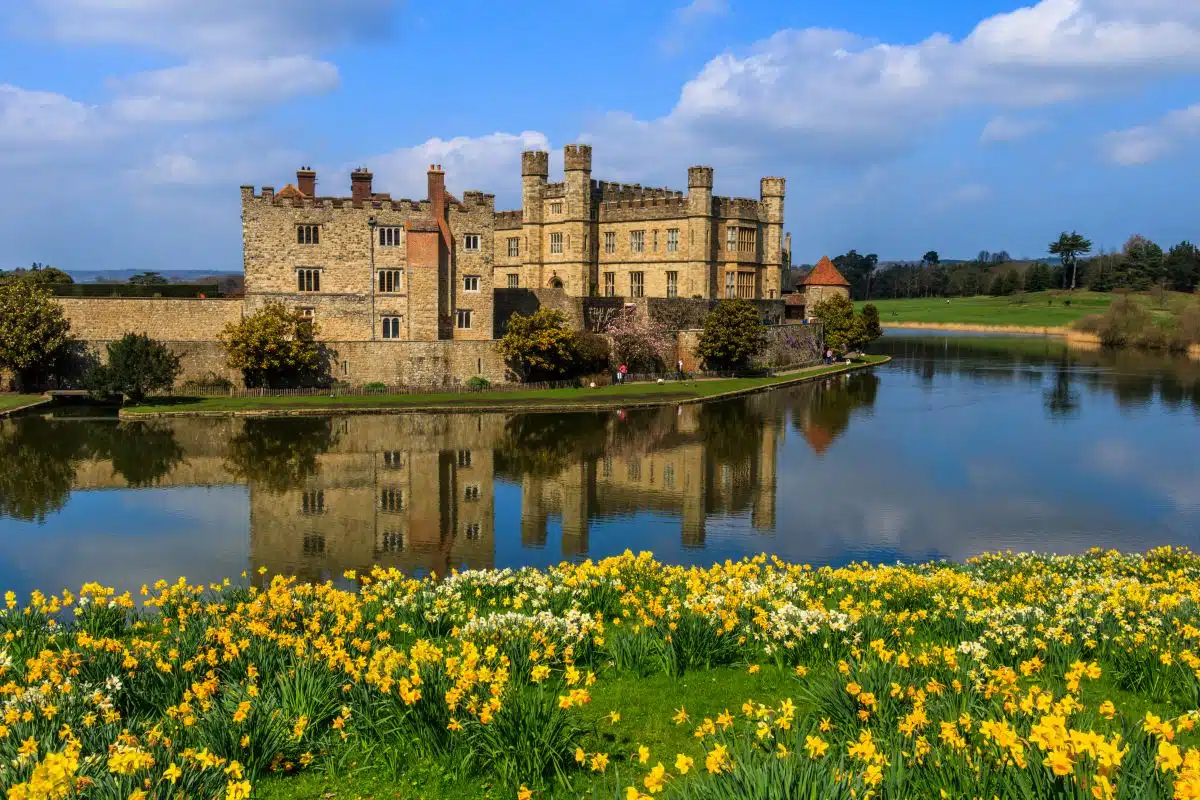
One of the biggest castles in England, Leeds Castle in Kent spans over 500 acres of eye-catching countryside. Reconstructed in 1823 as a Tudor castle during the reign of Henry VIII, it is just under 955 years old in 2022.
Leeds Castle is now well known as one of the loveliest castles in England due to its reputation as a romantic getaway. It housed six of England’s medieval queens and is now a top-rated castle hotel – a stay here is right at the very top of my bucket list right now.
The castle grounds house an exciting maze that leads to a grotto enclave filled with recreations of mythical creatures using shells, minerals, and wood.
Dover Castle
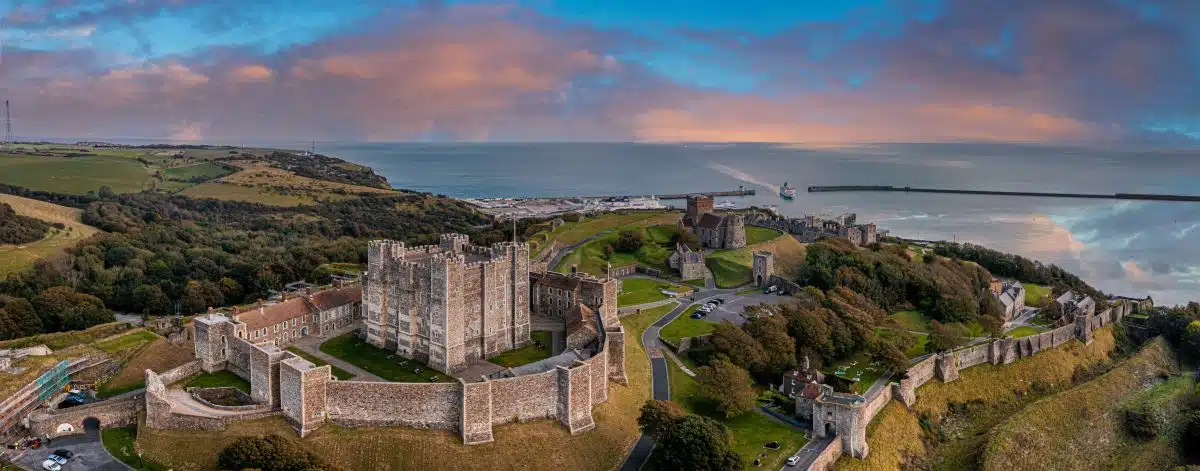
Used as a military fortress during multiple great wars, Dover Castle in Kent started construction in 1180.
Perched on a scenic hill overlooking the English Channel, the castle has played an integral role in England’s history.
It housed an underground hospital used during sieges, and as a result, 21-foot thick walls surround the castle. Beyond the hospital lie several secret tunnels which lead to one of the lighthouses in the country.
With a history like that of Dover Castle, you’ll find highlights of various military operations and medical rescue missions undertaken on the grounds brought to life by visual effects and actual film footage.
Hever Castle
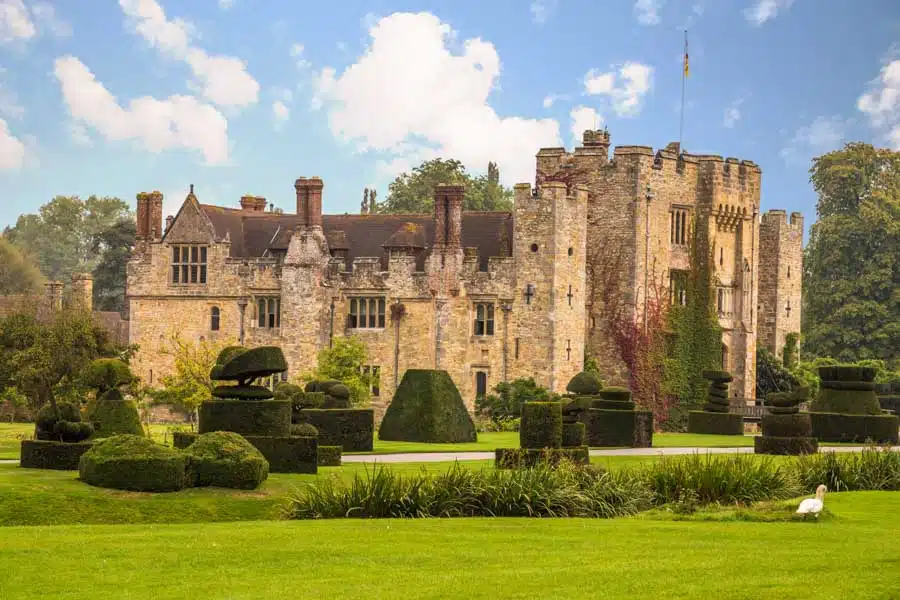
Home to Anne Boleyn during her childhood, Hever Castle encompasses more than 700 years of historical prevalence.
The castle grounds, spanning 125 acres, are made up of award-winning gardens and a 100-year-old maze.
Hover Castle is a defensively-built moated castle home to interiors filled with Tudor-style decorations, artwork, and furniture.
When you visit the castle, keep your eyes peeled for the breathtaking Dahlia displays and arrangement of Katsura trees found within the gardens.
Bodiam Castle
East Sussex
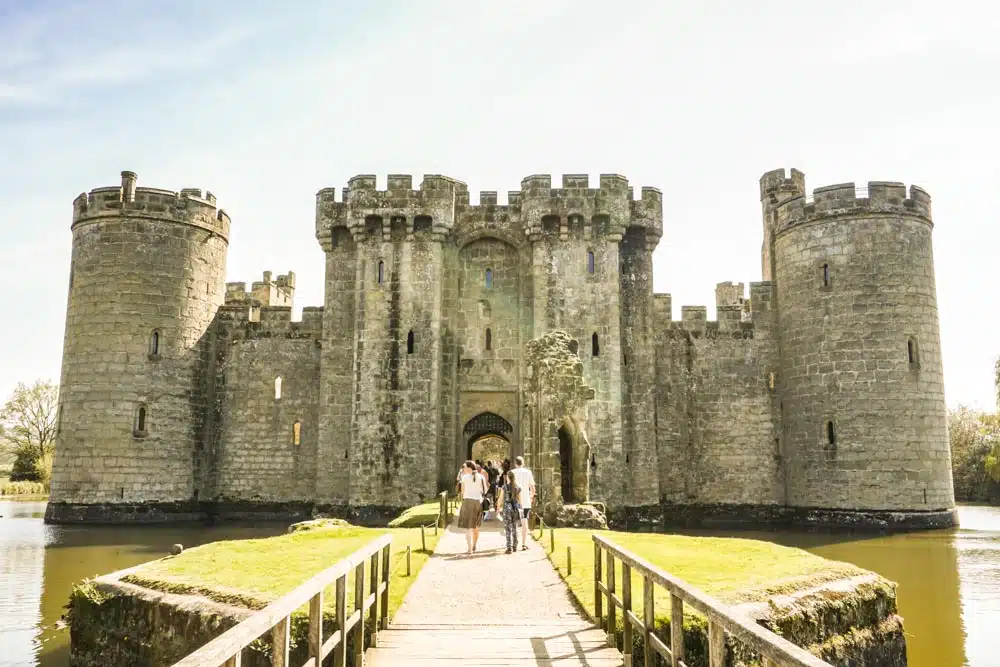
Built in 1385, Bodiam Castle sits at the top of the list of the best medieval castles in England. Surrounded by a large moat, the court tokened by circular towers includes a gatehouse and imposing twin towers.
The castle’s exterior has been kept in near perfect condition, while the interior is more neglected – though this does not make it any less worthy of being on this list. It simply adds to its charm.
If you’re after an eye-catching display of castle architecture, few castles in southeast England come close to Bodiam.
Incredible Castles in England
Lincoln castle.
Lincolnshire
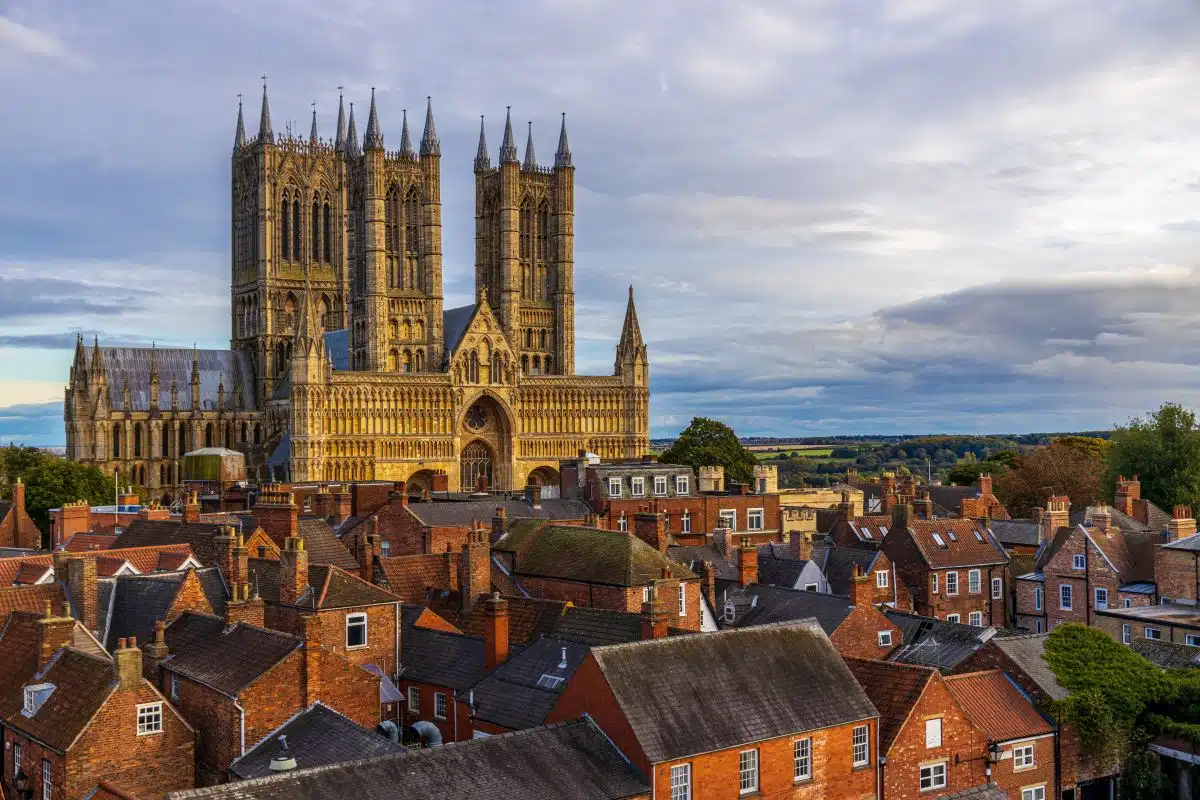
Constructed under the rule of William the Conqueror in 1068 (keep his name in mind, he pops up a lot), Lincoln Castle remains one of the best England castles due to its sheer size and how well-preserved it is. The castle has a rich past as it was both used as a prison and court of law.
It is now open to the public as a museum, and displays relics from a Scandinavian church found on the grounds during an excavation in 2013.
Norwich Castle
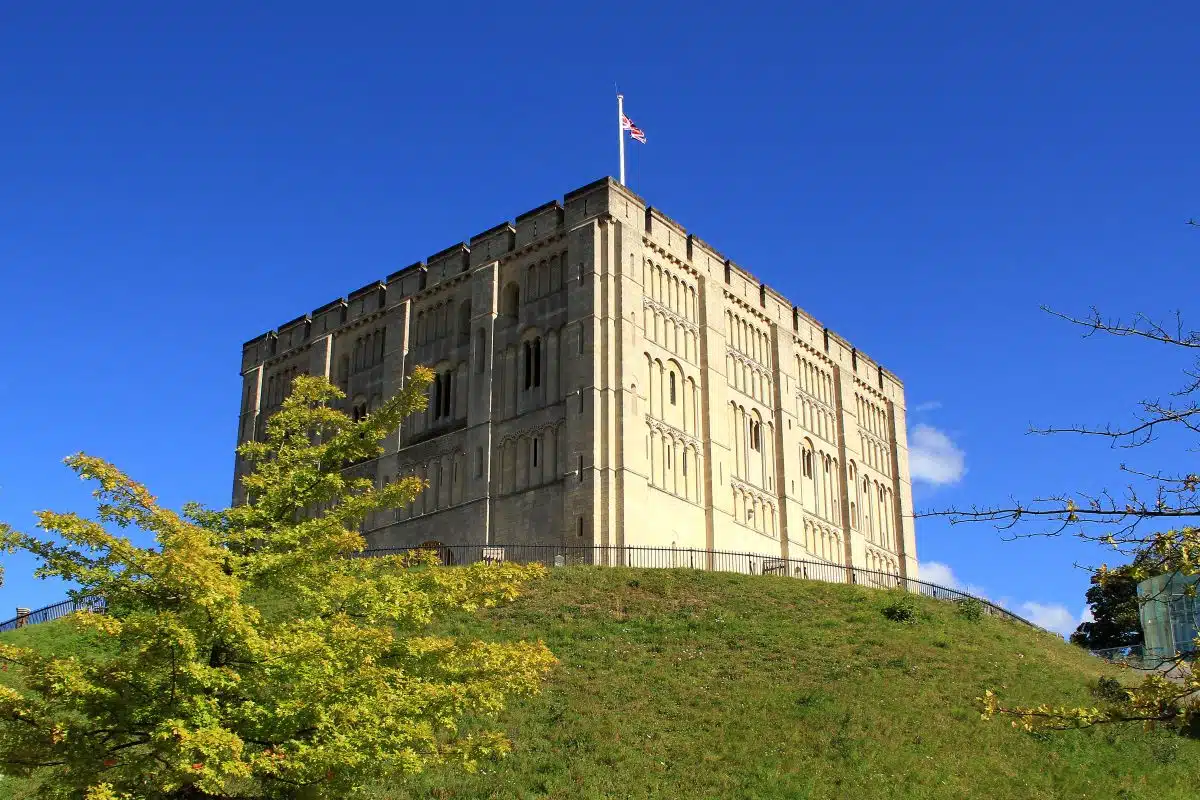
William the Conqueror can be thanked for building another of the best English castles – Norwich Castle , during 1067. Used during his reign to keep control over the East Anglia Kingdom, the castle is an ode to England’s power over the region.
Currently, the castle is home to an extensive collection of art, archaeological finds, and national heritage exhibitions.
Visiting the Norwich Castle Museum and Art Gallery should definitely be on your to-do list if you want an unforgettable journey through England’s history.
Berkhamsted Castle
Berkhamsted
As the first castle in the country’s history to be protected by Parliamentary legislature, Berkhamsted is officially the oldest castle in England. Ownership passed along to multiple royal leaders after Robert of Mortain built the castle in 1067.
It wasn’t until the late 15th century that the castle fell out of tune with what is considered fit for the housing of royalty. Since then, notably, the castle has been used as the directing line of the London-Birmingham Railway.
Windsor Castle
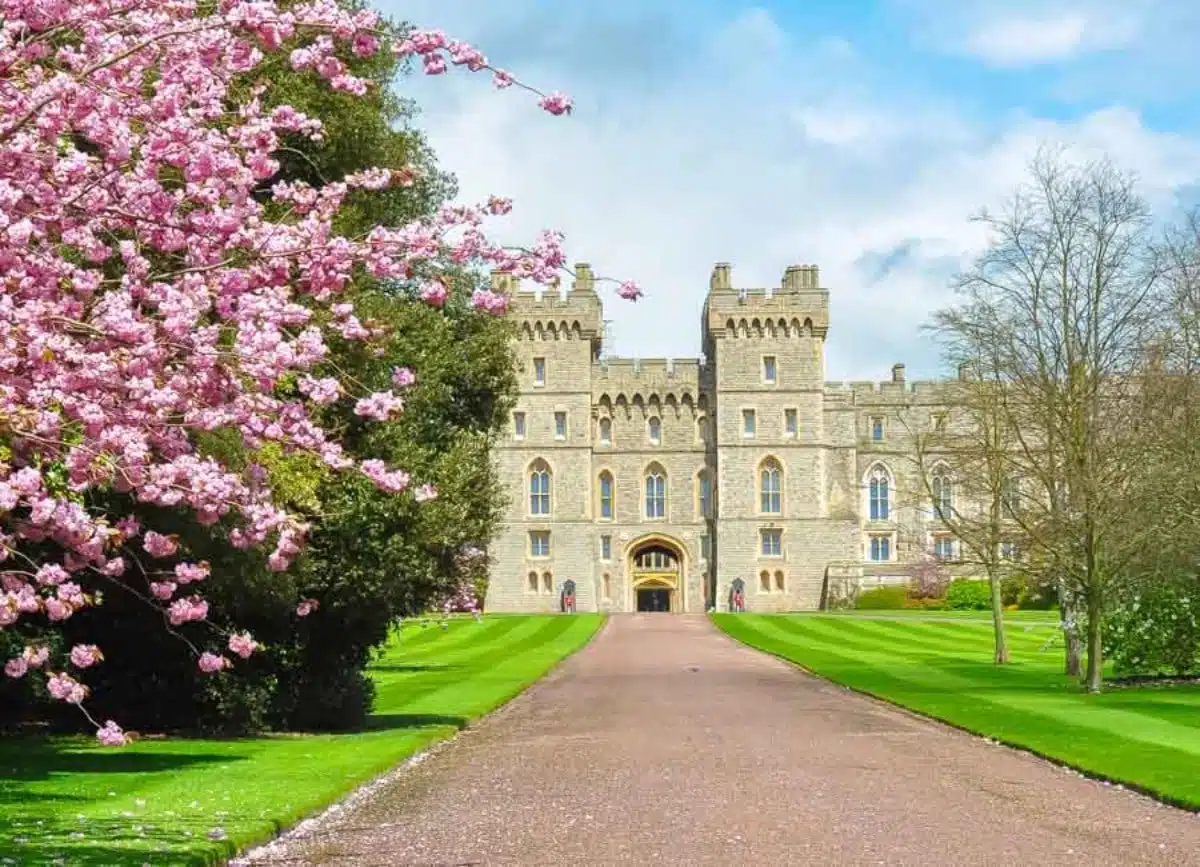
Known worldwide thanks to Queenie, Windsor Castle is without a doubt the most famous castle in England and needs no introduction. Constructed in the 11th century, the castle is over 950 years old.
Having housed a reported 39 monarchs in its lifetime, Windsor Castle is also one of the longest-occupied castles in the world.
With the castle still being in operation for royal duties, Queen Elizabeth II regularly hosts foreign heads of state at the palace.
Visiting the court, you’ll be able to view ceremonies such as the changing of the guard – this impressive ceremony is just one reason that this castle is one of the most popular castles to visit in England.
Fun Fact: Queen Elizabeth still uses the castle as a frequent weekend residence.
The Tower of London
Central London
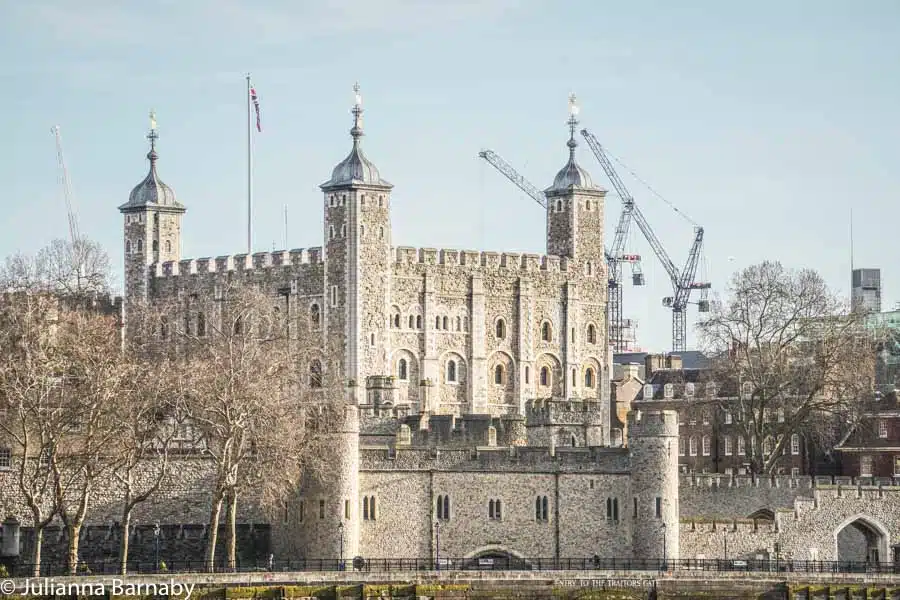
The Tower of London is a site crucial to the shaping of England’s history. With the first part of construction finished in 1078, the White Tower sits at the core of the tower grounds.
Now surrounded by several more towers, tours of the tower include various exhibitions, with the Crown Jewels being what most people come to see.
Officially known as Her Majesty’s Royal Palace and Fortress of the Tower of London, you’ll be entrenched in regal and horrifying history.
Fun Fact: Tales told by tower guards have given the Tower of London a reputation for being one of the most haunted castles in England.
For more interesting facts about London, here are 55 facts I bet you never knew.
Tintagel Castle
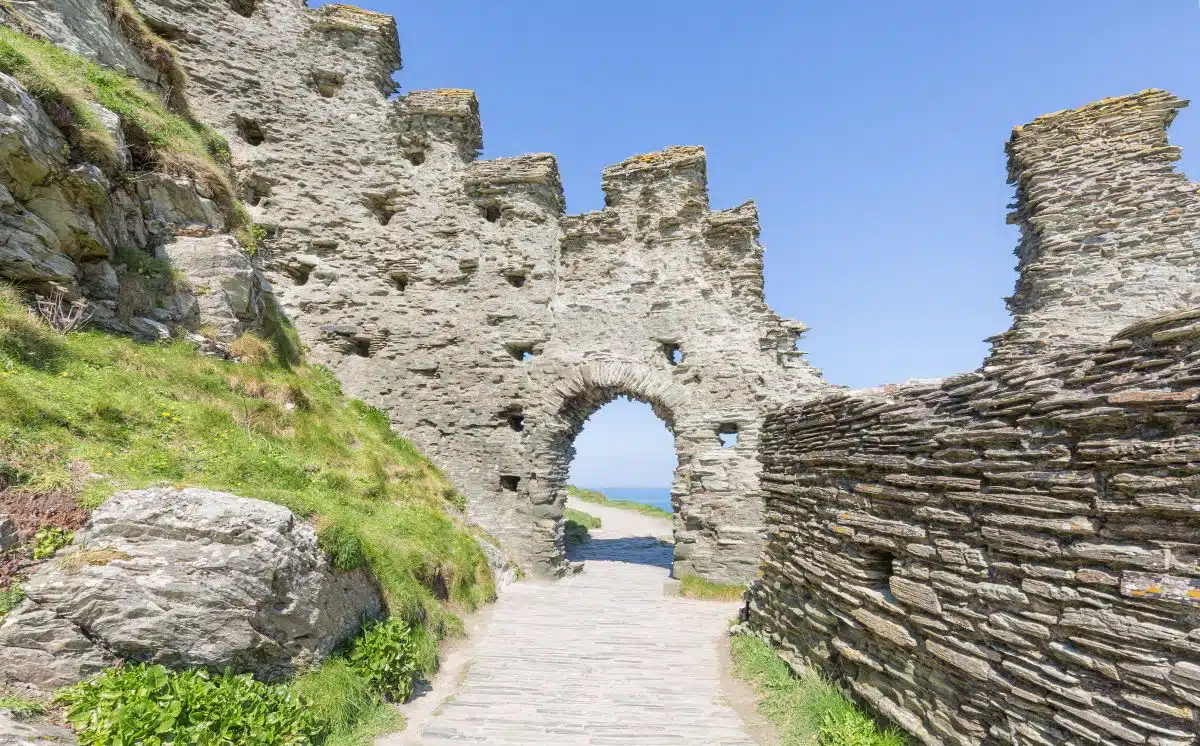
Surrounded by myth and legend, the castle ruins in England of Tintagel Castle are among the most famous relics from decades ago.
Built during the 13th century by the Earl of Cornwall, the now 800-year-old ruins hold legends in their walls.
For anyone who has been to the popular site, the court at Tintagel strikes an unmistakable resemblance to the court of King Arthur. In fact, it’s one of the most visually impressive English castles I’ve ever visited.
Archaeological excavations uncovered relics on the grounds dating back to the dark ages, which add to the flair and fantasy of the most famous ruined castles in England.
Fun Fact: A life-sized bronze sculpture named Gallos, modelled after King Arthur, stands guard over the court at Tintagel.
Arundel Castle
West Sussex
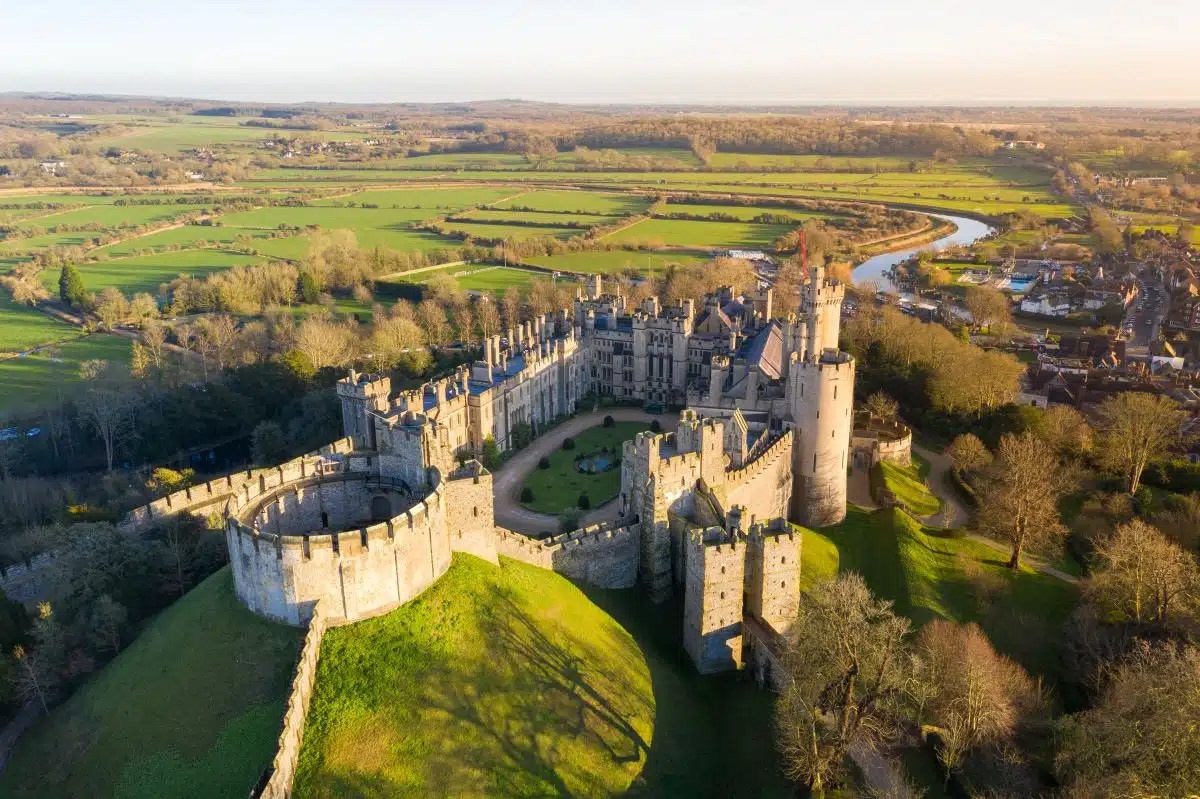
Sitting high on a hill overlooking West Sussex, Arundel Castle also owes its existence to William the Conqueror, who commissioned the castle’s construction in the 11th century. Undergoing various repairs after the English Civil War, it now stands as beautiful as ever.
Arundel is genuinely unique because it is one of the first castles in English history to have features such as central heating, electricity, and lifts.
St Briavals Castle
Gloucestershire
Ask anyone who has ever visited or stayed the night at St Briavels Castle , and you’ll be told stories of truly haunting experiences. Although now used as a youth hostel, the castle is a creepy spot only for those who dare to brave it.
Built during the 12th century, the castle and its grounds have had plenty of time to collect their share of ghosts.
These apparently include a black dog that wanders the grounds, a grey lady who sits in the top corridor, and a ghoulish knight – I’ll stick to visiting during the day, thank you very much.
St Michael’s Mount
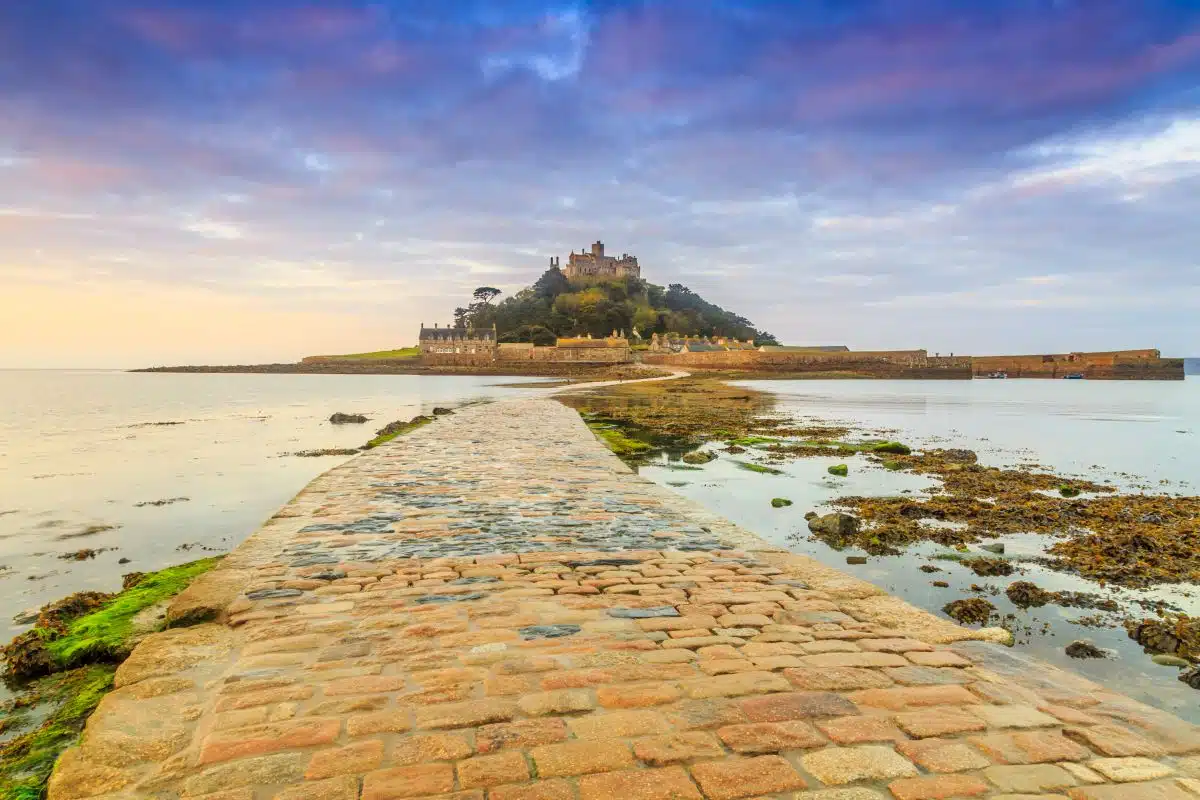
Possibly the only castle that rivals Warwick in my heart is the beautiful St Michael’s Mount , which is built on a breathtaking small tidal island off the coast. It might just be the best castle in England, with the court only accessible via a cobblestone footpath – and only when the tide is low.
Dripping in majesty and scenery straight from a fantasy epic, the grounds are also said to be the legendary home of giants.
Time your visit just right – you do not want to get stuck on the island after high tide.
Practical Tips for Visiting English Castles
- If you’re serious about visiting England’s many castles, it might be worth joining the National Trust. Not only do you benefit from admission discounts, but you also get to help preserve many of the sites in this guide.
- Another great option is English Heritage . As a member, you’ll get unlimited access to numerous sites, including the castles on this list. With this membership, you’ll get a front seat to history year-round.
- There are a lot of castles to see in England – plan your trip to allow for enough time to take in all the sights.
For an amazing trip to the UK, look at this epic UK bucket list .
Castles in England: Map
Discover More UK Guides
- Walking in the Lake District
- The Best Beaches in the UK
- 26 Epic UK Bucket List Destinations
Love This? Save and Share on Pinterest
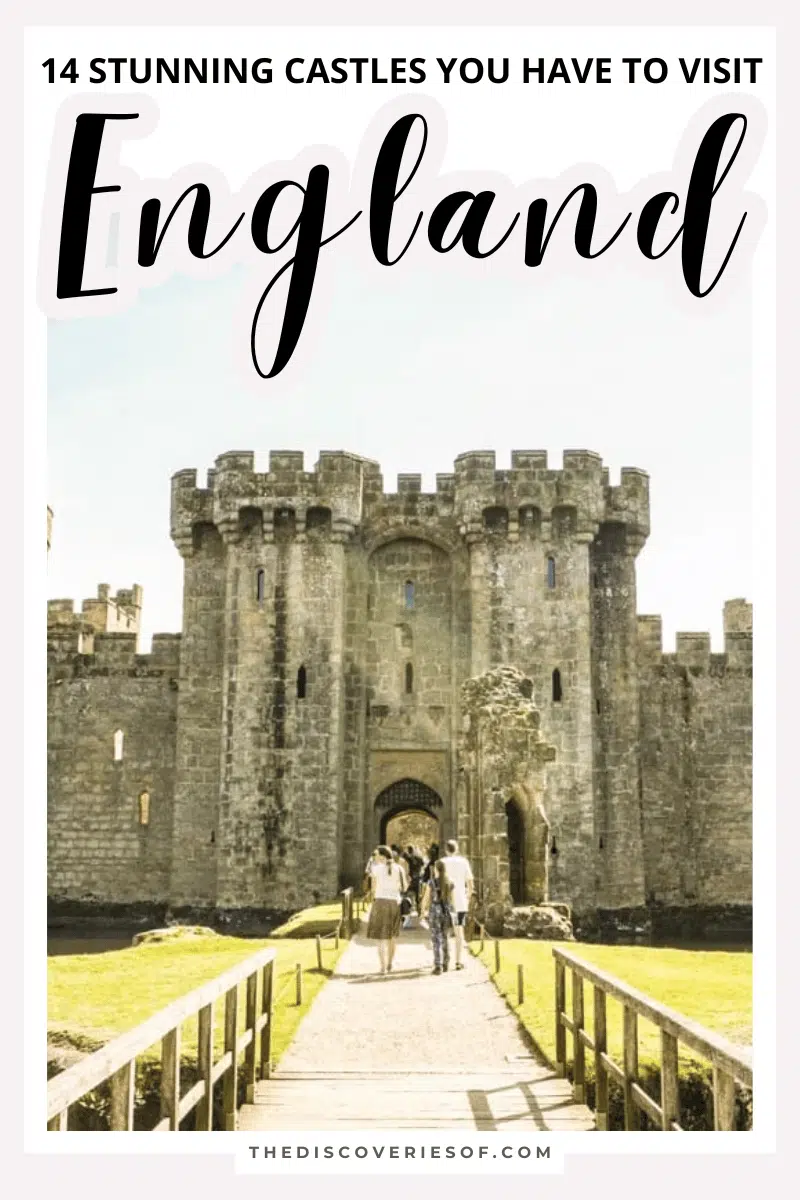
I’m Julianna Barnaby - a professional travel writer and geek extraordinaire. I started The Discoveries Of to help you to discover the best of new destinations from around the world.
Discovering new places is a thrill - whether it’s close to home, a new country or continent, I write to help you explore more and explore differently.
Related Posts
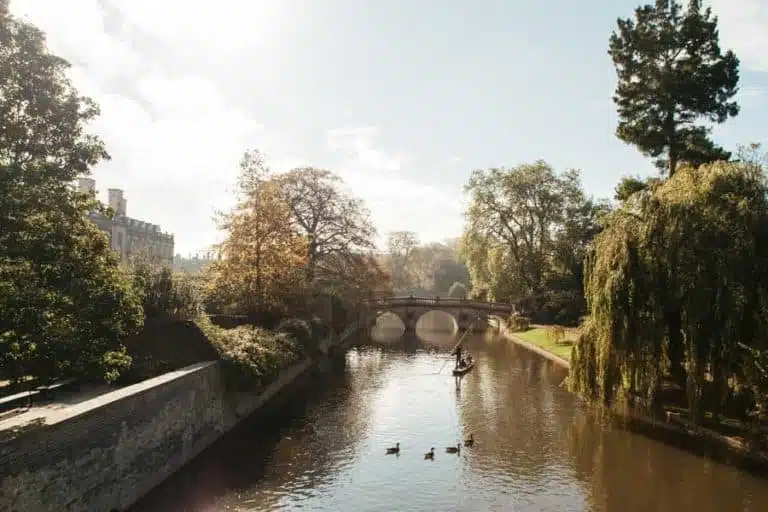
The Best Things to do in England: Discovering England’s Timeless Charm
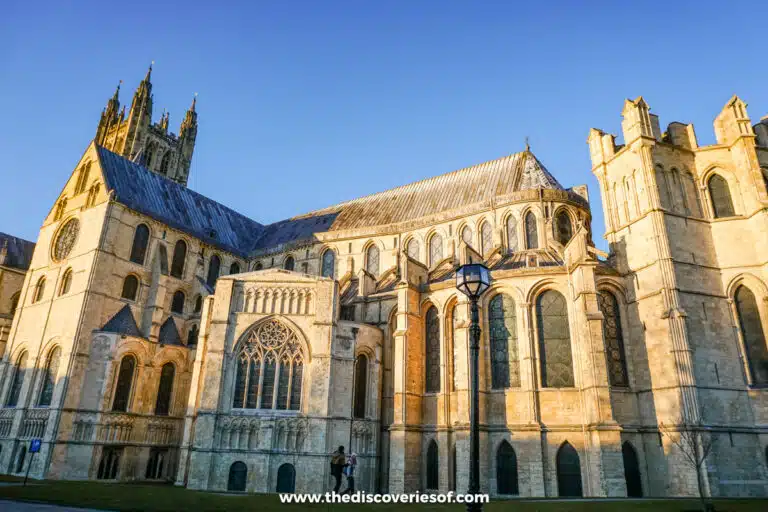
One Day in Canterbury: A Day Trip Itinerary for Kent’s Historic Gem
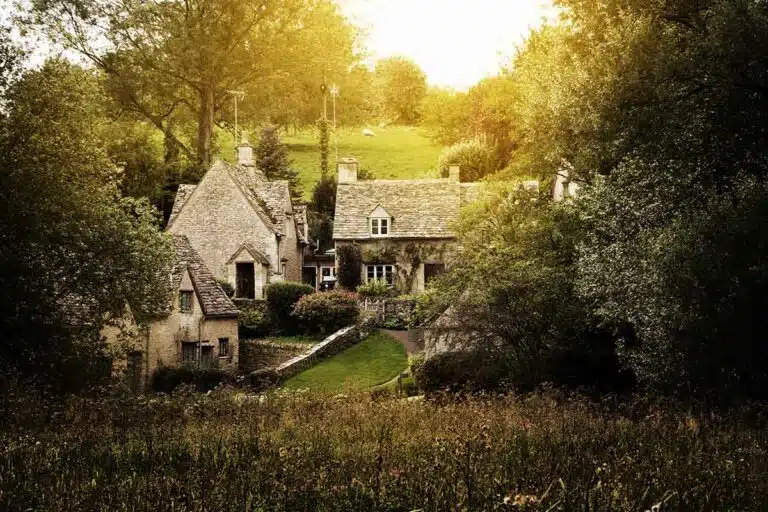
Where to Stay in the Cotswolds: A Step-by-Step Guide
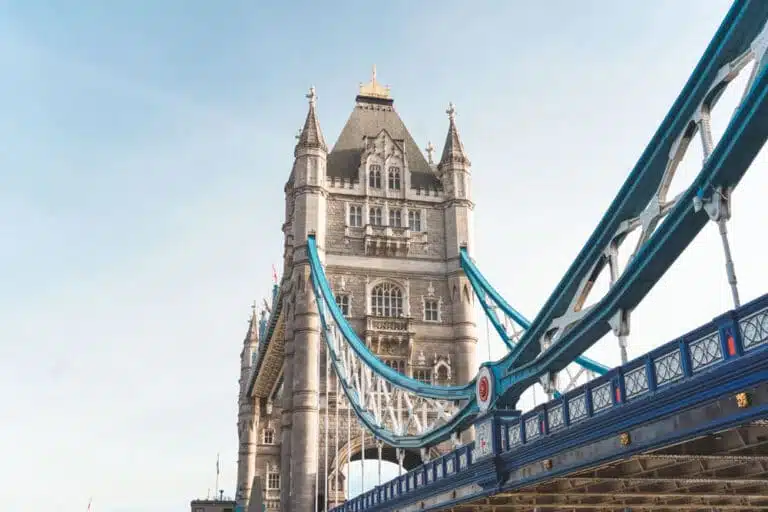
Where to Stay in London: The Best Areas + Hotels For Your Trip

Follow me on Instagram for travel inspiration, tips, and guides.

- Travel Journal
- Travel Advice
- Travel Inspiration
- Photo Diary
- Photography Tips
- Photography Inspiration
- Destinations
- Home Inspiration
- Blogging Tips
- Work With Us

17 Best Castles In England To Visit

There’s no doubt that our country has some of the best castles in England. Now, it’s no surprise that I’m slightly biased here, but we’ve got hundreds of incredible castles that are just too beautiful to ignore.
That being said, with so many castles in England, it can actually be hard to pinpoint just a handful to visit; especially when they’re dotted all over the country. That’s why I wanted to share some of my very favourite and best castles in England that I think you shouldn’t miss. It doesn’t matter what part, or beautiful places in England you’re heading to, I’m almost certain you’ll find one or two stunning castles along the way.
After all, this is what makes exploring England so amazing!
It’s always so incredible to see castles that have stood for, in some cases, millennia, especially. To be honest, England has a history spans many thousands of years, with the castles being one stunning example of this.
With that in mind, I wanted to share some of the best castles in England to explore on your next trip.

Take a look, below, at the best castles in England. Have the best trip!
1.) Bodiam Castle
Bodiam Castle might be smaller than most, but it’s certainly one of the best castles in England to visit on your next trip.

Perched in East Sussex, this 14th Century castle has hundreds of years of history and can be easily explored. Built by a former Knight of Edward III, it was created to protect against the French during the hundred year way.
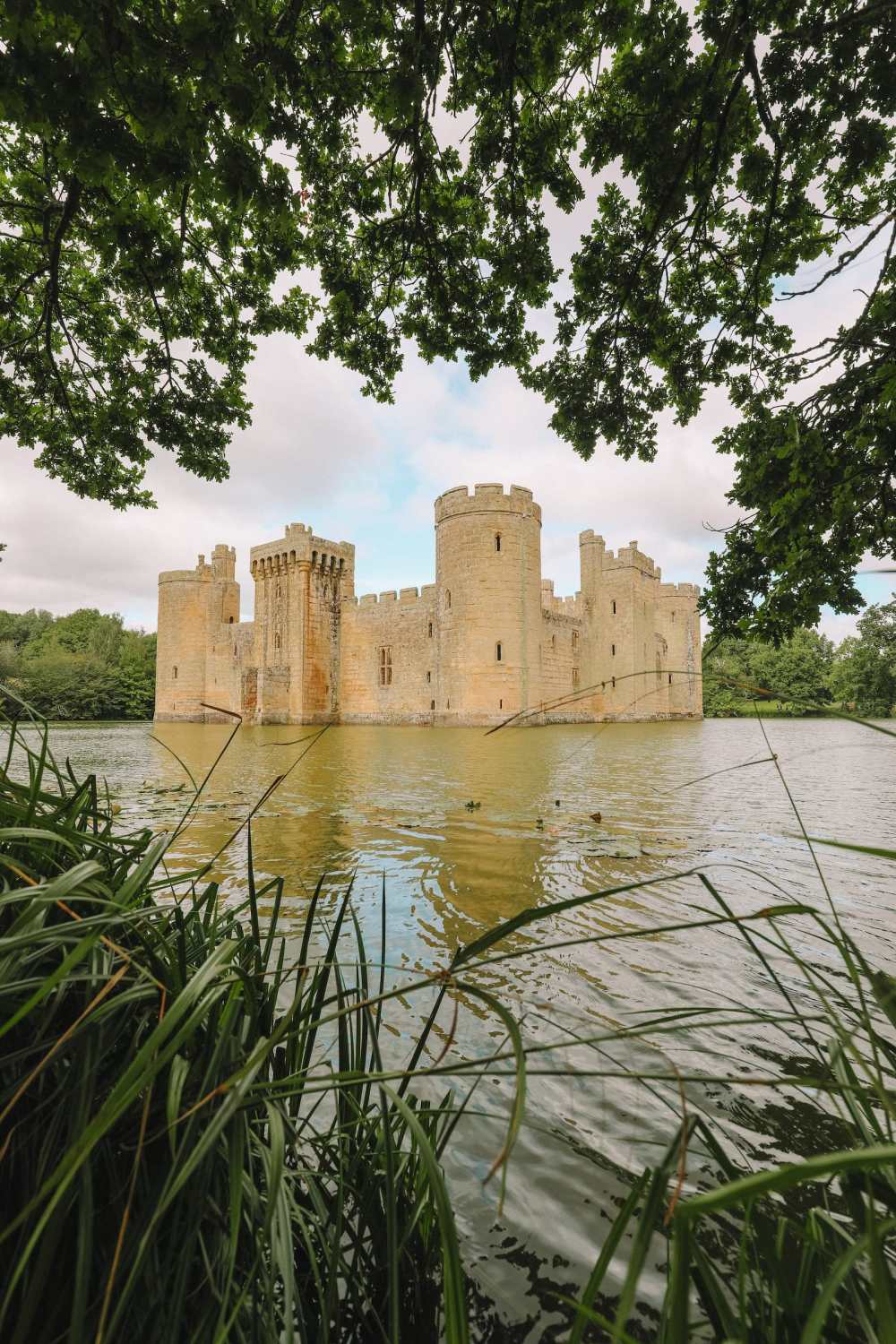
Take a wander around the castle, head across the moat and explore the long history of this stunning place.
Read more: Best places in Southern England to visit
2.) Bamburgh Castle

Bamburgh Castle has a written history dating back to 420AD, making it one of the older castles in England to exploring.
Situated on the Northumberland coast , it became the first castle to be ever defeated by artillery during the ‘War of The Roses’ in the 15th Century. Nowadays, you don’t need to worry about the War of the Roses and can easily head inside to explore the staterooms, grounds and the magnificent beach it looks over.

The whole area is totally stunning and it’s easily one of the best castles in England to exploring when in the north.
3.) Warwick Castle

There is so much history to explore around Warwickshire, with Warwick Castle being no exception.
It’s easily one of the most preserved and best castles in England to visit if you want a day trip from London or Birmingham . After all, it’s under an hour by train from London so you have no reason not to visit.
4.) Lindisfarne Castle

Lindisfarne Castle is definitely one of my favourites and easily, one of the best castles in England – perhaps especially as it sits on the holy island in Northumberland, which gets cut off from the rest of the UK several times a day when the tide rolls in and the road to the island disappears.
Once a defensive castle between Scotland and England, this castle and the island itself has a long history that dates back thousands of years. In fact, it’s said that the Viking Age truly began here when the Vikings invaded.

After exploring the Holy Island and exploring Lindisfarne Castle, make sure to stop off for some of the famous mead (made from honey).
Read more: Visiting Lindisfarne Castle
5.) Lancaster Castle

Founded in the 11th Century, Lancaster Castle has a much older history than it lets on, especially at first sight.
Now, you might think that Lancaster Castle is pretty old when it already dates back to the 11th Century. That being said, underneath the foundations of the castle itself is a much older Roman fortress that was used by (you guessed it), the Romans.
Take a wander around the grounds and explore one of the best castles in England to visit.
6.) Cawdray Castle

Visited by Queen Elizabeth I and King Henry VII, Cowdray Castle has a long history that dates way back to the 16th Century.
Nestled within the countryside of West Sussex, Cowdray Castle is a gem to see when exploring the South Downs National Park .
Plus, you can quite easily pair this up with a visit to Arundel Castle and a stay at Amberley Castle whilst you’re here. It really is a gorgeous area that’s filled with some of the best castles in England.
Read more: Best places to see in South Downs National Park
7.) Totnes and Berry Pomeroy Castle

One of the best examples of a Norman Motte, Totnes (and Berry Pomeroy) Castles is a stunning place to explore for a few hours.
Situated on the River Dart, it’s easily one of the best castles in England to see if you love Norman history. Plus, you can easily partner this up with a visit to the South Devon coast and the beautiful fishing village of Salcombe.
Read more: Best places in southern England to see
8.) Tattershall Castle
Tattershall Castle is one of a kind and a totally beautiful place to visit for a little day trip.
This 15th Century castle is one of the best castles in England if you want to see a redbrick example of a castle.
Oh, and don’t forget to take your walking shoes and enjoy the spectacular grounds that surround the castle. It’s a gorgeous area.
9.) Dover Castle

The 11th Century Dover Castle is commonly referred to as the key to England due to its significant location in protecting the southeastern shores from continental Europe.

Nowadays, we obviously don’t need that protection and it’s been opened up for us all to enjoy.
Take a wander around the castle grounds, see the beautiful architecture and partner it up with a little trip to the coast.
10.) Framlingham Castle

The totally dramatic castle of Framlingham has some of the highest defence walls in the UK and easily one of the best castles in England to visit.
Once here, make sure to see the historic workhouse, see the Tudor chimneys and learn more about the history of this place. Afterwards, head for a stroll across the top of the walls (as long as you’re not scared of heights).
11.) Windsor Castle

Let’s be honest, Windsor Castle needs little introduction.
Home to the Royal Family, it’s easily one of the most iconic and best castles in England. Especially when travelling around the London region.

Hop on a train from central London (about 30-minutes) and you’ll arrive right at the gates of the castle itself. It really is a stunning place to visit .

Just make sure to book your tickets before you go (to avoid disappointment). Plus, make sure no special events are planned as certain areas will be closed depending on the day.
Read more: Best things to know for visiting Windsor Castle
12.) St Michael’s Mount

Just off the stunning Cornwall coast , St. Michael’s Mount is picturesque and easily one of the best castles in England to see. This is especially true if you’re already visiting some of the pretty places in Cornwall or the west coast generally.
Take a wander around St Michael’s Mount, learn more about the history and see if you spot the resident giant that apparently lived close by.
13.) Leeds Castle

First off, don’t get confused, Leeds Castle isn’t in Leeds (in Yorkshire) but actually much further south (in Kent).
Interestingly, a castle (in one form or the other) has been present on this site for a whopping 800 years. Nowadays, the castle is filled with much less military and many more parties, picnics and live music.

It’s a great place to enjoy a sunny afternoon and take in the culture of Leeds while exploring the castle grounds.
Now, entry costs can be a little more expensive than some other castles, but it’s really beautiful and well worth it for a day trip.
14.) Arundel Castle

Established on Christmas day, way back in 1067, Arundel Castle is one of the most iconic and best castles in England to visit.

Still a family home, you can head inside to explore some of the staterooms, see some accommodation quarters and explore the magnificent beauty of the grounds.

Afterwards, head across to explore Arundel Cathedral , stay at the nearby Amberley Castle and explore a tasty English vineyard that’s only 30-minutes away.
Read more: Exploring Arundel Castle in England
15.) Highcliffe Castle

Nestled within Dorset, Highcliffe Castle is a relatively new castle that was built within the 19th Century.
Interestingly, the castle might seem relatively new (as the best castles in England go). Though don’t be fooled, there is so much history here.
You see, the stones that Highcliffe Castle are built with are from Medieval Benedictine Abbey of St Peter in Normandy (France). There’s a whole wealth of history to explore.
Plus, whilst in Dorset, make sure to visit places like Durdle Door, Corfe Castle and the Jurassic Coast to look for fossils. There is so much to see and do across this area.
Read more: Visiting Durdle Door
16.) Highclere Castle
If you’re a fan of Downton Abbey, you will recognise this castle immediately!
Perched within the countryside of Berkshire, it’s totally stunning and easily one of the best castles in England to see.
Now, unlike the fiction home of the Crawleys in Downton Abbey (set in Yorkshire), Highclere Castle is actually not too far from London. This all makes it easy to visit on a trip around southern England.
Read more: Best things to do in southern England
17.) Tower of London

Although technically considered a palace in London , the Tower of London is one of the most iconic and oldest structures to see when in London.
The history of this place is absolutely fascinating, so much so that you could easily spend hours here. Once inside, you can also check out the Crown Jewels, see the famous ravens and explore the turrets and history.
Read more: Pretty places in England to explore
The 19 Prettiest And Best Places To Visit In England
Check Out The Very Best Of Great Britain!

Pop Over To Our YouTube Channel For Travel Videos!
Puppy Defender. Foodie. Chocolate Fiend and Custard Lover. Dip, Cover or Wrap anything in sugar and I'm Yours!

19 Best Castles In Portugal To Visit

5 Amazing Things About Yourself That You Sometimes Forget…
You may also like.

Alesund To Solavågen To Festoy To Leknes To Oye… One Of Norway’s Most Scenic Driving Routes

11 Best Road Trips In Great Britain

Taking A Step Back In Time… In Panauti, Nepal
Looking for something, fellow connected travellers.
- 565k Facebook
- 0 Pinterest
- 1,202,450 TikTok
- 355,142 Instagram
- 23,800 X (Twitter)
- 33,257 Email Subscribers
Adventure Awaits!

Have You Seen These Yet?

A Day Of Fun At PortAventura, Spain

The UNESCO World Heritage Site Of Boudhanath Stupa In Kathmandu, Nepal

An Exciting Announcement – Our Big New Addition To Hand Luggage Only!

10 Best Things To Do In Havana, Cuba

5 reasons to quit your job and go travelling… and 5 reasons NOT to.
- Privacy Policy

Email address:

Woman&Home
10 impressive UK castles to visit for a historical and memorable getaway
Posted: June 25, 2023 | Last updated: June 26, 2023
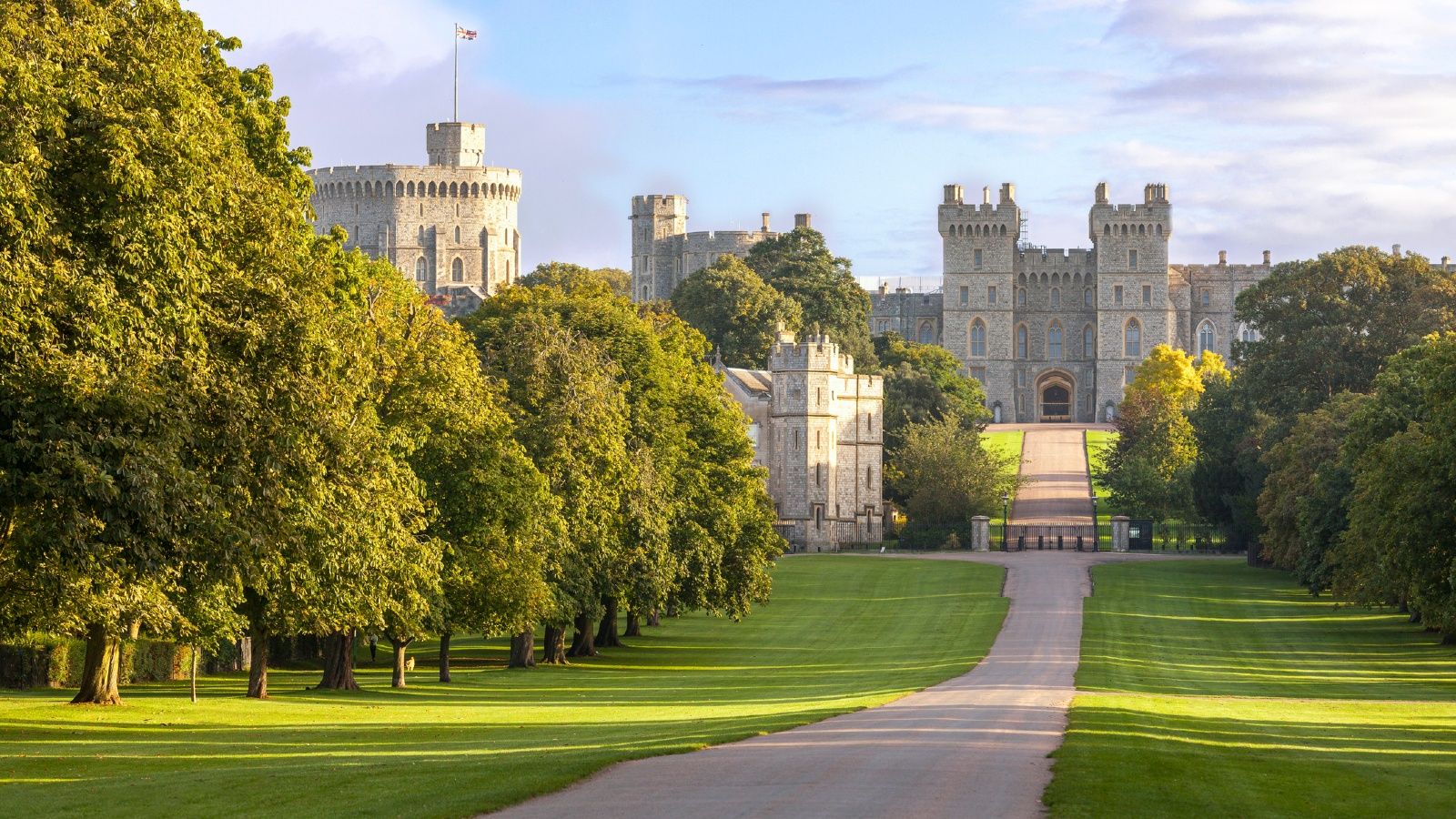
UK castles are some of the most impressive and beautiful in the world, so why not pay a visit to one this year? Whether you're booking a getaway to see what the UK has to offer or are a UK resident planning a day trip, these culturally and historically significant castles should definitely be on your must-see list.
The castles of the British Isles tower over some of our most spectacular landscapes, from castles in Scotland steeped in grandeur to pretty châteaus straight from a French fairytale, and each has a unique story. When visiting some of these majestic castles, you'll get insight into some of the most fascinating history England has to offer.
By Helena Cartwright

1. HIGHCLERE CASTLE
Location: Hampshire, RG20 9RN | Website: highclerecastle.co.uk
Downton Abbey fans will recognize Highclere Castle as the stately home of the aristocratic Crawley family. The Grade I-listed house was once the site of a medieval palace but was transformed in the 19th century by Sir Charles Barry—architect of London’s Houses of Parliament. The castle is set in 1,000 acres of parkland that was designed by landscape gardener Capability Brown and is also home to an impressive exhibition of Egyptian artifacts.
For a real treat, book in for the castle’s delightful afternoon tea, with sandwiches, scones, and a glass of bubbly.
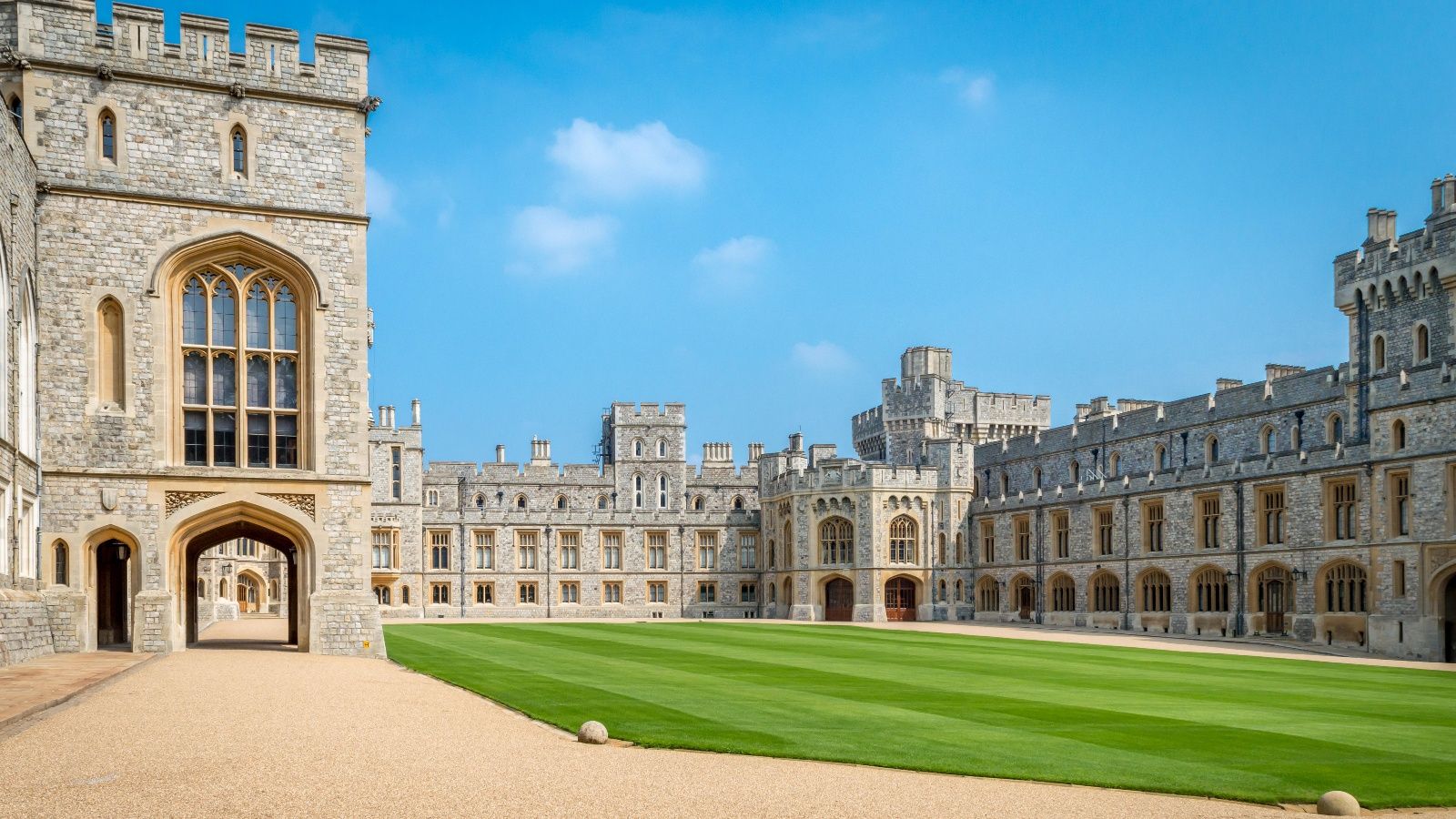
2. WINDSOR CASTLE
Location: Berkshire, SL4 1NJ | Website: rct.uk/visit/windsor-castle
A royal residence for more than 900 years, Windsor Castle is the world’s oldest and largest inhabited castle. To marvel at the castle’s full regal splendor, approach from the Long Walk, a three-mile tree-lined avenue that runs to the castle through Windsor Great Park, where 500 red deer roam.
Look out for the castle’s iconic Round Tower, which flies the Royal Standard when the Queen is in residence, and visit the elegant gothic masterpiece of St George’s Chapel in the Castle’s lower ward, where the Duke and Duchess of Sussex tied the knot in 2018.

3. BOLSOVER CASTLE
Location: Derbyshire, S44 6PR | Website: english-heritage.org.uk/visit/places/bolsover-castle/
Built on the site of a medieval fortress, the grand halls, fountains, and gardens of Bolsover Castle were always meant to impress. The Stuart mansion sits high on a ridge above the Vale of Scarsdale, with sweeping views across the Derbyshire countryside. Its interior is lavishly decorated, but Bolsover has also been voted English Heritage’s spookiest site, with staff reporting mysterious footsteps, slamming doors, muffled voices, and the ghost of a boy holding visitors’ hands.
The castle is home to an indoor riding school, where regular performances of classical dressage take place.
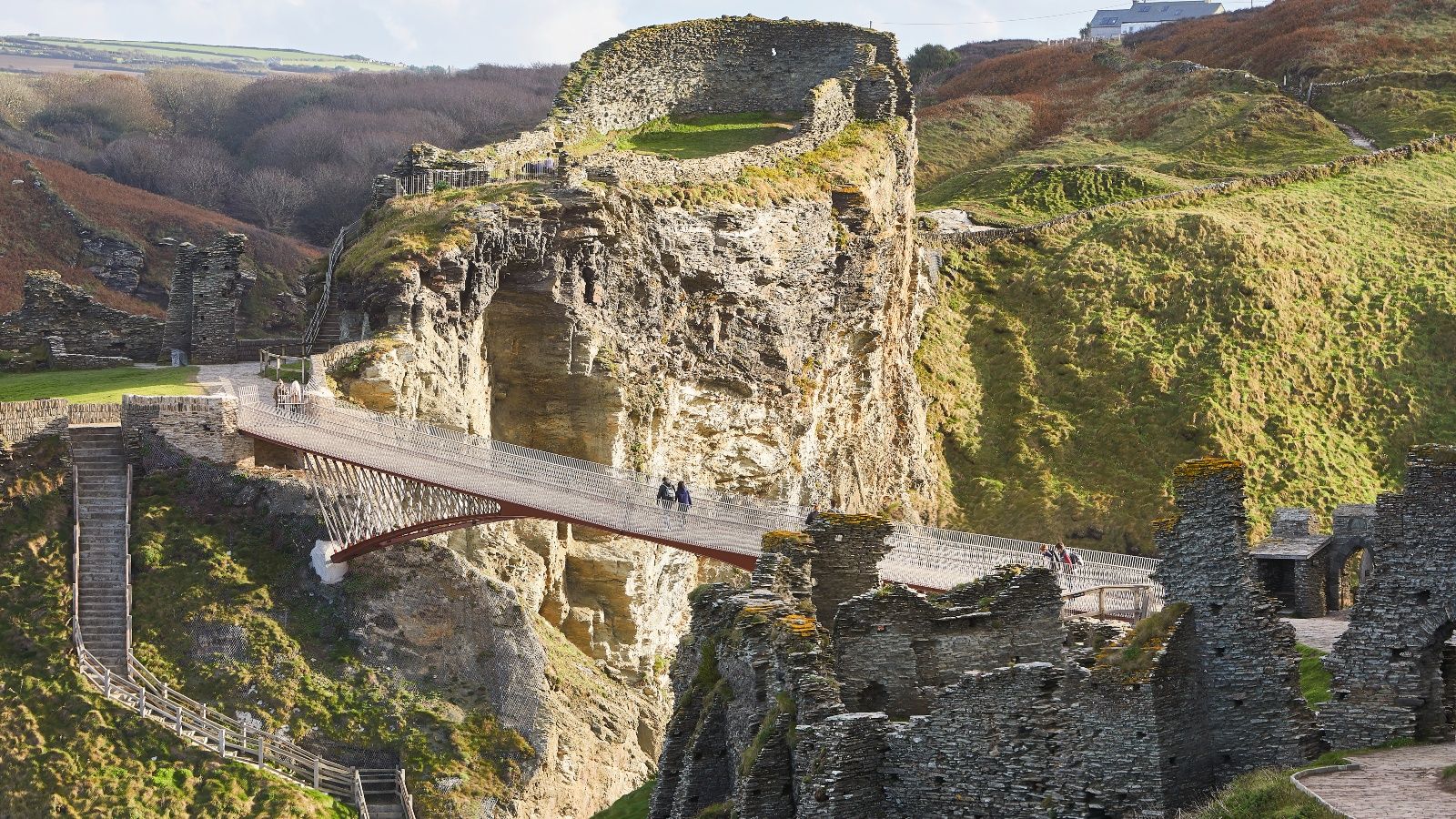
4. TINTAGEL CASTLE
Location: Cornwall, PL34 0HE | Website: https://www.english-heritage.org.uk/visit/places/tintagel-castle/
Tintagel Castle is shrouded in magic and mystery. Teetering on the windswept north Cornwall coast, the castle’s ruins sprawl from the mainland across a rocky precipice above the Atlantic Ocean.
From the early Middle Ages, the headland was a stronghold of Cornish kings, and their tales inspired the legend that King Arthur was born here. This led medieval nobleman Richard, Earl of Cornwall, to build a castle at the site. After exploring the castle, head down to the secluded sandy beach below, where kids can paddle in rock pools and explore the magical Merlin’s Cave.
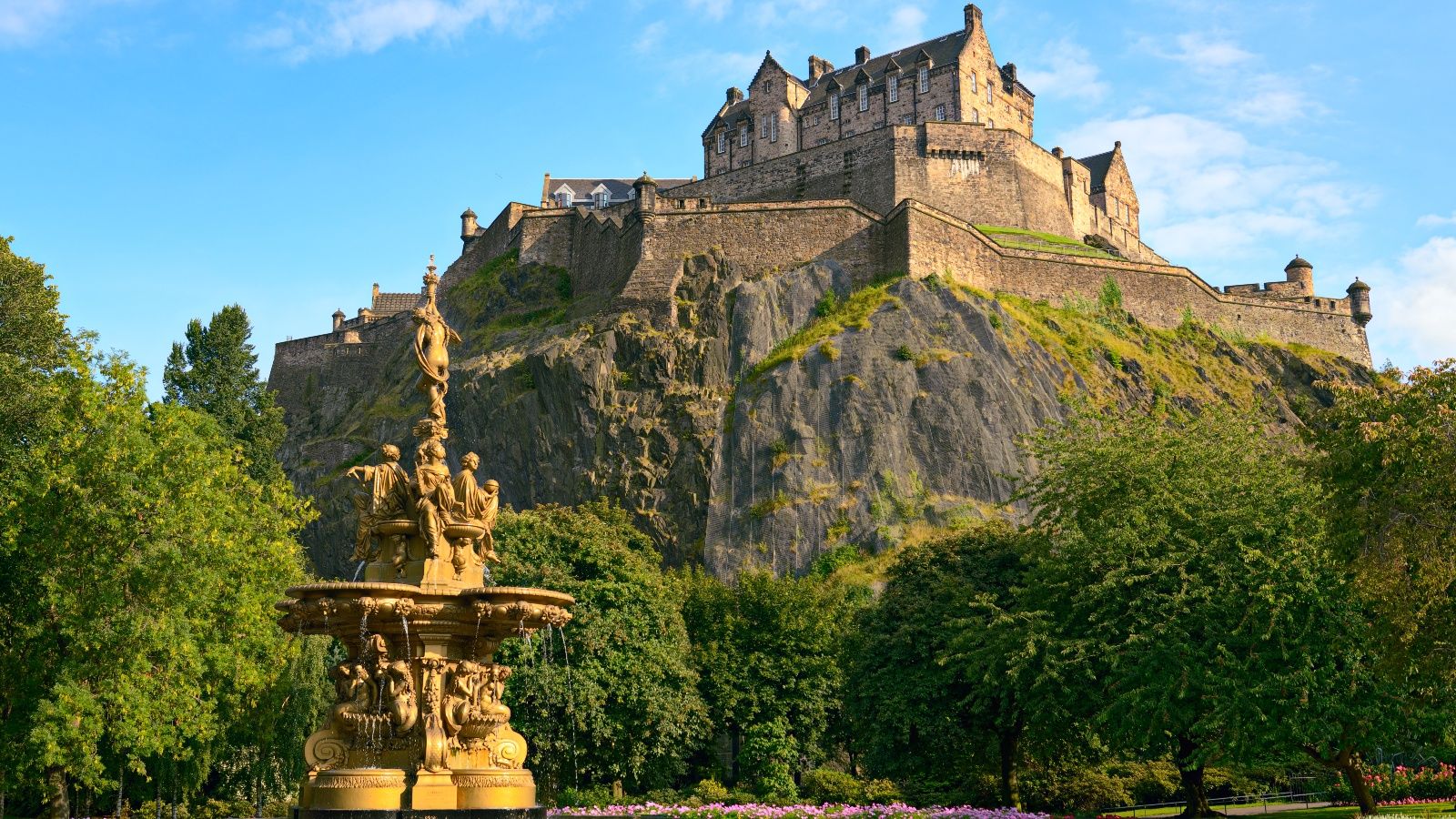
5. EDINBURGH CASTLE
Location: Midlothian, EH1 2NG | Website: edinburghcastle.scot
Perched upon a mighty volcanic rock in the heart of the Scottish capital, the towering walls of Edinburgh Castle cut a striking silhouette against the skyline. The 12th-century castle was a key fortress of the Scottish Kingdom and has the dubious honor of being the most besieged place in Britain.
The castle’s lofty position provides spectacular views that stretch to the wild hills beyond Edinburgh, while the castle is also home to the nation’s crown jewels, the Honours of Scotland. Finish a visit at the castle tea rooms, to enjoy cakes or local specialties such as haggis and cured Scottish salmon. Grab a window seat for views across the city.
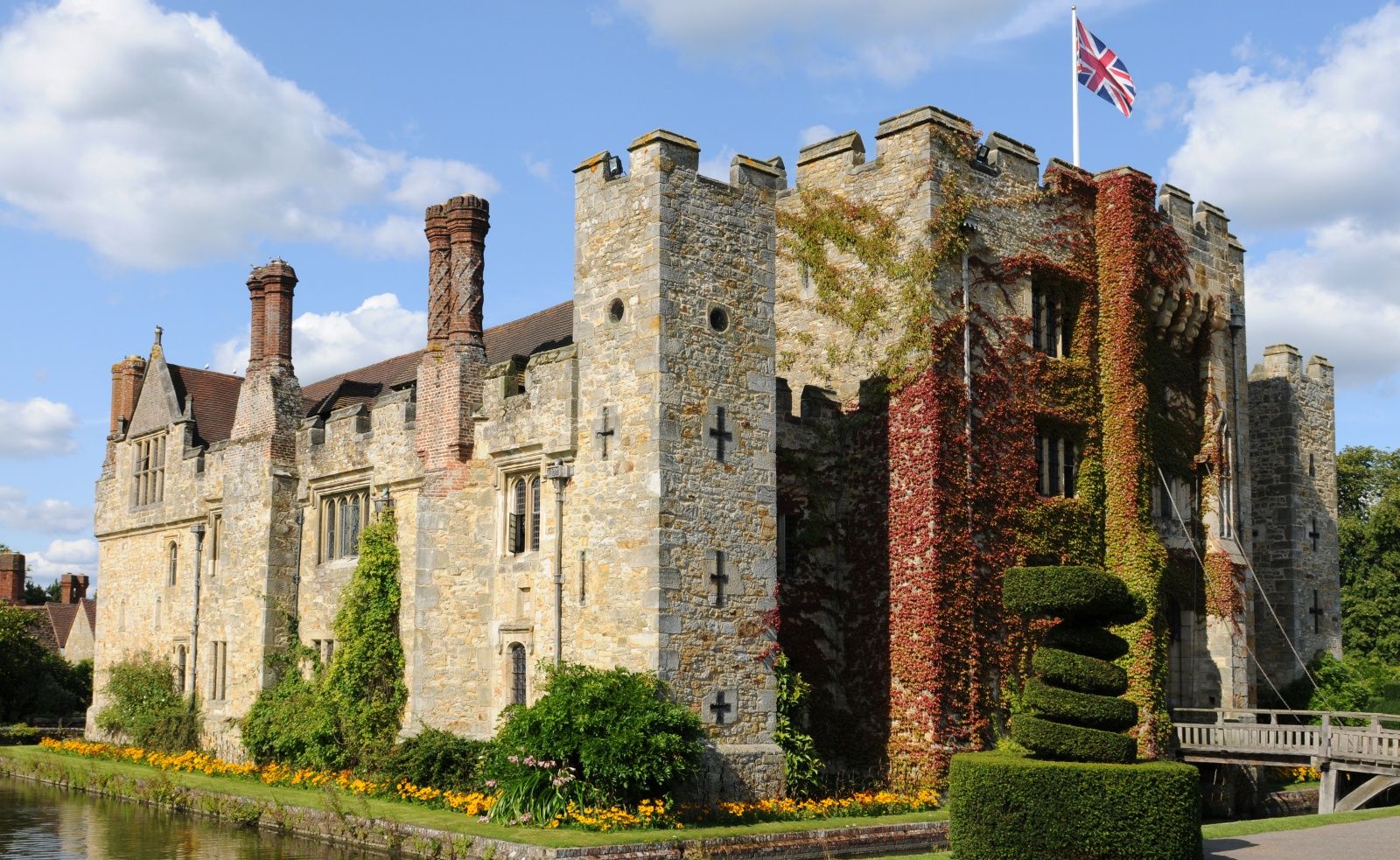
6. HEVER CASTLE
Location: Kent, TN8 7NG | Website: hevercastle.co.uk
Set within 125 acres of Kent countryside, Hever ticks all the ‘fairytale castle’ boxes—and it's a great place for a UK staycation too.
The 13th-century building is surrounded by a large medieval moat, with a wooden drawbridge leading to a towering stone gatehouse. The castle was the childhood home of Henry VIII’s second wife, Anne Boleyn, and Tudor tapestries and portraits decorate its grand halls. The gardens feature a 100-year-old yew maze, boating lake, and mock Tudor village. Guests can stay overnight in a luxurious 5-star B&B within the castle grounds.
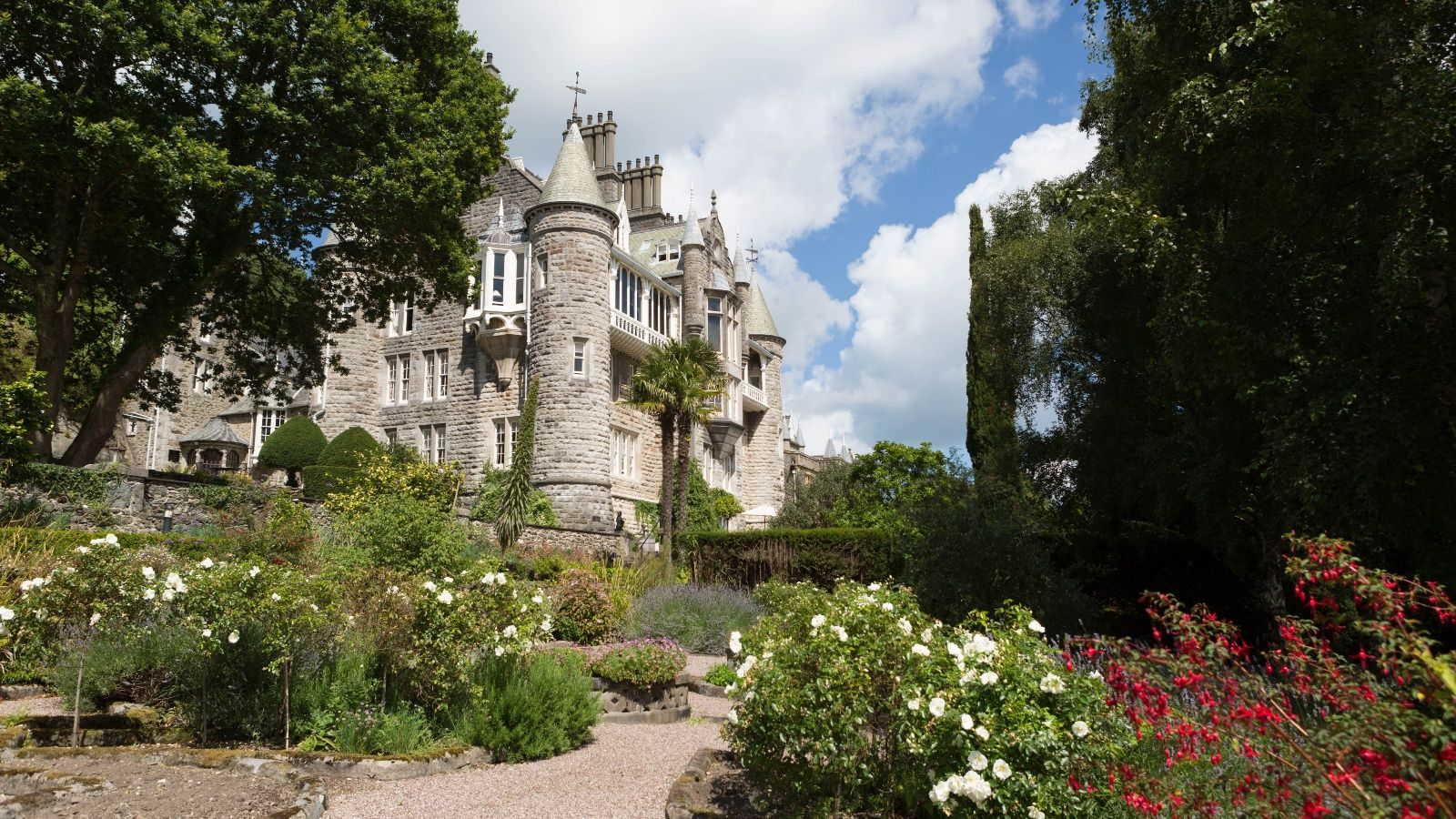
7. CHATEAU RHIANFA
Location: Isle of Anglesey, LL59 5NS | Website: chateaurhianfa.co.uk
The pointed turrets of Château Rhianfa emerge in glorious fashion from the hills of north Wales and are inspired by the chateaux of France’s Loire Valley.
Its ornate architecture, built in the mid 19th century, seems curiously at home on the Welsh island of Anglesey. The chateau enjoys spectacular views across the Menai Strait to the towering peaks of Snowdonia and has been tastefully converted into a stylish hotel and B&B, with 27 bedrooms and an award-winning restaurant too.
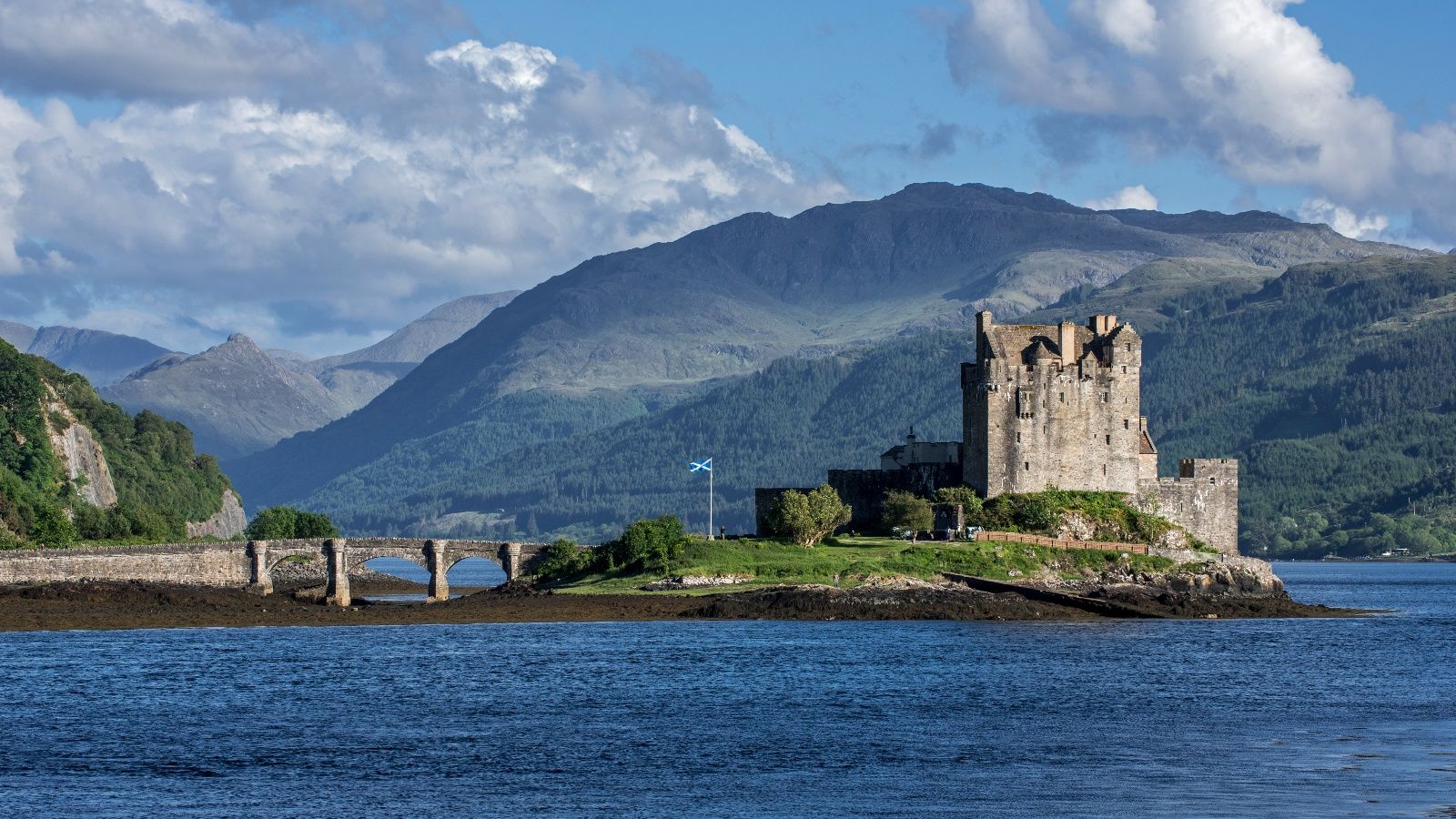
8. EILEAN DONAN CASTLE
Location: Western Highlands, IV40 8DX | Website: eileandonancastle.com
This picturesque castle is one of the most iconic sights in the Scottish Highlands. Perched on a tiny island at the meeting point of three great lochs, the castle looks out to the Isle of Skye and over the wild, forested mountains of Kintail. It's without a doubt one of the most beautiful places in Scotland.
The original 13th-century castle was all but destroyed during the 1719 Jacobite uprising, but was restored to its former glory in the early 20th century, with the addition of a magnificent stone bridge that connects the island to the mainland.
Book into the charming Eilean Donan Cottage that overlooks the castle, an ideal base for exploring the spectacular Highland surroundings.
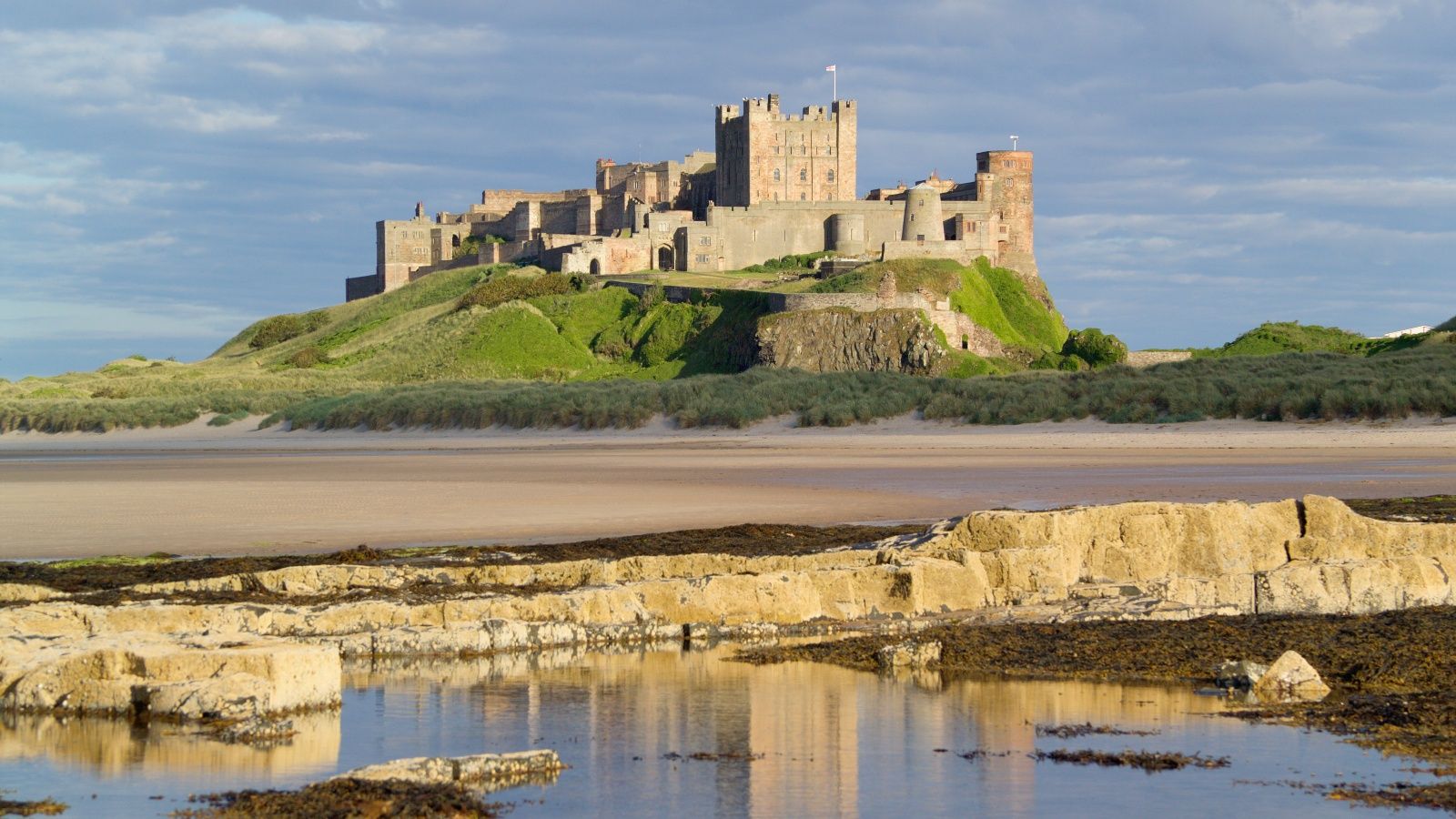
9. BAMBURGH CASTLE
Location: Northumbria, NE69 7DF | Website: bamburghcastle.com
Once the royal seat of the Kingdom of Northumbria, Bamburgh was a fearsome stronghold throughout the Middle Ages. The Norman-built fortress spans nine acres, and rests upon a rocky volcanic crag, with views stretching down the windswept Northumberland coast and across the North Sea to the Farne Islands.
Its fortified walls—11ft thick at points—were a formidable line of defense against marauding armies. Today, you can enjoy a more serene stay in the castle’s elegant, turreted guard towers, 150ft above the white sands of Bamburgh Beach.

10. WARWICK CASTLE
Location: Warwick, CV34 4QU| Website: warwick-castle.com
On the banks of the winding Avon sits the towering medieval fortress of Warwick Castle. With a history dating back 1,000 years, the Midlands site was first home to a wooden fort built by William the Conqueror and was redesigned with stone ramparts and portcullis during the 12th century.
Today, the castle’s medieval history has been brought vividly to life, and kids will love exploring the Horrible Histories Maze, castle dungeons, replica trebuchet, and impressive archery exhibition. There’s even medieval-themed glamping—perfect for a family getaway on site.
More for You
Stephen Hawking once gave a simple answer as to whether there was a God
Miley Cyrus Is Being Praised For Her Seriously Refreshing Comments About Not Seeing Other Artists As Her “Opponents” Or "Competition"
“He wanted to sit on the porch and smoke his pipe”: Clint Eastwood’s Comment About His Favorite Movie Villain Should Put Thanos on Oscar Winner’s List
Unplugged: 12 Items You Should Unplug Now To See A Drastic Change in Your Utility Bill
Ted Cruz Celebrates Coast Guard Ending 'Indefensible Practice'

Trump judge faces a ‘serious problem’ if court returns guilty verdict: John Yoo
'That's a tall order': This Atlanta college student wants a grandparent to buy her a house. The Ramsey Show brings her crashing back down to reality
Fashion Nova's 'body positive' campaign goes viral for all the wrong reasons
'The Voice' Fans Freak Out as Adam Levine and Kelsea Ballerini Are Confirmed as Coaches
Spy agency issues urgent warning to billions of smartphone users to avoid being spied on
'Trump's friends just blocked the right to contraception': Dems torch GOP over Senate vote
VIDEO: Florida Supreme Court upholds DeSantis’ suspension of former State Attorney Monique Worrell
12 Uncomfortable Truths About Christianity That People Aren't Ready to Hear
Indiana Legend Reggie Miller Scolds Caitlin Clark Amid WNBA Controversy
If You've Been Searching For Solutions To Daily Annoyances, Look No Further Than These 27 Items
Yes, You Can Lose Your Social Security Benefits. Here Are 3 Ways It Can Happen
‘America’s Got Talent’ singing janitor thought Heidi Klum didn’t like him before she hit Golden Buzzer
Which Fast Food Chain Has The Best Burger?
Top 10 The Big Bang Theory Jokes That Will NEVER Get Old
How to Discipline a Cat
Plan Your Trip to England: Best of England Tourism

England, United Kingdom
Essential england.

Dig Into England

England Is Great For
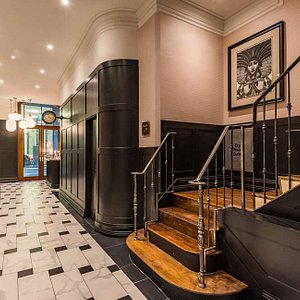
Art & history
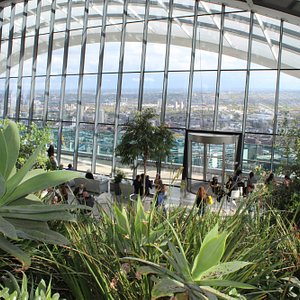
Historic sites
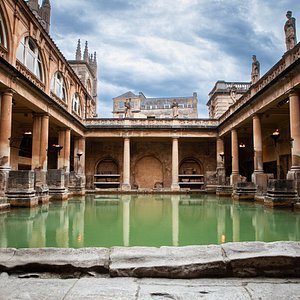
Eat & drink

Cookies on GOV.UK
We use some essential cookies to make this website work.
We’d like to set additional cookies to understand how you use GOV.UK, remember your settings and improve government services.
We also use cookies set by other sites to help us deliver content from their services.
You have accepted additional cookies. You can change your cookie settings at any time.
You have rejected additional cookies. You can change your cookie settings at any time.
Register to vote Register by 18 June to vote in the General Election on 4 July.
- Environment
- Wildlife, animals, biodiversity and ecosystems
- Animal and plant health
Bird flu (avian influenza): latest situation in England
Find out about the latest bird flu situation in England and guidance for bird keepers and the public.
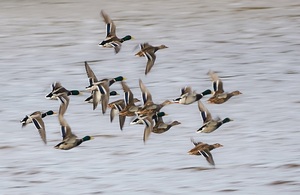
Latest situation
- All bird flu cases and disease zones
Bird flu guidance
Bird gatherings, latest gov.uk news stories, risk levels and outbreak assessments, wild mammals, bird flu webinars.
- Defra policies and contingency plans
Bird flu legislation
Take action to prevent bird flu and stop it spreading and be vigilant for signs of disease to keep your birds safe.
In the United Kingdom, the following number of cases of highly pathogenic avian influenza ( HPAI ) have been confirmed since 1 October 2023:
- 4 cases in England (298 since October 2021)
- 2 cases in Scotland (51 since October 2021)
- 0 cases in Wales (15 since October 2021)
- 0 cases in Northern Ireland (7 since October 2021)
There was one confirmed case of low pathogenic avian influenza ( LPAI ) H7N3. This case was confirmed in Scotland on 20 March 2023 .
Update 26 April
From 26 April 2023, gatherings of all poultry and other captive birds, including ducks, geese and swans are permitted. You need to follow the requirements of the poultry gathering general licence and notify the Animal and Plant Health Agency (APHA) at least 7 days before the event.
Zonal freedom from highly pathogenic avian influenza for Great Britain
The UK has self-declared zonal freedom from highly pathogenic avian influenza for Great Britain with effect from 29 March 2024. This is in line with World Organisation for Animal Health (WOAH) rules.
This follows Northern Ireland declaring itself free on 31 March 2023.
The UK does not currently have outbreaks of HPAI in poultry or other captive birds. The current risk to poultry from HPAI H5 in Great Britain is low . However, HPAI H5N1 continues to be found in wild birds in Great Britain and across Europe with outbreaks occurring in poultry and other captive birds in several countries in Europe.
Keepers should remain vigilant and practice stringent biosecurity to protect the health and welfare of their birds. Find out how to protect your birds in our biosecurity guidance .
New registration requirements for bird keepers in Great Britain
On 19 March the government announced new measures to help protect the poultry sector from bird flu .
All bird flu cases and disease control zones
There are no current disease control zones in England.
Find details of all bird flu cases and disease zones in England .
Find details of bird flu cases in Scotland , cases in Wales and cases in Northern Ireland .
Find out how to:
- spot and report bird flu in poultry and other captive birds
- report dead wild birds
- prevent bird flu and stop it spreading
- follow the rules in disease zones
- check if you need a movement licence and how to apply
- house your birds safely
- follow the rules if you keep racing pigeons, birds of prey and other captive birds
Find out when game birds are kept or wild and the rules you need to follow if you keep, release or catch them up.
You can read guidance about:
- how to keep other pets safe from bird flu, such as cats and dogs
- how bird flu spreads in wild birds and wild mammals, and how the government monitors it
From 12.00 on 26 April, gatherings of all types of poultry and other captive birds including gatherings of anseriformes (ducks, geese and swans) are permitted. You need to follow the requirements of the poultry gathering general licence and notify the Animal and Plant Health Agency (APHA) at least 7 days before the event.
The change has been introduced following a reduction in the wild bird bird risk levels and consequent reduction in risk associated with shows and gatherings.
You can read the updated risk assessment on the likelihood of spread of highly pathogenic avian influenza H5N1 associated with bird fairs, shows, markets, sales and other gatherings .
You cannot vaccinate poultry or most captive birds against bird flu in England.
You can only vaccinate zoo birds in England if you meet eligibility criteria and get authorisation from APHA. Only zoos or collections holding a current zoo licence can apply for vaccination .
Defra continues to invest in bird flu research and monitors the situation globally.
We work with the Veterinary Medicines Directorate (VMD) to monitor the development of vaccines for birds.
Bird keepers must maintain scrupulous biosecurity standards as housing measures set to be lifted .
The risk of highly pathogenic avian influenza ( HPAI ) H5 in wild birds in Great Britain is assessed as low (event is rare but does occur).
The risk of poultry exposure to HPAI H5 in Great Britain is assessed as:
- low (event is rare but does occur) (with medium uncertainty) where there are substantial biosecurity breaches and poor biosecurity
- low (event is rare but does occur) (with low uncertainty) where good biosecurity is applied
Find details of the evidence that supported these decisions in the:
- risk and outbreak assessments
- outbreak epidemiology reports
- weekly reports of findings of bird flu in wild birds in Great Britain
- findings of bird flu in non-avian wildlife
- findings of bird flu in captive mammals
The UK Health Security Agency ( UKHSA ) advise that bird flu is primarily a disease of birds and the risk to the general public’s health is very low.
The Food Standards Agency ( FSA ) has said bird flu poses a very low food safety risk for UK consumers. Properly cooked poultry and poultry products, including eggs, are safe to eat.
Find out how to report dead wild birds .
Defra has set out practical information to support land managers, the public and ornithological and environmental organisations in their response to the growing threat of bird flu.
The mitigation strategy for avian influenza in wild birds in England and Wales explains how these groups, together with the government and its delivery partners, can reduce the impact on wild bird populations whilst protecting public health, the wider environment and the rural economy.
Landowners, local authorities and other organisations can download and print bird flu posters to display on site when there is a risk of bird flu or if bird flu has been detected in the area.
- interactive map of reported wild bird mortality and findings of bird flu in wild birds in Great Britain
- interactive dashboard of findings of bird flu in wild birds in Great Britain
- weekly reports of HPAI findings in wild birds in Great Britain
You can find out more about:
- the collection thresholds for dead wild birds with suspected bird flu
Feeding wild birds
You can feed wild birds but always wash your hands with soap and water afterwards. Avoid areas that have premises where poultry or captive birds are kept. Wild birds can spread bird flu to captive birds.
If you’re in an avian influenza prevention zone ( AIPZ ) you cannot feed wild gamebirds within 500m of a premises with more than 500 poultry or captive birds. Check if you’re in a zone on the bird flu zone map and find out more in the guidance on rules if you keep game birds .
If you feed wild birds in your garden, read advice from the British Trust for Ornithology (BTO) to keep feeders and water baths clean . This will help to stop bird flu and other diseases spreading between different birds.
The UK Health Security Agency has said that the risk to the public from this bird flu strain is very low. It mainly affects birds.
Do not touch or move any dead or sick wild birds – find out how to report them .
Wash your hands thoroughly with soap and water if you touch wild bird faeces or feathers. For more advice go to the NHS website .
Avian influenza (bird flu) viruses can also infect mammals.
Find out how we monitor the risk of avian influenza infection in wild mammals .
Our interactive map shows findings of influenza of avian origin in wild mammals in Great Britain .
Influenza of avian origin in mammals is notifiable in both wild and kept mammals.
You must report it immediately if you examine or inspect any wild or kept mammal, or analyse samples from any wild or kept mammal or mammal carcase and:
- suspect the presence of influenza of avian origin
- detect evidence of influenza A virus or antibodies to influenza A virus
Report it immediately by calling:
- 03000 200 301 if you’re in England
- 03003 038 268 if you’re in Wales
- your local Field Services Office if you’re in Scotland
If you do not report it, you’re breaking the law.
Whether you have pet birds, commercial flocks or just a few birds in a backyard flock, the avian influenza ‘stop the spread’ webinars explain what you can do to protect your birds.
Defra policies and contingency plans
Defra controls cases of bird flu by following the:
- contingency plan for exotic notifiable diseases
- notifiable avian disease control strategy
The legislation in England includes:
- The Avian Influenza and Influenza of Avian Origin in Mammals (England) (No.2) Order 2006
- The Avian Influenza and Influenza of Avian Origin in Mammals (Amendment) (England) Order 2022
- The Exotic Disease (Amendment) (England) (EU Exit) Regulations 2018
- The Exotic Animal Disease (Amendment) (England) Order 2021
- The Exotic Animal Disease (Amendment) (England) Order 2022
- The Exotic Disease (Amendment) (England) Order 2023
- The Exotic Disease (Amendment) (England) Order 2024
- The Avian Influenza (H5N1 in Wild Birds) (England) Order 2006
- The Avian Influenza (H5N1 in Wild Birds) (England) (Amendment) Order 2021
- The Avian Influenza (Preventive Measures) (England) Regulations 2006
- The Transport of Animals (Cleansing and Disinfection) (England) (No. 3) Order 2003
- The Diseases of Animals (Approved Disinfectants) (England) Order 2007
- The Avian Influenza (Vaccination) (England) Regulations 2006
For Scotland go to the Scottish Government website.
For Wales go to the Welsh Government website.
For Northern Ireland go to the DAERA-NI website.
Image on this page shows a group of ducks flying. Credit: Jari Hytönen.
Share this page
The following links open in a new tab
- Share on Facebook (opens in new tab)
- Share on Twitter (opens in new tab)
From 26 April 2023, gatherings of all poultry and other captive birds, including ducks, geese and swans are permitted. You need to follow the requirements of the poultry gathering general licence and notify the Animal and Plant Health Agency (APHA) at least 7 days before the event.
Updated the 'Risk levels' section. The risk of highly pathogenic avian influenza (HPAI) H5 in wild birds in Great Britain is assessed as low (event is rare but does occur).
Updated the latest situation. The UK has self-declared zonal freedom from highly pathogenic avian influenza for Great Britain with effect from 29 March 2024.
Updated the latest situation. Highly pathogenic avian influenza (HPAI) H5N1 was confirmed in commercial poultry on 14 February 2024 at a premises near Hutton Cranswick, East Yorkshire, Yorkshire (AIV 2024/01). Following successful completion of disease control activities and surveillance in the zone, the surveillance zone has been revoked. Also included a link to information about registration requirements.
Updated the latest situation. Highly pathogenic avian influenza (HPAI) H5N1 was confirmed in commercial poultry on 14 February 2024 at a premises near Hutton Cranswick, East Yorkshire, Yorkshire (AIV 2024/01). Following successful completion of disease control activities and surveillance in the zone, the area that formed the protection zone has become part of the surveillance zone.
Updated the latest situation. Galliforme birds from premises located in Wales can now attend poultry gatherings in England, provided they and the gathering follow and meet all the requirements of the poultry gathering general licence for England.
Highly pathogenic avian influenza (HPAI) H5N1 was confirmed in commercial poultry on 14 February 2024 at a premises near Hutton Cranswick, East Yorkshire, Yorkshire (AIV 2024/01). A 3km protection zone and a 10km surveillance zone have been declared around the premises.
Updated guidance on bird gatherings. The general licence for poultry gatherings in England has been amended. Galliforme poultry kept at registered premises in Scotland can attend shows and gatherings held in England from 5 February 2024.
Updated the uncertainty associated with the risk of poultry exposure to HPAI H5 in Great Britain. The risk is assessed as low (event is rare but does occur) (with medium uncertainty) where there are substantial biosecurity breaches and poor biosecurity.
Highly pathogenic avian influenza (HPAI) H5N1 was confirmed in commercial poultry on 27 November 2023 at a premises near Wooler, Berwick-Upon-Tweed, Northumberland (AIV 2023/57). Following successful completion of disease control activities and surveillance within the zone, the 10km surveillance zone was revoked on 2 January 2024. 1 January update: Highly pathogenic avian influenza (HPAI) H5N1 was confirmed in commercial poultry on 29 November 2023 at a premises near Cranbrook, East Devon, Devon (AIV 2023/58). Following successful completion of disease control activities and surveillance within the zone, the 10km surveillance zone was revoked on 1 January 2024. Added a link in the Bird flu legislation section to The Exotic Disease (Amendment) (England) Order 2023. The legislation (among others) amends the Avian Influenza and Influenza of Avian Origin in Mammals (England) (No.2) Order 2006. The main changes relate to the management of influenza of avian origin in mammals.
Update 28 December: Highly pathogenic avian influenza (HPAI) H5N1 was confirmed in commercial poultry on 29 November 2023 at a premises near Cranbrook, East Devon, Devon (AIV 2023/58). Following successful completion of disease control activities and surveillance within the zone, the 3km protection zone has ended and the area that formed the protection zone becomes part of the surveillance zone.
Updated the latest situation section. Highly pathogenic avian influenza (HPAI) H5N1 was confirmed in commercial poultry on 27 November 2023 at a premises near Wooler, Berwick-Upon-Tweed, Northumberland (AIV 2023/57). Following successful completion of disease control activities and surveillance within the zone, the 3km protection zone has ended and the area that formed the protection zone becomes part of the surveillance zone.
Highly pathogenic avian influenza (HPAI) H5N1 was confirmed in commercial poultry on 9 November 2023 at a premises near Donington, South Holland, Lincolnshire (AIV 2023/55). Following successful completion of disease control activities and surveillance within the zone, the 10km surveillance zone has been revoked.
Updated the uncertainty associated with the risk of poultry exposure to HPAI H5 in Great Britain. The risk is assessed as low (event is rare but does occur) (with high uncertainty) where there are substantial biosecurity breaches and poor biosecurity.
Highly pathogenic avian influenza (HPAI) H5N1 was confirmed in commercial poultry on 9 November 2023 at a premises near Donington, South Holland, Lincolnshire (AIV 2023/55). Following successful completion of disease control activities and surveillance within the zone, the 3km protection zone has been lifted and the area that formed the protection zone becomes part of the surveillance zone.
Highly pathogenic avian influenza (HPAI) H5N1 was confirmed in commercial poultry on 29 November 2023 at a premises near Cranbrook, East Devon, Devon (AIV 2023/58). A 3km protection zone and a 10km surveillance zone have been declared around the premises.
Highly pathogenic avian influenza (HPAI) H5N1 was confirmed in commercial poultry on 27 November 2023 at a premises near Wooler, Berwick-Upon-Tweed, Northumberland. A 3km protection zone and a 10km surveillance zone have been declared around the premises.
Highly pathogenic avian influenza (HPAI) H5N1 was confirmed in commercial poultry on 9 November 2023 at a premises near Donington, South Holland, Lincolnshire (AIV 2023/55). A 3km protection zone and a 10km surveillance zone have been declared around the premises.
Following a reduction in the number of findings of highly pathogenic avian influenza (HPAI) in wild birds the risk of HPAI H5 in wild birds has been reduced from high (event occurs very often) to medium (event occurs regularly). The risk of HPAI H5 remains low (event is rare but does occur) in poultry.
Updated the latest situation section with current case numbers.
We have today launched a new interactive map of reported wild bird mortality and findings of avian influenza virus (bird flu) in wild birds and wild mammals. We have also launched a new interactive dashboard allowing you to explore findings of avian influenza in wild birds from the Animal and Plant Health Agency’s (APHA) surveillance programme.
Highly pathogenic avian influenza (HPAI) H5N1 was confirmed in commercial poultry on 8 September 2023 at a premises near Warrington, South Warrington, Cheshire (AIV 2023/49). Following successful completion of disease control activities and surveillance within the zone, the 10km surveillance zone has been lifted.
Highly pathogenic avian influenza (HPAI) H5N1 was confirmed in commercial poultry on 7 September 2023 at a premises near Uttoxeter, East Staffordshire, Staffordshire (AIV 2023/48). Following successful completion of disease control activities and surveillance within the zone, the 10km surveillance zone has been lifted.
HPAI H5N1 was confirmed in commercial poultry on 8 September 2023 at a premises near Warrington, South Warrington, Cheshire (AIV 2023/49). Following successful completion of disease control activities and surveillance within the zone, the 3km protection zone has been lifted and the area that formed the protection zone becomes part of the surveillance zone.
Highly pathogenic avian influenza (HPAI) H5N1 was confirmed in commercial poultry on 7 September 2023 at a premises near Uttoxeter, East Staffordshire, Staffordshire (AIV 2023/48). Following successful completion of disease control activities and surveillance within the zone, the 3km protection zone has been lifted and the area that formed the protection zone becomes part of the surveillance zone.
Updated the number of cases in Scotland to 38.
Updated the number of cases in Scotland to 37.
Updated the number of cases in Scotland to 35.
Highly pathogenic avian influenza (HPAI) H5N1 was confirmed in commercial poultry on 8 September 2023 at a premises near Warrington, South Warrington, Cheshire (AIV 2023/49). A 3km protection zone and 10km surveillance zone has been declared around the premises.
HPAI H5N1 was confirmed in commercial poultry on 7 September 2023 at a premises near Uttoxeter, East Staffordshire, Staffordshire (AIV 2023/48). A 3km protection zone and 10km surveillance zone has been declared around the premises.
Highly pathogenic avian influenza (HPAI) H5N1 was confirmed in commercial poultry on 20 July 2023 at a premises near Elham, Folkestone and Hythe, Kent (AIV 2023/37). Following successful completion of disease control activities and surveillance within the zone, the surveillance zone has been revoked.
Updated the latest situation. From 23 August 2023 gatherings of galliforme poultry and galliforme birds are permitted. You must follow and meet the conditions of the general licences and notify APHA of the event.
Updated the number of cases in Scotland to 32.
Highly pathogenic avian influenza (HPAI) H5N1 was confirmed in commercial poultry on 20 July 2023 at a premises near Elham, Folkestone and Hythe, Kent (AIV 2023/37). Following successful completion of disease control activities and surveillance within the zone, the 3km protection zone has been lifted and the area that formed the protection zone becomes part of the surveillance zone.
Updated the number of cases in Scotland to 31.
Updated the number of cases in Scotland from 27 to 30. Added a link under the guidance section to information about keeping other pets safe from bird flu.
Updated the number of cases in Scotland from 24 to 27.
Highly pathogenic avian influenza (HPAI) H5N1 was confirmed in commercial poultry on 2 July 2023 at a premises near Bootle, Copeland, Cumbria (AIV 2023/34). Following successful completion of disease control activities and surveillance within the zone, the 10km surveillance zone has been revoked.
Highly pathogenic avian influenza (HPAI) H5N1 was confirmed in commercial poultry on 2 July 2023 at a premises near Bootle, Copeland, Cumbria (AIV 2023/34). Following successful completion of disease control activities and surveillance within the zone, the 3km protection zone has been lifted and the area that formed the protection zone becomes part of the surveillance zone.
Highly pathogenic avian influenza (HPAI) H5N1 was confirmed in other captive birds on 30 June 2023 at a premises near Angmering, Arun, West Sussex (AIV 2023/33). Following successful completion of disease control activities and surveillance in the zone, the 3km captive bird (monitoring) controlled zone has been revoked.
Highly pathogenic avian influenza (HPAI) H5N1 was confirmed in commercial poultry on 20 July 2023 at a premises near Elham, Folkestone and Hythe, Kent (AIV 2023/37). A 3km protection zone and 10km surveillance zone has been declared around the premises.
We've updated the number of avian influenza cases in Scotland since 1 October 2022 to 24 cases.
We've updated the number of avian influenza cases in Scotland since 1 October 2022 to 23 cases.
The risk of avian influenza for all poultry has reduced to low (meaning the event is rare but does occur) and the avian influenza prevention zones (AIPZ) for poultry and captive birds in England, Wales and Scotland have been lifted from midday on 4 July 2023.
Highly pathogenic avian influenza (HPAI) H5N1 was confirmed in commercial poultry at a premises near Bootle, Copeland, Cumbria. A 3km protection zone and 10km surveillance zone have been declared around the premises.
Updated 30 June 2023: Highly pathogenic avian influenza (HPAI) H5N1 was confirmed in other captive birds on 30 June 2023 at a premises near Angmering, Arun, West Sussex (AIV 2023/33). A 3km captive bird (monitoring) controlled zone has been declared around the premises.
Highly pathogenic avian influenza (HPAI) H5N1 was confirmed in commercial poultry at the following: • premises near Scunthorpe, North Lincolnshire, Lincolnshire (AIV 2023/29) • second premises near Scunthorpe, North Lincolnshire, Lincolnshire (AIV 2023/31) Following successful completion of disease control activities and surveillance in the zones, the 10km surveillance zones around both premises have been revoked.
Highly pathogenic avian influenza (HPAI) H5N1 was confirmed in commercial poultry on 18 May 2023 at a premises near Uckfield, Wealden, East Sussex (AIV 2023/30). Following successful completion of disease control activities and surveillance in the zone, the 10km surveillance zone has been revoked.
Highly pathogenic avian influenza (HPAI) H5N1 was confirmed in commercial poultry at the following: - premises near Scunthorpe, North Lincolnshire, Lincolnshire (AIV 2023/29) - second premises near Scunthorpe, North Lincolnshire, Lincolnshire (AIV 2023/31) Following successful completion of disease control activities and surveillance in the zones, the 3km protection zone has ended and the area that formed the zones becomes part of the surveillance zone around both premises.
Updated the latest situation with an update for case AIV 2023/30. The 3km protection zone has ended and the area that formed that zone becomes part of the surveillance zone.
Highly pathogenic avian influenza (HPAI) H5N1 was confirmed on 23 April 2023 at a premises near Montgomery, Powys, Wales (AIV 2023/23). Following successful completion of disease control activities and surveillance within the zone, the part of the 10km surveillance zone that extends into England has been revoked.
Following successful completion of disease control activities and surveillance in the zone, the 10km surveillance zone has now been lifted from a premises near Cantley, Doncaster, South Yorkshire (AIV 2023/28).
Highly pathogenic avian influenza (HPAI) H5N1 was confirmed in commercial poultry on 29 April 2023 at a premises near Cantley, Doncaster, South Yorkshire (AIV 2023/28). Following successful completion of disease control activities and surveillance in the zone, the 3km protection zone has ended and the area that formed the protection zone becomes part of the 10 km surveillance zone around this premises.
Highly pathogenic avian influenza (HPAI) H5N1 was confirmed in commercial poultry at a second premises near Scunthorpe, North Lincolnshire, Lincolnshire (AIV 2023/31). A 3km protection zone and a 10 km surveillance zone have been declared around the premises.
Following successful completion of disease control activities and surveillance in the zones, the 3 km captive bird (monitoring) controlled zone has been revoked for a premises near Ringstead, North Northamptonshire, Northamptonshire (AIV 2023/27).
Highly pathogenic avian influenza (HPAI) H5N1 was confirmed on 18 May 2023 in commercial poultry at a premises near Uckfield, Wealden, East Sussex (AIV 2023/30). A 3km protection zone and a 10 km surveillance zone have been declared around the premises.
The Chief Veterinary Officer for Wales confirmed the presence of highly pathogenic avian influenza at a premises near Montgomery, Powys, Wales (AIV 2023/25) on 23 April 2023. Following successful completion of disease control activities and surveillance within the zone, the 3km protection zone in Wales has ended and the area that formed the zone becomes a surveillance zone. The part of the surveillance zone that extends into England remains in force.
Following successful completion of disease control activities and surveillance within the zones, the 3km protection zone has ended and the 10km surveillance zone around a premises near Newton Abbot, Teignbridge, Devon (AIV 2023/22) has been revoked.
Highly pathogenic avian influenza (HPAI) H5N1 was confirmed on 16 May 2023 in commercial poultry at a premises near Scunthorpe, North Lincolnshire, Lincolnshire (AIV 2023/29). A 3km protection zone and a 10 km surveillance zone have been declared around the premises. Following successful completion of disease control activity and surveillance within the zone, the residual surveillance zone associated with a premises near Beverley, East Riding of Yorkshire, Yorkshire (AIV 2022/139) has been revoked. Following successful completion of disease control activities and surveillance within the zones, the 10km surveillance zone around the premises near Leven, East Riding of Yorkshire, Yorkshire (AIV 2023/24) has been revoked.
Following successful completion of disease control activities and surveillance within the zone, the 3km captive bird (monitoring) controlled zone surrounding a premises near Leominster, North Herefordshire, Herefordshire (AIV2023/04) has been revoked.
Following successful completion of disease control activities and surveillance within the zones, the 3km protection zone has ended and the area becomes part of the 10km surveillance zone for the premises near Leven, East Riding of Yorkshire, Yorkshire (AIV 2023/24).
Following successful completion of disease control activity and surveillance in the zones, the 3km protection zone has ended and the 10km surveillance zone has been revoked for the premises near Southwaite, Eden, Cumbria (AIV 2023/20).
Highly pathogenic avian influenza (HPAI) H5N1 was confirmed in other captive birds on 29 April 2023 at a premises near Ringstead, North Northamptonshire, Northamptonshire (AIV 2023/27). A 3km captive bird (monitoring) controlled zone has been declared around the premises. Highly pathogenic avian influenza (HPAI) H5N1 was confirmed in commercial poultry on 29 April 2023 at a premises near Cantley, Doncaster, South Yorkshire (AIV 2023/28). A 3km protection zone and 10km surveillance zone have been declared around the premises. Following successful completion of disease control activities and surveillance within the zone, the 3km captive bird (monitoring) controlled zone surrounding a second premises near Appleby-in-Westmorland, Eden, Cumbria (AIV 2023/19) has been revoked.
To support the Notifiable Avian Disease Control Strategy for Great Britain and the Mitigation Strategy for Avian Influenza in Wild Birds in England and Wales, new guidance on case definitions, diagnostic testing and reporting obligations for avian influenza and influenza of avian origin have been published by Defra, Welsh Government and Scottish Government. Following successful completion of disease control activities and surveillance within the zone the 10km Surveillance Zone surrounding the premises near Woodhall Spa, East Lindsey, Lincolnshire (AIV 2022/148) has been revoked. Following successful completion of disease control activities and surveillance within the zone, the 3km captive bird (monitoring) controlled zone surrounding the premises near Metheringham, North Kesteven, Lincolnshire (AIV 2022/187) has been revoked. Following successful completion of disease control activities and surveillance within the zones, the 3km protection zone has ended and the 10km surveillance zone has been revoked surrounding the premises near Ruskington, North Kesteven, Lincolnshire (AIV 2022/211).
Following successful completion of disease control activities and surveillance in the zones, the 3 km captive bird (monitoring) controlled zone has been revoked for a premises near Colden Common, Winchester, Hampshire (AIV 2022/223).
Following successful completion of disease control activities and surveillance in the zones, the 3 km protection zone has ended and the 10km surveillance zone has been revoked for a premises near Thetford, Breckland, Norfolk (AIV 2023/18).
Following successful completion of disease control activities and surveillance, the 3 km captive bird (monitoring) controlled zone has been revoked for a premises near Bakewell, Derbyshire Dales, Derbyshire.
Highly Pathogenic Avian Influenza (HPAI) H5N1 was confirmed in commercial poultry at a premises near Montgomery, Powys, Wales on 23 April 2023 (AIV2023/25). All poultry on the premises will be humanely culled. This premises is in Wales but the disease control zone extends into England. A surveillance zone in England has been declared for the portion of the 10km surveillance zone surrounding the premises which extends into England. See the Welsh Government website for details of the protection zone and surveillance zone in Wales. Following successful completion of disease control activities and surveillance within the zone, the 10 km Surveillance Zone surrounding the premises near Hornsea, East Riding of Yorkshire, Yorkshire (AIV2022/229) has been revoked.
Following successful completion of disease control activities and surveillance in the zones, the 10km surveillance zones have been revoked at a third premises near North Somercotes, East Lindsey, Lincolnshire, a fourth premises near North Somercotes, East Lindsey, Lincolnshire and at a premises near North Thoresby, East Lindsey, Lincolnshire.
Following successful completion of disease control activities and surveillance in the zones, the 3 km captive bird (monitoring) controlled zone has been revoked for a premises near Horley, Reigate and Banstead, Surrey (AIV 2022/233).
Following successful completion of disease control activities and surveillance in the zones, the 3 km captive bird (monitoring) controlled zone has been revoked for twelfth premises near Attleborough, Breckland, Norfolk (AIV 2022/124). Following successful completion of disease control activities and surveillance in the zones, the 10km surveillance zone has been revoked for the following locations: - fifth premises near Attleborough, Breckland, Norfolk (AIV 2022/91) - premises near Long Stratton, South Norfolk, Norfolk (AIV 2022/142) - premises near Diss, South Norfolk, Norfolk (AIV2022/232) - second premises near Diss, South Norfolk, Norfolk (AIV2022/238) Following successful completion of disease control activities and surveillance in the zones, the 3 km protection zone has ended and the 10km surveillance zone has been revoked for the following locations: - premises near Attleborough, Breckland, Norfolk (AIV 2022/75) - second premises near Attleborough, Breckland, Norfolk (AIV 2022/82) - third premises near Attleborough, Breckland, Norfolk (AIV 2022/86) - fourth premises near Attleborough, Breckland, Norfolk (AIV 2022/87) - sixth premises near Attleborough, Breckland, Norfolk (AIV 2022/94) - seventh premises near Attleborough, Breckland, Norfolk (AIV 2022/102) - eighth premises near Attleborough, Breckland, Norfolk (AIV 2022/105) - ninth premises near Attleborough, Breckland, Norfolk (AIV 2022/110) - tenth premises near Attleborough, Breckland, Norfolk (AIV 2022/111) - eleventh premises near Attleborough, Breckland, Norfolk (AIV 2022/116) - second premises near Wymondham, Norfolk (AIV 2022/121) - premises near Hingham, Norfolk (AIV 2022/122) - third premises near Wymondham, Norfolk (AIV 2022/129) - third premises near Dereham, Breckland, Norfolk (AIV 2022/133) - fourth premises near Dereham, Breckland, Norfolk (AIV 2022/136) - fourth premises near Wymondham, South Norfolk, Norfolk (AIV 2022/138) - thirteenth premises near Attleborough, Breckland, Norfolk (AIV 2022/143) - seventh premises near Dereham, Breckland, Norfolk (AIV 2022/153) - fourteenth premises near Attleborough, Breckland, Norfolk (AIV 2022/164) - fifteenth premises near Attleborough, Breckland, Norfolk (AIV 2022/179) - fifth premises near Wymondham, South Norfolk, Norfolk (AIV 2022/193)
Update 18 April: Mandatory housing measures for poultry and captive birds, which were introduced across England to help stop the spread of bird flu, will be lifted from 00:01 on Tuesday 18 April 2023. The avian influenza prevention zone (AIPZ) with mandatory biosecurity requirements remains in force.
Update 17 April: Following successful completion of disease control activities and surveillance in the zones, the 3 km protection zone has ended and the 10km surveillance zone has been revoked for a premises near Thorpe Culvert, East Lindsey, Lincolnshire (AIV 2022/206).
Update 15 April: Following successful completion of disease control activities and surveillance in the zones, the 10km surveillance zone has been revoked for the following locations: • a premises near Much Marcle, North Herefordshire, Herefordshire (AIV 2022/227) • a premises near Wheaton Aston, South Staffordshire, Staffordshire (AIV 2022/210)
Highly pathogenic avian influenza (HPAI) H5N1 was confirmed in commercial poultry on 13 April 2023 at a premises near Leven, East Riding of Yorkshire, Yorkshire (AIV 2023/24). A 3km Protection Zone and a 10km Surveillance Zone have been put in place around the premises.
Updated the latest situation section. Added updates about several cases in England and information about lifting mandatory housing measures on 18 April 2023.
Updated the latest situation with information about 2 cases in England.
Updated the latest situation section with information about several cases in England.
Following successful completion of disease control activities and surveillance within the zone, the 10km surveillance zone has been revoked for the following: - premises near Holt, North Norfolk, Norfolk (AIV 2022/65) - second premises near Holt, North Norfolk, Norfolk (AIV 2022/106) - second premises near Fakenham, North Norfolk, Norfolk (AIV 2022/186) - third premises near Fakenham, North Norfolk, Norfolk (AIV2023/01) - near Wells-next-the-sea, North Norfolk, Norfolk (AIV 2023/06) Following successful completion of disease control activities and surveillance in the zones, the 3km protection zone has ended and the surveillance zone has been revoked for a premises near Cromer, North Norfolk, Norfolk (AIV 2023/07).
Updated the latest situation with information about several cases in England.
Update 4 April: The risk of poultry exposure to highly pathogenic avian influenza (HPAI) H5 in Great Britain has been reduced from high to medium. It remains assessed as low (event is rare but does occur) (with high uncertainty) where good biosecurity is applied. The risk of HPAI H5 in wild birds in Great Britain remains assessed as high (the event occurs very often).
Update 2 April: Following successful completion of disease control activities and surveillance within the zone, the 10km surveillance zone has been revoked for a premises near Bromsgrove, Bromsgrove, Worcestershire (AIV 2022/217).
Following successful completion of disease control activities and surveillance within the zone, the 10km surveillance zone has been revoked for the following: • near Hatton, South Derbyshire, Derbyshire (AIV 2022/192) • near Doveridge, Derbyshire Dales, Derbyshire (AIV 2022/200) • near Brailsford, Derbyshire Dales, Derbyshire (AIV 2022/209) Following successful completion of disease control activities and surveillance within the zone, the 3km captive bird (monitoring) controlled zone has been revoked for a premises near Highclere, Basingstoke & Deane, Hampshire (AIV 2022/222).
Updated the latest situation section. Updated the case numbers for England, and changes to various other confirmed cases in England.
Updated the latest situation section with: * a case update for a premises near Long Stratton, South Norfolk, Norfolk (AIV 2022/142) * a link to the updated mitigation strategy for avian influenza in wild birds in England and Wales
Following successful completion of disease control activities and surveillance within the zones, the 3km protection zone has ended and the area that formed the protection zone becomes part of the 10km surveillance zone for a premises near Hatton, South Derbyshire, Derbyshire (AIV 2022/192). Following successful completion of disease control activities and surveillance within the zone, the 10km Surveillance Zone has been revoked for the following: - a premises near Boston, Lincolnshire (AIV 2022/176) - a premises near Sleaford, North Kesteven, Lincolnshire (AIV 2022/113)
Following successful completion of disease control activities and surveillance within the zones, the 3km protection zone has ended and the area that formed the protection zone becomes part of the 10km surveillance zone for a premises near Wells-next-the-sea, North Norfolk, Norfolk (AIV 2023/06).
Update 26 March: Following successful completion of disease control activities and surveillance within the zones, the 3km protection zone has ended and the area that formed the protection zone becomes part of the 10km surveillance zone for a premises near Holt, North Norfolk, Norfolk (AIV 2022/106).
Update 25 March: Following successful completion of disease control activities and surveillance within the zones, the 3km protection zone has ended and the 10km surveillance zone has been revoked for a premises near Langwathby, Eden, Cumbria (AIV 2023/02).
Updated the latest situation with information about bird flu risk levels for poultry and wild birds.
Following successful completion of disease control activities and surveillance within the zones, the 3km protection zone has ended and the area that formed the protection becomes part of the surveillance zone for a premises near Brailsford, Derbyshire Dales, Derbyshire (AIV 2022/209).
Following successful completion of disease control activities and surveillance within the zones, the 3km protection zone has ended and the 10km surveillance zone has been revoked for a premises near Berkswell, Solihull, West Midlands (AIV 2022/198). A case of low pathogenic avian influenza (LPAI) H7N3 was confirmed in Scotland on 20 March 2023.
Update 19 March: Following successful completion of disease control activities and surveillance within the zone, the 3km captive bird (monitoring) controlled zone has been revoked for a premises near Appleby-in-Westmorland, Eden, Cumbria (AIV2023/15).
Update 18 March: Following successful completion of disease control activities and surveillance within the zones, the 3km protection zone has ended and the area that formed the protection zone becomes part of the 10km surveillance zone for a premises near Doveridge, Derbyshire Dales, Derbyshire (AIV 2022/200).
Updated the 'Latest situation' section with information about an update to case number 2022/202. Updated the 'Risk levels and outbreak assessments' section with a link to 'findings of bird flu in captive mammals'.
Updated the latest situation with updates for 5 cases in England.
Update 15 March: Following successful completion of disease control activities and surveillance within the zone, the 3km captive bird (monitoring) controlled zone has been revoked for the premises near Lancaster, Lancaster, Lancashire (AIV 2022/181). Following successful completion of disease control activities and surveillance within the zones, the 3km protection zone has ended and the 10km surveillance zone has been revoked for the premises near Leyburn, Richmondshire, North Yorkshire (AIV 2022/207).
Following successful completion of disease control activities and surveillance within the zones, the 3km protection zone has ended and the 10km surveillance zone has been revoked for the following: - premises near Leyland, South Ribble, Lancashire (AIV 2022/140) - second premises near Much Hoole, South Ribble, Lancashire (AIV 2022/163) - third premises near Much Hoole, South Ribble, Lancashire (AIV 2022/166) - fourth premises near Much Hoole, South Ribble, Lancashire (AIV 2022/168) - fifth premises near Much Hoole, South Ribble, Lancashire (AIV 2022/173) Following successful completion of disease control activities and surveillance within the zone, the 3km captive bird (monitoring) controlled zone has been revoked for the following: - premises near Much Hoole, South Ribble, Lancashire (AIV 2022/161)
Following successful completion of disease control activities and surveillance within the zones, the 3km protection zone has ended and the area becomes part of the 10km surveillance zone for a second premises near Kirkham, Fylde, Lancashire (AIV 2022/182).
Following successful completion of disease control activities and surveillance within the zone, the 10km surveillance zone has been revoked for the following: near Redgrave, Mid Suffolk, Suffolk (AIV2022/225) and second premises near Redgrave, Mid Suffolk, Suffolk (AIV 2022/226).
Following successful completion of disease control activities and surveillance within the zone, the 10km surveillance zone has been revoked for the following: near Somersham, Huntingdon, Cambridgeshire (AIV 2022/172). Following successful completion of disease control activities and surveillance within the zones, the 3km protection zone has ended and the area becomes part of the 10km surveillance zone for the following: near North Thoresby, East Lindsey, Lincolnshire (AIV 2022/174).
Highly pathogenic avian influenza (HPAI) H5N1 was confirmed in commercial poultry on 10 March 2023 at a premises near Southwaite, Eden, Cumbria (AIV2023/20). A 3km protection zone and a 10km surveillance zone have been put in place around the premises. All poultry will be humanely culled. Following successful completion of disease control activities and surveillance within the zone, the 10km surveillance zone has been revoked for the following: - premises near Heybridge, Maldon, Essex (AIV 2022/68) - premises near Kelvedon, Braintree, Essex (AIV 2022/93) - second premises near Heybridge, Maldon, Essex (AIV 2022/98) - third premises near Heybridge, Maldon, Essex (AIV 2022/99) - premises near Witham, Braintree, Essex (AIV 2022/100) - second premises near Kelvedon, Braintree, Essex (AIV 2022/117) Following successful completion of disease control activities and surveillance within the zone, the 3km captive bird (monitoring) controlled zone has been revoked for the following: - premises near Fakenham, Norfolk (AIV 2022/125) Following successful completion of disease control activities and surveillance within the zones, the 3km surveillance zone has ended and the 10km surveillance zone has been revoked for the following: - premises near Billingshurst, Horsham, West Sussex (AIV 2022/135)
Updated the latest situation with changes to disease control zones in Dorset and North Yorkshire.
Following successful completion of disease control activities and surveillance within the zones, the 3km protection zone has ended and the area that formed the protection zone becomes part of the 10km surveillance zone for a premises near Pickering, Ryedale, North Yorkshire (AIV 2022/230).
Updated the latest situation with changes to several disease control zones in Norfolk.
Following successful completion of disease control activities and surveillance within the zones, the 3km Protection Zone has ended and the area that formed the protection zone becomes part of the 10 km surveillance zone for the following: • a second premises near Easingwold, Hambleton, North Yorkshire (AIV 2022/215). • a premises near Diss, South Norfolk, Norfolk (AIV 2022/232). • a second premises near Diss, South Norfolk, Norfolk (AIV 2022/238). Following successful completion of disease control activities and surveillance within the zones, the 3km Protection Zone has ended and the 10km Surveillance Zone has been revoked at a premises near Woodbridge, East Suffolk, Suffolk (AIV 2022/220).
Following successful completion of disease control activities and surveillance within the zones, the 3km protection zone has ended and the area that formed the protection zone becomes part of the 10km surveillance zone for the following: a second premises near Easingwold, Hambleton, North Yorkshire (AIV 2022/215). Following successful completion of disease control activities and surveillance within the zones, the 3km protection zone has ended and the 10km surveillance zone has been revoked for the following: a premises near Woodbridge, East Suffolk, Suffolk (AIV 2022/220).
Highly pathogenic avian influenza (HPAI) H5N1 was confirmed in commercial poultry on 21 October 2022 at a premises near Halesworth, East Suffolk, Suffolk (AIV 2022/145). Following successful completion of disease control activities and surveillance within the zones, the 3km Protection Zone has ended and the 10km Surveillance Zone has been revoked. Highly pathogenic avian influenza (HPAI) H5N1 was confirmed in commercial poultry on 3 November 2022 at a second premises near Halesworth, East Suffolk, Suffolk (AIV 2022/180). Following successful completion of disease control activities and surveillance within the zones, the 3km Protection Zone has ended and the 10km Surveillance Zone has been revoked. Highly pathogenic avian influenza (HPAI) H5N1 was confirmed in commercial poultry on 13 November 2022 at a third premises near Halesworth, East Suffolk, Suffolk (AIV 2022/199). Following successful completion of disease control activities and surveillance within the zones, the 3km Protection Zone has ended and the 10km Surveillance Zone has been revoked. Highly pathogenic avian influenza (HPAI) H5N1 was confirmed in commercial poultry on 29 October 2022 at a premises near Saxmundham, East Suffolk, Suffolk (AIV 2022/165). Following successful completion of disease control activities and surveillance within the zones, the 10km Surveillance Zone has been revoked.
Updated the latest situation. Following successful completion of disease control activities and surveillance within the zones, the 3km Protection Zone has ended and the area around the following premises becomes part of the 10km Surveillance Zone: - near Somersham, Huntingdon, Cambridgeshire (AIV 2022/172)
Following successful completion of disease control activities and surveillance within the zone the 3km Captive Bird (Monitoring) Controlled Zone surrounding the following premises have been revoked: premises near Bishops Castle, Ludlow, Shropshire (AIV 2022/236)
Highly pathogenic avian influenza (HPAI) H5N1 was confirmed in poultry and other captive birds on 21 November 2022 at a premises near Barnard Castle, County Durham, Durham (AIV 2022/213). Following successful completion of disease control activities and surveillance within the zone, the 10km surveillance zone has been revoked. Highly pathogenic avian influenza (HPAI) H5N1 was confirmed in commercial housed poultry on 1 November 2022 at a premises near Thirsk, Hambleton, North Yorkshire (AIV 2022/175). Following successful completion of disease control activities and surveillance within the zones, the 3km protection zone has ended and the area becomes part of the 10km surveillance zone. Highly pathogenic avian influenza (HPAI) H5N1 was confirmed in other captive birds on 31 October 2022 at a premises near March, Fenland, Cambridgeshire (AIV 2022/171). Following successful completion of disease control activities and surveillance within the zone, the 3km captive bird (monitoring) controlled zone has been revoked.
Guidance updated to say "You can feed wild birds but always wash your hands with soap and water afterwards."
Highly pathogenic avian influenza (HPAI) H5N1 was confirmed in commercial housed poultry on 27 October 2022 at a premises near Waltham on the Wolds, Melton, Leicestershire (AIV 2022/162). Following successful completion of disease control activities and surveillance within the zone, the 10km surveillance zone has been revoked. Highly pathogenic avian influenza (HPAI) H5N1 was confirmed in commercial poultry on 8 December 2022 at a premises near Redgrave, Mid Suffolk, Suffolk (AIV2022/225). Following successful completion of disease control activities and surveillance within the zones, the 3km protection zone has ended and the area becomes part of the 10km surveillance zone. Highly pathogenic avian influenza (HPAI) H5N1 was confirmed in commercial poultry on 11 December 2022 at a second premises near Redgrave, Mid Suffolk, Suffolk (AIV 2022/226). Following successful completion of disease control activities and surveillance within the zones, the 3km protection zone has ended and the area becomes part of the 10km surveillance zone.
Highly pathogenic avian influenza (HPAI) H5N1 was confirmed in other captive birds on 23 February 2023 at a second premises near Appleby-in-Westmorland, Eden, Cumbria (AIV2023/19). A 3km captive bird (monitoring) controlled zone has been put in place around the premises. The birds will be humanely culled. Highly pathogenic avian influenza (HPAI) H5N1 was confirmed in commercial housed poultry on 2 November 2022 at a premises near Boston, Boston, Lincolnshire (AIV 2022/176). Following successful completion of disease control activities and surveillance within the zones, the 3km Protection Zone has ended and the area becomes part of the 10km Surveillance Zone. Highly pathogenic avian influenza (HPAI) H5N1 was confirmed in other captive birds on 22 November 2022 at a premises near Napton on the Hill, Kenilworth and Southam, Warwickshire (AIV 2022/214). Following successful completion of disease control activities and surveillance within the zone, the 3km Captive Bird (Monitoring) Controlled Zone has been revoked.
Highly pathogenic avian influenza (HPAI) H5N1 was confirmed in poultry on 22 October 2022 at a premises near Aylsham, Broadland, Norfolk (AIV 2022/147). Following successful completion of disease control activities and surveillance within the zones, the 3km protection zone has ended and the area becomes part of the 10km surveillance zone.
Highly pathogenic avian influenza (HPAI) H5N1 was confirmed in commercial poultry on 21 February 2023 at a premises near Thetford, Breckland, Norfolk (AIV 2023/18). A 3km protection zone and 10km surveillance zone have been declared around the premises.
Highly pathogenic avian influenza (HPAI) H5N1 was confirmed in poultry and other captive birds on 21 November 2022 at a premises near Barnard Castle, County Durham, Durham (AIV 2022/213). Following successful completion of disease control activities and surveillance within the zones, the 3km protection zone has ended and the area becomes part of the 10km surveillance zone.
Highly pathogenic avian influenza (HPAI) H5N1 was confirmed in commercial poultry on 18 November 2022 at a premises near Leyburn, Richmondshire, North Yorkshire (AIV 2022/207). Following successful completion of disease control activities and surveillance within the zones, the 3km protection zone has ended and the area becomes part of the 10km surveillance zone.
Following successful completion of disease control activities and surveillance in the zones, the 10km surveillance zone surrounding each of the following premises have been revoked: premises near Hadleigh, Babergh, Suffolk (AIV 2022/80); second premises near Hadleigh, Babergh, Suffolk (AIV 2022/89) and premises near Needham Market, Mid Suffolk, Suffolk (AIV2022/127).
Updated the latest situation. HPAI H5N1 was confirmed in commercial housed poultry on 27 October 2022 at a premises near Waltham on the Wolds, Melton, Leicestershire (AIV 2022/162). Following successful completion of disease control activities and surveillance within the zones, the 3km protection zone has ended and the area becomes part of the 10km surveillance zone.
Highly pathogenic avian influenza (HPAI) H5N1 was confirmed in other captive birds on 10 November 2022 at the following premises - premises near Hale, Halton, Cheshire (AIV 2022/194) - second premises near Hale, Halton, Cheshire (AIV 2022/195) Following successful completion of disease control activities and surveillance in the zones, the 3km captive bird (monitoring) controlled zones around each premises have been revoked.
Updated the latest situation. Highly pathogenic avian influenza (HPAI) H5N1 was confirmed in commercial housed poultry on 22 October 2022, at a premises near Woodhall Spa, East Lindsey, Lincolnshire (AIV 2022/148). Following successful completion of disease control activities and surveillance within the zones, the 3km protection zone has ended and the area becomes part of the 10km surveillance zone.
Following successful completion of disease control activities and surveillance at a second premises near Witham, Braintree, Essex, the 3km captive bird (monitoring) controlled zone has been revoked. Following successful completion of disease control activities and surveillance at a fifth premises near Attleborough, Breckland, Norfolk, the 3km protection zone has ended and the area becomes part of the 10km surveillance zone.
Highly pathogenic avian influenza (HPAI) H5N1 confirmed in other captive birds at a premises near Appleby-in-Westmorland, Eden, Cumbria (AIV2023/15). Following successful completion of disease control activities at a premises near Tattenhall, Cheshire West and Chester, Cheshire (AIV 2022/191) and surveillance in the zone, the 10km surveillance zone in England has been revoked.
Highly pathogenic avian influenza (HPAI) H5N1 was confirmed in commercial housed poultry on 29 October 2022 at a premises near Saxmundham, East Suffolk, Suffolk (AIV 2022/165). Following successful completion of disease control activities and surveillance within the zones, the 3km Protection Zone has ended and the area becomes part of the 10km Surveillance Zone. Highly pathogenic avian influenza (HPAI) H5N1 was confirmed in commercial poultry on 6 November 2022 at a second premises near Fakenham, North Norfolk, Norfolk (AIV 2022/186). Following successful completion of disease control activities and surveillance within the zones, the 3km Protection Zone has ended and the area becomes part of the 10km Surveillance Zone.
Highly pathogenic avian influenza (HPAI) H5N1 was confirmed in commercial poultry on 16 October 2022 at a premises near Feltwell, King’s Lynn and West Norfolk, Norfolk (AIV 2022/130). Following successful completion of disease control activities and surveillance within the zones, the 3km protection zone has ended and the area becomes part of the 10km surveillance zone. Highly pathogenic avian influenza (HPAI) H5N1 was confirmed in commercial poultry on 18 October 2022 at a second premises near Feltwell, King’s Lynn and West Norfolk, Norfolk (AIV 2022/134). Following successful completion of disease control activities and surveillance within the zones, the 3km protection zone has ended and the area becomes part of the 10km surveillance zone. Highly pathogenic avian influenza (HPAI) H5N1 was confirmed in a flock of other captive birds on 11 October 2022 at premises near Kirkham, Fylde, Lancashire (AIV 2022/112). Following successful completion of disease control activities and surveillance in the zone, the 3km captive bird (monitoring) controlled zone has been revoked.
Updated the latest situation with UK case numbers and information about the following cases in England: - premises near Pilling, Wyre, Lancashire (AIV 2022/155) - premises near Heybridge, Maldon, Essex (AIV 2022/68) - third premises near Heybridge, Maldon, Essex (AIV 2022/99)
Highly pathogenic avian influenza (HPAI) H5N1 was confirmed in commercial housed poultry on 11 October 2022 at a premises near Watlington, King’s Lynn and West Norfolk, Norfolk (AIV 2022/108). Following successful completion of disease control activities and surveillance within the zones, the 3km protection zone has ended and the 10km surveillance zone has been revoked. Highly pathogenic avian influenza (HPAI) H5N1 was confirmed in commercial poultry on 10 November 2022 at a premises near Northallerton, Hambleton, North Yorkshire (AIV 2022/196). Following successful completion of disease control activities and surveillance within the zones, the 3km protection zone has ended and the area that formed the protection zone becomes part of the 10km surveillance zone.
Following successful completion of disease control activities at premises near Tattenhall, Cheshire, the 3km protection zone has ended and the area that formed the protection zone becomes part of the surveillance zone. Following successful completion of disease control activities and surveillance at premises near Burscough, Lancashire, the 3km captive bird (monitoring) controlled zone has been revoked.
Updated the latest situation. Highly pathogenic avian influenza (HPAI) H5N1 was confirmed in commercial poultry and other captive birds on 16 October 2022 at a premises near Needham Market, Suffolk (AIV 2022/127). Following successful completion of disease control activities in the zone, the 3km protection zone has ended and the area that formed the protection zone becomes part of the surveillance zone.
Updated the latest situation. Highly pathogenic avian influenza (HPAI) H5N1 was confirmed in poultry at the following premises: - second premises near Dartington, South Hams, Devon (AIV 2022/76) - third premises near Dartington, South Hams, Devon (AIV 2022/156) Following successful completion of disease control activity and surveillance in the zones, the 10km surveillance zones around both premises have been revoked.
Updated the latest situation. Highly pathogenic avian influenza (HPAI) H5N1 was confirmed in captive birds on 23 October 2022 at a premises near Amesbury, Salisbury, Wiltshire (AIV 2022/152). Following successful completion of disease control activity and surveillance, the 3km captive bird (monitoring) controlled zone has been revoked.
Highly pathogenic avian influenza (HPAI) H5N1 was confirmed in poultry at the following premises: second premises near Crewe, Cheshire East, Cheshire (AIV 2022/71); near Kidsgrove, Newcastle-under-Lyme, Staffordshire (AIV 2022/88); near Audlem, Cheshire (AIV 2022/128). Following successful completion of disease control activity and surveillance in the zone, the 10km Surveillance Zones have been revoked.
Highly pathogenic avian influenza (HPAI) H5N1 was confirmed in captive birds on 7 October 2022 at a premises near Cheddleton, Staffordshire Moorlands, Staffordshire (AIV 2022/96). Following successful completion of disease control activity and surveillance, the 3km captive bird (monitoring) controlled zone has been revoked.
Highly pathogenic avian influenza (HPAI) H5N1 was confirmed in other captive birds on 17 January 2023 at a premises near Bakewell, Derbyshire Dales, Derbyshire. A 3km captive bird (monitoring) controlled zone has been put in place around the premises.
Highly pathogenic avian influenza (HPAI) H5N1 was confirmed in poultry on 24 October 2022 at a third premises near Dartington, South Hams, Devon (AIV 2022/156). Following successful completion of disease control activities and surveillance within the zones, the 3km Protection Zone has ended and the area that formed the Protection Zone is now part of the 10km Surveillance Zone.
Highly pathogenic avian influenza (HPAI) H5N1 was confirmed in commercial poultry on 12 January 2023 at the following premises: - near Wells-next-the-sea, North Norfolk, Norfolk - near Cromer, North Norfolk, Norfolk A 3km protection zone and 10km surveillance zone have been put in place around each the premises. All poultry on the premises will be humanely culled.
Highly pathogenic avian influenza (HPAI) H5N1 was confirmed in poultry and captive birds on 9 October 2022 at a premises near Witham, Braintree, Essex (AIV 2022/100). Following successful completion of disease control activities and surveillance within the zones, the 3km protection zone has ended and the area that formed the protection zone is now part of the 10km surveillance zone.
Updated the latest situation. Highly pathogenic avian influenza (HPAI) H5N1 was confirmed in other captive birds on 10 January 2023 at a premises near Leominster, North Herefordshire, Herefordshire (AIV2023/04). A 3km captive bird (monitoring) controlled zone has been put in place around the premises. H5N1 was also confirmed in commercial poultry on 10 January at a fifth premises near Taverham, Broadland, Norfolk (AIV2023/03). A 3km protection zone and 10km surveillance zone have been put in place around the premises. Following successful completion of disease control activities and surveillance at a premises near Goole, East Riding of Yorkshire, Yorkshire (AIV 2022/146), the 3km protection zone has ended and the 10km surveillance zone has been revoked.
Updated the latest situation. Highly pathogenic avian influenza (HPAI) H5N1 was confirmed in commercial poultry on 9 January 2023 at a premises near Langwathby, Eden, Cumbria (AIV2023/02). A 3km protection zone and 10km surveillance zone have been put in place around the premises.
The avian influenza prevention zone (AIPZ) has been amended. It introduces a new measure for wild game birds “caught up” during the open season (under the Game Act 1831) - they must not be moved until a minimum of 21 days from the date of catching-up has elapsed. These measures apply from 12:00 on 9 January 2023 and will remain in force until the declaration is amended or revoked by a further declaration in writing.
Highly pathogenic avian influenza (HPAI) H5N1 was confirmed in a mixed flock of other captive birds on 11 October 2022 at a premises near Soham, East Cambridgeshire, Cambridgeshire (AIV 2022/107). Following successful completion of disease control activities and surveillance in the zone, the 3km captive bird (monitoring) controlled zone has ended.
Highly pathogenic avian influenza (HPAI) H5N1 was confirmed in commercial housed poultry on 19 October 2022 at a premises near Beverley, East Riding of Yorkshire, Yorkshire (AIV 2022/139). Following successful completion of disease control activity and surveillance within the zone, part of the surveillance zone has been revoked.
Highly pathogenic avian influenza (HPAI) H5N1 was confirmed in commercial poultry on 4 January 2023 at a third premises near Fakenham, North Norfolk, Norfolk (AIV2023/01). A 3km protection zone and 10km surveillance zone have been put in place around the premises. All poultry on the premises will be humanely culled.
Highly pathogenic avian influenza (HPAI) was suspected in commercial poultry on 29 December 2022 at a second premises near North Thoresby, East Lindsey, Lincolnshire (SOS AIV 2022/19). Following testing of official samples, the temporary control zone has been revoked.
Highly pathogenic avian influenza (HPAI) H5N1 was confirmed in commercial housed poultry on 7 October 2022 at a premises near Kelveden, Braintree Essex. Following successful completion of disease control activities and surveillance in the zone, the 3km protection zone has ended and the area that formed the protection zone becomes a surveillance zone. Highly pathogenic avian influenza (HPAI) H5N1 was confirmed in commercial housed poultry on 13 October 2022 at a second premises near Kelveden, Braintree Essex. Following successful completion of disease control activities and surveillance in the zone, the 3km protection zone has ended and the area that formed the protection zone becomes a surveillance zone.
Following successful completion of disease control activities and surveillance in the zone at a premises near Beverley, East Riding of Yorkshire, the 3km protection zone has ended and the area that formed the protection zone becomes a surveillance zone.
Highly pathogenic avian influenza (HPAI) H5N1 was confirmed in commercial poultry on 30 December 2022 at a second premises near Diss, South Norfolk, Norfolk (AIV 2022/238). A 3km protection zone and a 10 km surveillance zone were put in place around the premises.
Highly pathogenic avian influenza (HPAI) H5N1 was suspected in commercial poultry on 29 December 2022 at a second premises near North Thoresby, East Lindsey, Lincolnshire (SOS AIV 2022/19). A 3km temporary control zone A and 10 km temporary control zone B were put in place around the premises.
Highly pathogenic avian influenza (HPAI) H5N1 confirmed in other captive birds at premises near Skirlaugh, East Riding of Yorkshire and near Bishops Castle, Ludlow, Shropshire,
Highly pathogenic avian influenza (HPAI) H5N1 was confirmed in non-commercial poultry on 7 October 2022 at a premises near Frome, Mendip, Somerset (AIV 2022/95). Following successful completion of disease control activities and surveillance in the zone, the 10km Surveillance Zone has been revoked.
Highly pathogenic avian influenza (HPAI) H5N1 was confirmed in a mixed flock of captive birds on 14 October 2022 at a premises near Leigh Sinton, Malvern Hills, Worcestershire (AIV 2022/120). Following successful completion of disease control activities and surveillance in the zone, the captive bird (monitoring) controlled zone has been revoked. Highly pathogenic avian influenza (HPAI) H5N1 was confirmed in other captive birds on 21 December 2022 at a premises near Horley, Reigate and Banstead, Surrey (AIV 2022/233). A 3km Captive Bird (Monitoring) Controlled Zone was put in place around the premises. All birds on the premises will be humanely culled. The declaration has been amended.
Update 21 December 2022: Highly pathogenic avian influenza (HPAI) H5N1 was confirmed in other captive birds on 21 December 2022 at a premises near Horley, Reigate and Banstead, Surrey (AIV 2022/233). A 3km Captive Bird (Monitoring) Controlled Zone was put in place around the premises. All birds on the premises will be humanely culled.
Updated the 'Risk levels and outbreak assessments' section with a link to the findings of bird flu in non-avian wildlife.
Following testing of official samples, highly pathogenic avian influenza (HPAI) was confirmed at a premises near Diss, South Norfolk, Norfolk on 20 December 2022. The temporary control zone has been revoked and replaced by a 3km protection zone and 10 km surveillance zone.
Following successful completion of disease control activities and surveillance at a second premises near Mundford, Norfolk, the captive bird (monitoring) controlled zone has been revoked. Following successful completion of disease control activity and surveillance at a second premises near Heybridge, Essex, the 3km protection zone has ended and the area that formed the zone becomes part of the surveillance zone.
Highly pathogenic avian influenza (HPAI) was suspected in commercial poultry on 17 December 2022 at a premises near Diss, South Norfolk, Norfolk. A 3km Temporary Control Zone A and 10km Temporary Control Zone B was declared around the premises. All poultry on the premises will be humanely culled.
Highly pathogenic avian influenza (HPAI) H5N1 was confirmed in commercial poultry on 15 December 2022 at the following premises: - near Hornsea, East Riding of Yorkshire, Yorkshire (AIV2022/229) - near Pickering, Ryedale, North Yorkshire (AIV2022/230) A 3km Protection Zone and 10km Surveillance Zone have been put in place around each premises. All poultry on the premises will be humanely culled.
Following successful completion of disease control activity and surveillance at a premises near Clacton on Sea, Tendring, Essex, the 3km protection zone has ended and the 10km surveillance zone has been revoked.
Added a new section about vaccines. Updated the 'Wild birds' section to include information about feeding wild birds.
Highly pathogenic avian influenza (HPAI) H5N1 confirmed in commercial poultry at a premises near Much Marcle, North Herefordshire, Herefordshire.
Highly pathogenic avian influenza (HPAI) H5N1 was confirmed in poultry at premises near Lowestoft, East Suffolk, Suffolk (AIV 2022/84) on 29 September 2022. Following successful completion of disease control activity and surveillance in the zone, the 10km surveillance zone has been revoked.
Updated with a link to new guidance about reporting dead wild birds.
Updated the latest situation with a new case and a zone merge.
Highly pathogenic avian influenza (HPAI) H5N1 was confirmed in poultry at premises near Lowestoft, East Suffolk, Suffolk (AIV 2022/84) on 29 September 2022. Following successful completion of disease control activity and surveillance in the zone, the protection zones have ended and the area that formed the protection zone becomes part of the surveillance zone.
Highly pathogenic avian influenza (HPAI) H5N1 was confirmed in commercial poultry on 8 December 2022 at a premises near Redgrave, Mid Suffolk, Suffolk (AIV2022/225). A 3km Protection Zone and 10km Surveillance Zone have been put in place around the premises. All poultry on the premises will be humanely culled. Highly pathogenic avian influenza (HPAI) H5N1 was confirmed in commercial poultry on 4 October 2022 at a premises near Faringdon, Vale of White Horse, Oxfordshire (AIV 2022/90). Following successful completion of disease control activities and surveillance in the zone, the 10km surveillance zone has been revoked.
Highly pathogenic avian influenza (HPAI) H5N1 was confirmed in poultry at the following premises: - near Kidsgrove, Newcastle-under-Lyme, Staffordshire (AIV 2022/88) - near Frome, Mendip, Somerset (AIV 2022/95) Following successful completion of disease control activity and surveillance in the zone, the protection zones have ended and the area that formed the protection zone becomes part of the surveillance zone. All birds have been humanely culled. The Avian Influenza Prevention Zone (AIPZ) with housing measures has been amended to clarify the position on the free flying of certain birds and the release of game birds in an AIPZ with housing measures.
Highly pathogenic avian influenza (HPAI) H5N1 was confirmed at the following premises in other captive birds on 5 December 2022: - near Highclere, Basingstoke& Deane, Hampshire - near Colden Common, Winchester, Hampshire A 3km captive bird (monitoring) controlled zone has been declared around each premises.
Highly pathogenic avian influenza (HPAI) H5N1 was confirmed in commercial poultry on 04 October 2022 at a second premises near Hadleigh, Babergh, Suffolk (AIV 2022/89). Following successful completion of disease control activity and surveillance in the zone, the protection zone has ended and the area that formed the protection zone becomes part of the surveillance zone.
Updated the latest situation. In Wales mandatory housing measures are in force - you must house your birds to protect them from bird flu.
Highly pathogenic avian influenza (HPAI) H5N1 confirmed in other captive birds on at a premises near Dorchester, West Dorset, Dorset.
Highly pathogenic avian influenza (HPAI) H5N1 was confirmed in commercial housed poultry on 12 October 2022 near Sleaford, North Kesteven, Lincolnshire (AIV 2022/113). Following successful completion of disease control activity and surveillance in the zone, the protection zone has ended and the area that formed that protection zone becomes part of the surveillance zone.
Highly pathogenic avian influenza (HPAI) H5N1 was confirmed in commercial poultry on 24 September 2022 at a second premises near Poulton-le-Fylde, Wyre, Lancashire (AIV 2022/81). Following successful completion of disease control activity and surveillance in the zone, the protection zone has ended and the area that formed the protection zone becomes part of the surveillance zone. All birds have been humanely culled.
HPAI H5N1 was confirmed in commercial poultry at a premises near Woodbridge, East Suffolk, Suffolk Mileham, Breckland, Norfolk. A 3km protection zone and 10km surveillance zone are in place around the premises.
Highly pathogenic avian influenza (HPAI) H5N1 was confirmed in commercial poultry on 28 November 2022 at a second premises near Mileham, Breckland, Norfolk. Highly pathogenic avian influenza (HPAI) H5N1 was confirmed in commercial poultry on 28 September 2022 at a premises near Selby, Selby, North Yorkshire (AIV 2022/83). Part of the surveillance zone has been revoked.
Highly pathogenic avian influenza (HPAI) H5N1 confirmed in commercial poultry near Bromsgrove, Bromsgrove, Worcestershire.
Highly pathogenic avian influenza (HPAI) H5N1 was confirmed in captive birds on 7 October 2022 at a third premises near Bury St Edmunds, West Suffolk, Suffolk. Following successful completion of disease control activities and surveillance in the zone, the 3km captive bird (monitoring) controlled zone has been revoked.
Highly pathogenic avian influenza (HPAI) H5N1 was confirmed in other captive birds on 16 September 2022 at a second premises near Crewe, Cheshire East, Cheshire. Following successful completion of disease control activities and surveillance in the zone, the 3km protection zone has ended and the area formed by the protection zone becomes a surveillance zone.
Highly pathogenic avian influenza (HPAI) H5N1 was confirmed in commercial poultry on 23 November 2022 at a fourth premises, near Taverham, Norfolk (AIV 2022/216). A 3km protection zone and 10km surveillance zone are in place around the premises. Also added a new link to the legislation list.
Highly pathogenic avian influenza (HPAI) H5N1 was confirmed in other captive birds on 22 November 2022 at a premises near Napton on the Hill, Kenilworth and Southam, Warwickshire (AIV 2022/214). A 3km captive bird (monitoring) controlled zone is in place around the premises. All birds on the premises will be humanely culled. Highly pathogenic avian influenza (HPAI) H5N1 was confirmed in commercial poultry on 22 November 2022 at a second premises near Easingwold, Hambleton, North Yorkshire (AIV 2022/215). A 3km protection zone and 10km surveillance zone are in place around the premises. All birds on the premises will be humanely culled. Following successful completion of disease control activities and surveillance in the zones, the 3km protection zone has ended and the area that formed the protection zone becomes part of the 10 km surveillance zone at the following premises: premises near Honington, West Suffolk, Suffolk (AIV 2022/74). Second premises near Honington, West Suffolk, Suffolk (AIV 2022/77).
Removed free range and organic content. Added it to ‘Egg marketing standards’ and ‘Poultry meat marketing standards’ guidance pages.
Updated the latest situation. Highly pathogenic avian influenza (HPAI) H5N1 was confirmed in poultry and other captive birds on 21 November 2022 at a premises near Barnard Castle, County Durham, Durham (AIV 2022/213). A 3km protection zone and 10km surveillance zone are in place around the premises.
HPAI H5N1 was confirmed in commercial poultry at premises near Brailsford, Derbyshire Dales, Derbyshire, near Wheaton Aston, South Staffordshire, Staffordshire and near Ruskington, North Kesteven, Lincolnshire. A 3km protection zone and 10km surveillance zone are in place around each of the premises. Following successful completion of disease control activities and surveillance in the zones, the 3km protection zone has ended and the area that formed the protection zone becomes part of the 10 km surveillance zone at a second premises near Dartington, South Hams, Devon and a premises near Hadleigh, Babergh, Suffolk.
Highly pathogenic avian influenza (HPAI) H5N1 was confirmed in commercial poultry on 18 November 2022 at a premises near Leyburn, Richmondshire, North Yorkshire. A 3km protection zone and 10km surveillance zone are in place around the premises.
Highly pathogenic avian influenza (HPAI) H5N1 was confirmed in commercial poultry on 16 November 2022: fourth premises near Oundle, North Northamptonshire, Northamptonshire and a premises near Thorpe Culvert, East Lindsey, Lincolnshire. A 3km protection zone and 10km surveillance zone are in place around the premises.
Updated the latest situation. Highly pathogenic avian influenza (HPAI) H5N1 was confirmed in commercial housed poultry on 15 November 2022 at a third premises near Oundle, North Northamptonshire, Northamptonshire (AIV 2022/203). A 3km protection zone and 10km surveillance zone are in place around the premises. Highly pathogenic avian influenza (HPAI) H5N1 was confirmed on 15 November 2022 in other captive birds at a premises near Birdlip, Cotswold, Gloucestershire (AIV 2022/204). A 3km captive bird (monitoring) controlled zone been put in place around the premises.
HPAI H5N1 was confirmed in commercial poultry in a premises near Doveridge, Derbyshire Dales, Derbyshire and a second premises near Oundle, North Northamptonshire, Northamptonshire. A 3km protection zone and 10km surveillance zone are in place around the premises. HPAI H5N1 was confirmed in other captive birds at a premises near Arundel, Arun, West Sussex. A 3km captive bird (monitoring) controlled zone been put in place around the premises.
Highly pathogenic avian influenza (HPAI) H5N1 was confirmed on 13 November 2022 in poultry at a third premises near Halesworth, East Suffolk, Suffolk. A 3km Protection Zone and 10km Surveillance Zone have been put in place around the premises. All poultry on the infected premises will be humanely culled.
Highly pathogenic avian influenza (HPAI) H5N1 was confirmed in commercial poultry on 17 September 2022 at a premises near Bury St Edmunds, West Suffolk, Suffolk (AIV 2022/72). Following successful completion of disease control activities and surveillance in the zones, the 3km protection zone has ended and the area that formed the protection zone becomes part of the 10 km surveillance zone. Highly pathogenic avian influenza (HPAI) H5N1 was confirmed in commercial poultry on 1 October 2022 at a premises near Bury St Edmunds, West Suffolk, Suffolk (2nd premises) (AIV 2022/85). Following successful completion of disease control activities and surveillance in the zones, the 3km protection zone has ended and the area that formed the protection zone becomes part of the 10 km surveillance zone.
Highly pathogenic avian influenza (HPAI) H5N1 was confirmed in commercial poultry on 11 November 2022: • near Colkirk, Breckland, Norfolk (AIV 2022/197) • near Berkswell, Solihull, West Midlands (AIV 2022/198) A 3km protection zone and 10km surveillance zone are in place around the premises. All poultry on the premises will be humanely culled.
Highly pathogenic avian influenza (HPAI) H5N1 was confirmed in other captive birds (non-poultry) on 10 November 2022: near Hale, Halton, Cheshire and a second premises near Hale, Halton, Cheshire. A 3km captive bird (monitoring) controlled zone is in place around each of the premises. Highly pathogenic avian influenza (HPAI) H5N1 was confirmed in commercial poultry on 10 November 2022 at a premises near Northallerton, Hambleton, North Yorkshire. A 3km protection zone and 10km surveillance zone are in place around the premises. All poultry on the premises will be humanely culled. Highly pathogenic avian influenza (HPAI) H5N1 was confirmed in commercial poultry on 28 September 2022 at a premises near Selby, Selby, North Yorkshire. Following successful completion of disease control activities and surveillance in the zones, the 3km protection zone has ended and the area that formed the protection zone becomes part of the 10 km surveillance zone.
Highly pathogenic avian influenza (HPAI) H5N1 confirmed in commercial poultry near Hatton, South Derbyshire and at a fifth premises near Wymondham, Norfolk.
HPAI H5N1 was confirmed in commercial poultry at a premises near Tattenhall, Cheshire West & Chester, Cheshire. A 3km protection zone and 10km surveillance zone are in place around the premises. Part of the surveillance zone extends into Wales. HPAI H5N1 was confirmed in commercial poultry at a premises near Faringdon, Vale of White Horse, Oxfordshire (AIV 2022/90) . Following successful completion of disease control activities, the 3km protection zone has ended and the area formed by the protection zone forms part of the surveillance zone.
Torpoint, South East Cornwall, Cornwall - following completion of disease control activities and surveillance within the zones, the 3km protection zone has ended and the 10km surveillance zone has been revoked.
HPAI H5N1 was confirmed in commercial poultry at a premises near Oundle, North Northamptonshire, Northamptonshire. A 3km protection zone and 10km surveillance zone are in place around the premises.
Mandatory housing measures for all poultry and captive birds are now in force across England. This means that all bird keepers must house their birds, whatever their type or size (exceptions apply to some zoo birds and other species).
HPAI H5N1 was confirmed in commercial poultry at a second premises near Fakenham, North Norfolk, Norfolk and a premises near Reepham, Broadland, Norfolk. A 3km protection zone and 10km surveillance zone are in place around each of the premises. HPA) H5N1 was also confirmed in non-commercial other captive birds at a premises near Metheringham, North Kesteven, Lincolnshire. A 3km captive bird (monitoring) controlled zone is in place around the premises.
HPAI H5N1 was confirmed in commercial poultry at an eleventh premises near Dereham, Breckland, Norfolk. A 3km protection zone and 10km surveillance zone are in place around the premises.
Highly pathogenic avian influenza (HPAI) H5N1 was confirmed in commercial poultry on 4 November 2022 at a second premises near Kirkham, Fylde, Lancashire. A 3km protection zone and 10km surveillance zone are in place around the premises. Highly pathogenic avian influenza (HPAI) H5N1 was confirmed in poultry at a premises near Holt, North Norfolk, Norfolk on 3 September 2022. Following successful completion of disease control activities and surveillance in the zone, the protection zone has ended and the area that formed that protection zone becomes part of the surveillance zone. Highly pathogenic avian influenza (HPAI) H5N1 was confirmed in captive wild birds (non-poultry) on 29 August 2022 at a premises near Paignton, Torbay, Devon. Following successful completion of disease control activities and surveillance within the zone, the 3km Captive Bird (Monitoring) Controlled Zone has been revoked.
First published.
Related content
Is this page useful.
- Yes this page is useful
- No this page is not useful
Help us improve GOV.UK
Don’t include personal or financial information like your National Insurance number or credit card details.
To help us improve GOV.UK, we’d like to know more about your visit today. Please fill in this survey (opens in a new tab) .

IMAGES
VIDEO
COMMENTS
There are PLENTY of castles to enjoy on an England road trip, but here are some of the best free to visit ones. Alnwick Castle Alnwick Castle, Northumberland - England. Location: Alnwick NE66 1NQ. Website. Alnwick Castle is one of the largest inhabited castles in England.
Become an English Heritage Member and take full advantage of free entry to over 400 sites plus free or discounted access to our exciting events. You can visit some of England's amazing historic places for free - no ticket required. Here's a selection of the most spectacular free-to-enter sites in our care.
23 free places to visit near famous historic sites. We look after over 400 historic places, and remarkably, 250 of those are free to visit. From remote stone circles to ruined abbeys, and Norman castles to Roman temples, you can explore thousands of years of history for absolutely nothing. We have picked 7 top sites around the country and a ...
The Finest English Castles (Updated October 2023): English castles are some of the most popular tourist destinations in England. These castles, like their counterparts in Wales, are great monuments to England's long history.Visitors flock there in droves, no doubt filled with stories of the knights and kings who lived there, and the events they have witnessed.
Bodiam Castle. Bodiam Castle. Everyone knows that the best castles have moats - and Bodiam Castle in East Sussex has a great one. The castle was built in the 14th century by Sir Edward Dalyngrigge, a celebrated knight of Richard II. Today, it is one of the most beautiful castles in all of England.
How to find free castles to visit. The English Heritage Handbook is £10.95 to buy and have a hard copy of, but a ll of the property listings are also listed online on their website. The property search even has a 'free to enter' option. If you did want a hard copy, there are cheaper second hand and older editions available on eBay.
Kenilworth Castle. From medieval fortress to Elizabethan palace, Kenilworth Castle has been at the centre of England's affairs for much of its 900 year history. "So much history, and when you walk in the fields around it in the early evening and the sun hits that red stone, it's just beautiful." Explore Kenilworth Castle.
Best Castles In England To Visit. ... You can take the free guided tour or explore each nook and turret on your own. There's a parking lot on site and you pay at the kiosk. Bodiam Castle offers free tours that occur almost every day and give a brief history of the castle. The tours start at 12:15 pm and 2:15 pm and last around 35-45 minutes.
Bamburgh Castle. On the Northumberland coast, perched atop of a volcanic plateau, is Bamburgh Castle, one of the oldest English castles to visit. With a history that dates back to 420 AD, it was the first castle to succumb to artillery during the War of the Roses. Since 1894, it has been home to the Armstrong family.
Leeds Castle in Kent - once described by Lord Conway as 'the loveliest castle in the world' - is the perfect place for families to escape to. Location: Lenham, Kent. See more results. Explore England's castles and historic properties. Be inspired by English castles & historic houses at VisitEngland.
6. Dunnottar Castle, Scotland. Nothing says drama quite like a ruined fortress perched on a precipice above the sea, and that's exactly what you get with a visit to Dunnottar Castle in Scotland ...
Broomfield, Maidstone ME17 1PL, UK. Phone +44 1622 765400. Web Visit website. Leeds Castle, near Maidstone in Kent, is often called the most romantic castle in England because of its beautiful setting, surrounded by a moat. There is another good reason to think of romance here. For most of its 1,000-year history, it has been a lady's castle.
16. Arundel Castle: home of the Barons Hall. 17. Framlingham Castle — one of the best castles in England. 18. The home of royalty — Highcliffe Castle. The information in this article is inspired by The Rough Guide to England, your essential guide for visiting England. Travel ideas for England, created by local experts.
Entrance Fee: £5.00 adults and children go free Website: dur.ac.uk/durham.castle/visit. 9. Berkhamsted Castle (Oldest Castle in England) Berkhamsted is the oldest castle in England that dates back to 1067 just after the Norman Conquest. Although all that remains are ruins, it's still an impressive site and is worthy of a visit.
The most interesting castles in England to visit in 2023. 1. Tower of London. On top of being one of the most famous castles in England, the Tower of London is one of the nation's most iconic structures. Throughout its 1,000-year history, the Tower of London has been a royal palace, an imposing fortress and an infamous prison.
Windsor Castle is the oldest and largest occupied castle in the world. It is open to visitors throughout the year. Founded by William the Conqueror in the 11th century, it has since been the home of 40 monarchs. You can sign up to our email updates to hear the latest news about the Castle and events taking place. BOOK TICKETS.
The 13 Most Beautiful Castles in England. Visit these castles in England for a fairy-tale vacation. By Jonathan Thompson. Published on February 11, 2023. ... 19 Best Free Things to Do in London.
Looking to visit the best castles in England? This list of castles in Southern England and castles in Northern England will help you. ... Visiting the grounds outside Wray Castle is free, with pets welcome to explore the area. Entrance to the Castle will cost you £10.40 ($14.45 USD) for adults and £5.20 ($7.22) for children. ...
Free museums and art galleries sit on top of the list. For the more outdoor-minded, grab a map from the local tourist office or visitor centre and go on a treasure hunt through town or countryside. Farmers' markets offer a vivid tableau of community life, and often encourage you to taste free samples. See window shopping in a new light.
We care for more castles than anybody else. From Norman earthworks to mighty royal fortresses and from Cornwall to Northumberland, these castles and forts tell the turbulent and often surprising story of power, war and siege in England. Explore the history of castles through time, learn more about medieval life, and plan a memorable day out at ...
This site provides you with details of all the admission free castles and historic buildings of Hampshire. This is your explorer's guide to free days out in Hampshire. We provide practicalities like opening times and location, but also photographs and a history of the site. Please note that the opening times and access are pre-Covid. When the ...
Kent. One of the biggest castles in England, Leeds Castle in Kent spans over 500 acres of eye-catching countryside. Reconstructed in 1823 as a Tudor castle during the reign of Henry VIII, it is just under 955 years old in 2022. Leeds Castle is now well known as one of the loveliest castles in England due to its reputation as a romantic getaway.
14.) Arundel Castle. Established on Christmas day, way back in 1067, Arundel Castle is one of the most iconic and best castles in England to visit. Still a family home, you can head inside to explore some of the staterooms, see some accommodation quarters and explore the magnificent beauty of the grounds.
2. WINDSOR CASTLE. A royal residence for more than 900 years, Windsor Castle is the world's oldest and largest inhabited castle. To marvel at the castle's full regal splendor, approach from ...
Soak up the cosmopolitan vibe of Liverpool, Manchester and Bristol; be captivated by ancient legends in medieval York and the spa city of Bath; and explore England's largest National Park (the Lake District) or Dorset's majestic Jurassic Coast. Get up-close-and-personal with royalty in Windsor, explore the castles of Kent, or wander the ...
From Bethesda Game Studios, the award-winning developer behind Skyrim and Fallout Shelter, comes The Elder Scrolls: Castles - a new mobile game that puts you in control of your very own castle and dynasty. Oversee your subjects as the years come and go, families grow, and new rulers take the throne. BUILD YOUR DYNASTY Tell your story for ...
Latest situation. Take action to prevent bird flu and stop it spreading and be vigilant for signs of disease to keep your birds safe. In the United Kingdom, the following number of cases of highly ...